|
THE
FRECKERS
IN
CANADA
AND CHICAGO
WHO
OPENED
AND
OWNED
THE
CHICAGO
FURNITURE
HOUSE IN
TAMPA?
MAYOR
WING vs.
COUNCILMAN
FRECKER
THE
POLITICAL
CAREER
OF BILL
FRECKER
JUDGE
JOSEPH
BAISDEN
WALL--The
Knot He
Tied and
the Knot
He
Untied
JUDGE
FRANCIS
MARION
ROBLES
THE
EMBEZZLEMENT
TRIAL OF
CHARLIE
FRECKER
& NICK
BISHOFF
MAYOR
JAMES
McKAY,
JR.
MAYOR
FRED
SALOMONSON
"HOTSTUFF"
MAYOR
FRECKER
THE
DISMISSAL
OF
POPULAR
FIRE
CHIEF A.
J.
HARRIS
THE
GREAT
YBOR
CITY
FIRE OF
1908
(Breakout
feature)
THE WING
FAMILY
IN TAMPA
THE
DEATH OF
W. H.
FRECKER
MEET THE
FRECKERS
WILLIAM
FRECKER'S
CANADIAN
FAMILY
|
|
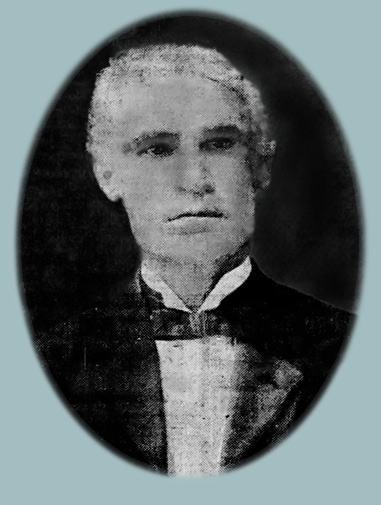
WILLIAM HERBERT FRECKER
Mayoral
term: June 8, 1906 - June 4, 1908
Born: May 1851,
Chatham,
Northumberland
Co., New Brunswick, Canada
Died: Apr. 22, 1914 (age 62)
Tampa
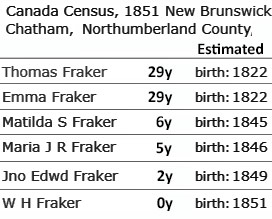
William
was one
of five
children
of
tanner/shoemaker
Thomas
Nicholas
Frecker
by his
first
wife,
Emma
Card.
Thomas
had six
more
children
by his
second
wife,
Martha
McDermott.
Although William's birth year appears as May, 1852 in
later U.S. sources, his presence on the 1851 Census in Chatham at age 1/2
year guarantees he was born in 1851.
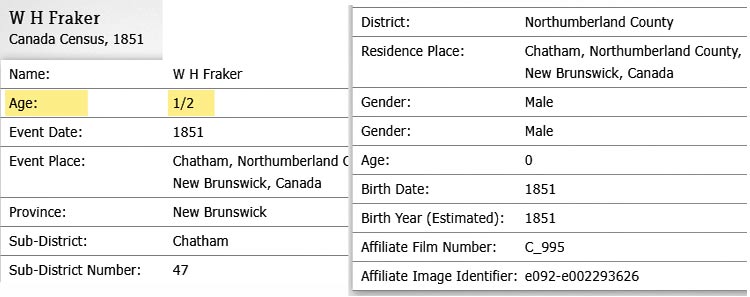
These
charts
are a
summary
of
William's
family
in
Canada.
|
Details
and sources appear
near the bottom of
this page. NB
is New Brunswick.
|
|
Emma Frecker, William's mother, died July 3, 1854 at age 32 and is buried at St. Luke's Methodist Cemetery in Chatham. |
| Thomas
Nicholas Frecker (b1822, Quebec - d1901, Richibucto, NB.) and first wife Emma
Card (b1822 NB - d. 1854 Chatham, NB) had five children in Chatham, Northumberland Co, NB. |
Thomas N. Frecker then married
Martha Eleanor McDermott on Jun 3, 1861. They had six children in Richibucto, Kent. Co, NB. These were William's half-sisters and half-brothers. |
1. Matilda Sophia (Boysen)
2. Maria Jane R. (White)
3. John Edward
4. William Herbert
5. Emma |
b. c1845 d.1888 Chatham, NB
b. 1846 d.1930 Richibucto, NB
b. c1849 d.1888 Chelsea, Mass.
b 1851 d.1914 Tampa, Fla.
b. c1853 d. ?? |
1. Ella R. (Harris)
2. Thomas R.
3. Emily Florence (Ramsay, Copp)
4. Charles A.
5. Nina L. (Seavey)
6. Thomas George |
b. c1863 d. 1894 Richibucto NB
b. c1865 d. c1874 age 9
b. c1868 d. 1944 St. John, NB
b. c1870 d. 1926 Tampa
b. c1875 d. 1956 Chicago
b. 1878 d. 1952 Surrey, BC |
| |
|
|
|
WILLIAM
H.
FRECKER
MARRIES
IN
CANADA
On Dec.
23,
1874,
William
married
Canadian
Barbara Tait,
daughter
of Capt.
William
James Tait
(Irish)
& Maria
Lewis
(Canadian),
in Escuminac,
New
Brunswick.
Barbara
appears
as
"Barbary"
on the
1871
census
of
Hardwick,
Northumberland
Co., NB,
age 19.
Based on
this
age, she
would
have
been
born in
1851 or
1852.
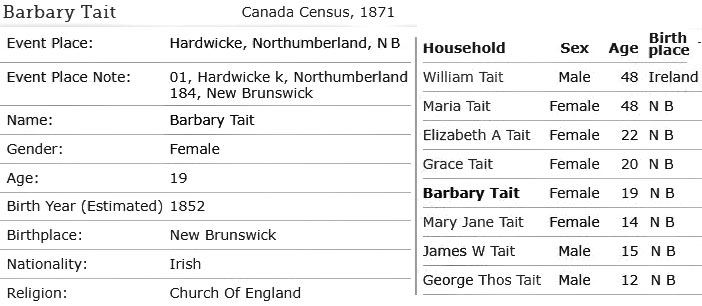
According
to their
1880
Census
in
Chicago,
William
and
Barbara
had
three
sons in
Canada
before
they
immigrated
to the
U.S. in
1879.
|
1. George J.
2. William
3. Charles Tupper
|
b.
1875
b.
1876-77
b.
1878, Oct. |
Mouseover
the map
to zoom
in on
Chatham, Richibucto,
and
Escuminac.
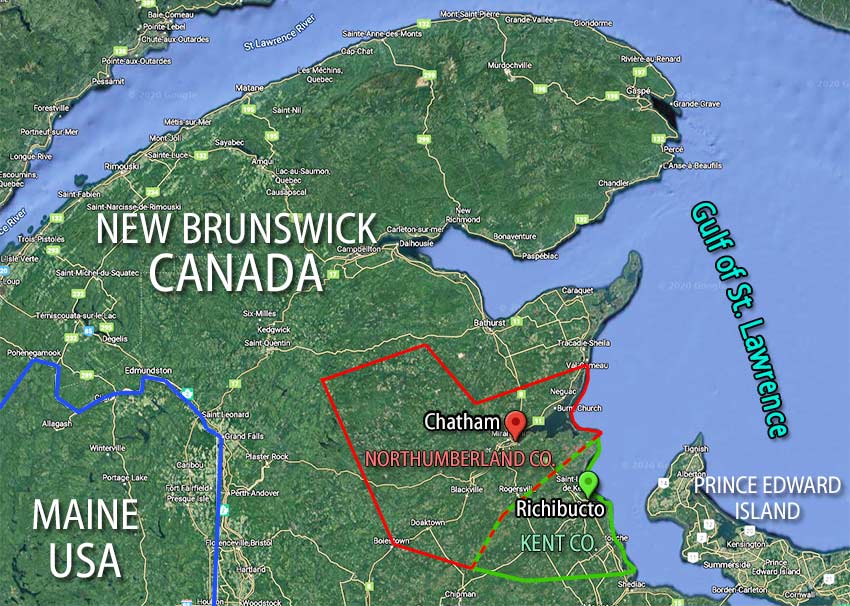
FRECKERS
MOVE
TO
CHICAGO
It's a
long way
from New
Brunswick
to
Chicago,
anywhere
between
1,200 to
1,700
miles.
It's not
known
what
route
they
took,
this map
is only
to
measure
distances
by some
arbitrary
routes.
In the
1870s
and
1880s
the only
choices
were
railroad
or ship
and any
combination
of them
for
various
legs of
the
journey.
It's
doubtful
the
sailed
all
around
Michigan.
However
they got
to
Detroit
or
Toledo
they
probably
would
have
gone by
rail
from
there to
Chicago.
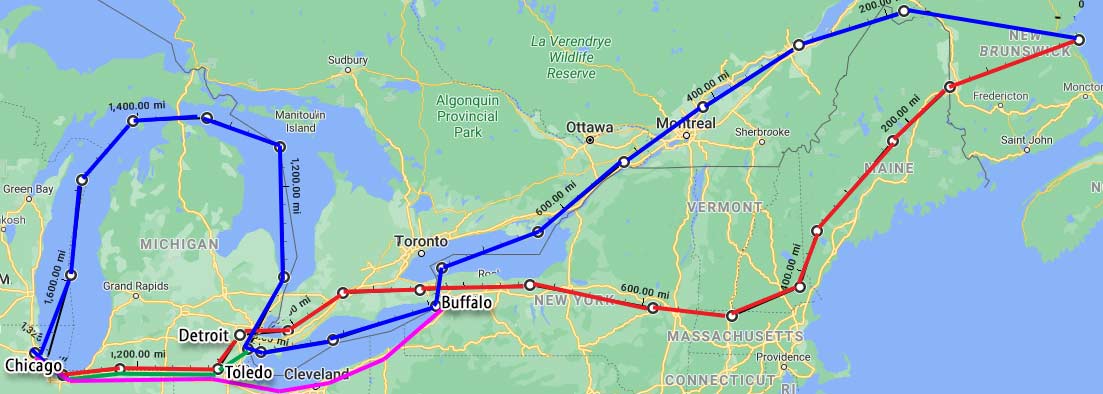
Over
1,600
miles if
all on
the St.
Lawrence
Seaway,
but the
last leg
around
Michigan
is
highly
improbable,
as
taking a
train
from
Detroit
or
Toledo
would
cut off
more
than 500
miles.
Minimum
travel
would
have
been
around
1,200
miles.
|
THE
FRECKERS
IN
CHICAGO
- 1880
CENSUS
In 1879
the
Freckers
came to
Chicago
where on
the 1880
Census
William
worked
in a
store,
probably
a
furniture
store.
This
census
erroneously
names
him as
"James Freckerd."
The
first
three
lines of
their
listing
clearly
show
corrections
where
erasures,
rub outs
and
over-writing
have
been
made,
especially
for the
first
line
where
James
has been
rewritten.

Barbara
is
listed
as "Barbery"
(again,
as she
was in
1871) and
young
Charles
Frecker
by his
middle
name
"Tupper."
All show
born in
New
Brunswick.
William
shows
his
father
was born
in
England,
but he
was
actually
born n
Quebec.
Barbara
shows
her
father
born in
Ireland.
Three
tragedies
befell the
Frecker
family
while in
Chicago.
According
to an
index of
Chicago
births,
on Oct.
7, 1881
their
only daughter
was born
but died
two days
later.
George,
their
oldest
son,
died at
age 16
in 1891
and it
is
assumed
that
William
also
died
before
they
left
Chicago
because
the Freckers'
only
child
on their
1900
census
in Tampa
is
Charlie
and it
shows
Barbara
was
mother
of four
children,
one
living.
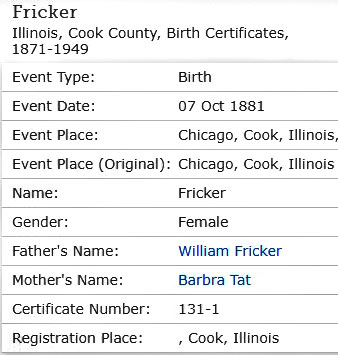
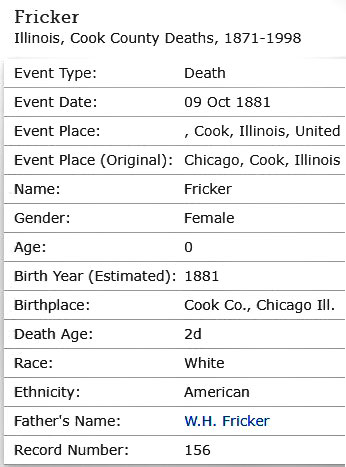
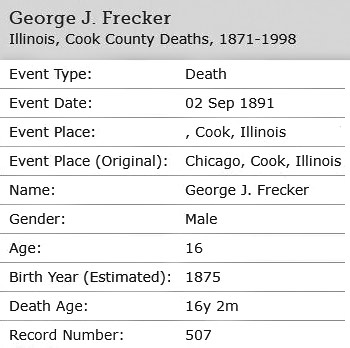
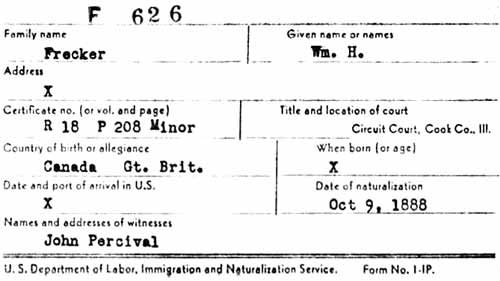
This
Oct. 9,
1888
naturalization
record
is
probably
William
Herbert
Frecker's,
but the
certificate
numbers
shows
"Minor"
which
might
mean
this is
his
son's
record.
The
absence
of a
birth
date or
age
makes it
uncertain
as to
which
Wm. H.
Frecker
this was
for.
|
|
THE
FOUNDATION
OF
WILLIAM
FRECKER'S
LEADERSHIP
AND
POLITICAL
ASPIRATIONS
By
January
1892,
Bill
Frecker
was a
member
of
Chicago's
National
Union
Society
A Jan.
3, 1892
article
on
various
lodge
activities
gives a
report
of the
Lodge,
and the
activities
of its
various
groups:
Music
Council
No. 325,
Ogden
Council
#473,
General
Sherman
Council
No. 477,
General
Shields
Council
No. 509,
and
Union
Park
Council
No.
308.
Frecker
was a
member
of the
Ogden
Council,
which
met at
the
corner
of Ogden
and
Western
Avenues
and was one
of the
three
delegates
to the
cabinet.
|
|
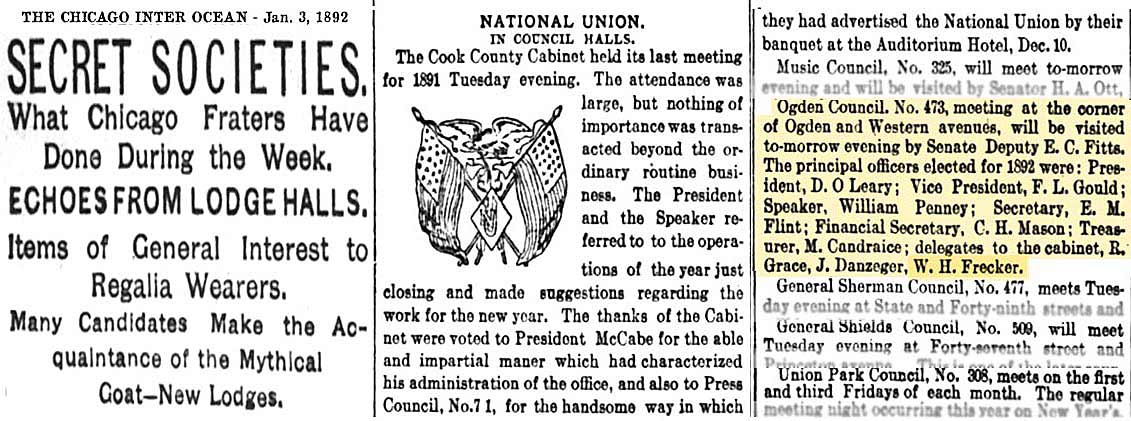 |
|
FRECKER
PRESIDENT
OF
THE
FURNITURE
AND
CARPET
SALESMEN'S
ASSOCIATION
William
was
engaged
in the
furniture
business
in
Chicago
and
was the
president
of a
fairly
new
organization,
being
founded
on May
1, 1892
(which
he
probably
had a
part in
starting)
called
the
Furniture
and
Carpet
Salesmen's
Association.
On Aug.
28,
1891,
they had
a member
picnic
attended
by over
1,200
members
including
their
families.
Frecker
addressed
the
attendees
in a
brief
welcoming
speech,
expressing
his
pleasure
at
seeing
so large
a number
present
and
detailing
the aims
of the
association.
Formed
on May
1, 1892,
its main
purpose
was to
bring
about
the "6
o'clock
closing movement."
It was a
campaign
to get
all the
furniture
stores
in the
business
district
along
Wabash
Ave. and
State
St,
which
comprised
about
four-fifths
of all
the
furniture
sold at
retail,
to close
at 6
p.m.
like the
other
businesses
did. At
the
time,
the
furniture
dealers
were
staying
open
until 9
p.m.
which
caused
problems
with
families
of
employees
who
worked
all day
at the
stores.
It was
an "all
or none"
proposition
because
any
store
remaining
open
would
stand to gain
most of
the
business.
|
The "6 o'clock closing movement" is explained in the article below.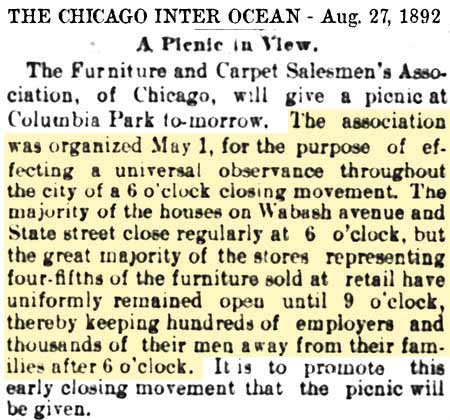 |
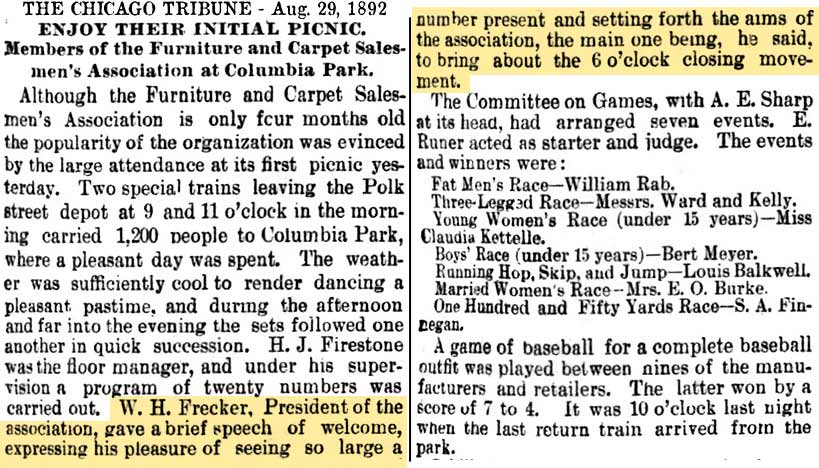
|
|
Nothing
more
could be
found
about
this
movement.
CHAS.
SHAW
OPENS
THE
CHICAGO
FURNITURE
HOUSE IN
TAMPA,
FRECKERS
ARRIVE
The
Freckers
are said
to have
come to
Tampa
around
1894 to
1895.
This
period
coincides
with the
establishment
of a
large
furniture
dealership
in Tampa
by
Chicago
furniture
dealer
Charles
B. Shaw.
A son of
British
chair
manufacturer
Joseph
Shaw,
Charles
Shaw
came to
Tampa in
1895
determined
to
relocate
his
business
here
permanently;
he
called
it
"Chicago
Furniture
House."
His
first
location
was
leased
space at
the
southeast
corner
of
Franklin
and
Jackson
streets. |
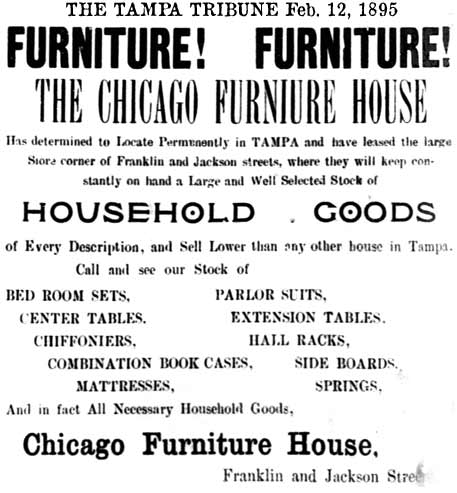
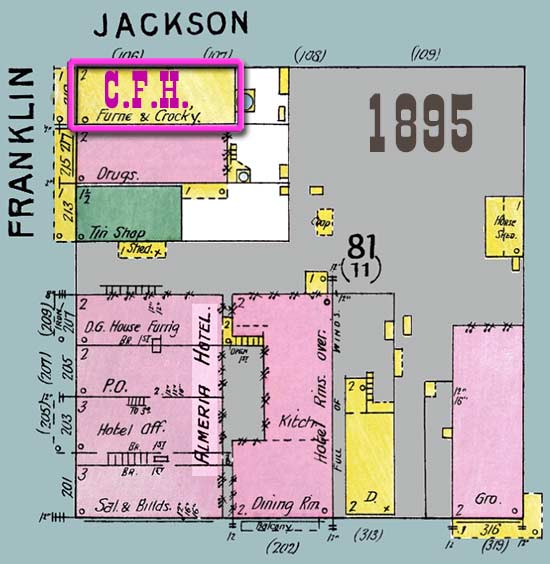
Notice
the ad
shows
"And in
fact All
Necessary
Household
Goods."
The map
shows a
furniture
and
crockery
business
on the
corner.
The
crockery
would be
the
household
goods.

When his
business
was up
and
running,
the Shaw
family
relocated
to
Tampa.
FIRST
MENTION
OF WM.
H. FRECKER
IN THE
NEWS
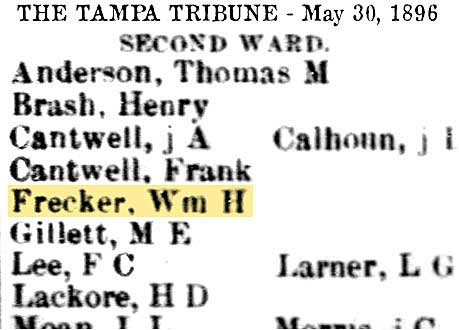
The
first
mention
of
William
Frecker
in Tampa
is found
in the
Tribune
in May
1896 on
a list
of
registered
voters
in the
2nd
Ward. (Tampa
Heights)
It
certainly
is
possible
that
Frecker
came to
Tampa as
an
employee
of C. B.
Shaw or
a
soon-to-be-hired
employee.
But
contrary
to
what's
indicated
in some
sources,
Frecker
did not
own it at
this
time nor
did he start
the
company.
This is
the
Tampa
the
Freckers
would
have
seen
when
they
arrived
here.
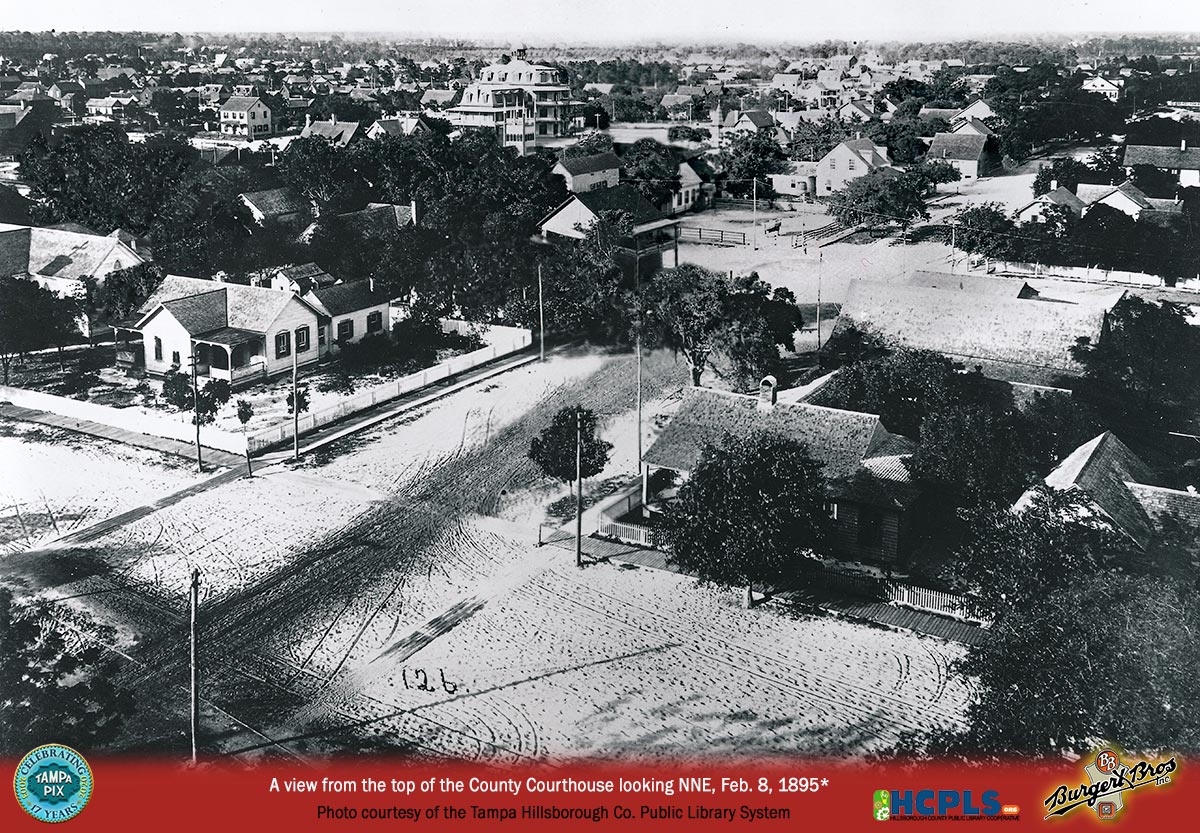
*This photo has been dated by TampaPix after analyzing the buildings seen here. At far left is the St. Louis church which became Sacred Heart church, the shadow of the cross can be seen on the rooftop. By 1899 it had been moved closer to the house on the corner and construction had started in its place on the new Sacred Heart church. The large building in the distance is the Convent and Academy of the Holy Names which was built in 1891 and demolished in 1925. There is the appearance of snow in the streets, yards and on some rooftops.
|
| Mouse-over the photo to see buildings identified. |
1. St. Louis Church (In 1899 it was moved closer to the house on the corner and the Sacred Heart Church was built on the former site of the wood frame church.
2. Original location of wood frame Y.M.C.A (became site of Young Men's Catholic Club in 1899.)
3. Original wood frame 45' tower of St. Andrews Episcopal Church
4. Academy of the Holy Names Convent built 1891 demolished 1925
5. Tampa Livery Sale & Transfer Co. stables & carriage houses
|
|
A clue
in the
photo
that
indicates
this is
NOT snow
is that
none of
the
chimneys
show
smoke
coming
from
them.
The long
shadows
in the
westward
direction
indicate
this is
late
afternoon,
but even
then the
temperatures
would
have
been
quite
low and
require
the use
of
furnaces
and
fireplaces--a
smoky
haze
would be
quite
noticeable
in the
photo.
By why
would
there be
not a
soul or
horses
and
carriages
on the
streets??
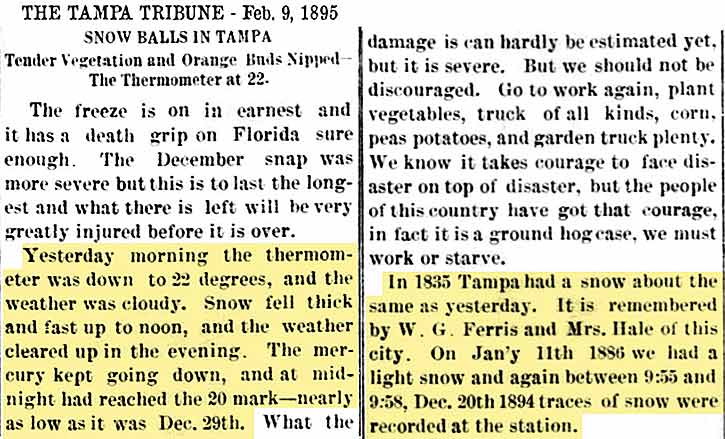
See more
photos
and
history
about
the
Academy
of the
Holy
Names
and
Convent
here at
TampaPix.
See the
TampaPix
feature
about
the
DeSoto
Hotel
for the
identification
of
buildings
seen in
this
photo
and a
comparison
to an
1895
Sanborn
map.
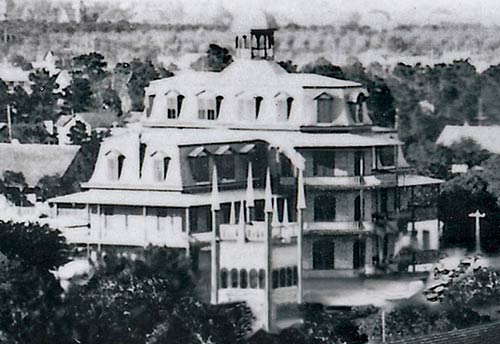
At left
is a
crop of
the full
size
version
of the
1895
photo
which
gives a
rare
view in
foreground
center of
the 45
ft.
tower of
the
original
wood
frame
St.
Andrews
Episcopal
Church
on
Marion
St.
between
Madison
& Twiggs
streets.
Behind
it is
the old
1891
Academy
of the
Holy
Names
Convent
which
took up
the
whole
block
between
Zack,
Twiggs,
Morgan &
Pierce
streets.
BIG
BUSINESS
FOR
SHAW,
MOVES
CHICAGO
FURNITURE
HOUSE TO
LARGER
SPACE
Click
the ad
to see
it
larger,
then
again to
see it
full
size.
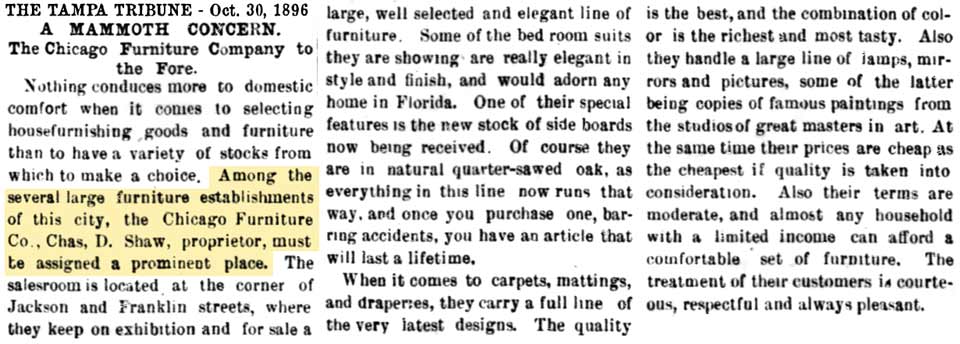
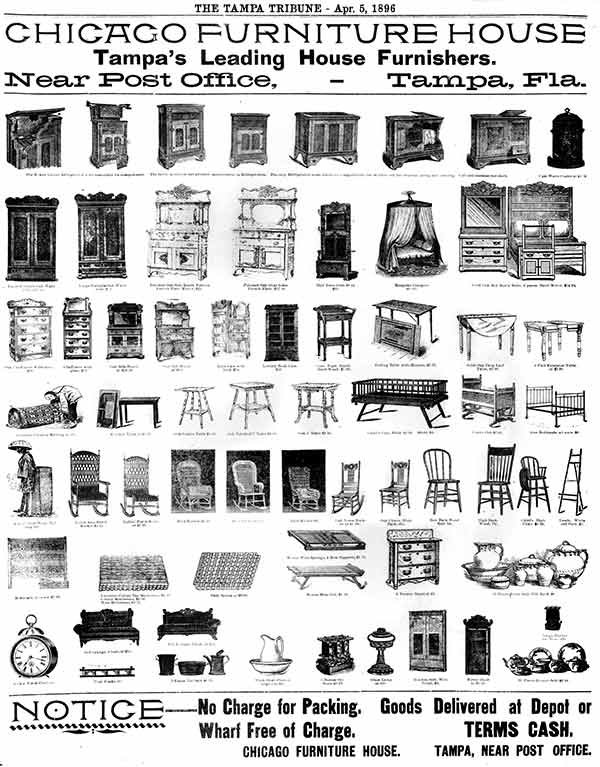
|
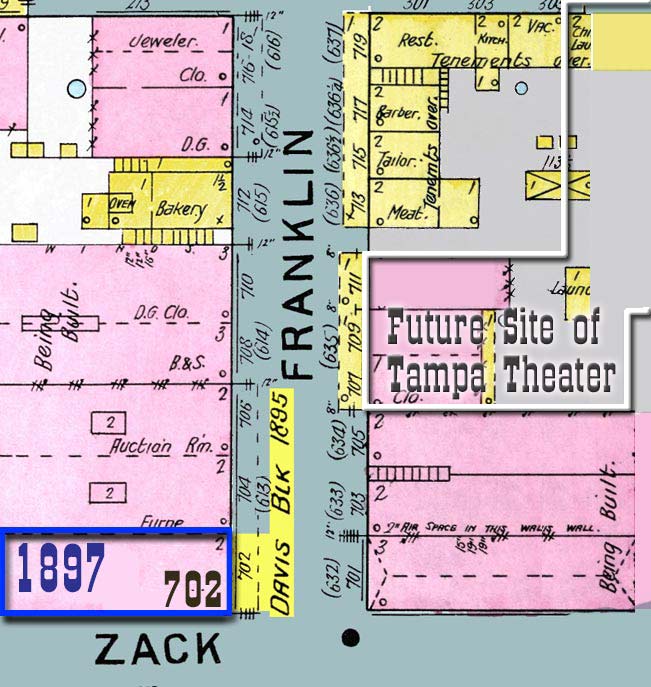
In 1913, this is where Citizens Bank built their- "skyscraper."
|
Business
boomed
for Shaw
and on
Jan 17,
1897,
Shaw
announced
his
store
was
moving
to the
new
Davis
block at
702 N.
Franklin
St.
which
was the
northwest
corner
of
Franklin
and
Zack,
where he
would
have
more
room. By Feb.
2, Shaw
was open
for
business
in the
new
Davis
Building.
Shaw
also
planned
to open
a store
in
Manatee
Co.
Today this whole block is occupied by the TECO Plaza and building
|
|
FRECKER SUPERVISES THE OPENING OF A CHICAGO FURNITURE HOUSE IN BRADENTON
In
mid-1897,
Shaw
expanded
his
operations
to
Bradenton in Manatee.
The Jul.
3, 1897
Tribune
published
that
"Mr.
W. H.
Frecker
returned
last
night
from
Braden
Town
where he
has been
superintending
the
opening
up of a
mammoth
furniture
store
for the
Chicago
Furniture
House."
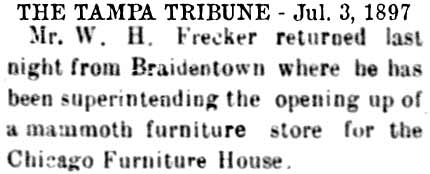
By
end of
the
month,
management
was
established
at
Bradenton
with E.
P.
Paschall,
"an old
resident
of
Manatee
and young
Oliver
E. Shaw,
son of
the
proprietor."
(The
1900
Census
in Tampa
shows
Oliver
Shaw
would
have
been
just 15
to 16
years
old in
1897.)
The
store
was
located
in "Dr.
Ballard's
elegant
and
spacious
two-story
metal
building."
|
|
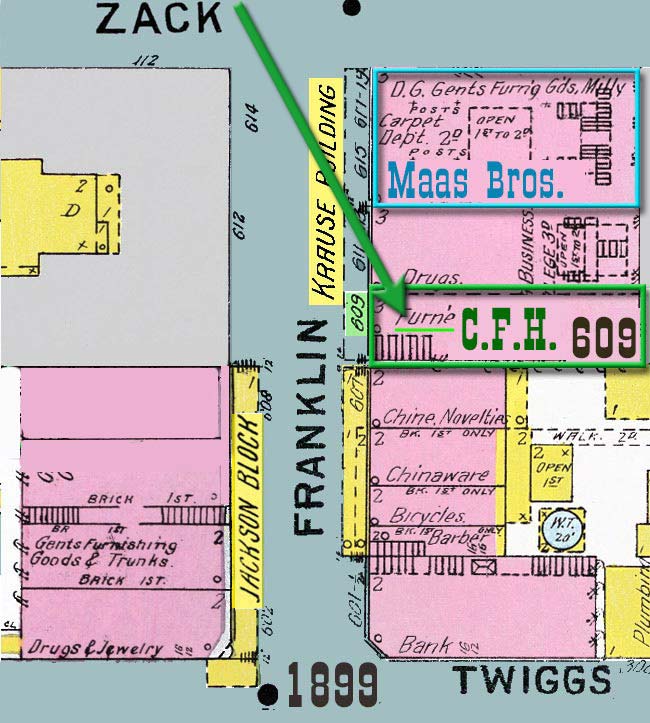
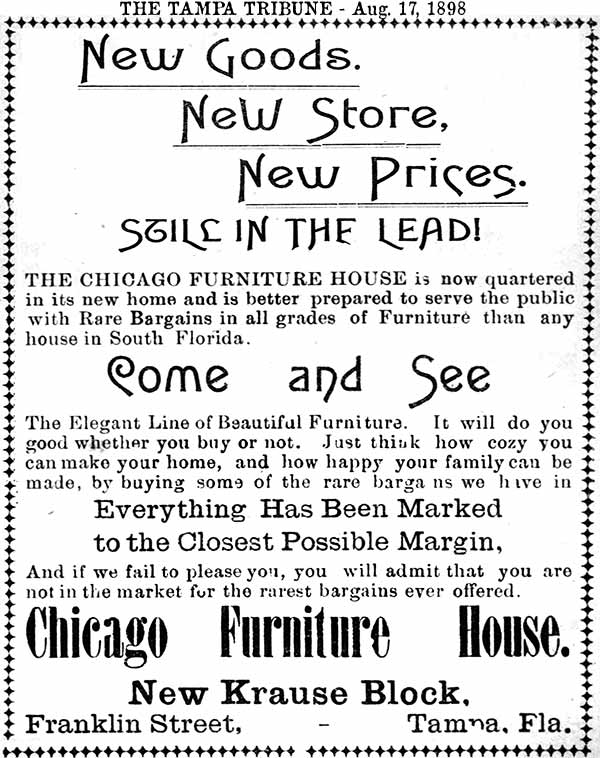 |
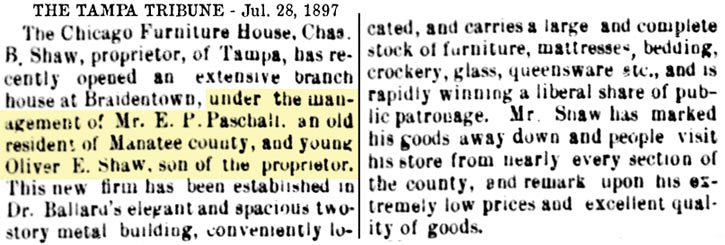
CHICAGO
FURNITURE
HOUSE
MOVES TO
KRAUSE
BUILDING
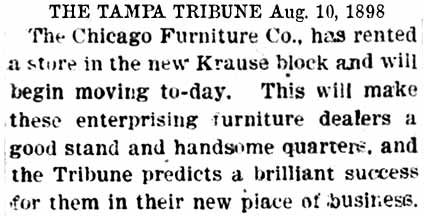 In
mid-August
1898,
Shaw
moved
his
business
into the
new
Krause
building
at the
southeast
corner
of Zack
&
Franklin
St.
This was
just the
next
block
south of
the
previous
location
and
though
it looks
smaller,
there
was more
space
because
the
building
was
three
stories. In
mid-August
1898,
Shaw
moved
his
business
into the
new
Krause
building
at the
southeast
corner
of Zack
&
Franklin
St.
This was
just the
next
block
south of
the
previous
location
and
though
it looks
smaller,
there
was more
space
because
the
building
was
three
stories.
Maas
Brothers
also
moved
into the
new
Krause
building
the same
year and
remained
there
for 23
years.
It was
previously
located
at its
original
site as
the "Dry
Goods
Palace"
on the
southeast
corner
of
Twiggs
and
Franklin
at 515
Franklin
St.
Maas
Brothers
in the
Krause
building
with the
American
National
Bank
Across
the
street,
circa
1905-1910
Image
from the
University
of South
Florida
Digital
Collections,
Hampton
Dunn
Postcards.
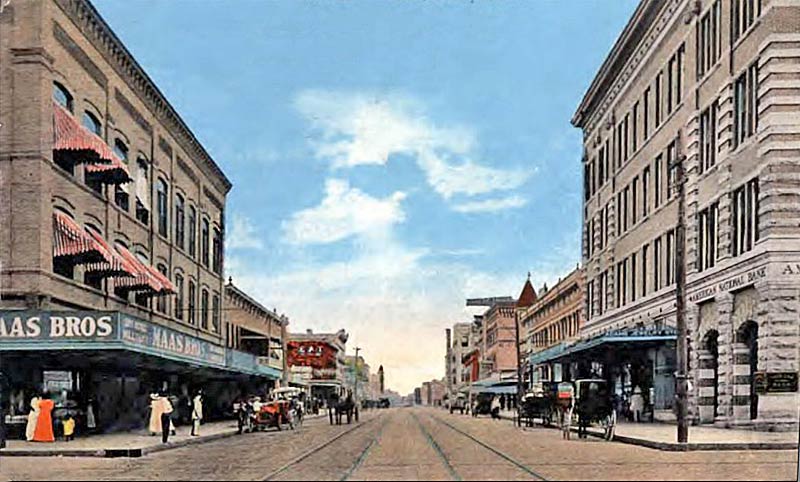
Mouse
over the
photo to
see
where
Chicago
Furniture
House
was
located. |
| |
|
THE EXPLOSION AND SINKING OF THE U.S.S. MAINE IN HAVANA HARBOR, FEB. 15, 1898

The battleship USS Maine entering Havana Harbor, Jan 25, 1898. Photo from Wikipedia.
On the evening of February 15, 1898, the American battleship Maine exploded while anchored in Havana harbor, killing two officers and 250 enlisted men. Fourteen of the injured later died, bringing the death toll to 266. Sent to protect U.S. interests and as a show of strength during the Cuban revolt against Spain, she exploded suddenly, without warning, and sank quickly.
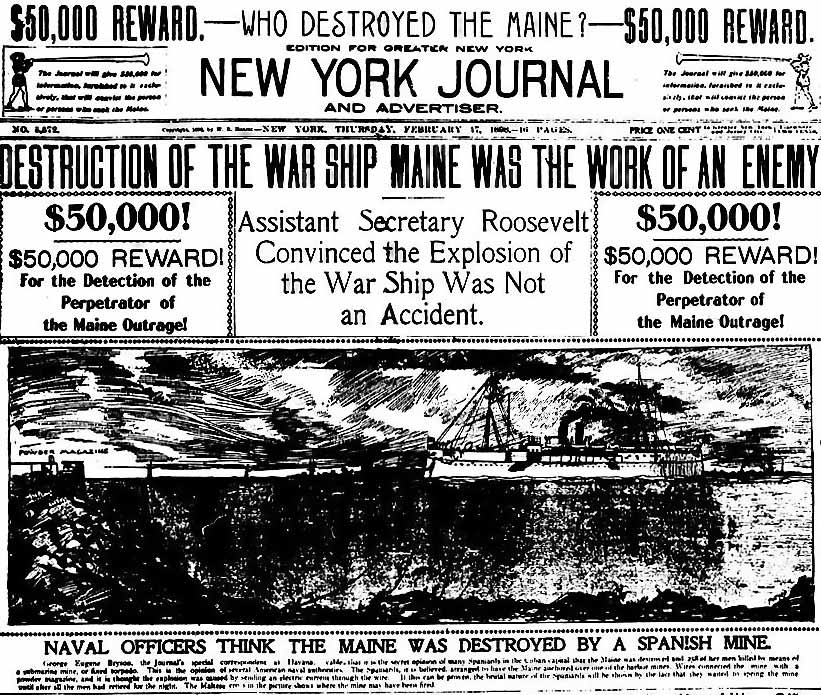
In March 1898, an investigation of the explosion was carried out by a naval board appointed under the McKinley Administration. The consensus of the board was that the Maine was destroyed by an external explosion from a mine. However, the validity of this investigation has been challenged in modern times. Release of the board’s report led many to accuse Spain of sabotage, helping to build public support for war. |
|
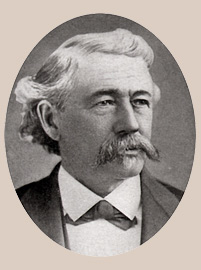
Henry B. Plant
From Cigar City Reflections
The King of Florida |
HOW
TAMPA
WAS
CHOSEN
AS THE
NAVY'S
PORT OF
OPERATIONS
After the explosion on the Maine, Tampa's mayor and congressman promptly petitioned Secretary of War Russell Alger for protection against the Spanish Navy. Leading citizens and the Board of Trade demanded a military presence and the funding of coastal defense sites. But from the armchair generals in Washington, there was no response.
Then on March 22nd, Henry Plant wrote Secretary Alger personally, calling attention to his multi-million dollar investment in Port Tampa. On March 25th, Alger sent his Chief of Engineers to begin fortifications on Egmont and Mullet Keys. With that, Florida, Tampa and H.B. Plant were in the still-undeclared war. The Olivette had already made one run for Assistant Secretary of the Navy, Theodore Roosevelt, delivering ammunition to Key West. Local papers began boosting Tampa as the obvious supply point for operations in the Caribbean.
At the end of March, a real-life seagoing admiral checked into the Port Tampa Inn. On behalf of the Plant System, Henry Plant's second in command, Franklin Q. Brown, gave "Fighting Bob" Evans a tour of the harbor. The admiral passed the word to the press corps. In the event of war, make way for the Navy! Fifty thousand troops would be
mobilized from Port Tampa.
From Henry Plant - Pioneer Empire Builder |
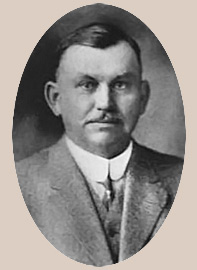
Tampa Mayor Myron E. Gillett
Term: June 5, 1896- June 5, 1898
Photo from "Men of the South" (where his and his son's photos are displayed in reverse order to the caption) |
|
Read more about the Spanish-American War and the activity it brought to Tampa, including Clara Barton and the American Red Cross, in the summer of 1898 at: Clara Barton and the American Red Cross in Cuba and Tampa during the Spanish American War
|
| |
|
|
|
FRECKER
IN
POLITICS
- THE
RACE FOR
CITY
COUNCIL
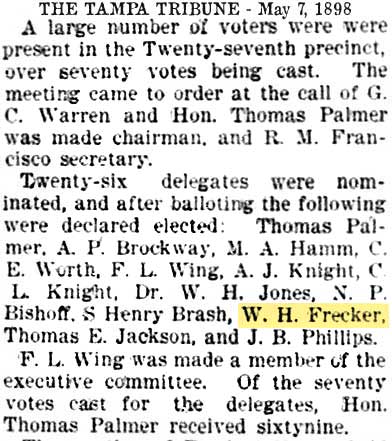
While
working
for
Shaw at
Chicago
Furniture
House,
Bill
Frecker
was
getting
involved
in civic
and
political
affairs
of
Tampa.
On May
7, 1898
the
results
of the
individual
voter
precincts
balloting
were
published.
In
the 27th
Precinct,
26
delegates
were in
the
running.
With 70
voters, Frecker
was one
of the
13 men
chosen
to run
for City
Council.
This
was no
list of
rookies,
there
were
some
big-hitters:
Thomas
Palmer,
C. E.
Worth,
Frank
Wing, A.
J.
Knight,
C. L.
Knight,
N. P.
Bishoff,
Thomas
E.
Jackson,
and a
few
others.
POLITICAL
RALLY AT
COURT
HOUSE
SQUARE
(Article
below)
A week
later, a
political
campaign
rally
took
place
at
Court
House
Square
for the
Citizen's
League,
of which
Frecker
was a
member
and had
put him
in the
running
for City
Council.
The
League
endorsed
W. J.
Dombrowsky
for
Mayor.
Various
city
officials
were
seen in
the
crowd,
including
current
Mayor Myron
E.
Gillett,
"all of
whom
took
their
medicine
with the
best
grace
possible
when the
speakers
scored
the city
government
for not
making a
better
showing
in the
way of
municipal
improvements.
Various
delegates
made
their
speeches
for Dombrowsky,
and took
shots
and the
current
administration.
THE SEED
OF THE
TRIBUNE'S
"HOTSTUFF
FRECKER"
NICKNAME
After
mayor-candidate Dombrowsky
spoke to
the
crowd it
was
Frecker's
turn.
He was
introduced
as “a
hot
member
of the
Citizen's
league,
and was
currently
'red
hot' in
his
remarks
and
scored
the
present
administration
(Myron
Gillette) and the
party
that is
opposed
to the
candidates
of the
Citizen's
League.
He
denounced
the
members
of the
Board of
Public
Works
for not
furnishing
an
itemized
statement
of the
moneys
under
their
control,
and then
waded
into
corporations
that
have
been
shown
favors
by the
city."
Wallace
Stovall,
owner
and
editor
of the
Tribune,
would
not ever
let go
of the
"Red
Hot"
fervor
of
Frecker,
he
would
continue calling
him "Hotstuff
Willie"
or "Hotstuff
Mayor"
throughout
his
political
career.
The
Tribune
gets
Frecker's
initials
wrong--J.H.
instead
of W.H.
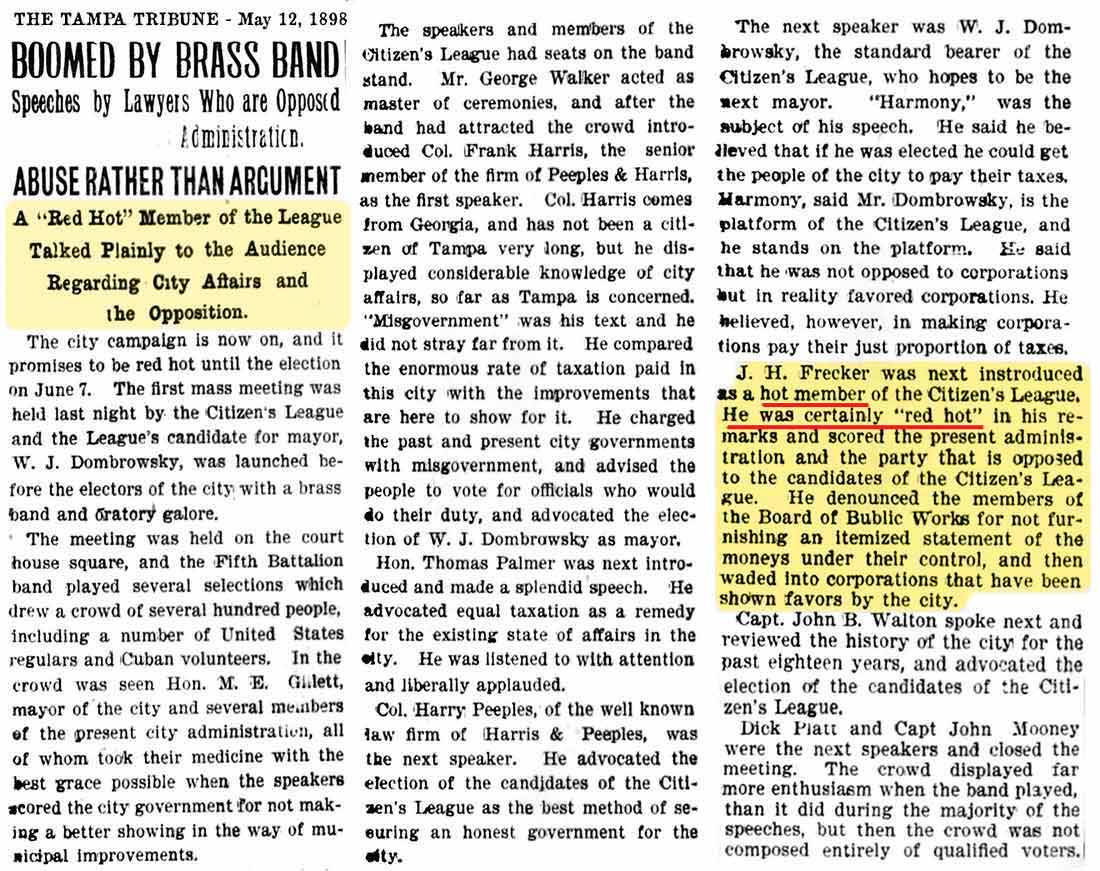
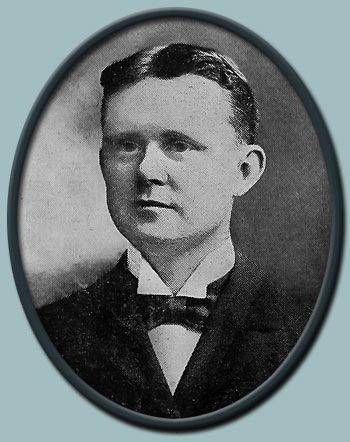
FRANK
BOWYER
ELECTED
MAYOR ,
FRECKER
EKES OUT
A CITY
COUNCIL
SEAT
On June
7,
1898,
Francis C.
Bowyer
was
elected
mayor.
Wm.
Frecker
was
initially defeated
by Harry Levick
in the
City
Council
race in
the 2nd
ward,
but a
vote
recount
was
conducted.
Photo of
Frank
Bowyer
from
1904.
Tampa,
Florida
: its
industries
and
advantages
and a
series
of
comprehensive
sketches
of
representative
business
enterprises
at
Internet
Archive.
The news
of the
newly-elected
mayor
shared
the
front
page
with
news of
war,
inhumanity
& child
abuse,
murder, suicide,
and
robbery.

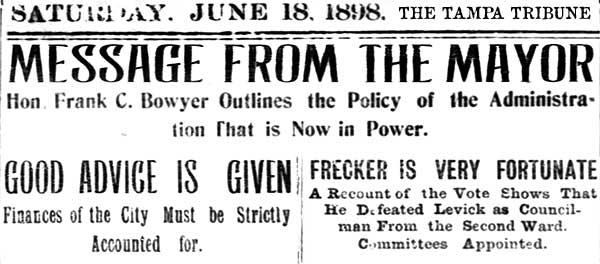
VOTE
RECOUNT
FOR 2nd WARD
CITY
COUNCIL
At the
first
meeting
of the
City
Council,
attorney
for the
Citizen's
League
M. B.
Macfarlane
contested
the
count of
the
ballots
for Ward
2
City
Council,
which
favored
Levick
(by two
votes)
and not
the
League's
candidate,
Frecker.
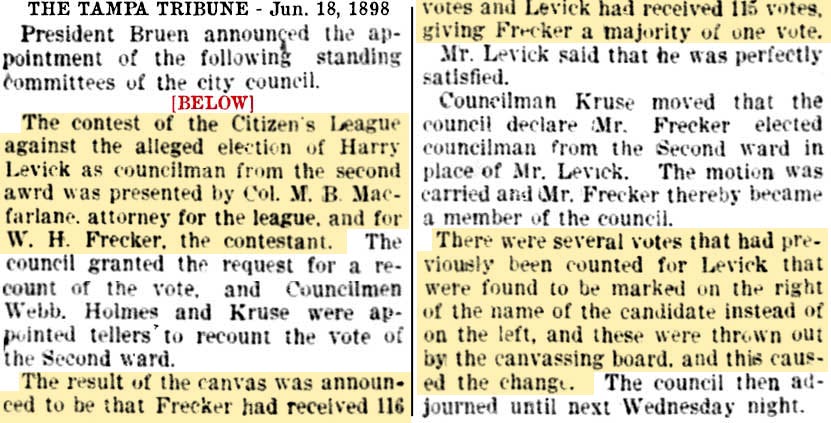
The
Council
granted
the
request
for a
recount,
and
Councilmen
Webb,
Holmes
and
Kruse
were
appointed
to the
recount.
It was
found
that
three
votes
had been
counted
for Levick
which
should
not have
been,
because
they
were
marked
to the
right of
the name
instead
of the
left.
With
those
ballots
disqualified,
Frecker
won by
one
vote,
117 to
116.
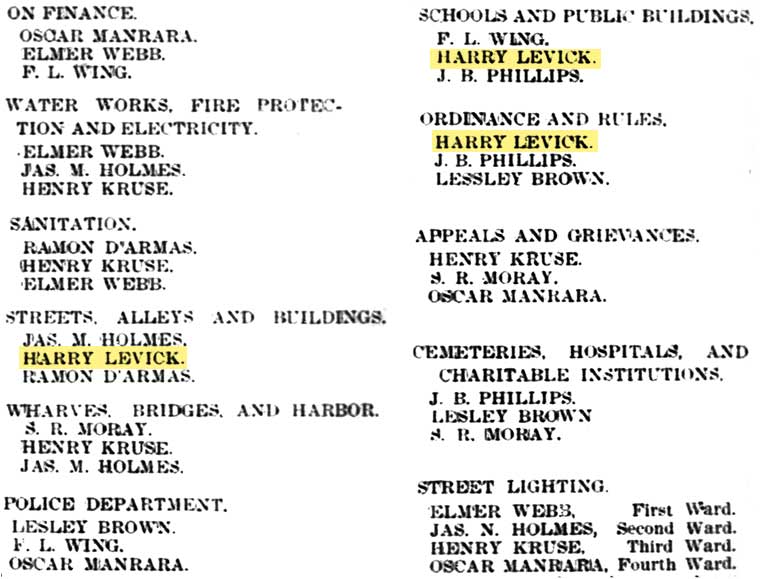
At the
next
City
Council
Meeting,
it was
announced
that
Frecker
would be
assigned
to the
committees
that
Levick
had been
previously
appointed
to.
SHAW
EXPANDS
CHICAGO
FURNITURE
TO CUBA
AT WAR'S
END
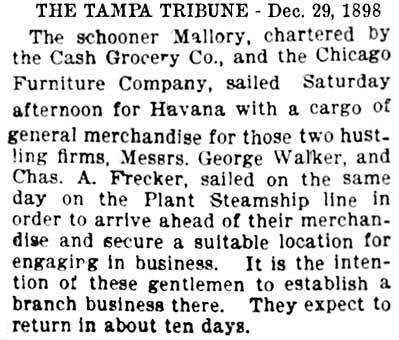
Representatives
of Spain
and the
United
States
signed a
peace
treaty
in Paris
on
December
10,
1898,
which
established
the
independence
of Cuba,
ceded
Puerto
Rico and
Guam to
the
United
States,
and
allowed
the
U.S. to
purchase
the
Philippines
Islands
from
Spain
for $20
million.
Cuba
technically
gained
its
independence,
but
United
States
soldiers
remained
in the
country
for
years,
commonly
intervening
in the
new
nation's
politics.
With the
war over
and the
U.S.
maintaining
order
and Red
Cross
humanitarian
aid in Cuba,
Shaw
wasted
no time
in
sending
a young
Charlie
T.
Frecker,
William's
son, to
Cuba with a
shipload
of
furniture,
hoping
to
establish
a branch
store in
Havana.
|
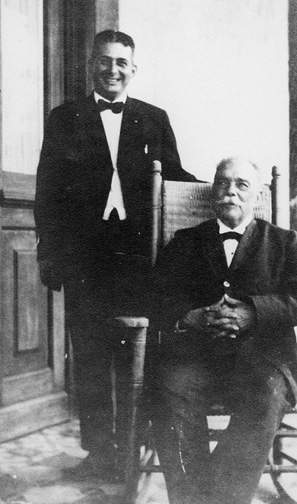
|
FIRST MAYOR OF WEST TAMPA, FERNANDO FIGUEREDO, APPOINTED POSITION IN CUBAN GOVERNMENT
At noon on May 20th, 1902, the U.S. Military Governor of Cuba, Gen. Leonard Wood, personally read President Theodore Roosevelt's letter declaring that the U.S. occupation of Cuba was over. At the same time, M.C. Fosnes, Dir. General of Posts for the U.S. administration, turned over all the postal affairs to Col. Fernando Figueredo, first Postmaster General of Cuba. The U.S. flag was lowered in Havana and the Cuban flag was raised.
In 1904, Estrada Palma appointed Fernando Figueredo as Comptroller-General of the Republic of Cuba, and in 1906, during the second intervention of the U.S. Government in Cuba, the American governor-general, Charles A. Magoon, 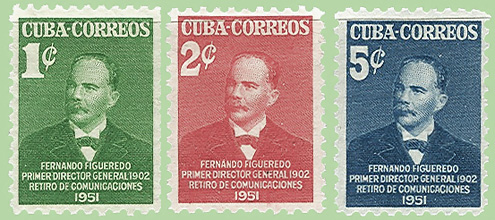 named Fernando Treasurer-General of Cuba following the death of Carlos Roloff. He remained Treasurer-General until the 24th of June, 1924, when he retired. named Fernando Treasurer-General of Cuba following the death of Carlos Roloff. He remained Treasurer-General until the 24th of June, 1924, when he retired.
After his retirement, he wrote historical articles for newspapers and for the Academy of History in Havana, until he died in Havana on April 13, 1929. On March 17, 1951, the Cuban government issued three postage stamps bearing his portrait. |
In 1919, at age 73, Fernando Figueredo posed with Blas Clemente Fernandez O'Halloran, the current mayor of West Tampa. Mayor O'Halloran was a son of Blas Fernandez O'Halloran who rolled the "cigar that sparked a revolution." This photo was likely taken in Cuba. On Feb. 4, 1919, Blas obtained a passport to travel to Cuba. See images of his application.
|
CHICAGO
FURNITURE
HOUSE'S
ADVERTISING
Shaw ran
a
relentless
advertising
blitz in
the
papers--very
large
ads and every
day. In
July
1899
Shaw
announced
he was
offering
storage
in
warehouses
he had
on Zack
Street.
"For
furniture,
store
fixtures,
carriages,
or
merchandise
of any
kind."
The
warehouses
were
situated
along a
railroad
line so
trainloads
could
transfer
cargo
directly
to his
facility.
He also
bought a
second
delivery
wagon,
and told
the
Tribune
that if
business
continued
as it
has for
the past
two
months,
he would
need a
third
wagon.
The 1903
map
below
shows
the
locations
of
Shaw's
Zack
Street
warehouses.
Notice
the ACL
Railroad
track
(blue)
terminating
directly
behind
the
warehouse
on the
north
side of
Zack.
The
warehouses
were
wood
frame
construction.
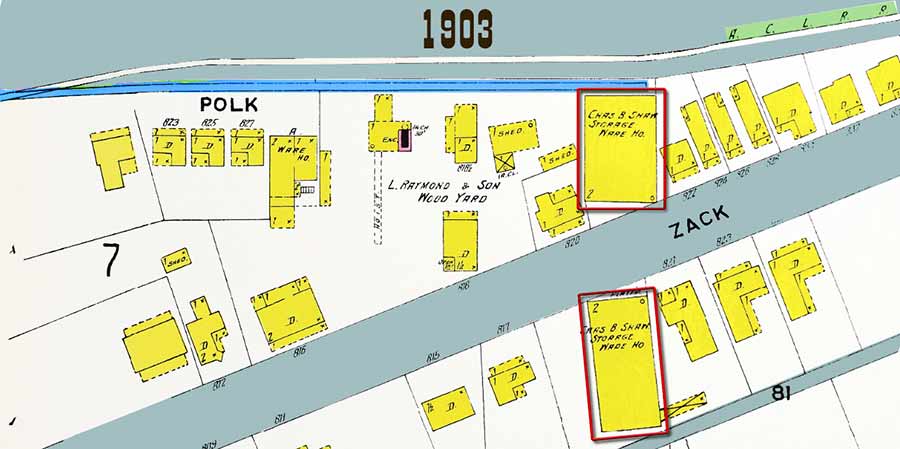
|
THE
FRECKERS
ON THE
1900
CENSUS
IN TAMPA
By the
time of
the 1900
Census
in
Tampa,
William &
Barbara
Frecker, their
son
Charles
T.
(Tupper) Frecker
and a
Canadian
niece
named
Mary
McCallum
were
living
at 106
Frances
Ave.
between
Tampa
St. and
Florida
Avenue. William's
wife,
Barbara,
indicated
she was
the
mother
of four
children,
with
only one
living
at the
time.
This can
be
relied
upon
because
Charles
T.
Frecker
was the
enumerator
for this
area in
1900.
His
occupation
was
"stenographer."



This
census
asked,
if
foreign
born,
what
year the
person
immigrated.
The
record
shows
1879.
The "21"
represents
how many
years
were
spent
here
after
immigrating.
This
seems
redundant
knowing
the
immigration
year but
the
answer
considers
any
number
of years
since
immigrating
that the
person
was
outside
of the
US.
Careful
inspection
of the
record
shows
that
Charles
had
first
written
"1884."
This
could be
when
William
became a
naturalized
citizen;
the
requirement
was at
least 5
years in
the U.S.
to be
naturalized.
His
address,
106
Frances,
is
the
neighborhood
of
Highland
Park in
Tampa
Heights.
|
FRECKER
STARTS
HIS OWN
BUSINESS
- UNION
FURNITURE
CO.
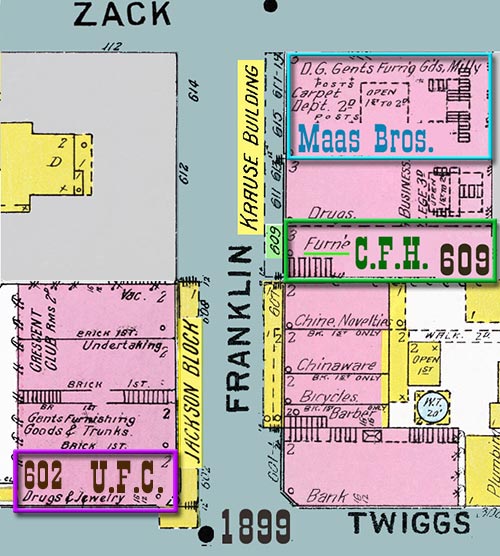 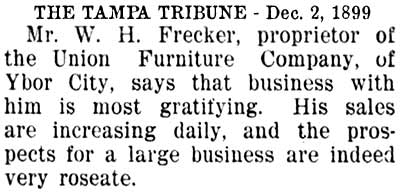
Sometime
in
November
1899 Wm.
Frecker
left
Shaw's
Chicago
Furniture
House
and
started
his own
furniture
business
called
"The
Union
Furniture
Co." in
in Ybor
City.
FRECKER
JOINED
BY
FELLOW COUNCILMAN
FRANK
WING
Frecker
soon
opened
another
Union
Furniture in
the
Jackson
Building.
This was
across
Franklin
St. from
the
Chicago
Furniture
House in
the
space
formerly
occupied
by B. A.
Brown, a
former
jeweler
who in
early
Oct.
that
year
sold all
his
stock to
Southern
Loan &
Jewelry
to pay
off some
of his
debts.
It is
at this
time
that
Frank
Wing
entered
the
furniture
business
when he
joined
Frecker
as a
partner
in the
Union
Furniture
Co.
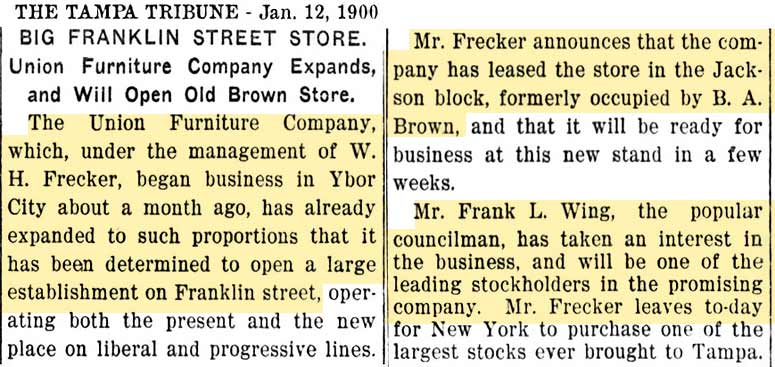
CITIZEN'S
LEAGUE
CANDIDATES
RUN
UNOPPOSED
IN 1900
ELECTION EXCEPT
FOR ONE
POSITION
In 1900,
the race
for
Mayor
and City
Council,
as well
as all
other
positions
except
Tax
Collector,
would be
without
opposition
in the
June
election.
Frank
Wing was
sure to
become
Mayor,
and
Frecker
one of
the City
Council
members
for "at
large"
(not
representing
any
specific
ward,)
but
Nicholas Bishoff's
bid for
Tax
Collector
would be
opposed
by
Herman
Glogowski,
a former
Tampa
Mayor.
Nicholas
Bishoff
was also
in the
business
with
Frecker
& Wing's
Union
Furniture
Company,
and the
Tribune
took
every
opportunity
it could
to point
this
out, as
evidenced
by the
May 6
article
below.
But on
May 5,
1900, the
Citizen's
League
"slate-makers" pulled
Bishoff
from the
running
for tax
collector;
the
Tribune
speculated
it was
because
the
League
had
concerns
of three
members
of City
government
being
associated
in one
business,
the
Union
Furniture
Co.
By
pulling
Bishoff
, it would
leave
the race
uncontested
for the
opposition
(Glogowski)
because
the
League's
first
choice,
Charles
E.
Worth,
pulled
out to
run for
County
Tax
Collector.
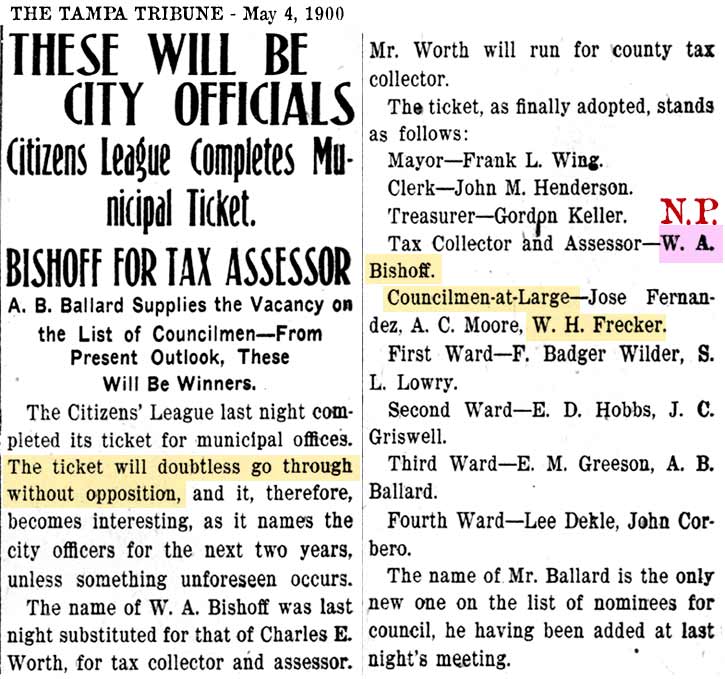
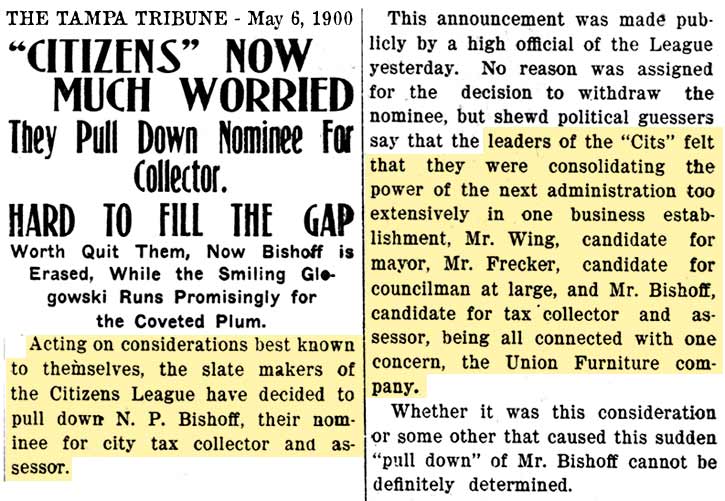
BISHOFF
BACK IN
THE
RUNNING
On May
12,
1900,
the
Tribune
published
an
article
stating
that the
Citizen's
League
was
going to
keep
Bishoff
on the
ticket
for Tax
Collector.
The
Tribune
again
stated
that
Wing,
Frecker
and
Bishoff
were all
in
business
together
and that
if
Bishoff
defeated
Glogowski,
the only
contested
race,
"one
concern
will
have
much to
say
about
the
conduct
of the
next
City
administration."
That
"one
concern"
was the
Tribune,
under
editor
Stovall,
who
would
unceasingly
ridicule,
criticize,
demean
and
disrespect
the City
Council,
especially
Frecker.
The
Tribune
concluded
by
stating
that Glogowski
was
making a
strong
fight,
and it
thought
Bishoff
would
lose,
stating that the
"trio
above
enumerated
will be
reduced
to a
duet
when the
votes
are
counted."
FRANCIS
LYMAN
WING
ELECTED
MAYOR
UNOPPOSED,
BUT
CAN'T
TAKE
OFFICE
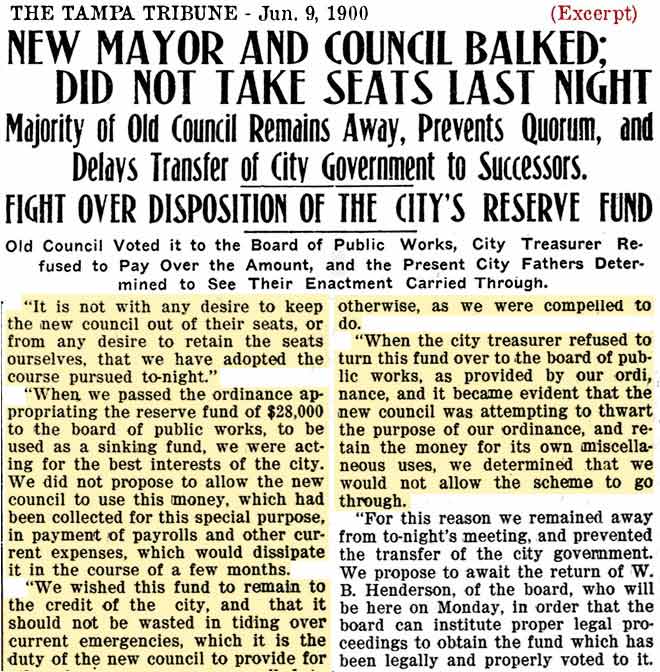 The
election
result
was no
surprise,
except
that
Nicholas
Bischoff
defeated
Herman Glogowski
for City
Tax
Collector.
But when
it came
time to
transfer
the City
Government
to the
new
administration,
six of
the City
Councilmen
from the
old
administration
did not
show up.
Without
a
quorum,
new
Mayor
Wing and
the new
City
Council
could
not take
office. The
election
result
was no
surprise,
except
that
Nicholas
Bischoff
defeated
Herman Glogowski
for City
Tax
Collector.
But when
it came
time to
transfer
the City
Government
to the
new
administration,
six of
the City
Councilmen
from the
old
administration
did not
show up.
Without
a
quorum,
new
Mayor
Wing and
the new
City
Council
could
not take
office.
At
right is
an
excerpt
of this
Jun. 9,
1900
article.
Click it
to read
the
whole
article.
When it
opens,
click it
again to
see it
full
size.
The
excerpt
at right
is
Councilman Webb's
(of the
"Big
Six" who
didn't
show up)
explanation
as to
why he
and the
other
five
councilmen
didn't
show up.
PROTECTING
THE
RESERVE
FUND
The
issue at
hand was
a
reserve
fund of
$28,000
for
which
the
outgoing
City
Council had
passed
an
ordinance
for the
funds to
be used
by the
Board of
Public
Works.
They
didn't
want the
new
administration
to use
it for
payroll
or
current
expenses,
or
even current
emergencies.
They
felt it was
the duty
of the
new
Council
to come
up with
funds
for
those
needs,
as the
old
administration
did. But
when the
City
Treasurer
refused
to turn
over the
funds to
the
Board,
they
knew it
was an
attempt
to
"thwart
the
purpose
of the
ordinance
and
retain
the
money
for its
own
miscellaneous
uses.
The "Big
Six"
councilmen
were
determined
that
they
would
not
allow
such a
scheme.
They
awaited
the
return
of Wm.
B.
Henderson
of the
Board of
Public
Works in
order
that the
Board
could
begin
legal
proceedings
to
obtain
the
fund.
MAYOR
WING
TAKES
OFFICE,
TRANSFER
OF CITY
GOVERNMENT, FIRST
MEETING
OF NEW
CITY
COUNCIL
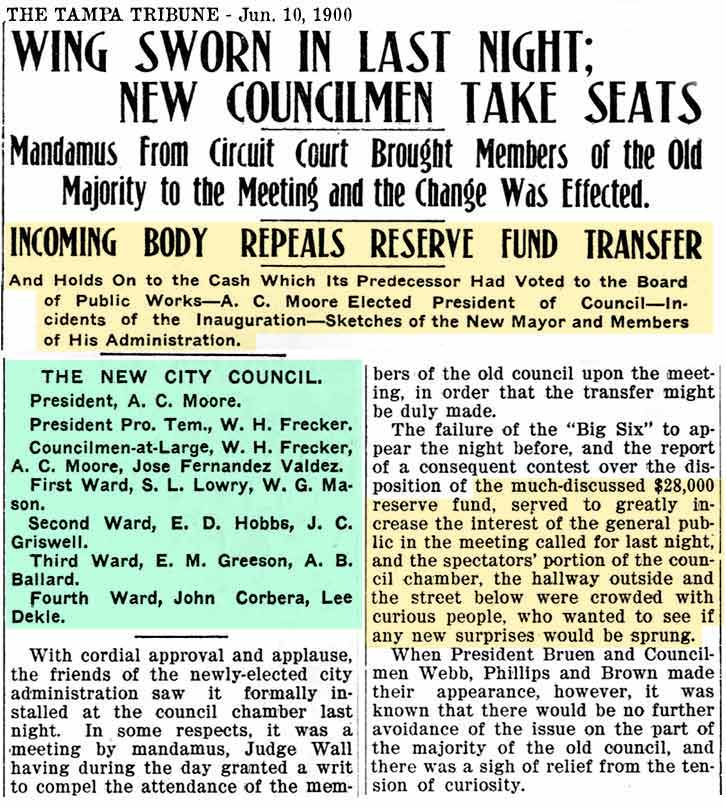
At left
is the
beginning
of a
long
article
that
covers
several
topics.
The
standoff
caused
by the
"Big
Six's"
absence
at the
last
meeting
was met
by a
Writ of
Mandamus
by Judge
Joseph
B. Wall,
compelling
those
members
to
attend
this
meeting.
Their
failure
to
previously appear
and the
issue of
the $28k
reserve
fund
they had
earmarked
for the
Board of
Public
Works made
this
meeting
one of
high
interest
for the
public,
so the
spectator's
gallery
in the
chamber,
the
hallway
outside,
and the
street
below
was
crowded
with
curious
onlookers,
waiting
for any
new
surprises.
Outgoing Council
President
Bruen
and
members
Webb,
Phillips
& Brown
arrived,
and
there
was no
further
avoidance
of the
issues
at hand.
Holmes
and
DeArmas
did not
attend.
The
following
are the
topics
of the
entire
article,
click
the
links to
see each
topic in
full:
P.1 -
THE LAST
SESSION
& THE
"LITTLE
FOUR'S"
FIRST
VICTORY
The
meeting
was
called
to order
by Pres.
Bruen,
minutes
of the
previous
meeting
were
read by
Chief
A.J.
Harris
and
approved.
A note
from
Auditor
Weller
indicated
that May
31 ended
the
fiscal
year and
a report
would be
forthcoming.
Weller also
submitted
a claim
from the
Tampa
Harness
& Wagon
Co for
$124
amount
due on a
contract
for
sprinkling
Fla.
Ave. for
the past
4
months.
(The
sandy
streets
were
sprinkled
to keep
the dust
clouds
at a
minimum.)
Weller
also
noted it
had been
submitted
too late
for the
previous
meeting.
Webb
moved
that the
bill be
paid.
Frecker
objected,
stating
he was a
member
of the
Finance
Committee
and he
had not
heard of
this
claim
before.
Webb
said it
was a
verbal
contract
made by
Mr.
Holmes
of Tampa
Harness.
Frecker
insisted
the bill
should
be
investigated.
Webb
insisted
on his
own
motion.
Webb's
motion
was put
forth
and was
defeated
by the
"Little
Four"
which
now
consisted
of
Frecker,
Wing,
Kruse
and
Morey,
outvoting
Webb,
Brown &
Phillips
due to
the
absence
of
Holmes & DeArmas.
The vote
brought
forth a
burst of
applause
from the
Citizen's
Leaguers
who
occupied
almost
all of
the
spectator's
benches.
On a
motion
by
Frecker,
the bill
was
ordered
filed.
P2.
THE
OBSEQUIES
(funeral
rites,
burial)
The
regular
business
was
suspended
and the
results
of the
election
were
formally
declared.
The
motion
carried
unanimously
and
another
outbreak
of
applause
ensued
from the
spectators.
Clerk
Henderson
prepared
his
minutes
for this
last
session
of the
old
Council
and were
signed
by Bruen,
and thus
the
record
of the
outgoing
administration
was
completed.
After
signing
off on
the
election
results,
there
was
nothing
left for
the old
council
to do
but
adjourn.
As the
old
council
left,
the
spectators
again
applauded,
"manifesting
considerable
jollification
of a
political
nature."
The only
persons
left
were
Frecker,
Clerk
Henderson,
and
three
newspaper
reporters.
The
other
newly
elected
members
then
came
forward.
P3. THE
NEW
MAYOR
Chosen
in
advance
for the
task,
former
Mayor F.
A.
Salomonson
administered
the oath
of
office
to the
new
administration,
which
was met
by
applause
by the
gallery
and
cordially
by the
outgoing
members.
In
administering
the
oath,
Mr.
Salomon
said: "Mr.
Wing,
the
people
of Tampa
fondly
hoped,
when
they
arose
this
morning,
that
they
would
find you
mayor of
the
city.
The
delay,
however,
has
happened
for the
best, as
you will
now be
able to
begin
your
administration
on the
Lord's
Day.
I
congratulate
you
heartily."
Clerk
Henderson
and Tax
Collector/Assessor
Bishoff
were
sworn
in.
Treasurer-elect
Keller
and
Councilman
Dekle of
the 4th
Ward
were
absent,
being
out of
the
city.
The
others
were
sworn in
one by
one,
each
resulting
in more
applause
as they
came
forward.
P.4
MOORE
MADE
PRESIDENT
Frecker
made the
first
motion
of the
new
administration,
nominating
A. C.
Moore as
the
council
president.
This was
seconded
and
Moore
was
elected.
Moore
wasn't
new to
this, he
was the
President
of the
previous
City
Council.
He made
some
comments
and was
seated
in the
President's
chair.
Frecker
was
elected
as
President
Pro Tem
(serving
in the
absence
of the
President.)
Attorney
Shackleford,
the new
City
Attorney
(replacing
Whittaker)
presented
a
"bundle"
of
resolutions
for the
new
council
to begin
with,
The
first
was
passed,
adopting
the
rules
used for
the
previous
administration.
P.5
HOLDING
TO THE
CASH
Frecker
introduced
the next
resolution,
which
was
greeted
by
cheers
from the
audience.
It
repealed
the
previous
administration's
resolution
which
was to
turn
over the
City's
reserve
funds to
the
Board of
Public
Works.
This was
the
subject
of the
controversy
in the
previous
administration's
standoff.
The new
resolution
was
unanimously
passed,
keeping
the $28k
in
possession
by the
City
Council
to use
as they
saw fit.
As the
funds
were
already
with the
City
Treasurer,
no
problem
was
anticipated
in
keeping
it
there.
The
Council
then
adjourned
until
the next
Friday
night.
P.6
KEYS TO
THE CITY
Previous
Mayor
Bowyer,
who was
waiting
outside,
then
invited
new
Mayor
Wing to
to his
office,
and in a
few
well-chosen
and
kindly
words,
formally
turned
over the
keys of
the city
to his
successor,
wishing
the best
success
with his
duties.
This was
followed
by more
great
applause,
for the
old and
new
mayor.
This
concluded
the
reporting
of the
events
of the
meeting.
P.7
APPOINTMENTS
TO BE
MADE
NEXT
WEEK;
POSSIBILITY
OF A RIFT
The
Tribune
reported
that by
the time
of the
next
meeting,
it was
believed
that
Mayor
Wing
will
have
decided
on some
of the
most
important
appointments
to City
positions,
and
speculation
was
running
rampant
around
town.
It was
reported
that a
considerable
split
had
developed
with the
new
administration
over the
position
of
Police
Chief,
and
there
would be
a strong
conflict
that
will
threaten
the
solidarity
of the
Mayor
and City
Council.
"This,
however,
is but a
street
rumor,
and may
not
amount
to
anything."
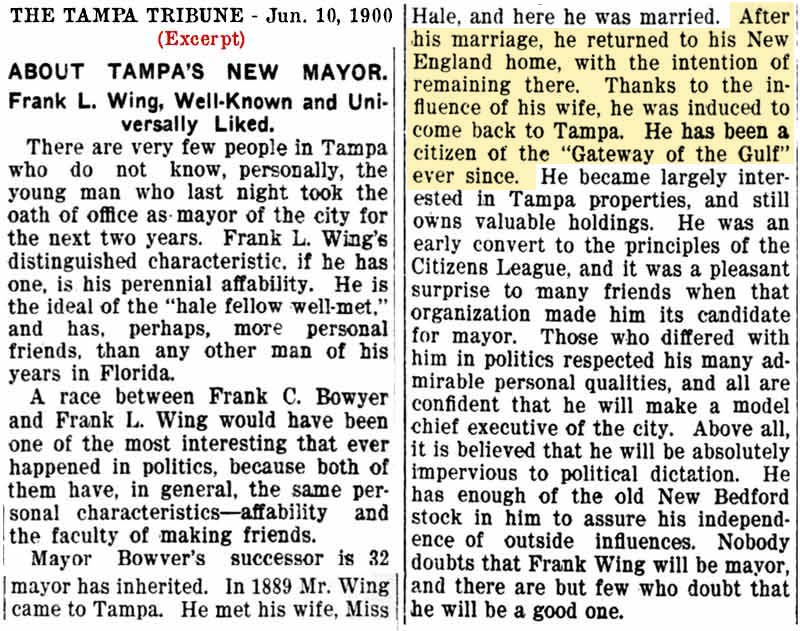
P8.
ABOUT
TAMPA'S
NEW
MAYOR,
FRANK L.
WING
This
is the
only
source
that
reveals
that
after
marrying
(in
1892) he
and Mrs.
Wing
moved
back to
his New
England
home
with the
intent
on
staying
there.
(Mayor
Wing's
administration
and
his
personal
life
and
death
are
covered
in more
detail
on Page
1 of
this
feature.)
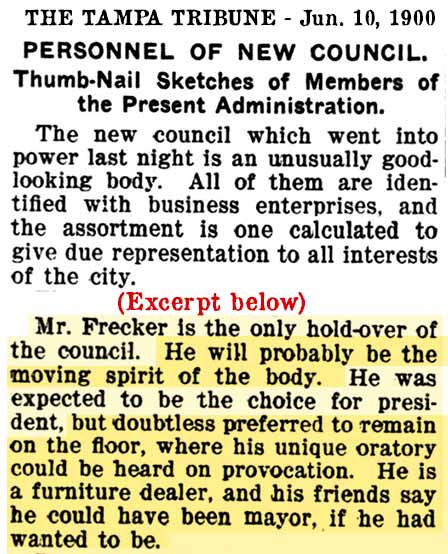
P.9
ABOUT
THE NEW
CITY
COUNCIL
This
next
section
of the
Jun. 10,
1900
article
introduced
each new
Councilman
with a
short
paragraph
about
them.
The
beginning
of this
topic,
as well
as the
paragraph
about
Frecker,
which
appears
near the
end, are
shown at
right.
Already,
his
reputation
precedes
him,
having
served
in the
previous
administration.
Click
the link
above to
read the
whole
article
about
the rest
of the
members.
MAYOR
WING
MAKES
CONTROVERSIAL
APPOINTMENT
TO
POLICE
CHIEF
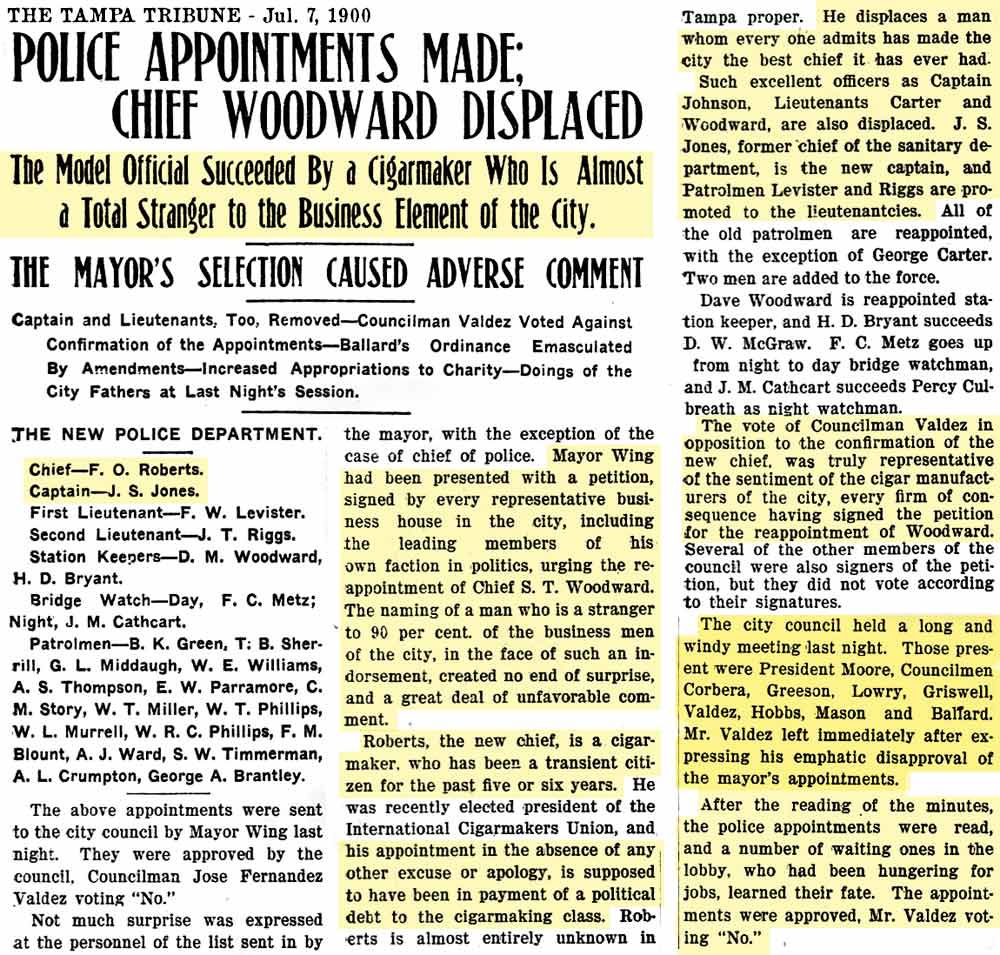
The
removal
of
Police
Chief S.
T.
Woodward,
"a man
who has
made the
city the
best
chief it
has ever
had,"
and
replacement
by a
transient
citizen,
a cigar-maker
who was
"almost
a total
stranger"
to the
business
element
of the
city"
caused a
firestorm
of
controversy
and
dissention
in in
the City
Council
as well
as the
entire
city.
It was
evident
to
everyone
that the
appointment
was a
reward
for the
backing
of Wing
by the
cigar
makers
of Ybor
City and
West
Tampa.
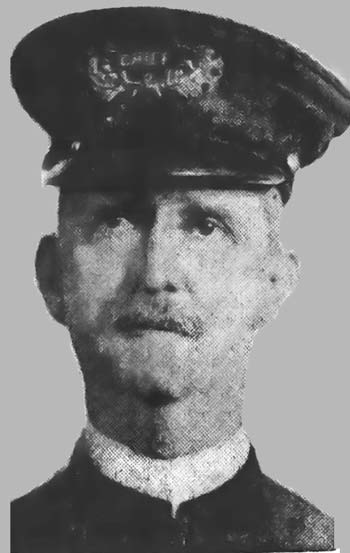
Police
Chief S.
T.
Woodward
From an
Aug. 28,
1915
Tribune
article.
Even the
Tampa
Tribune
was
against
the
dismissal.
This
article
specifies
Councilman
Valdez'
emphatic
disapproval,
but Wm.
Frecker
was out
of town
so was
not in
attendance.
FRECKER
THREATENS
TO
RESIGN
FROM
CITY
COUNCIL
DUE TO
WING'S
APPOINTMENTS
About
the
public
uproar
over his
choice
of
police
chief,
Mayor
Wing
said,
"It is
not
necessary
for
anybody
to
bother
me with
their
kicks.
There
are lots
of
policemen
around
here,
let them
tell
their
troubles
to
them...I
can't
make
appointments
to suit
everybody."
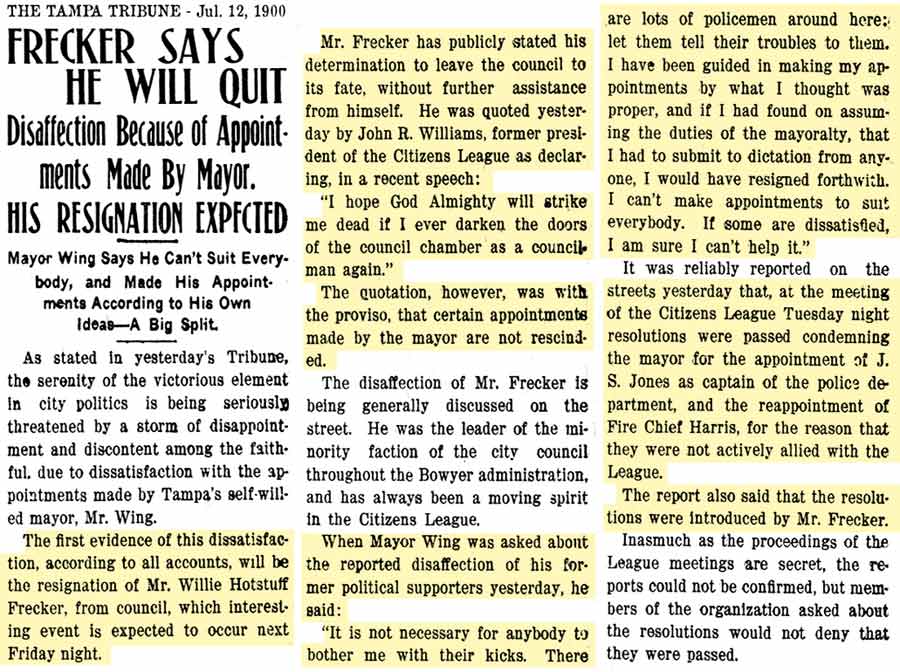
The
appointment
of
Roberts
as
Police
Chief
and
others
in that
dept.
was
unpopular
with
most
everyone,
but
reappointment
of A. J.
Harris
as Fire
Chief was
unpopular
mostly
with the
Citizen's
League.
Harris
was a
well-like
Fire
Chief,
being
the
first
Chief of
Tampa's
professional
fire
dept.
who came
to Tampa
with
plenty
of
experience
in the
mid-1890s.
to this
point.
Frecker
was
quoted
by the
President
of the
Citizen's
League
as
saying,
"I hope
God
Almighty
will
strike
me dead
if I
ever
darken
the
doors of
the
council
chamber
as a
councilman
again."

Frecker
changed
his mind
about
resigning
from
City
Council.
However, several
days
later,
he
did
resign,
but not
from the
City
Council.
Read on.
TRIBUNE
CALLS
WING'S
POLICE
CHIEF
APPOINTMENT
A
"GREAT,
GLARING
MISTAKE"
As was
common
when a
new
mayor
took
office,
supporters
clamored
for jobs
as
reward
for
their
campaigning
efforts.
The
Tribune
found a
way to
attack
Frecker,
even
though
they
agreed
with
Frecker
about the
Police
Dept.
appointments.
"It was
to be
expected
that a
man like
Mr.
Frecker...should
feel
that he
should
be
consulted
first,
last,
and all
the
time...now
there is
a howl
from the Freckerites."
The
Tribune
complimented
Mayor
Wing for
not
submitting
to every
"little
ambitious
politician
who
thinks
he is
entitled
to the
sole
management
of the
affairs
of this
growing
City.
And the
more
positively
and
emphatically
the
mayor
gives
the
public
to
understand,
that
there is
to be no
'BOSS
FRECKER'
or 'BOSS
ANYBODY
ELSE' in
his
administration,
the
better
it will
be for
him and
for the
people."
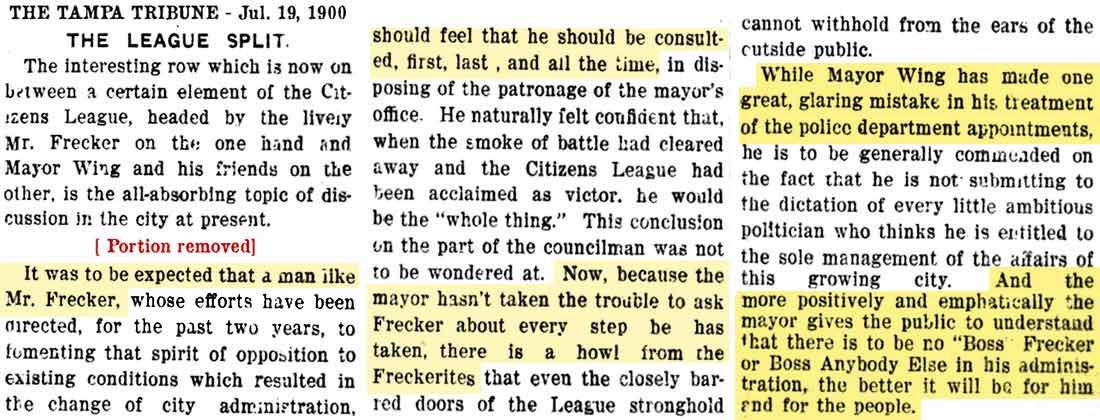
See this
entire
article,
there is
more on
the
reaction
and
efforts
of the
Citizen's
League.
and the
Tribune's
view of
the
situation.
CHARLES
SHAW
CONTINUES
ADVERTISING
HIS
CHICAGO
FURNITURE
HOUSE
COMPANY
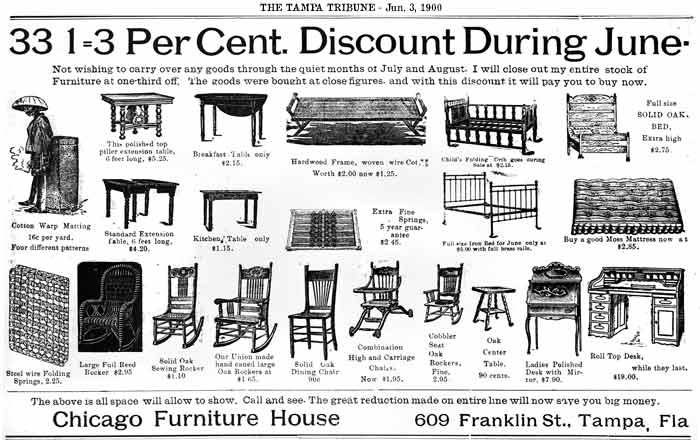
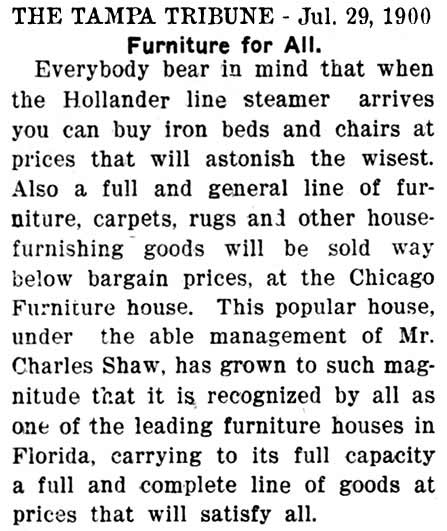
FRECKER
RESIGNS
FROM
UNION
FURNITURE
CO.
In late
July
1900,
Frecker
ended
his
partnership
with
Frank
Wing and
the
Union
Furniture
Co.
The
dissolution
of the
partnership
was no
surprise
to
anyone
given
the
clash of
political
authority
between
Mayor
Wing and
Councilman
Frecker.
Wing
would
continue
with
Union
Furniture
Co. and
keep the
name,
Frecker
and
Bishoff
were out
entirely.
Frecker told
a
Tribune
reporter
that he
anticipated
establishing
his own businesses
in Tampa
and Ybor
City.
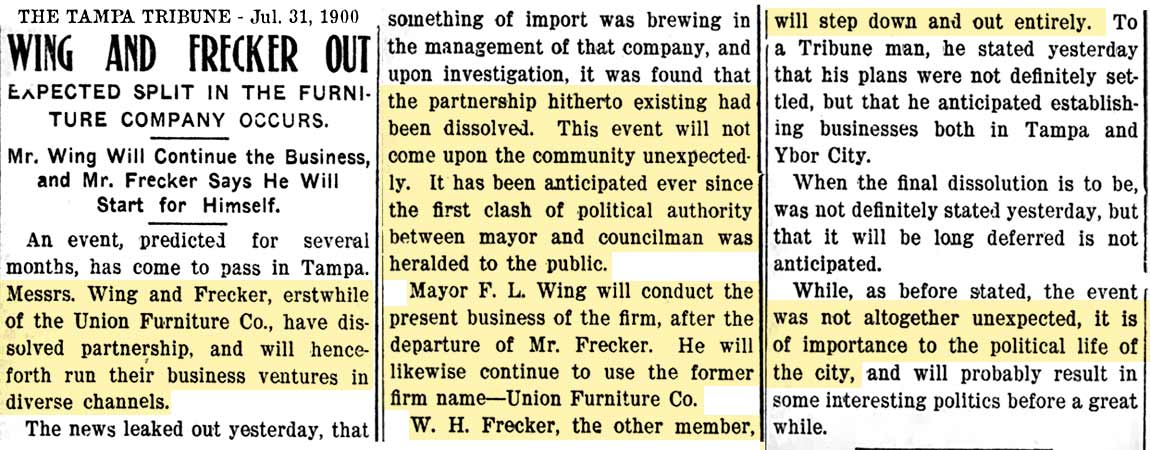
| SHAW SELLS CHICAGO FURNITURE HOUSE TO FRECKER & BISHOFF In mid-August, 1900, Charles Shaw sold his Chicago Furniture House business to Frecker and Bishoff, with them taking charge on Aug. 14th, 1900. Frecker had left CFH about six months earlier and joined Nicholas Bishoff and Frank Wing to start Union Furniture Co, but "differences between himself and Mr. Wing caused his retirement from this partnership, and after several days of rest, Mr. Frecker became the proprietor of the older establishment." |
|
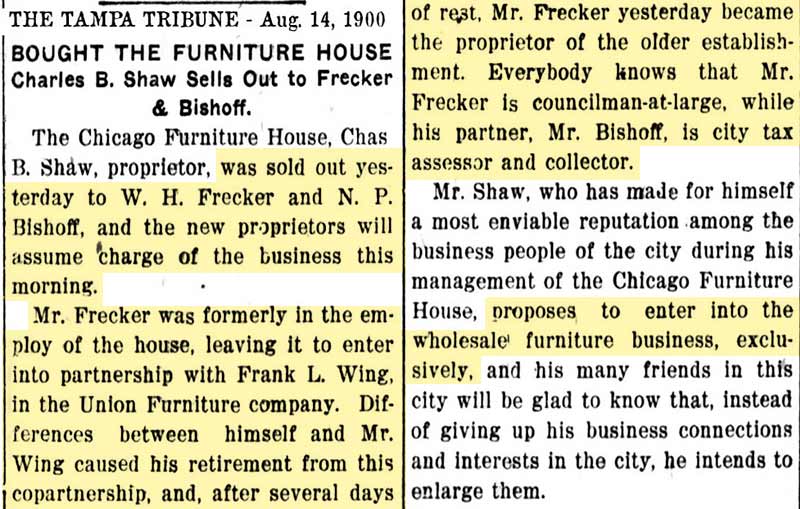
|
"Everybody knows that Mr. Frecker is councilman-at-large while his partner, Mr. Bishoff, is city tax assessor and collector."
Charles Shaw continued in the business at his Ybor City store but as a wholesaler only.
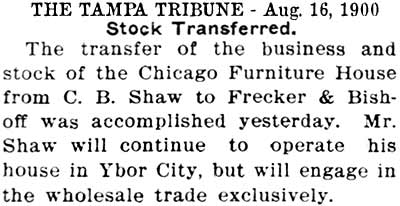 |
|
Shaw also continued to advertise his storage business through the end of August, but Frecker placed no ads in the Tribune for the rest of the year for his newly acquired Chicago Furniture House of which Nicholas Bishoff was a partner.
WHY NO MORE CHICAGO FURNITURE HOUSE ADS?
The upcoming issues in city government may have kept Frecker too busy to devote much time to his business. But a more probable reason was the Tribune's incessant criticism may have caused Frecker to advertise only in the Tampa Times. (Pretty soon, Frecker would do this with the City's legal advertising--give it only to the Times.) There are no surviving issues of the Times online from 1898 to 1912. The early issues of 1912 indicate severe damage rendering many of these practically useless. |
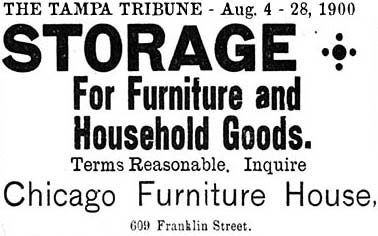
|
| |
|
|
This article has been shortened, click it to see all of it. |
|
|
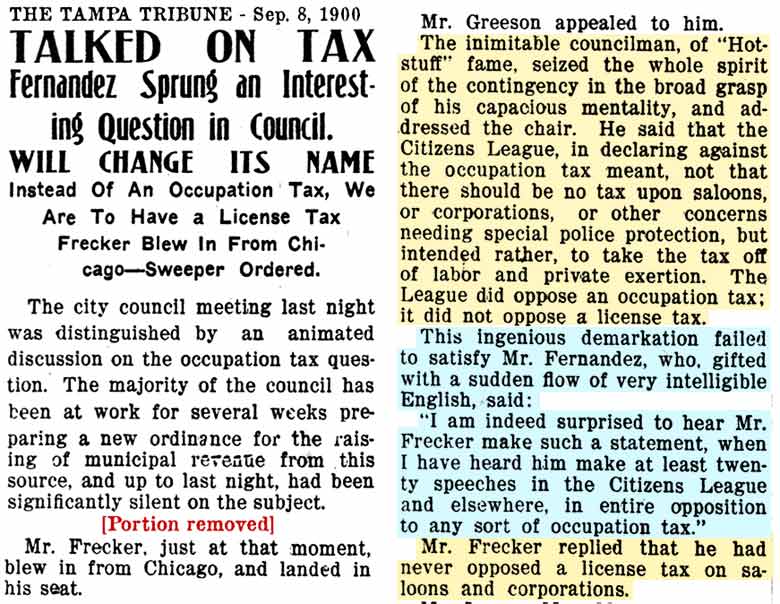
|
NEW LICENSE TAX CAUSES UPROAR
Frecker "blows in from Chicago" just in time to weigh in.In early Sept. 1900 the City Council took up the issue of raising municipal revenue. The Citizen's League had campaigned on denouncing the "hateful Occupation Tax" and doing away with it by October 1, 1900. So a resolution was put forth to do just that, but instead to change the costs of occupational licenses. The Tribune, of course had a field day with this, stating "In other words, the name of the revenue-raising machine is to be changed, while the machine itself remains practically the same."
Ballard thought it was too early to pass such a resolution to end occupational taxes. Greeson began to explain what the Citizen's League meant by no occupation tax when "his lucid explanation was interrupted by an unexpected incident. Mr. Frecker, just at the moment, blew in from Chicago and landed in his seat."
Frecker explained that the Citizen's League never meant that there should not be taxes on saloons or corporations, or any other concern needing police protection, instead, it intended to take the tax [burden] off of labor and working class.
|
| Fernandez still didn't seem to get it when he said he was surprised to hear Frecker say this, because he, like the Tribune, thinks it's just a name change, so he says he had heard Frecker make "at least twenty speeches in the Citizen's League and elsewhere, in entire opposition of any sort of occupation tax." So Frecker added that he never opposed a license tax on saloons and corporations. In the end, the resolution was tabled until next Wednesday night to consider what sort of tax would be imposed. |
| LICENSE ORDINANCE PRESENTED AND PASSED WITH DRASTIC INCREASES TO LARGE COMPANIES |
With only one dissenting vote, a new license ordinance which the Tribune says not only placed "substantially the same old tax upon every occupation in the city, it adds a most outrageous assessment upon all of the larger concerns which can savor nothing less than deliberate robbery."Apparently, the Tribune was under the impression that the Citizen's League campaigned on eliminating taxes altogether, but the League's platform was lessen the tax burden on the small business and no more sweet, preferential deals or special treatment for big business just because of their contribution to Tampa's progress.
In just one article, the Tribune calls Frecker a Hotstuff, big-footed, dictatorial, Chicago boss politician, who alone and solely is the ruler of the city, who "pawed the earth, snorted and sniffed, reared and charged, attacked all the interests of the city, and placed himself as the mighty monarch of the whole community, who was put into the City Council by ill-advised voters, and that the other members of the council are mere mummies, obeying his every whim.
The attorneys for the big corporations were in attendance to try and "urge" the Council for "mere justice," quoting "liberal statistics to show that the tax imposed in the ordinance was unprecedented in the whole country."
Peter O. Knight, President of TECO and the street car line, was especially miffed, and would later express his opinions on Councilman Frecker.
A small portion of this article which was irrelevant has been cut out. Click here to see the whole article. |
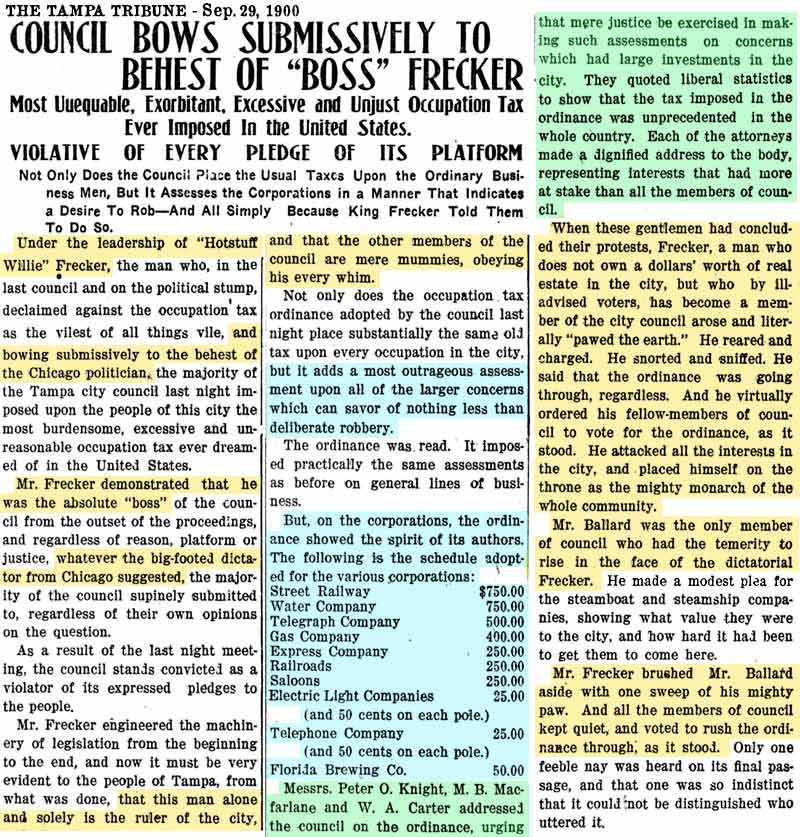
|
| CORPORATE ATTORNEYS FIND A LOOPHOLE, BUT TAX COLLECTOR WAS BRIEFED IN ADVANCE HOW TO HANDLE IT A year earlier, in 1899, when the city occupational license tax was increased, attorneys for the big companies went before the Circuit Court to kill the tax, attacking its constitutionality. Judge J. B. Wall sustained the right of the City to levy and collect the taxes.
This time, the lawyers planned a different strategy. Under the City Charter, an ordinance has to be published five days before it can go into effect. The first ad appeared on Oct. 1, a Monday. So the new tax could not go into effect until Oct. 5, Friday afternoon. |
|
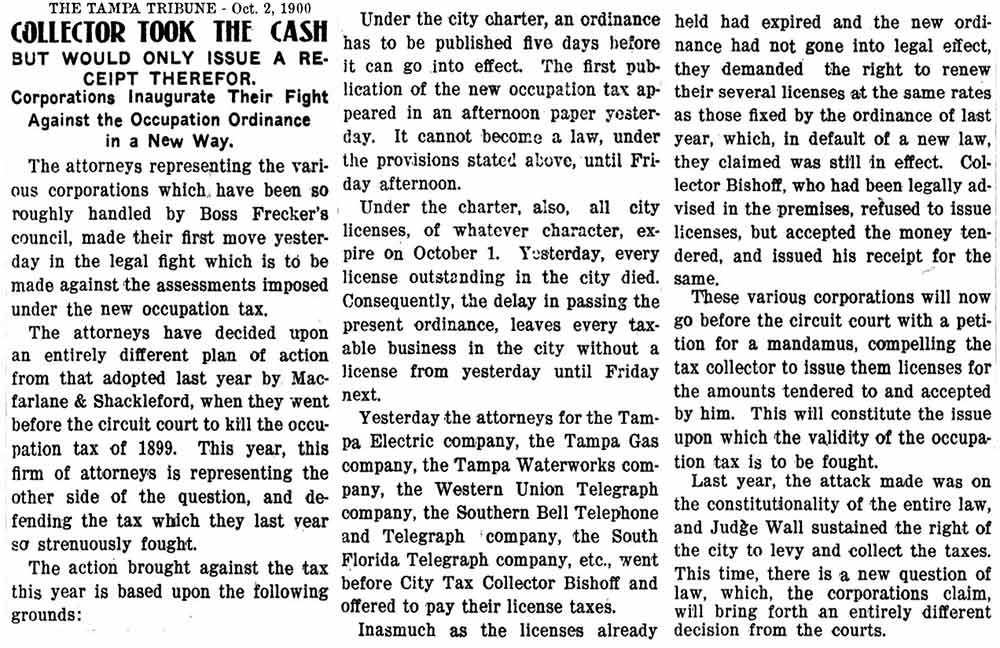
|
But also under the City Charter, all licenses expire on Oct. 1, so as of Monday (yesterday), this left every business in the city without a license until Friday. So on Oct. 1, the attorneys for TECO, Tampa Gas, Tampa Waterworks, Western Union, Southern Bell, and South Fla. Telegraph, all went to the Tax Collector's office to insist on paying their license tax according to the old assessments, the very ones they fought against the year before, claiming by default the old rate was still in effect.
Bishoff had been prepared to handle this, by accepting the payment, issuing a receipt, but not issuing a new license.
Then the attorneys planned to take the matter to Circuit Court with a petition for mandamus, compelling the tax collector to issue them the license for the amount paid. |
MINOR TWEAKS TO THE OCCUPATIONAL LICENSE ORDINANCE
As a result of the scene in the Tax Collector's office, the City Council met on the evening of Oct. 1 to amend the controversial ordinance No. 245 to address the situation of some businesses paying the old tax before the new tax ordinance took effect. Basically, a new ordinance No. 246 said anyone who paid last year's rate whose rate went up this year must pay the difference to get a license. Those who paid last year's rate and their tax went down this year would get a refund. Ordinance No. 245 was amended by passing No. 247 excepting the license tax on steamboats and steamship companies, the exception that Ballard had made a "modest plea" for which Frecker "brushed Mr. Ballard aside with on sweep of his mighty paw." See the list of all the occupational licenses and their cost. See tax ord. No. 245
After they open, click again to see full size. Meanwhile,
Stovall's
tantrums
continued in the Tribune...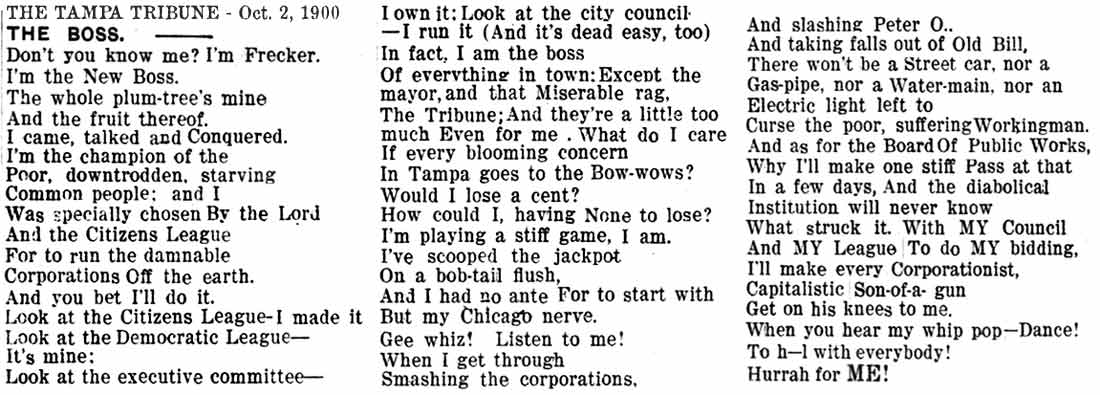 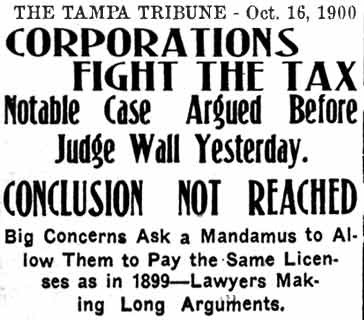
OCCUPATIONAL LICENSE ISSUE GOES TO COURT On Oct. 15, Circuit Court Judge Joseph B. Wall heard arguments from corporate attorneys asking for a mandamus compelling the city tax collector to receive payments for licenses under the occupation tax law of the previous year, and to issue the ones that were already paid at last year's price. The plaintiffs were TECO, Tampa Gas, Tampa Waterworks, Southern Bell, Seaboard Railway, all represented by Peter O. Knight, and Western Union and the Plant System of railways represented by Sparkman & Carter. Knight started at 9 a.m. and did not conclude until 1 p.m. In the afternoon, Macfarlane and Shackleford, representing the city, addressed the court for the rest of the afternoon. On the 16th, attorney for Western Union and Seaboard, Judge W. A. Carter, presented his argument before the court.See the whole article. |
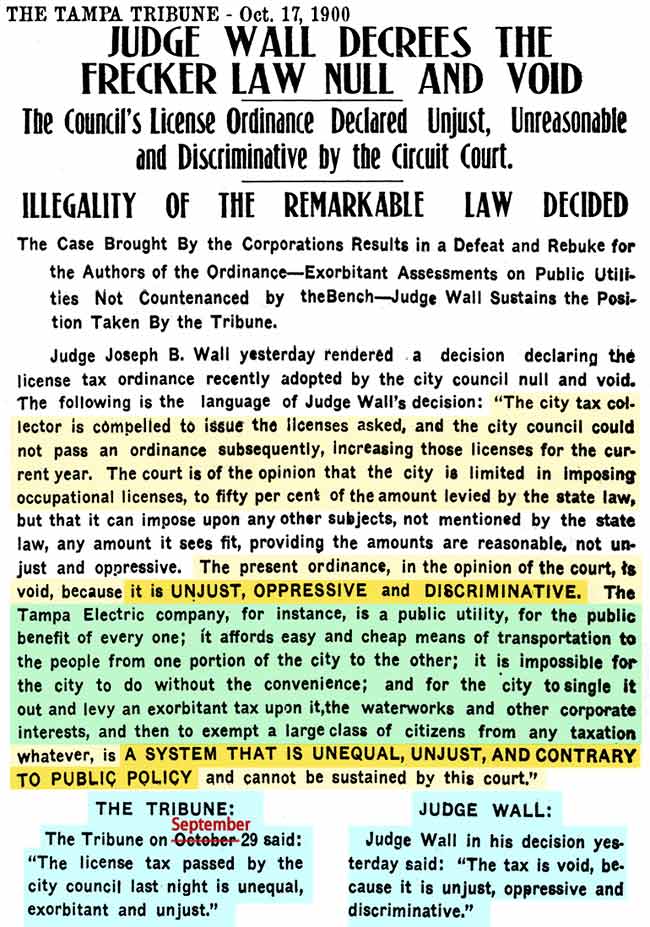 |
JUDGE WALL STRIKES DOWN LICENSE ORDINANCE NO. 245
The Tribune gloats and considers itself victorious, stating that "Judge Wall sustains the position taken by the Tribune." The city attorneys were ready to appeal to the Florida supreme court. 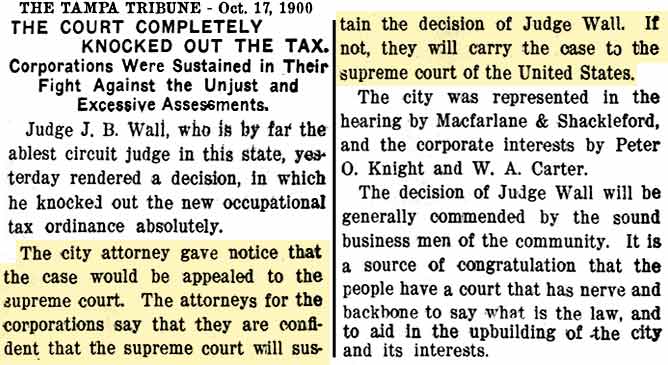
|
|
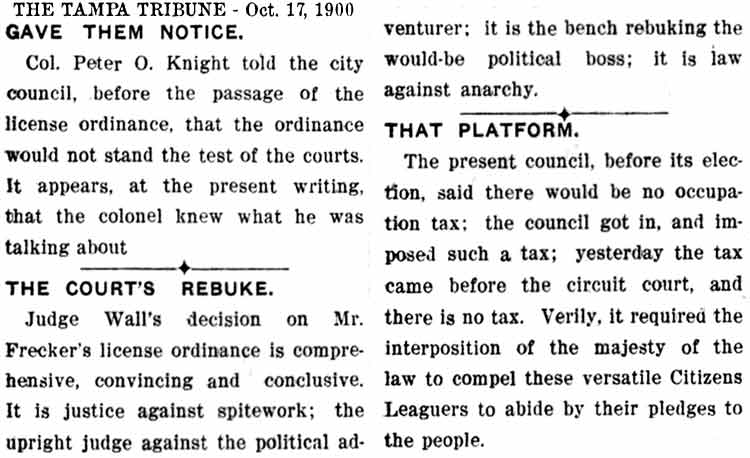
|
|
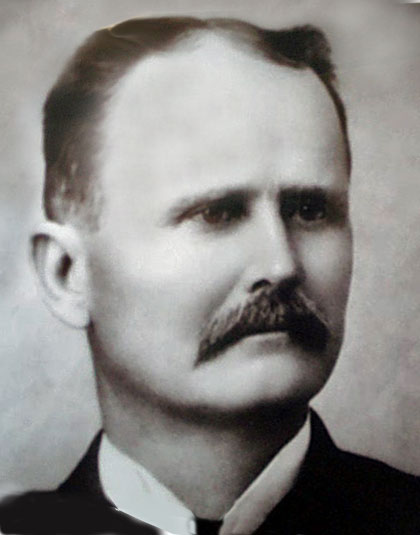
JUDGE JOSEPH B. WALL
Joseph Baisden Wall was a half-brother of
former Tampa Mayor & former Tribune editor Dr. John P. Wall. Their
father was Civil War Reconstruction era Judge Perry Green Wall,
patriarch of the large Wall family in Tampa, their mothers were the
first and second wives of Perry G. Wall.
Portrait from the 10th Judicial Circuit Court of
Florida
When Perry G. Wall's first wife Nancy Hunter Wall died in Feb. 1845, she
left Perry with seven children
(four daughters and three sons which included John P. Wall and William "Billy" Washington Wall), all under the
age of 11. Perry and his children
moved from Hamilton Co. to Spring Hill, Benton County (later renamed
Hernando Co.) where on December 11, 1845, Perry married 35-year old
Barbara R. Baisden. She was a daughter of Josiah Baisden.
Perry G. Wall and Barbara Baisden had
three children: Joseph Baisden Wall (b.1847), Charles F. Wall**
(b.1849), and Ella Wall, who died young.
Through the marriages of Perry G. Wall's
children, the Walls were related to the
families of Clarke, Knight, Lykes, Friebele, Parkhill, McKay, Frazier,
Linebaugh, Dupree, and Hendry.
Joseph Baisden Wall (fourth son of Perry G.
Wall) was born Jan 23, 1847 and served in the 2nd Florida Reserves
during the latter part of the Civil war. He attended the University of
Virginia and was admitted to the bar in Brooksville in 1869. He became
one of the most distinguished lawyers and jurists that Florida had yet
produced.
J.B. Wall married first in 1869 to Precious
Ederington of Brooksville, with whom he had one daughter Helen (she
married Judge Charles B. Parkhill). J. B. Wall then moved to Tampa in
1872. For several years in Tampa, J. B. Wall was a
partner of Hon. Henry L. Mitchell and afterwards, partner of Peter O.
Knight. In 1874 he was appointed State Attorney by Republican
governor Ossian B. Hart. J. B. Wall prospered as a lawyer,
entered politics and by 1886 was President of the State Senate.
Joseph
B. Wall's second wife was Fredericka Lykes of Brooksville; they had no
children.
WALL INVOLVED WITH CANE BEATING FORMER JUDGE MAGBEE
In his younger years, J.B. Wall was hot-tempered, as was his nephew-in-law, James E. Lipscomb. On Aug. 12, 1878, he was with
Lipscomb when Lipscomb got into an altercation in the streets of Tampa
with the retired Judge James T. Magbee. Lipscomb pulled Magbee out
of his buggy and gave him a thorough caning, using the whale bone end of
his cane. The issue was
what Lipscomb and Wall considered a derogatory comment that Magbee had
published in his Republican newspaper, the Tampa Guardian, about their
uncle, the late Billy Wall. Later, J. B. Wall wrote to the Sunland
Tribune (John P. Wall, editor) and justified the caning by
stating that "Magbee is
sufficiently young and strong to be vicious and therefore by all social
laws is amenable to chastisement." Though he claimed he hadn't touched
Magbee, all three men involved in the affair were fined $10 in the
Mayor's Court. Magbee was 58 years old.
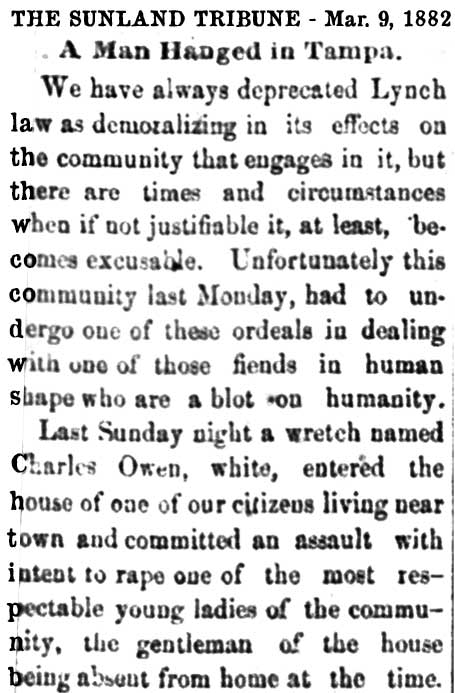
WALL TIES THE KNOT--THE HANGMAN'S TYPE, AND IS DISBARRED FROM FEDERAL PRACTICE
On March 6, 1882, Joseph B. Wall assisted a lynch mob that hanged in
front of the county courthouse a white itinerant sailor accused of
attempted rape. Supposedly, Wall was in court that day, left the
building and reportedly tied the "hangman’s knot, because no one else in
the crowd knew how." The article about the lynching doesn't mention Wall
or the the noose incident, but before the end of that week, Judge Locke disbarred
Joseph Wall for it. Naturally, editor of the Sunland Tribune (and
half-brother of J. B. Wall) took to his paper to criticize Judge Locke
for his action.
Click the article at right to see all of it.
J. B. Wall was later appointed judge of the criminal court of record
and circuit court, which was the last official position he held before
his death in 1912. He was more than once prominently mentioned in
connection with candidacy for governor, congressman and U.S. senator,
though the only thing preventing him was his own consent to run for the
offices.
**This was not the infamous mob figure
Charlie Wall. Charles F. Wall was a successful fruit grower and
merchant who for many years lived at Seaside, then Hillsborough County,
then Brooksville for the remaining years of his life. He had no
children, but he and his wife adopted a baby who was a great comfort to
them in their later years. Charles F. Wall was a man of remarkable
Christian spirit who was beloved by all who knew him; one who was always
looked to in time of distress for advice--a man of high character. He
died in 1913.
Read more about Judge Perry
Green Wall and Joseph Baisden Wall, and see all the articles about the
above events, here at TampaPix features, "Knight
and Wall Hardware" and "James
T. Magbee and the Civil War, Tampa."
See this 1996 St. Pete Times article about Tampa's lawlessness. |
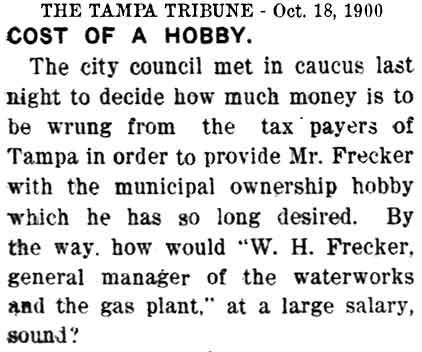
In light
of Judge
Wall's
decision
to
nullify
the new
tax
ordinance,
City
Council
met on
the 17th
to make
changes
to
Ordinance
#245. According
to the
Tribune,
it
was
being
modified
to put
more
burden
on the
the tax
payers.
 CITY COUNCIL GIVES TRIBUNE THE AXE CITY COUNCIL GIVES TRIBUNE THE AXE
A few days after Judge Wall's ruling, Frecker brought a resolution before City Council to cease using the Tribune for its legal advertising and continue only with the Times. He stated that the Tribune was "a paper which uses every opportunity for to abuse the council." It passed unanimously.
But
Stovall
didn't
stop
"biting
the
hand"
that
once fed
him.
MAYOR
WING
ADDRESSES
CITY
COUNCIL
ON THEIR
MISHANDLING
OF THE LICENSING
MATTER
The
Tribune
praises
Mayor
Wing for
being a
mayor of
"sensible
and
conservative
views,
who is
not a
party to
and does
not
approve
of the
erraticism
of the
council."
It took
pleasure
in
publishing
the
message,
saying
it
showed
that the
mayor
was not
responsible
for the
"farce-comedy
now
being
palmed
off on
the
public
under
the
guise of
reform
legislation."
Wing
urged
City
Council
to issue
the
licenses
that
were
purchased
from
Oct. 1
to Oct.
5th, and
to not
pursue
any more
legal
action
with an
appeal
to the
State
Supreme
Court,
because
it would
end up
costing
the city
more
than
what
they
would
gain if
they
won.
But the
Mayor
DID
agree
that the
ordinance
was
perfectly
legal
under
Tampa's
city
charter,
and that
no court
could
have
successfully
defeated
it IF it
had been
passed
in time
to
publish
it for 5
days
BEFORE
Oct. 1.
Mayor
Wing
also
stated
that
bringing
on years
of
trouble
and
lawsuits
by
dragging
the
matter
out in
the
courts
is
undesirable
due to
an
upcoming
election
in which
the
taxpayers
would
vote on
waterworks
bonding
issue.
"You
cannot
sell
your
bonds if
the city
is
engaged
in
litigation
with its
taxpayers."
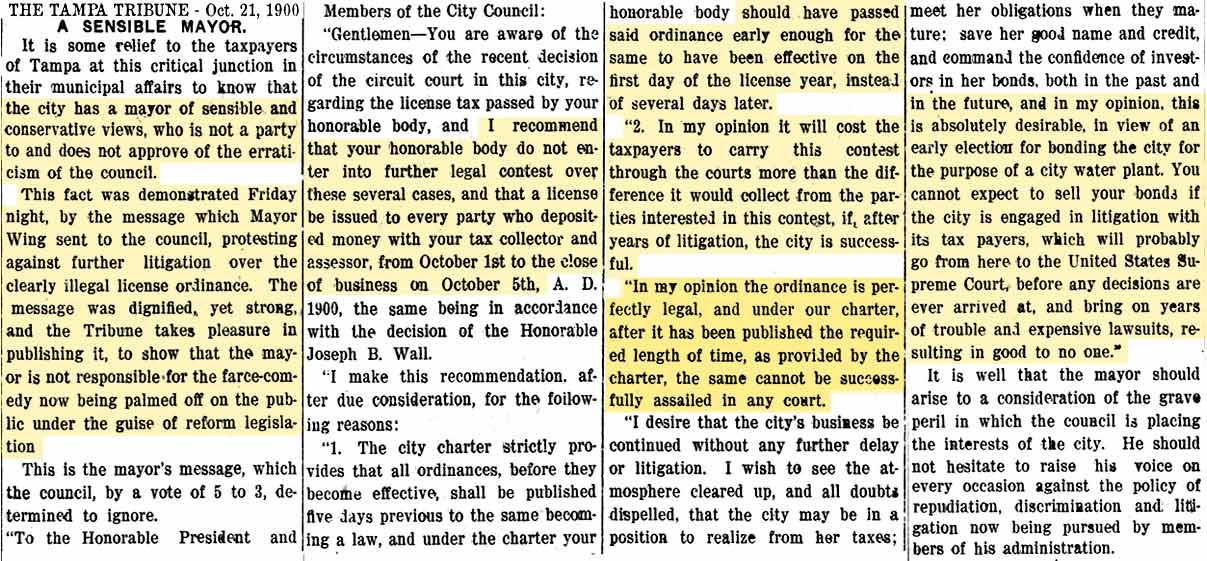
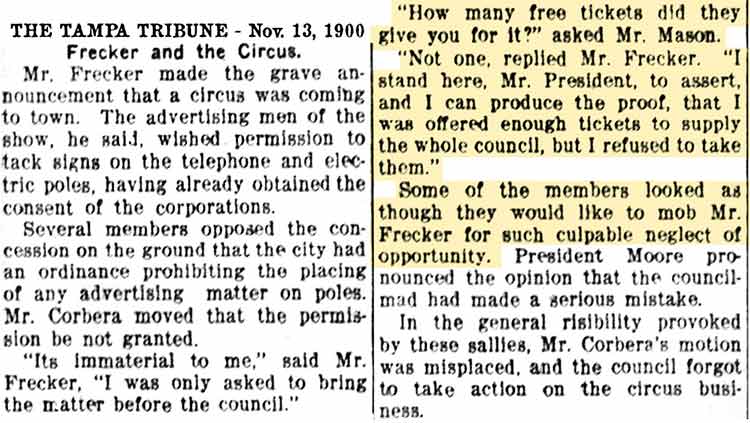 THE
CIRCUS
COMES TO
TOWN THE
CIRCUS
COMES TO
TOWN
At a
City
Council
meeting
in
mid-November,
Frecker
brought
up the
subject
of the
circus
coming
to town
by
informing
the
councilmen
that
circus
promoters
wanted
permission
to tack
signs on
telephone
and
electric
poles,
and they
already
had
consent
of the
corporations
(TECO,
So.
Bell,
etc.)
Several
members
opposed
this
stating
that the
city had
an
ordinance
against
the
placing
of
advertising
matter
on
poles.
A motion
was made
that the
permission
not be
granted.
On the
vote,
Frecker
stated
that
"It's
immaterial
to me, I
was only
asked to
bring
the
matter
before
council."
To which
Councilman
Mason
asked,
"How
many
free
tickets
did they
give you
for it?"
meaning,
to bring
the
matter
up in
Council.
Frecker
replied,
"Not
one, and
I can
produce
the
proof
that I
was
offered
enough
tickets
to
supply
the
whole
council,
but I
refused
to take
them."
The
Tribune
then
airs its
opinion
that
some of
the
members
looked
like
they
could
have
mobbed
Frecker
for
turning
down the
free
tickets.
Council
Pres.
Moore
said the
the
council
had made
a
serious
mistake
(in not
allowing
flyers
to be
posted.)
The
Tribune
refers
to the
ensuing
discussion
as a
laughable
sudden
charge
against
an
enemy,
and that
council
forgot
to take
action
on the
matter.
THE
GREAT
EMBEZZLEMENT
CASE OF
1901 -
CHARLIE
FRECKER
& NICK
BISHOFF
ARRESTED
AND
CHARGED
The year
1901
started
off with
fireworks
in the
city tax
collector's
office
when an
audit of
the
licensing
and cash
receipts
ledgers
turns up
a host
of
discrepancies.
The
Tribune
has it
all
figured
out from
the
onset
and
pronounces
Charlie
T.
Frecker
guilty.
Nick Bishoff
had hired
young
Charlie
as his
personal
assistant,
so he
was not
an
actually
an employee
of the
city.
THE
TAMPA
TRIBUNE
-
Jan.
12,
1901
"Charles
Frecker
is a
son
of W.H.
Frecker...and
got
the
appointment
to
the
responsible
job
through
the
influence
of
his
father,
who
has
not
only
occupied
a
position
of
practical
bossism
in
some
of
the
departments
of
city
government,
but
also
is
partner
with
Bishoff
in
business."
"Again,
the
falsification
of
the
records
by
young
Frecker
and
the
abstraction
of
the
money
was
done
in
such
a
clumsy
and
bungling
manner
that
it
was
sure
to
be
discovered
sooner
or
later."
Auditor
Weller's
report
was only
partial,
as the
audit
was not
yet
complete.
But
already
there
were
twenty-two
errors
amounting
to over
$600 in
the
collection
of the
occupational
license
taxes,
extended
back to
October
of 1900.
Even
back to
the day
when the
tax
collector's
office
was
flooded
with
attorneys
wanting
to pay
the old
tax
rate.
The rest
of the
article
explains:
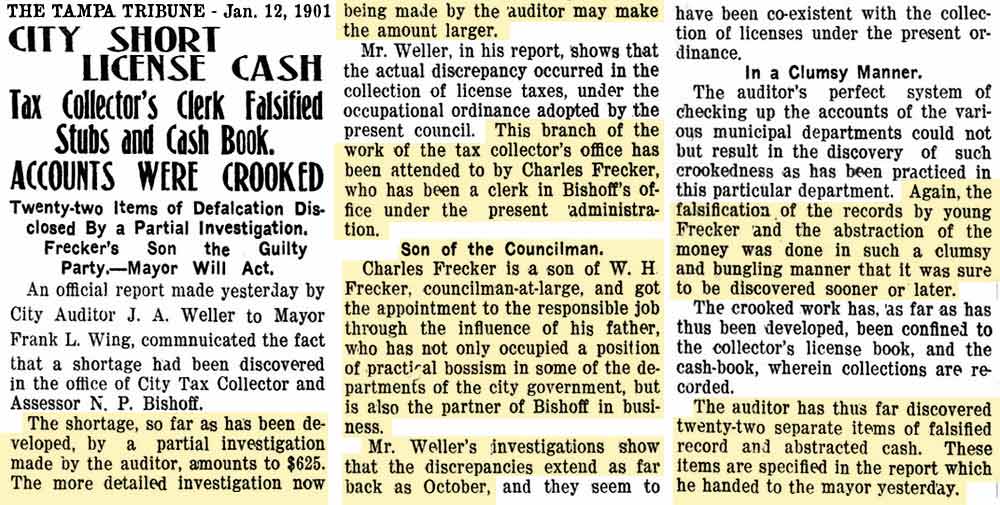 HOW
IT WAS
DONE HOW
IT WAS
DONE
An
example
of the "stealage"
is
given:
A saloon
owner
paid
Frecker
$250 for
his
license.
(Apparently,
some of
the
exorbitant
fees
didn't
change
after
the
whole
ordinance
was
struck
down by
Judge
Wall.)
C.
Frecker
issued
the
license
for
$250,
but on
the stub
in the
license
book
wrote
only $5,
and in
the cash
receipt
ledger
also
only
wrote
$5, "an
embezzlement
of
$245--readily
detected
by an
inspection
of the
license
in the
saloon
man's
possession."
More
examples
are
given,
Armour
meat
company,
a $100
license
fee, $10
entered
in the
cash
book and
license
stub
book.
Cudahy &
Co,
another
meat
company,
same
amounts
entered
as
Armour.
Donaldson
for his
vaudeville
show,
$100
license,
$10
entered
in both
books.
Fessenden
Real
Estate,
$25
license,
$5 in
the
books.
Greeson,
"a
member
of City
Council
and
political
associate
of W. H.
Frecker,"
$15
license,
$5
entered
in the
books.
There
were
sixteen
more
such
discrepancies
found
thus far.
On the
day
previous
to this
article,
Nick
Bishoff
paid to
the city
treasurer
the sum
of $625**
which
was
missing,
but he
"disclaimed
any
knowledge
of the
crooked
transactions,
and
young
Frecker
excuses
himself
on the
plea
that
they
were due
to
clerical
errors."
**It
was
actually
$1,625
that was
missing
which
Bishoff
paid to
the city
treasurer.
NOT
CLERICAL
ERRORS,
SO SAYS
THE TRIBUNE
Mayor
Wing had
made not
public
action
on the
report
yet, and
the
matter
wasn't
mentioned
in the
council
meeting
last
night.
The
Tribune
wanted
Charlie Frecker's
head two
months
earlier
when
there
was some
squabble
over the
circus
license
fee.
Things
only get
worse
for
Frecker
in the
coming
days, as
more
glaring
discrepancies
are
found,
amounting
to over
$1,000.
CLICK TO
READ THE
REST OF
THIS
ARTICLE--The
Tribune
has it
all
figured
out, how
it was
done and
"whodunnit."
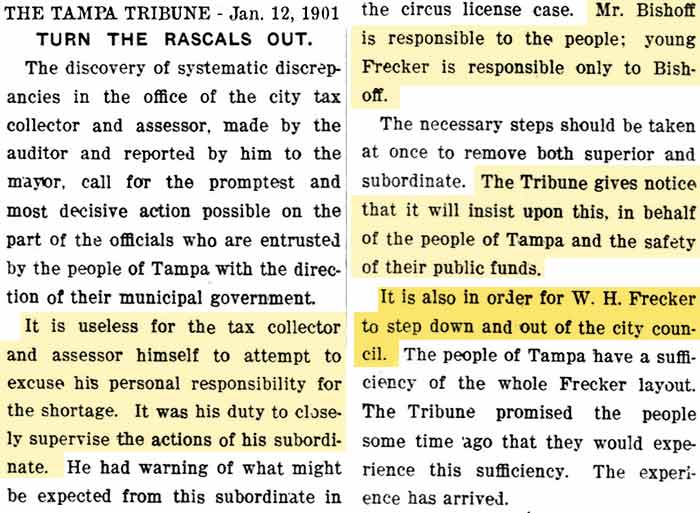
TRIBUNE
WANTS
W.H.
FRECKER
TO
RESIGN
FROM
CITY
COUNCIL
On the
same day
the news
broke in
the
Tribune,
a second
article
was
included,
seen at
left,
calling
on the
mayor to
act
quickly
and
fire
Bishoff
because
he was
responsible
for
supervising Charlie
Frecker,
and fire
Frecker
as well.
Stovall
gives
notice
that the
Tribune
"will
insist
upon
this, in
behalf
of the
people
of Tampa
and the
safety
of their
public
funds."
It's no
surprise
that the
Tribune
also
called
for
Councilman
Frecker
to
resign
as well,
citing
"The
people
of Tampa
have a
sufficiency
of the
whole
Frecker
layout."
No poll
of the
opinions
of Tampa
citizens
has
appeared
or even
been
mentioned
in the
Tribune.
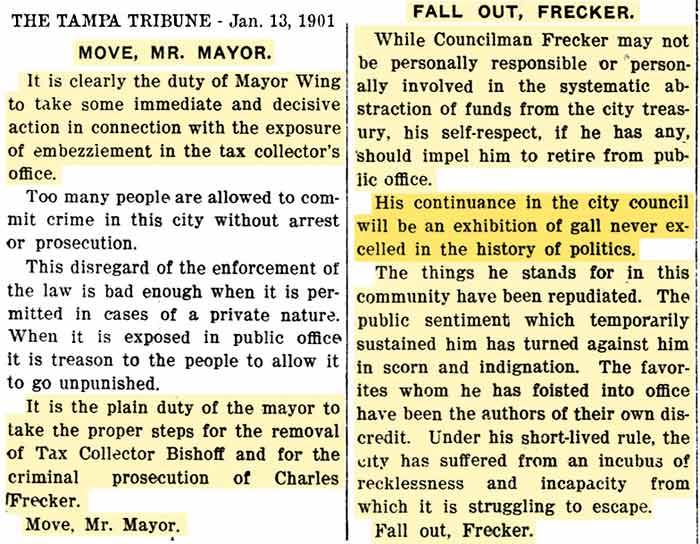
TRIBUNE
PUSHES
MAYOR
WING TO
FILE
CRIMINAL
CHARGES
The next
day, the
Tribune
urges
Mayor
Wing to
"MOVE"
and
Frecker
to "FALL
OUT."
"It is
the
plain
duty of
the
Mayor to
take the
proper
steps
for the
removal
of Tax
Collector
Bishoff
and for
the
criminal
prosecution
of
Charles
Frecker."
Even
though
"Councilman
Frecker
"may not
be
personally
responsible
or
personally
involved...his
self-respect,
if he
has any,
should
impel
him to
retire
from
public
office."
The
Tribune
says if
he
remains,
it
"will
be an
exhibition
of gall
never
excelled
in the
history
of
politics."
PLANT
CITY
COURIER
CHEERS EDITOR
STOVALL
- Formal
City
Charter
Violations
Against
Bishoff Published
An
article
from the
Plant
City
Courier,
date
unknown,
was
reprinted
in the
Tribune
on Jan.
27,
1901.
The
Courier
praises
Stovall
for the
"warmest
article...that
ever
emanated
from
Tampa or
any
other
town in
the
South."
Stovall
had his
Gatling
guns
loaded
and
pulled
the
trigger
with
unerring
aim,
hitting
the
bull's
eye in
rapid
succession.
Two
charges
against
Bishoff
are
described,
each
with
specifics
(highlighted
in pink
or
blue).
Apparently
not only
were
some
entries
recorded
for
under
what was
actually
paid,
the
fourth
specific
of the
second
charge
shows
$6,000
in
receipts
were
made to various
parties
but the
amounts
were NOT
paid.
What
appears
to be
happening
is
favors
are
being
done for
some
businesses
by over
reporting
their
payment,
while
others
who paid
in full
are
having
some of
their
funds
diverted
somewhere
else,
possibly
not in
anyone's
pocket
but in
the city
cash
total so
the
overcharges
and
undercharges
balanced
out--but
obviously
did not.
It's not
clear if
all of
the
$6,000
worth of
receipts
were not
actually
collected.
And that
wasn't
all of
it,
there
were
"other
good and
sufficient
reasons"
to
charge
Bishoff.

The
above
article
incorrectly
describes
Bishoff
as
having
been
removed
from his
position.
Bishoff
had
actually
resigned
his
position
and
Mayor
Wing
appointed
J. S.
McFall
to fill
the
vacancy.
Later
City
Council
would
meet to
vote on
whether
to
accept
it or
not, and
fire him
instead.
This
would
have a
surprise
consequence
later.
CRIMINAL
CHARGES
FILED
AGAINST
BISHOFF
AND C.
FRECKER
When
former
Judge
Perry G.
Wall,
patriarch
of
Tampa's
large
Wall
family,
returned
from
Cuba, he
had his
attorney
(son) John P.
Wall
file
criminal
charges
on
Bishoff
and
Frecker.
Judge
wall had
learned
of these
events
from a
copy of
the
Tribune
while in
Havana.
John P.
Wall
also
happened
to be
his son,
former
editor
of the
Tribune,
and
former
mayor of
Tampa.
Judge
Wall,
and no
doubt
many
others,
figured
Mayor
Wing
would
have
filed
the
criminal
charges
by this
time,
and not
having
and not
having
done so
at this
point
prompted
Perry G.
Wall to
act.
This
reason,
and
another
one, are
stated
in the
next
article,
"MORE
WARRANTS
TODAY." P.G.
Wall was
probably
influenced
by the
Tribune's
agitation
and
intense
dislike
of
Councilman
Frecker.
Warrants
on
counts
#1 and
#2 on
Bishoff
and
Frecker
were
sworn,
and they
were
promptly
arrested.
Bail was
set but
not high
enough
for
Wall's
liking
so he
filed
more
charges--#4
through
#6.
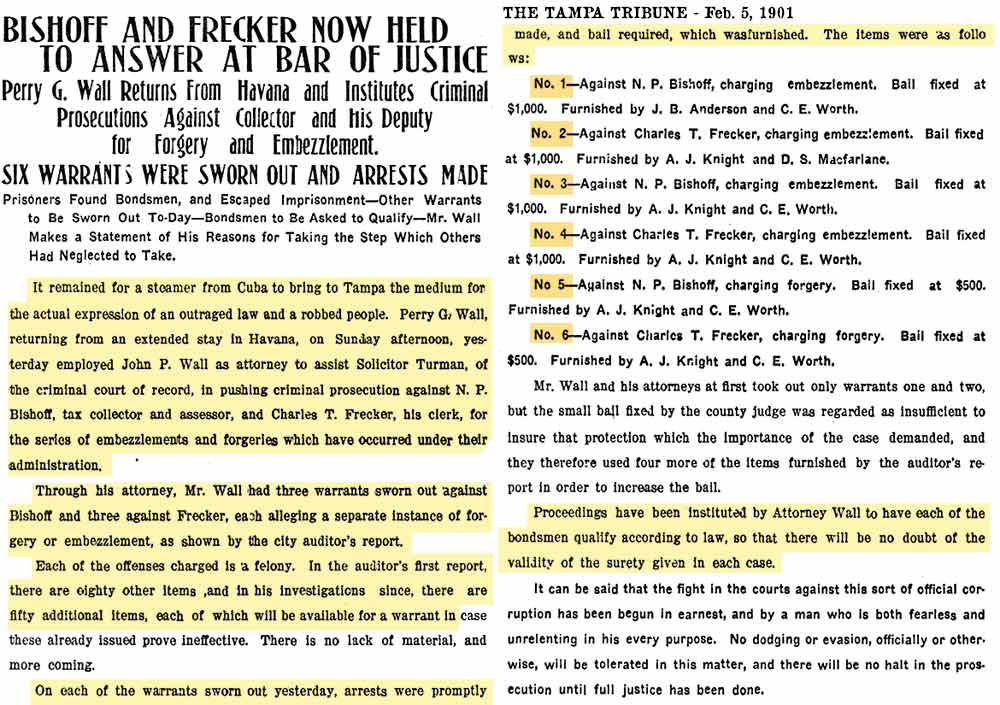
BISHOFF
AND C.
FRECKER
ARRESTED,
CITY TO
FILE
CLAIM
WITH
FIDELITY
&
GUARANTY
CO. FOR
MISSING
FUNDS
After
their
arrest
warrants
had been
properly
issued,
Dep.
Sheriff
Lester
arrested
Bishoff
at his
place of
business,
which
would
have
been the
Chicago
Furniture
House.
Charlie
Frecker
was
arrested
at home;
both men
expected
it.
Here it
is
apparent
that P.G.
Wall
took the
initiative
to file
charges
due to
the the
mayor
not
having
yet done
so.
Surely
Mayor
Wing
would
have,
and
probably
wanted
to first
make
sure
that
Bishoff
was
properly
dismissed
and the
audit
completed.
The
Tribune
believes
it is
strange
that so
much
time had
passed
and yet
the City
had not
yet
taken
legal
action:
The
Tribune
wrote on
Feb. 5,
1901:
"...the
prompt
steps
which
he
[P.G.
Wall]
took,
relieved
the
mayor
and
other
public
officials
of a
duty
which
would
have
been
incumbent
upon
them
since
Jan.
12....When
it
is
considered
that
all
this
time
was
allowed
to
elapse
and
that
at
last
a
private
citizen...had
to
take
the
plain
and
unmistakable
step
to
bring
guilty
parties
to
justice,
the
case
assumes
a
new
air
of
peculiarity."
As a
city
employee
trusted
with the
oversight
of city
funds,
Bishoff
had been
bonded
and
insured
by
Fidelity
&
Guaranty
Company,
so the
city
planned
to file
a claim
with
them for
the
missing
funds.
This
situation
also
reveals
the
reason
why P.
G. Wall
was so
vigorous
in
filing
criminal
charges.
Perry G.
Wall's
explanation
to the
Tribune
follows
this
article
below.
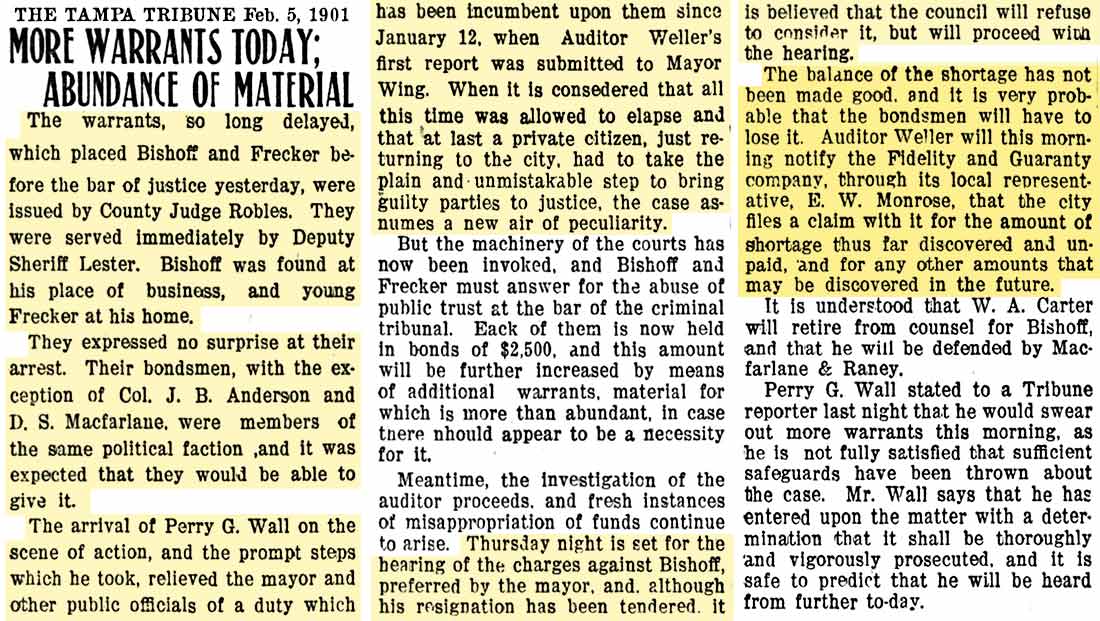
PERRY
G. WALL
EXPLAINS
WHY HE
TOOK
INITIATIVE
TO FILE
CRIMINAL
CHARGES
P. G.
Wall was
a
bondsman
with the
Fidelity
&
Guaranty
Company,
through
which
Bishoff
was
bonded
and
insured.
So it
was his
company
that
would
have to
repay
the City
the
missing
funds if
not
repaid
by
Bishoff
or
somebody
else.
Wall says
he heard
about
the
issue
from the
Tribune
while in
Havana,
which
which he
said stated
of the
"rascality
and
peculation
being
carried
on in
the
office
of the
tax
collector
and
assessor."
He wrote
to his
attorney
(his
son,
John P.
Wall) to
do what
it took
to
protect
him from
loss by
making
sure the
shortage
was
repaid
by those
responsible
for the
loss.
When he
returned
from
Havana
and
found
out the
shortage
had not
yet been
paid
back,
believing
there
had been
sufficient
time to
have
done so,
, his
"interest
as a
person
responsible
and as a
citizen
who does
not
believe
in
excusing
or
palliating
thievery
and
forgery
in
public
office,
made it
my duty
to
resent
the
matter
to the
courts
in the
way of
criminal
prosecution."
After J.P Wall
and
attorney
Turman
looked
over the
ledgers
of the
tax
collector
and
concluded
evidence
of
forgery
and
embezzlement
on
behalf
of C.T.
Frecker
and
Bishoff,
he filed
the
criminal
charges.
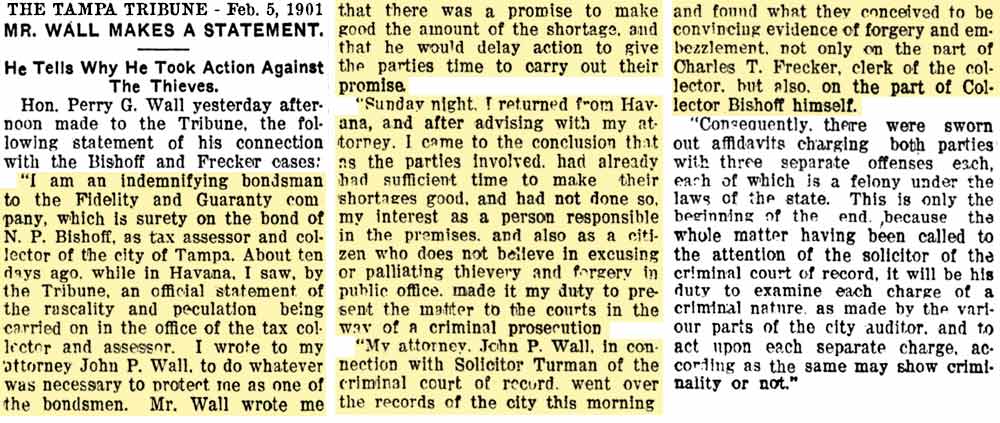
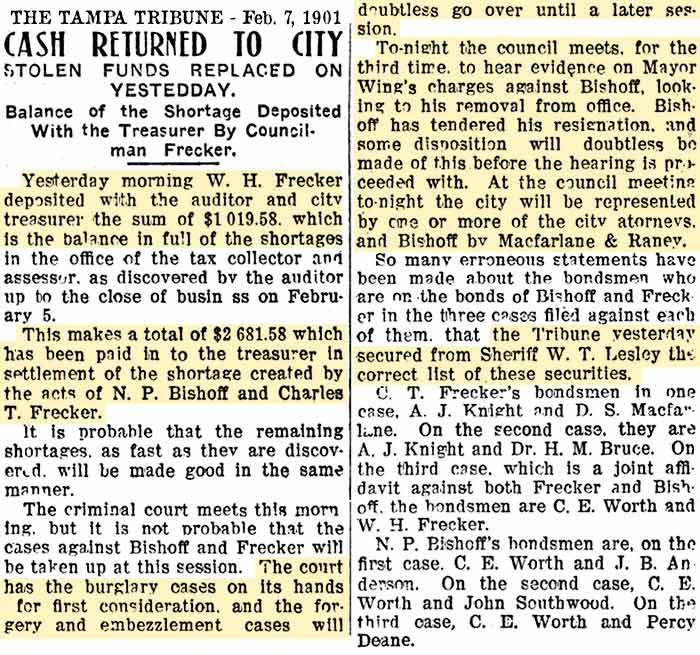
COUNCILMAN
W. H.
FRECKER
REPAYS
REMAINING
FUNDS
On Feb.
6, 1901,
Bill
Frecker
paid the
remaining
balance
due
amounting
to
$1,019.58.
This
made the
total
paid so
far to
be
$2,681.58
which
included Bishoff's
repayment.
The
criminal
court
was
overloaded
with
burglary
cases so
the
charges
against
Bishoff
and C.T.
Frecker
could
not be
tried at
this
session.
The City
Council
was to
meet on
the
evening
of the
7th on
the
removal
of
Bishoff
and to
hear the
evidence
of the
mayor's
charges.
Bishoff
had
resigned
but his
final
status
as
resigned
or
expelled
was
still to
be
determined.
His
attorneys,
Macfarlane
& Raney
would be
present
at the
meeting.
The
Tribune
goes on
to
publish
the
amounts
bondsmen
paid to
keep
Bishoff
and C.
T.
Frecker
out of
jail.
According
to
westegg.com
inflation
calculator,
$2681 in
1901
would be
like
$83,368
in 2019.
Also,
$2681 in
2019
would
have
been
like $88
in 1901.
BISHOFF
FIRED,
POSITION
OF TAX
COLLECTOR
IS
VACANT
TO THE
SURPRISE
OF THE
MAYOR

With
eight
members
present,
including
W. F.
Frecker,
City
Council
voted
unanimously
to fire
Bishoff
and not
accept
his
resignation.
The vote
took
place
without
discussion,
sustaining
the
charges
of
misfeasance
and
incompetence.
Bishoff's
attorney,
George
P. Raney
Jr.,
only
said
"Criminal
prosecution
having
been
instituted
against
Mr.
Bishoff
and his
clerk,
he will
reserve
his
answer
to these
charges
for the
courts,
and will
make no
answer
before
council."
The
Tribune
wrote
that
each
member
voted
with an
emphatic
"aye"
with Mr.
Frecker's
being
particularly
impressive.
City
Attorney
Macfarlane
then
said
that
because
of the
wording
of the
city
charter,
the vote
constituted
not only
the
dismissal
of
Bishoff,
but the
service
of the
acting
collector/assessor,
J.S.
McFall.
No one
could
legally
hold the
office
until
the
mayor
appoints
one and
the
council
confirms
it.
Pres.
Moore
then
said
that the
office
was now
vacant,
so it
was
suggested
that
Mayor
Wing be
notified
so he
could
make an
immediate
appointment
to the
position.
Efforts
to
contact
Mayor
Wing by
telephone
were
unsuccessful,
so Fire
Chief A.
J.
Harris
went out
looking
for him
in his
buggy.
The
Tribune
wrote
that
this
situation
will
prove to
be a
Saturday
morning
surprise
for the
people
of Tampa
and the
mayor.
Macfarlane
also
added
that
after
the
meeting,
any
receipts
signed
by
Acting
Collector
McFall
would be
worthless.
Read
this
whole
article.
When it
opens,
click it
again to
see full
size.
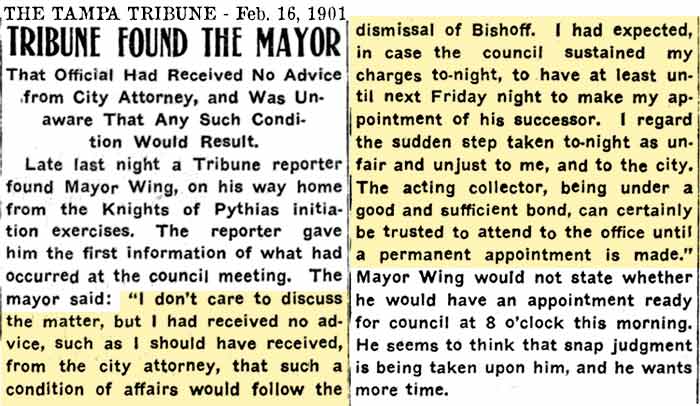
MAYOR
WING
LOCATED,
TOLD OF
CIRCUMSTANCES
A
Tribune
reporter
tracked
down
Mayor
Wing
late
that
night
and
broke
the news
to him
regarding
Bishoff's
firing
and the
vacancy
of the
office.
Mayor
Wing did
not want
to
discuss
the
matter,
and only
said
that the
city
attorney
had not
told him
of this
consequence
making
the
office
vacant,
such as
he
should
have
done.
He
regarded
the
decision
as being
a
"sudden
step
taken
tonight
as be
unfair
and
unjust
to me"
and said
the
acting
collector,
"being
under a
good and
sufficient
bond,
can
certainly
be
trusted.."
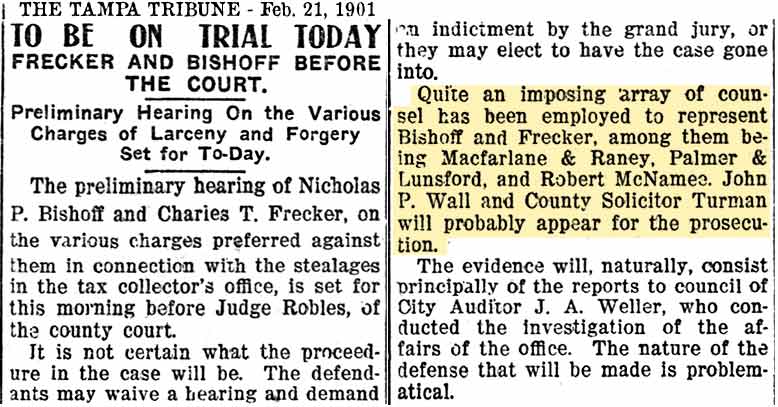
THE
PRELIMINARY
HEARING
The
preliminary
hearing
was set
for Feb.
21 in
the
county
court of
Judge
Francis
Marion
Robles.
Judge
Robles
was one
of
several
sons of
Tampa
pioneer
settler
Joseph
Robles.
The
Tribune
says
"Quite
an
imposing
array of
counsel
has been
employed
to
represent
Bishoff
and
Frecker,
among
them
being
[Matthew
B.,
brother
of Hugh]
Macfarlane
and
[George
P.]
Raney,
[Thomas
P.]
Palmer
and
Lunsford,
and
Robert
McNamee.
County
Attorney
[Solon
B.]
Turman
and John
P. Wall
were
among
the
prosecution.
| JUDGE FRANCIS MARION ROBLES Francis Marion Robles was born Feb. 26, 1858* in Tampa; he was one of seven sons of Joseph Robles & Mary Garrison Robles.
On Dec. 22, 1882
he married in Tampa to Katie S. Binkley a native of Terre Haute, Indiana.
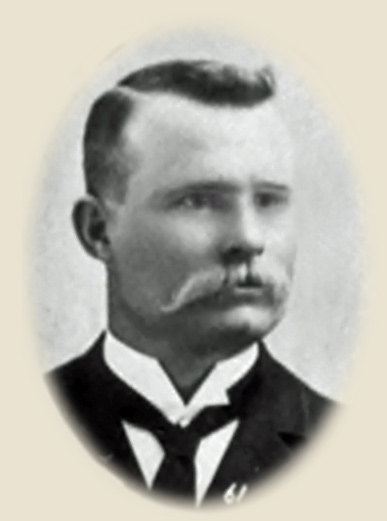
Francis obtained his law degree from the University of Michigan in Ann Arbor, graduating in 1890. He practiced law the following year, becoming the first lawyer of Hispanic descent to practice in Hillsborough County. After about a year, he then entered the cattle business as inspector for Hillsborough County and resigned that position in 1900 to become a candidate for the office of County Judge. His 1900 Census lists his occupation as "butcher."
University of Michigan Class of 1890 photo
He was elected without opposition and took his place on the bench on January 8, 1901, serving in this capacity until Jan. 1909. He then served as Circuit Court Judge of the 13th Judicial Circuit, beginning his first term in July of 1911 and a second term on July 1, 1917. Judge Robles was a member of the Democratic organizations and of the Order of the Odd Fellows. Francis and Katie Robles had two sons, Robert P. Robles (b. circa 1885) and Orryl S. Robles (b. circa 1895). Judge Robles died in Tampa on Sept. 7, 1933, age 75.
* The 1860 census of Tampa shows Francis was 3 years old by June 1860. He may have been born Feb. 1857. |
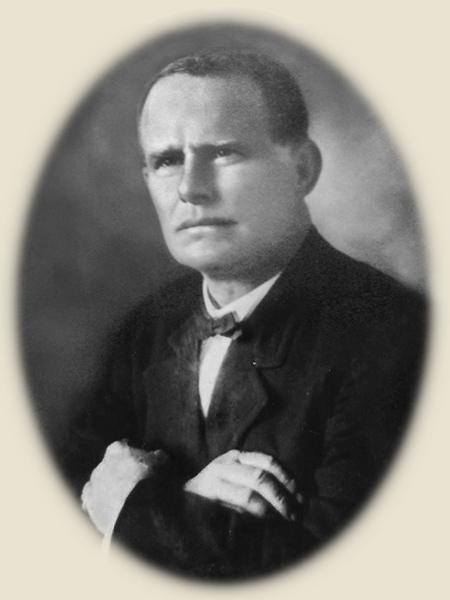
Judge Robles, circa 1911
Photo courtesy of Michelle Hanko, his great-granddaughter
Read more about the Robles family at TampaPix |
|
DEATH OF JUDGE FRANCIS MARION ROBLES |
|
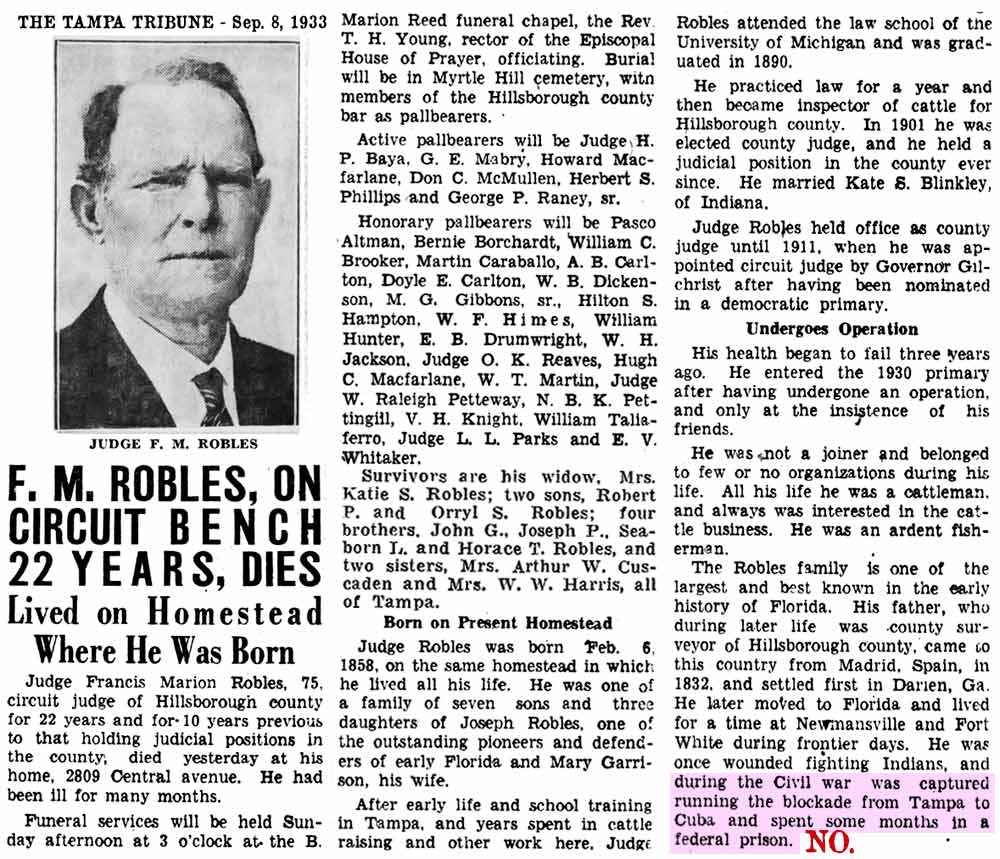
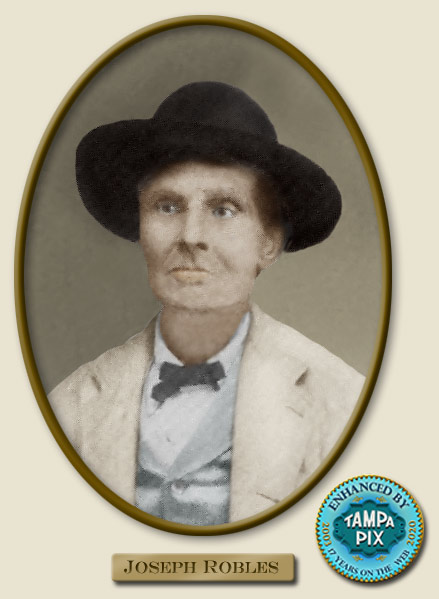 The Tribune is mistaken about Joe Robles being captured
while running the blockade from Tampa to Cuba and spending months in prison. They are confused with James McKay, Sr. and his capture on his ship, the Salvor. This appears to be another example of folklore-based reporting propagated over the years
from Joe
Robles'
obituary. According to "The Robles Family during the Civil War in Tampa," USFSP Master's Theses (Graduate) by Karen E. Lucibello, 2012: The Tribune is mistaken about Joe Robles being captured
while running the blockade from Tampa to Cuba and spending months in prison. They are confused with James McKay, Sr. and his capture on his ship, the Salvor. This appears to be another example of folklore-based reporting propagated over the years
from Joe
Robles'
obituary. According to "The Robles Family during the Civil War in Tampa," USFSP Master's Theses (Graduate) by Karen E. Lucibello, 2012:
Joseph Paul* Robles, Sr., the feisty one hundred thirty-five pound, nearly 45 year old Spaniard, took advantage of the practice of letting boys of fourteen and men past 45 be volunteers in army service. He became superintendent of the vital saltworks near Tampa Bay and did voluntary service for the local Home Guard. Covington** describes Charles J. Munnerlin’s Cow Cavalry as sort of a “home guard unit” because they slept “in their beds at home.” This appears to describe the situation for local volunteer groups. His obituary of February 13, 1907, in the Morning Tribune noted that Robles also served as a volunteer on a blockade runner where, “He was captured while aboard this craft, and spent a time in a Northern prison. Upon being released he returned to this county and began his long residence on North Central Avenue.” Since records of volunteer groups and blockade runners are not always available, there is no written verification of these stories.
* Joe Robles did not have a middle name, and his son, Joseph Paul Robles, was NOT a "Jr." The "Paul" in Joseph Paul Robles Sr. made its way into print by carelessness, bad reporting or assumption, as evidenced by Ms. Lucibello's Graduate Thesis use of it for Joe Robles' middle name. In an age and industry such as the newspaper business, when first and middle initials reigned supreme, Joseph Robles never appears with a middle initial or middle name in his lifetime.
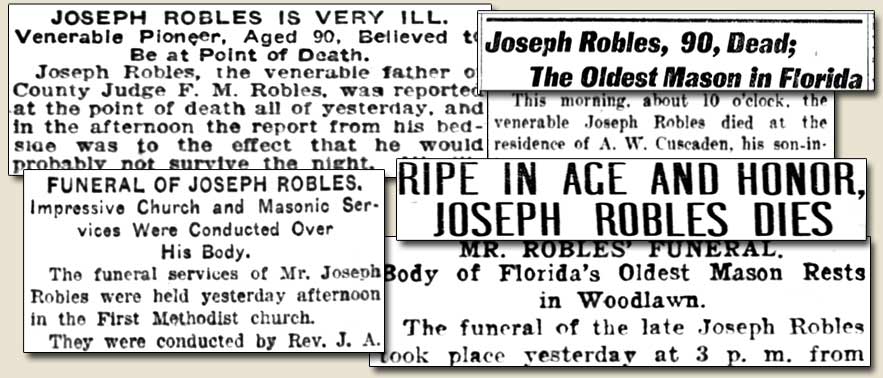
*James Covington, The Story of Southwest Florida, Family and Personal History. 9 Volume 2 (New York: Lewis Historical Publishing Company, Inc., 1957). 314.
Lucibello, Karen E., "The Robles Family during the Civil War in Tampa" (2012). USFSP Master's Theses (Graduate). 105. https://digital.usfsp.edu/masterstheses/105 |
According to Michelle Murray Mears,
"Probably the most illustrious member of the family was Judge Robles....My family home was on what they called Michigan Ave., now they call it Columbus Drive. He would ride on a horse, all decked out with his boots on and everything. He would come by riding a horse. He wasn’t paying too much attention to us, I was just a child at the time, and I could see him as he’d go by, and that’s my memory of Judge Robles. He was quite a character in his own way."
Special thanks to Michelle for her assistance in providing information about her Robles family roots.
|
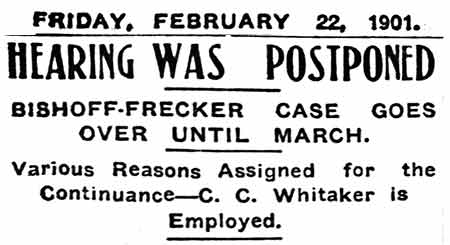 PRELIMINARY
HEARING
POSTPONED
UNTIL
MARCH PRELIMINARY
HEARING
POSTPONED
UNTIL
MARCH
As a
courtesy
to M. B.
Macfarlane,
counsel
for the
defense,
Judge
Robles
postponed
the
preliminary
hearing
until
March 12
due to Macfarlane
having
planned
to
attend
President
McKinley's
inauguration
in
Washington
D.C. on
March 4.
Even if
the
preliminary
hearing
had been
started
on time,
the
Criminal
Court
trial
could
not have
started
before
the
third
Monday
in March
which
was the
next
session
of that
court.
Read
this
entire
Feb. 22,
1901
article.
On hand
on the
possibility
that the
hearing
would
start on
time
were the
defendants
who
waited
in Judge
Robles'
office.
Attorney
C. C.
Whitaker
as well
as John P.
Wall
were
present
for the
prosecution,
"who has
been
employed
by a
number
of
leading
citizens
to
prosecute
the two
men,
feeling
that the
case
should
be
pushed
with all
the
vigor
possible,
a number
of
citizens
made up
a purse
and
employed
Whitaker
with
this
purpose
in
view."
This
made TWO
private
attorneys
on the
prosecution,
as well
as
county
attorney
Turman.
The
defendants
remained
out on
bail,
and the
Tribune
stated
that it
was
doubtful
that
there
will
ever be
a
hearing
in Judge
Robles'
court
because
Turman
had
already
taken
steps to
bring
the
cases
directly
before
the
criminal
court,
and a
commitment
wouldn't
be
necessary
so far
as the
prosecution
was
concerned.
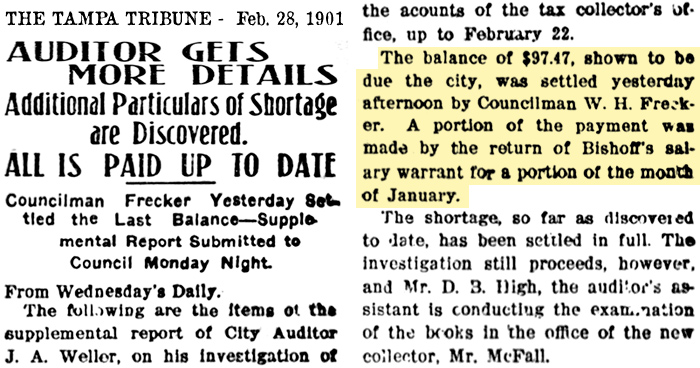
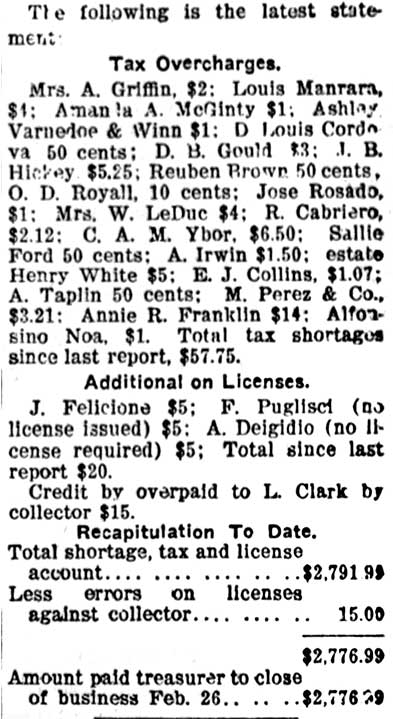
REMAINING
BALANCE
OF
MISSING
FUNDS
REPAID
As of
Feb. 22,
1901,
the
balance
of the
shortage
in the
city
treasury
amounting
to
$97.47
had been
paid by
Councilman
Frecker.
Part of
it
consisted
of the
return
of Bishoff's
salary
which
had been
paid in
advance
to the
end of
the
month.
$2,776
in 1901
would be
worth
$86,323
in 2019.
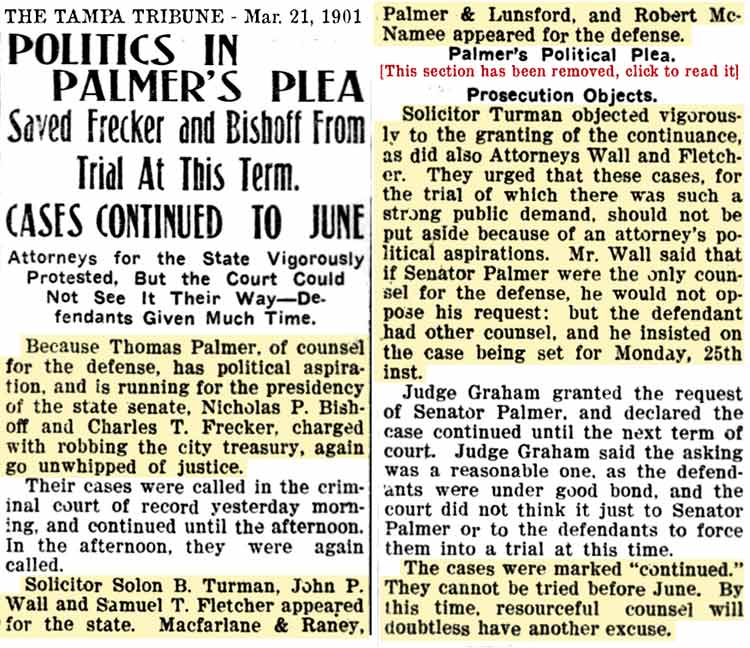
TRIAL
CONTINUED
UNTIL
JUNE
When the
trail
date
arrived,
attorney
for the
defense
Thomas
Palmer
asked
Judge
Graham
for a
continuance,
due to
his
prior
commitment
of
running
for
president
of the
state
senate.
The
prosecution
objected
vigorously
on the
grounds
that
Palmer's
political
aspirations
should
not
delay
the
trial,
but
Judge
Graham
granted
the
continuance.
Click to
see the
entire
article.
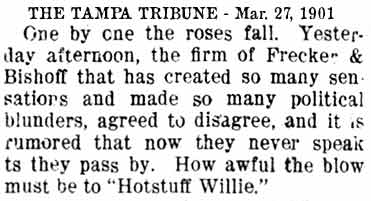
It's not
known
for sure
which
"firm"
the
Tribune
refers
to at
right.
Whether
the
literal
firm of
W.H.
Frecker
&
Bishoff
in the
furniture
business,
or the
team of
Charlie
Frecker
&
Bishoff
with the
"firm"
being
their
jobs in
the tax
collector's
office.
In the
coming
months,
the
Tribune
would
continue
to stir
the pot
so that
the
public
wouldn't
forget
about
this
crime
perpetrated
on the
people
of
Tampa.
As the
day of
the
trial
approached,
the
Tribune
took
credit
for
exposing
the
whole
embezzlement
affair,
as well
as for
the
removal,
replacement,
and
arrest
of
Bishoff
and C.
Frecker.
THE
DREAM
TEAMS
Several
big-name
attorneys
were
involved
in this
case.
For the
defense,
there
was
recently
added
Municipal
Judge
Harry A.
Peoples
for C.
Frecker.
Others
were
Matthew
B.
Macfarlane,
Thomas
Shackleford,
State
Rep.
Robert
McNamee,
George
G.
Clough,
State
Sen.
Thomas
Palmer,
and
James J.
Lunsford.
For the
prosecution,
in
addition
to state
attorney
Solon B.
Turman
Sr. (son
of Judge
Simon
Turman),
there
were
hired
guns
John P.
Wall and
Frank M.
Simonton.
This
list for
the
prosecution
would
change,
ultimately
being F.
M.
Simonton,
John P.
Wall, C.
C.
Whitaker,
Samuel
T.
Fletcher,
and H.
S.
Hampton.
(It's
not
known
why city
attorney
Hugh C.
Macfarlane
wasn't
prosecuting
this
case,
perhaps
because
his
brother
was on
the
defense.)
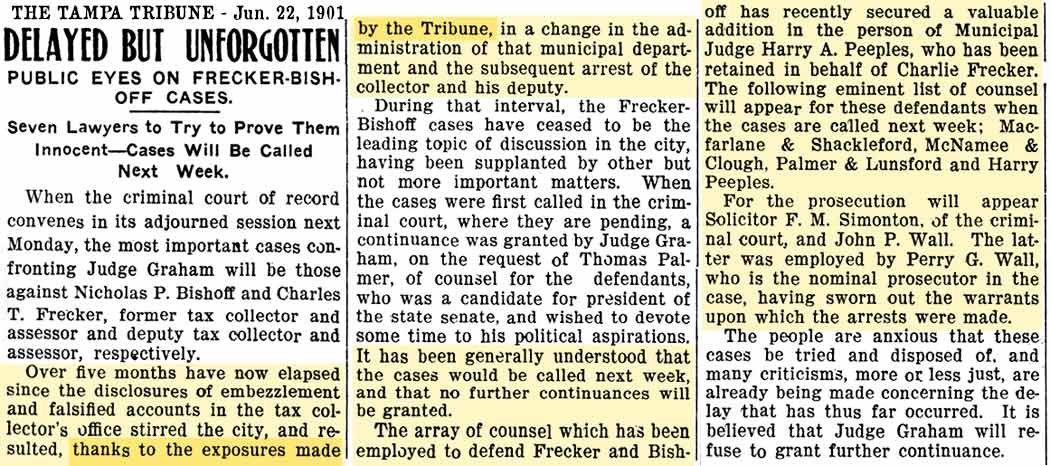
THE
TRIAL OF
CHARLES
TUPPER
FRECKER
BEGINS
The
trial of
Charlie
Frecker
began on
July 1,
1901
with six
members
of the
jury
being
selected
as seen
in the
article
below.
Not much
more was
accomplished
due to
what the
Tribune
believes
were
technicalities--the
plan of
the
defense
to
object
to every
move
made by
the
state.
Each
objection
resulting
in more
argument
which
became a
talking
match,
which
the
Tribune
believed
to be of
little
or no
relevancy
to the
real
issues
of the
case.
Fortunately
for
Charlie
Frecker,
Tribune
Editor
Wallace Stovall
wasn't
the
presiding
judge.
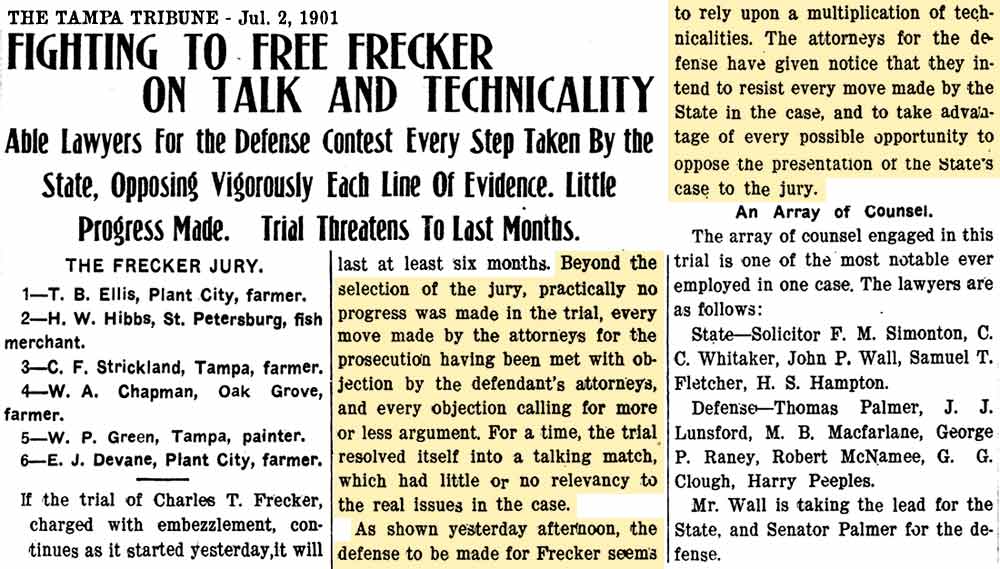
The
article
at left
is only
the
beginning
paragraphs.
Click to
see the
whole
article.
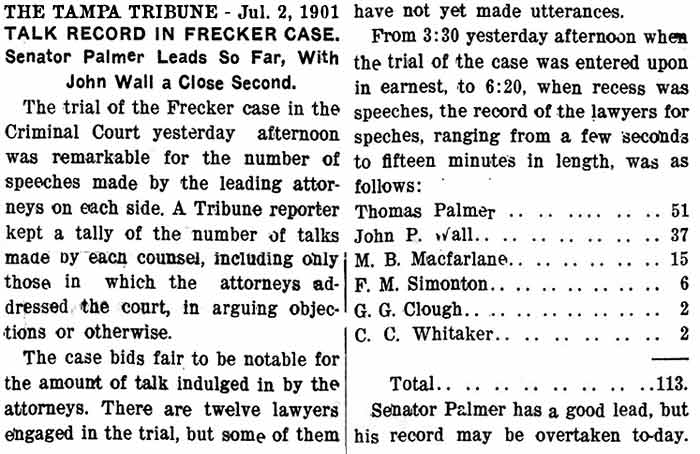
THE
TRIBUNE
KEEPING
SCORE
After
preliminary
events
such as
jury
selection,
the
actual
testimony
began at
3:30 p.m
and
lasted
until
6:20
p.m.
The
Tribune
reporter
kept a
record
of how
many
minutes
each
attorney
talked.
"Senator
Palmer
has a
good
lead,
but his
record
may be
overtaken
to-day"
COMING
SOON
THE
TRIAL OF
CHARLIE
FRECKER
BIG
CORPORATIONS
FIGHT
LICENSE
TAX
AGAIN
As
Frecker
continued
to stand
up to
big
corporations,
they
continued
to fight
the city
license
tax in
1901.
This
time
they
just
plain
refused
to pay
up.
Frecker
instructed
the city
attorney
to "take
legal
steps to
enforce
the
collection
of these
licenses."
|
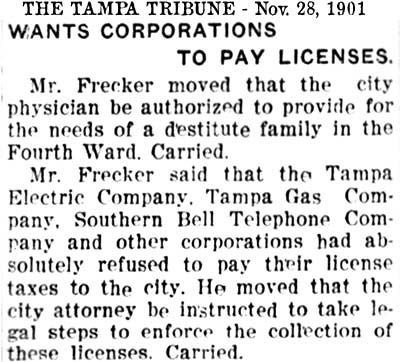 |
TRIBUNE COMPLIMENTS FRECKER'S BUSINESS
Either Wallace Stovall has mellowed or this is a paid ad because it calls Frecker a "gentleman" and compliments Frecker's business, as well as his ability to manage it. Apparently, Chas. Shaw had a business partner when he sold to Frecker in Aug. 1900, a Mr. Woodhull. |
|
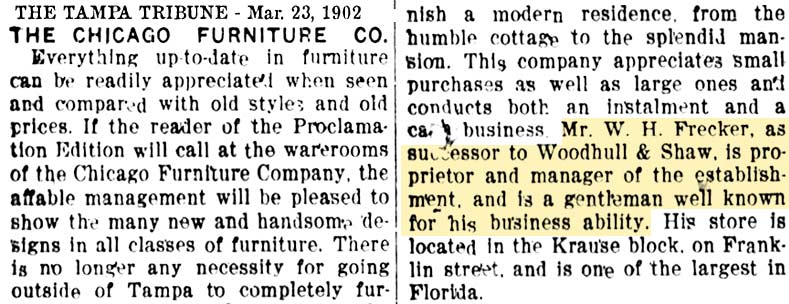 |
JAMES
MCKAY
JR.
ELECTED
MAYOR
|
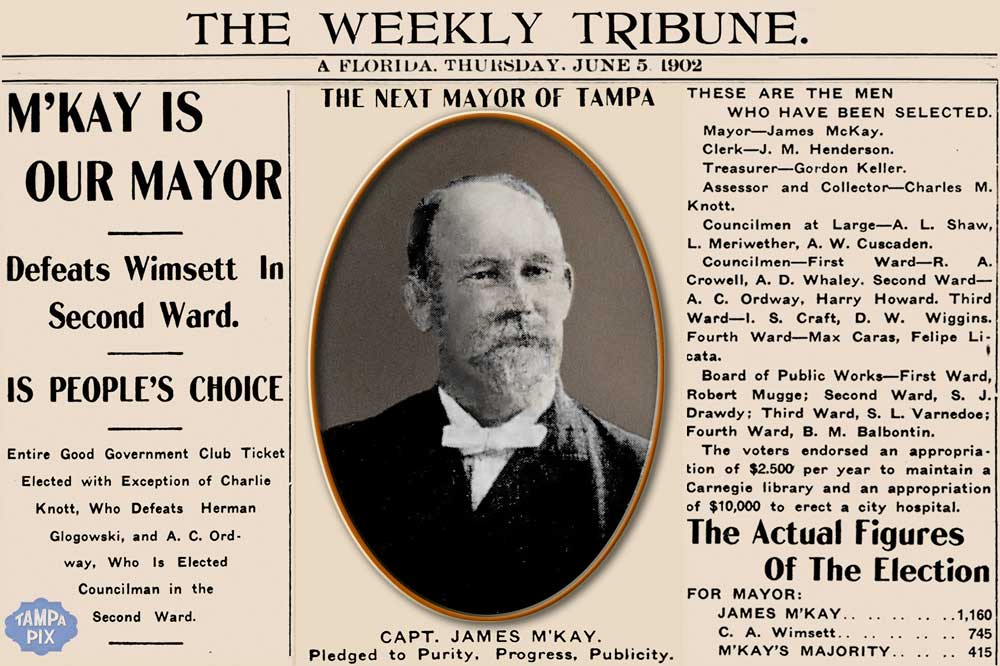 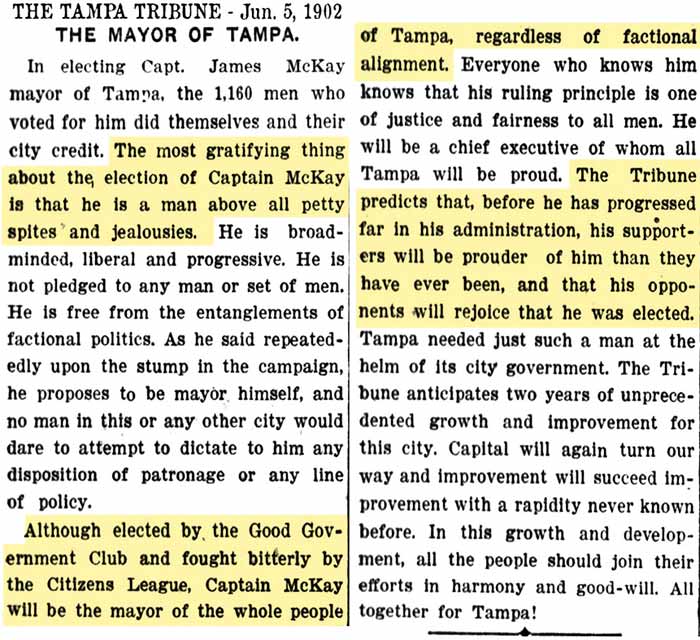 |
|
James McKay, Jr., was born in Mobile, Ala., in 1842 and moved with his parents to
Brooksville
then Tampa in 1846. He
was a son of James, Sr. and Matilda Cail McKay. At the outbreak of the Civil War, enlisted in the Fourth Florida Infantry Regiment.
McKay was later promoted to captain of an independent company of soldiers who were on detached duty to round up and transport cattle for the Confederate Army.
After the war, McKay worked as a seaman on his father’s schooners and eventually became a master mariner. Following his father’s death in 1876, McKay took over the family business, and sold it 10 years later to serve as a captain for the Plant Steamship Company. McKay became the captain of the Mascotte steamer in 1886, and was in charge of the construction of various ships including the Olivette.
He was then elected to the Florida State Senate, where he served from 1891 until 1893. On September 1, 1894, he became a U.S. Marshal for the Southern District of Florida.
Elected on June 5, 1902, Mayor McKay’s administration emphasized the need for growth and the importance of public investment to service that growth. During his tenure, Mayor McKay made a number of judicial appointments and adopted some policies that appealed to the working class and union voters. After his time in office, McKay served as Tampa’s Postmaster from 1914 until 1917. He died in Tampa on September 5, 1925.
McKay was married three times, first to Mary Crichton, then to Helene Turton, and then to Lillian Warren. McKay and Mary Crichton McKay had nine children.
Most of
the
above is
from "The
Mayors
of
Tampa,
1856 -
2019."
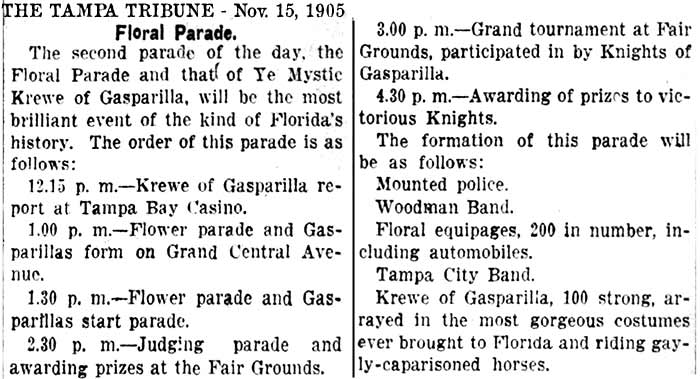 |
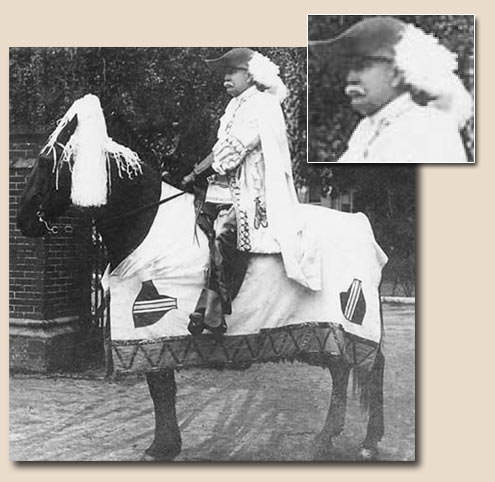
The above photo is from Peerless Pageant: The First Ten Years of Tampa’s Gasparilla Festival by Rosanna Ensley, Tampa Bay History Magazine Volume 21 2007. It described as "Captain James McKay, Jr.was photographed astride his horse during the second Gasparilla invasion in 1905." Lesley Collection, Tampa Bay History Center
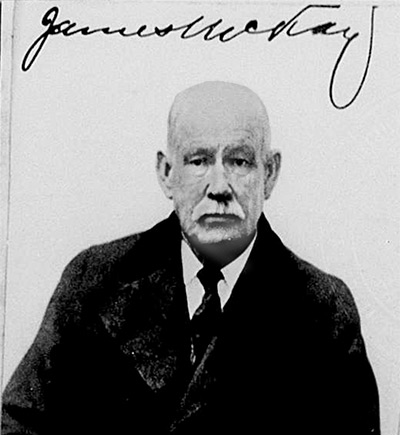 According to Tampa Tribune articles, Gasparilla II celebration was part of the State Fair celebration from Nov. 15 to 17th.. The Gasparilla Krewe was part of the floral parade on Nov 15th. The Gasparilla II King was William Gaither, and his queen was Mary Carnes, but their identities were not revealed until the Gasparilla Ball on the evening of Nov. 17. There is no mention of James McKay in any of the articles published about the celebration over the four days from Nov. 15 to Nov. 19.
There really no "Gasparilla Parade;' they were a section of the floral parade of cars. According to Tampa Tribune articles, Gasparilla II celebration was part of the State Fair celebration from Nov. 15 to 17th.. The Gasparilla Krewe was part of the floral parade on Nov 15th. The Gasparilla II King was William Gaither, and his queen was Mary Carnes, but their identities were not revealed until the Gasparilla Ball on the evening of Nov. 17. There is no mention of James McKay in any of the articles published about the celebration over the four days from Nov. 15 to Nov. 19.
There really no "Gasparilla Parade;' they were a section of the floral parade of cars.
See his passport application of Jan. 15, 1918. |
|
"History of Tampa of the Olden Days" By JAMES McKAY, JR. REMINISCENCES OF CAPT. JAMES McKAY, JR. In his later years he wrote two lengthy articles about the early history of Tampa and Hillsborough County. The first was printed in the Tampa Times, Dec., 20 1921, and was later reprinted in D, B. McKay’s Pioneer Florida. The second article appeared in the Tampa Times, Dec. 18, 1923, and is reprinted here. [Note, TampaPix can't vouch for the accuracy of McKay's articles. Much of it appears to be based on memories, an often inaccurate source of history
if much
more
than a
few years old. McKay was 79 years old at the time.]
|
|
FRED
SALOMONSON
ELECTED
MAYOR
FOR
THIRD
TIME
|
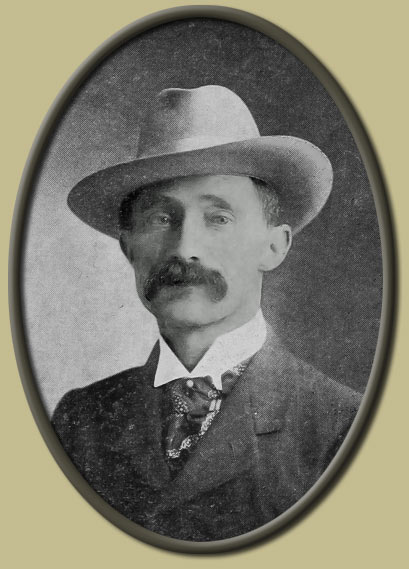 |
|
Mayor
Salomonson,
1904
Photo
courtesy
of
Tampa,
Florida
: its
industries
and
advantages
and a
series
of
comprehensive sketches
of
representative
business
enterprises
at
Internet
Archive.
|
FREDERICK A. SALOMONSON
Tampa’s 28th, 30th, & 35th Mayor
First Term
March 10, 1893 – March 9, 1894
Second Term
March 8, 1895 – June 5, 1896
Third Term June 5, 1904 – June 7, 1906
Born: July 20, 1860, Almelo, Overijssel, Netherlands
Died: December 19, 1911, Tampa, Florida
Born in the Netherlands on July 20, 1860, Frederick A. Salomonson arrived in the United States in 1882 as a representative of a Dutch syndicate that owned land in Florida. After completing his business, Salomonson decided to remain in Florida and moved to Jacksonville where he worked for two years for a railroad company.
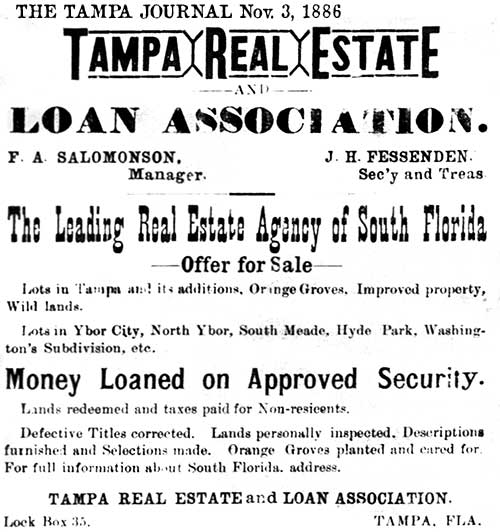 In late 1884, Salomonson moved to Tampa where he established a real estate business. With his real estate partner, John Fessenden, he co-founded the Tampa Real Estate and Loan Association in 1887. In late 1884, Salomonson moved to Tampa where he established a real estate business. With his real estate partner, John Fessenden, he co-founded the Tampa Real Estate and Loan Association in 1887.
Frederick A. Salomonson married Florence Augusta Newcomb on January 31, 1885 in Tampa, Florida. They had four children: Marie, Lodwoyk “Lodie,” Freida, and Wilhelmina.
Salomonson was one of the founding members of Tampa’s Board of Trade. He became involved in local politics and he was elected to Tampa’s City Council, where he first served from March 6, 1889 until March 5, 1890. Two years later, he was elected again, and served from March 4, 1892 until March 10 1893. Immediately following his second term as a City Council member, he was elected as 28th mayor of Tampa. It would be the first of three non-consecutive terms. During his first administration, Mayor Salomonson focused on capital improvement projects that facilitated social and economic growth in Tampa.
Frederick A. Salomonson began his second term on March 8, 1895. Just prior to this, Florida had gone through the Great Freeze during the winter of 1894-1895, which had severely damaged citrus tree groves, causing great hardship to the state’s economy. Approximately $78,000,000 was lost statewide. The result of the freeze ultimately benefited Tampa as many growers that had been located in northern counties moved south. However, at the time Salomonson took office, Tampa was still recovering from the effects of the freeze. During his second term, Mayor Salomonson worked on improving Tampa’s infrastructure. Water mains were placed, sidewalks were constructed in Hyde Park, and more streets were paved. Mayor Salomonson also worked toward expanding Tampa’s sewers to include all of the city, which was a thirty mile expansion. Public Works improvements were given priority and were a necessity for the growing city. In September of 1895, a Tampa police officer named John McCormick was fatally wounded while trying to apprehend a suspect. He left behind a wife and five children. Mayor Salomonson responded to this tragedy by assembling a police squad to find and apprehend the man who shot Officer McCormick. He also requested donations from local citizens for Officer McCormick’s family.
Beginning his third and final term on June 5, 1904, Frederick A. Salomonson continued his previous work to improve Tampa’s infrastructure. Tampa had grown considerably since he was last in office and in 1900, it had become the fourth largest city in Florida. The cigar industry continued to bring many immigrants to the area and Tampa’s political landscape showed both continuity as well as change. Shortly after being elected in 1904, Mayor Salomonson wrote an open letter to the City Council that was published in the Tampa Tribune. In the letter, Mayor Salomonson requested assistance from the council in approving repairs to Tampa’s sewer system, as well as its bridges and roads. At the time, many of the roads were still unpaved. Ahead of his time, the mayor also mentioned the need for a new City Hall building. This would not be completed until 1915. Upon leaving office, Salomonson returned to his real estate business. Shortly thereafter, he became ill with tuberculosis and spent time in Colorado in an effort to improve his health. Unfortunately, he was unable to overcome the illness and he died in Tampa on December 19, 1911.
Most of
the
above is
from "The
Mayors
of
Tampa,
1856 -
2019."
|
| FRECKER BUYS OUT WING'S UNION FURNITURE BUSINESS IN 1905 Bill Frecker went full circle in the furniture business when he bought Frank Wing's furniture business. Frecker started off working for Charles Shaw at Chicago Furniture House, then left to start his own business, Union Furniture, with N. Bishoff and Frank Wing. Frecker's political differences with then Mayor Wing caused him to leave Union Furniture and buy Chicago Furniture House from Shaw. Now he was buying back Union Furniture because he needed more room and Wing wanted to devote more time to being County Treasurer. |
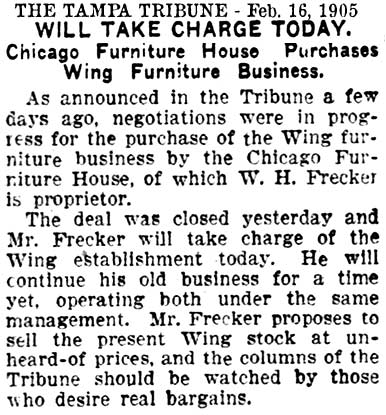 |
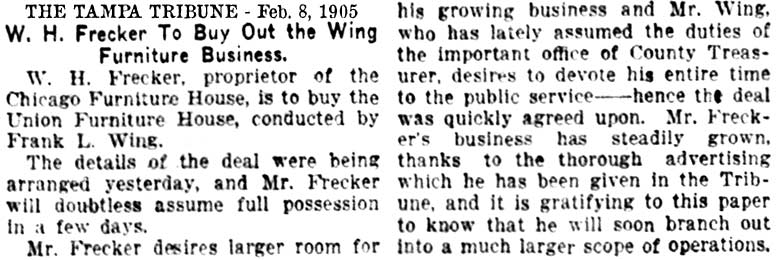 |
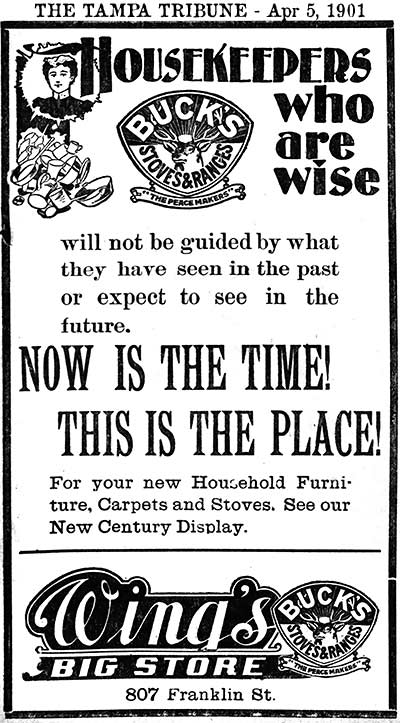
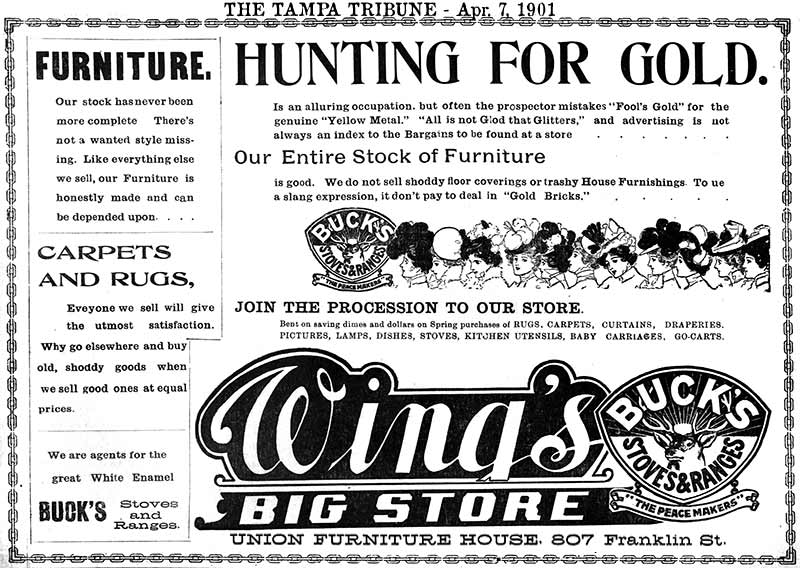
Above:
Two of
Frank
Wing's
ads for
his
Union
Furniture
store at
807
Franklin
St.
in April
1901.
Below:
The postcard
shows
Chicago
Furniture
House in
the
former
Union
Furniture
location
on the
800
block of
Franklin
St.
The
store
would
occupy
this
location
through
at least
1918.
To the
right of
the CFH
is the
location
of Tampa
Hardware
Co.,
whose
space
would be
occupied
by CFH
by 1913.
On the
next
block
can bee
seen the
Hampton
Bldg,
and the
"Witch
Hat"
roof of
the
original
location
of
Citizen's
bank at
Franklin
& Zack,
all
occupying
the 700
block of
Franklin
St.
Real
estate
developer
of
Sulphur
Springs,
Josiah
S.
Richardson's
banner
can be
seen
hanging
over
Franklin
St, with
a hand
pointing
to his
office
on the
right.
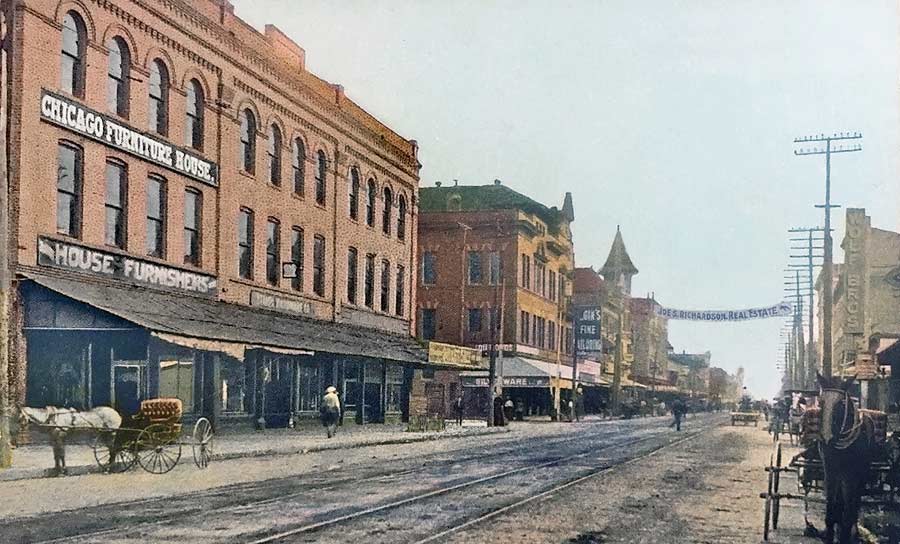
Circa
1905-1907
Post
card
image
courtesy
of Ebay
seller
ltappe11
HOTSTUFF
FRECKER
ELECTED
MAYOR
During
his
mayoral
campaign,
Frecker
expressed
policies
that
appealed
to both
business
leaders
and the
working
class.
He was
quite
candid
regarding
his
support
for
unions
yet the
business
community
found in
Frecker
someone
that
they
could
work
with.
There
must
have
been
something
that the
voters
of Tampa
liked
about
William
H.
Frecker
because
he was
elected
mayor in
June
1906.
He
apparently
had a
great
deal of
support
from the
Cuban
and
Spanish
community.
But for
the
Tampa
Tribune,
this was
all-out
war on
Bill
Frecker.

MAYOR FRECKER TO
APPOINT ED GUNBY AS
CITY ATTORNEY
Admitted to
Maryland state bar
assoc., 1879
Maryland State
Representative,
1882.
Admitted to Florida
state bar in 1883
in Orlando.
Appointed by Pres. Harrison as Collector of Customs,
Port of Tampa, 1889.
Tampa Bar Association Vice-President, 1901.
Hillsborough Co. Bar Assn. President, 1902.
First King of Ye
Mystic Krewe of
Gasparilla, 1904.
Tampa City Attorney
under
Mayor Frecker,
1906-1908
Florida Bar Association
President, 1909.
See "The
Final Battle for
Fort Brooke" at
TampaPix for Gunby's
role in dismissing
the Hackley family's
claim.
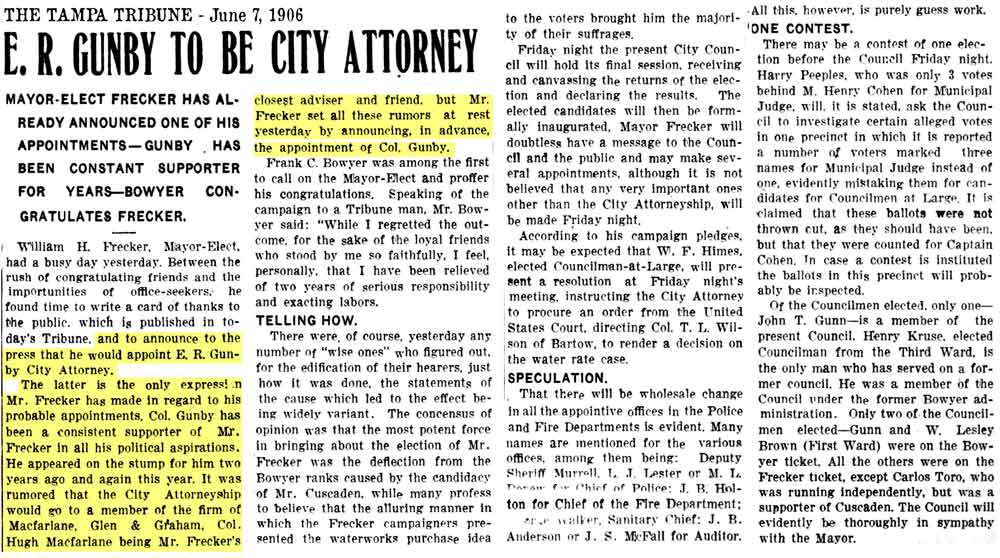
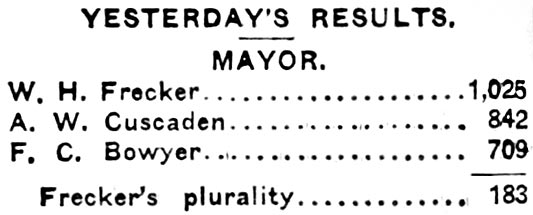
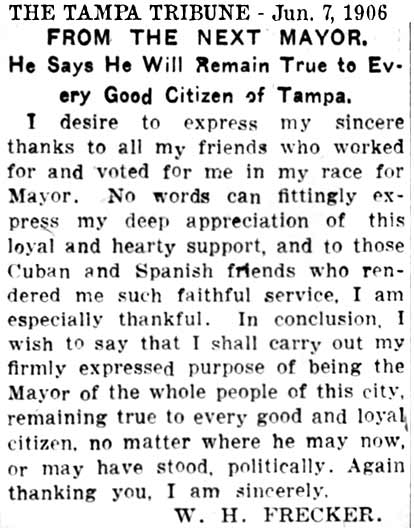 One
of the
first
issues
Mayor
Frecker
addressed
was that
of
saloons
opening
on
Sundays.
A
long-standing
city
ordinance
against
it was
often
overlooked,
with
police
"looking
the
other
way."
Below,
Mayor
Frecker's
brother,
Charles
A.
(sometimes
"E.") Frecker,
seems to
have
gotten
the
better
of a man
who made
derogatory
remarks
about
the
Mayor
for
closing
saloons
on
Sunday.
"Bert"
was
probably
a
nickname
for his
middle
name,
Albert
or
Elbert.
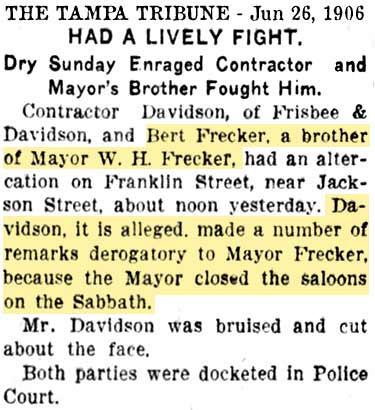
He also
dealt
sternly
with
officers
exhibiting
immoral
public
behavior,
on or
off
duty. Frecker
suspended
two
officers, Killabrew for
visiting
a saloon
and
drinking
alcohol
on duty,
the
Williams
for
deserting
his
family.
Later in
Aug, a
police
committee
cleared
Williams
and City
Council
dropped
the
charge.
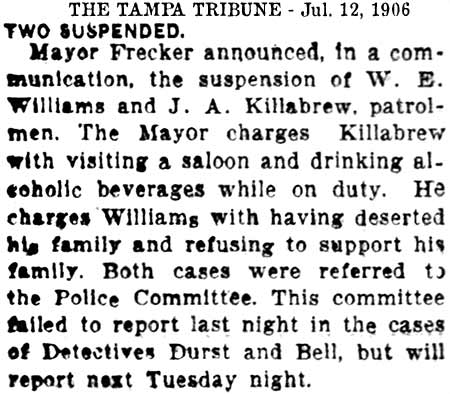
FRECKER
REMOVES
FIRE
CHIEF A. J.
HARRIS
On
June 26,
1906
Tampa
City
Council
approved
Mayor
Fecker's
appointments
to Chief
of Fire
Dept,
Chief of
Sanitary
Dept.
and
Asst.,
Plumbing
Inspector,
Electrician,
and
Veterinary
Surgeon.
Frecker's
decision
to
remove
Andrew
J.
Harris
as Fire
Chief
wasn't
too
popular
with
many
Tampans,
as
Harris
had
proven
himself
for
"nineteen
years."
(Harris
was with
the
department
for
almost
19
years,
since
1888,
but he
was
not the
elected
Chief
for all
those
years.
He was elected
Chief
13
years
earlier when the
first
paid,
professional
dept.
was
organized
in
1893.)
The
appointment
of
Tucker
Savage
as Fire
Chief
was the
only one
of Mayor
Frecker's
appointments
that was
"met
with
determined
opposition"
by the
City
Council.
|
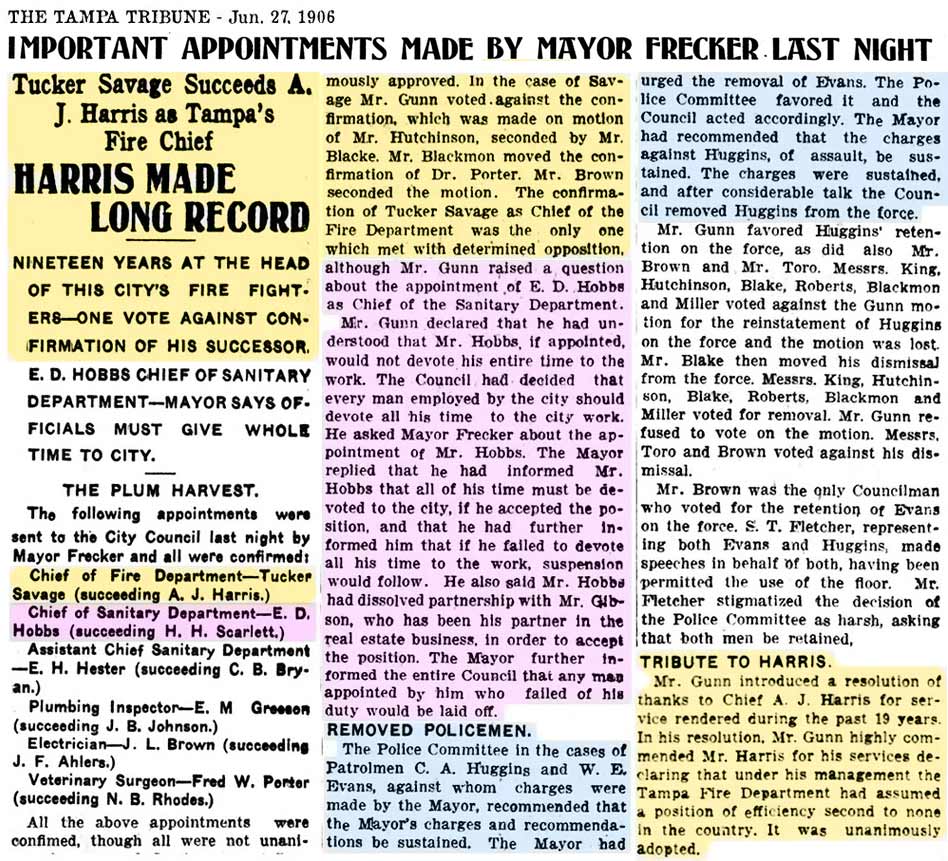
*Harris
was not
Fire
Chief
for
nineteen years.
Nineteen
years
earlier,
in 1887,
Tampa
had a
volunteer
dept.
and the
Chief
was
Augustus
Wuerpel. |
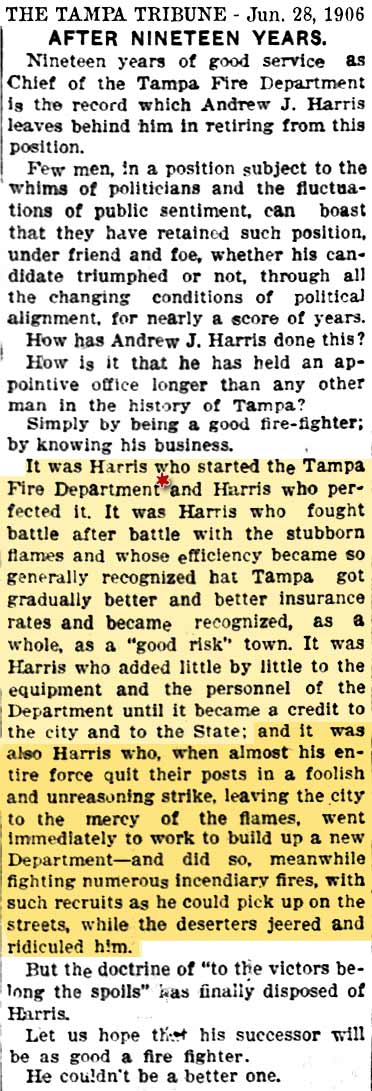 |
| |
|
EARLY
FIRE
CHIEFS
OF THE
TAMPA
FIRE
DEPARTMENT
A. J. Harris
was a
furniture
upholsterer
and
worked at this trade in Savannah, Ga. before
coming to Tampa. He was
a member
of the Savannah volunteer fire dept. and elected
Second
Pioneer
of the
Russell
Hose
Company
on Aug.
28,
1874. By
1884, Harris was with the Wavers Co. in
Savannah.
Harris came
to Tampa
in late
1886
to mid
1887 when the
Savannah
fire
dept.
was
becoming a
paid
professional
organization.
The
transition
in
Svannah was a
gradual
one,
taking
around
15 years
from
1875 to
1890 as
various
stations
were
staffed
with
paid
firemen.
|
|
By
Sept.
1887 he
was
"doing a
rushing
business
in the
mattress-making
and
upholstering
furniture
business
upstairs
in the
Wall
Building."
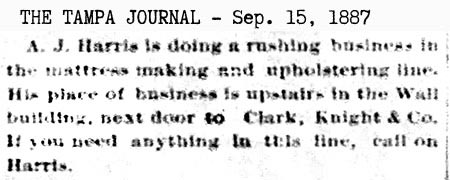

A. J.
HARRIS
AND A
BRIEF
HISTORY
OF HIS
EARLY
FIRE
DEPT.
INVOLVEMENT
IN TAMPA
|
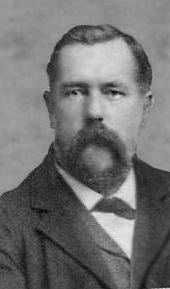 |
|
August C. Wuerpel
Tampa's first organized Fire Dept. Chief.
Circa 1893 from a family portrait at Find-a-Grave, courtesy of JAV. |
On June 2,
1884, sixteen local citizens formed Hook
& Ladder Company No.1, a volunteer
department with W. B. Henderson as
foreman, Fred Herman, assistant foreman,
and C. P. Wandell, treasurer. Other
members were P. F. Smith, Dr. Duff Post,
Ed Morris, J. C. Cole, E. L. Lesley,
Phil Collins, S. P. Hayden, Frank Ghira,
H. L. Knight, A. J. Knight, C. L.
Ayres, S. B. Crosby and A. P.
Brockway. In 1885,
Augustus
C. Wuerpel
was
appointed to be the department Chief. [Grismer, A
History of Tampa, 1959]
Due to a
relative
lack of
fires
and lack
of
interest
of the
members
along
with
their
desire
for
public
recognition,
the
fire-fighting
organization
formed
in June
of 1884
became
defunct.
[A. C. Wuerpel's letter
explaining
his
resignation
of
1890.]
The only
equipment these firemen had consisted of
twenty buckets, two scaling ladders and
some axes. In these early days,
dependence for water to fight fires in
the heart of the business district was
on public wells located at various
intersections, and the Jackson Street
ditch. Bucket brigades carried the
water to the site of the fires. [Grismer, A History
of Tampa, 1959]
In these
days,
fighting
fires
wasn't
just for
the fire
department,
every
citizen
in the
area who
could
assist
pitched
in with
the
bucket
brigade,
and wet
blankets.
Disastrous
fires of
1885 and
May 1886
caused
interest
to
revive
the fire
department
and
Wuerpel
again
was
chosen
as its
chief
with
seven
"bucket
brigades"
organized
to serve
the
city.
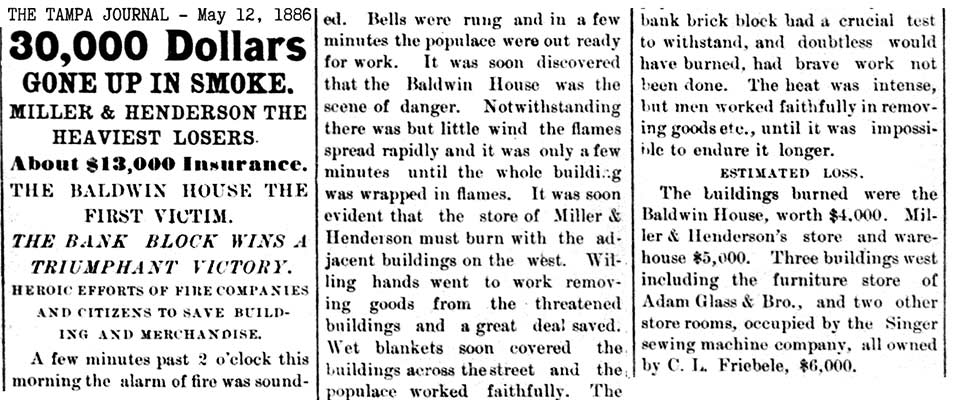
Immediately
after
the
Baldwin
house/Miller
&
Henderson
fire of
May 12,
1886,
Wuerpel
and
Tampa's
leading
citizens
convinced
the town
council
that it
would be
wise to
invest
in a
fire
engine,
so a
$600
"hand pumper"
was
ordered.
Paid for
by
successful
liquor
dealer
Robert
Mugge,
it
became
known as
the "Mugge
Pumper."
It
arrived
July 30,
1886
along
with 350
feet of
two-inch
hose and
a hose
reel.
To make
effective
use of
the new
equipment,
the
Tampa
Fire
Company
was
organized
on
August
30,
1886,
with A.
C.
Wuerpel
as
president,
Robert
Mugge as
secretary,
and
Herman
Glogowski
as
treasurer.
Other
members
were G.
B.
Sparkman,
Odet
Grillon,
H.
Hearquist,
C. O. Pinkert,
John R.
Jones,
Leon
Dartize,
Charles
G.
Lundgren,
J. O.
Nelson,
Vicente
de Leo,
and
Ernest
Gerstenberger.
A. J.
Harris
would
likely
have
been a
member
of this
fire
company
upon
arriving
in late
1886 to
mid-1887.
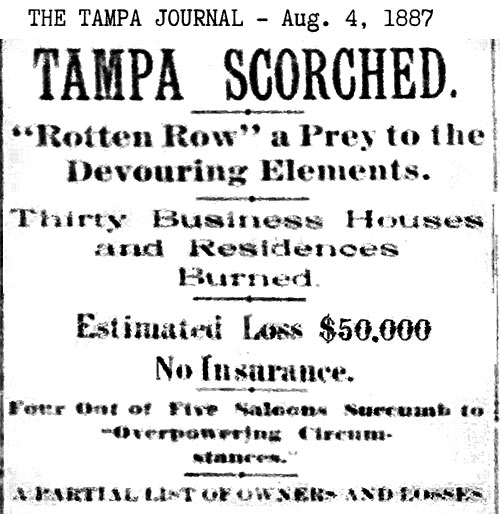 These
men, and
the
members
of the
Hook &
Ladder
Company,
served
without
pay. The
new hand
engine
and
supply
of hose
did
some
good in
the fire
of Sept.
1887*.
But that
fire
showed
the
necessity
of a
reliable
water
supply
and
again
the
council
was
receptive
to
equipping
the
department
as it
stood at
this
time. These
men, and
the
members
of the
Hook &
Ladder
Company,
served
without
pay. The
new hand
engine
and
supply
of hose
did
some
good in
the fire
of Sept.
1887*.
But that
fire
showed
the
necessity
of a
reliable
water
supply
and
again
the
council
was
receptive
to
equipping
the
department
as it
stood at
this
time.
**Allusion
to this
fire
comes
from A.C.
Wuerpel's
resignation
letter
of June
1890. "The
council,
then in
charge
of the
city's
affairs,
appreciated
the
necessity
of fire
protection
and at
my
solicitation
a hand
engine
and
supply
of hose
was
provided,
which
did good
service
in
checking
the
conflagration
of
September,
1887."
Wuerpel
was
probably
recalling
the fire
at
"Rotten
Row" in
August
1887.
Many
Tampans
considered
this
fire to
be a
blessing
as it
destroyed
all the
dilapidated
wooden
saloons
on the
block.
TAMPA
INCORPORATED
Tampa
incorporated
as a
city in
June
1887 and
one of
the
first
acts of
the new
Tampa
city
government
was the
passage
of an
ordinance
on
September
6, 1887
dividing
the city
into
four
wards.
The old
town of
Tampa
became
the
First
Ward,
North
Tampa
the
Second
Ward,
West
Tampa
the
Third
Ward,
and Ybor
City the
Fourth
Ward.
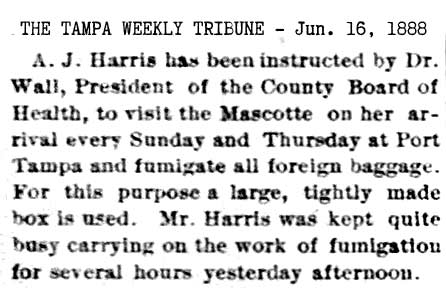 YELLOW
FEVER
EPIDEMIC YELLOW
FEVER
EPIDEMIC
The next
year,
Dr. John
P. Wall,
in an
effort
to
control
the
Yellow
Fever
epidemic
in
Tampa,
called
on A. J.
Harris
to
fumigate
all
baggage
arriving
on the Mascotte
at Port
Tampa.
ORDINANCE
ESTABLISHES
CITY
VOLUNTEER
FIRE
DEPT.
While
plans
were
being
made in
1889 to
build
Tampa's
first
brick
city
hall/fire
department
headquarters
at
Lafayette
St. and
Florida
Ave, the
city
council
passed
ordinance
No. 40
on April
22, 1889
authorizing
the
establishment
of a
volunteer
fire
department. See
this
ordinance
in its
entirety in
the
TampaPix feature
about A.
C.
Wuerpel.
On May
5, 1889,
A. J.
Harris
was
appointed
by City
Council
as First
Assistant
to Chief
Augustus
"Gus" C.
Wuerpel
of the
volunteer
department,
with
Manuel
Rodriguez
as
second
assistant. A.J.
Harris
resigned
as the
foreman
of the
Alert
Hose Co.
so he
could
take the
position
as First
Assistant
Fire
Chief.
Jeff
Pierce
was
elected
to fill
Harris's
position
as Alert
Co.
foreman.
On May
29,
1889, as
set
forth in
Ordinance
No. 40,
elections
were
held by
the six
volunteer fire
companies
around
the city
to
select
their
chief.
Augustus C.
Wuerpel
was
chosen
over George
R.
Macfarlane
by a
margin
of 67
votes.
A. J.
Harris
and
Manuel
Rodriguez
were
elected
as first
and
second
assistants,
respectively,
with no
opposition.
The
department
was
comprised
of these
6
companies
for a
total of
196 men,
with A.
C.
Wuerpel
as
Chief,
Andrew
Harris
as First
Assistant
Chief,
and
Manuel
Rodriguez
as
Second
Assistant
Chief.
WUERPEL
RESIGNS,
HARRIS
APPOINTED
ACTING
CHIEF
In 1890
when the
new city
hall was
being
completed
and
Chief
Wuerpel
was told
all was
ready
for
installation
of the
alarm
bell
system,
Wuerpel
advised
the BPW
of the
weakness
and
lightweight
construction
of the
building's
cupola,
favoring
it be
placed
on a
separate
tower.
But the
BPW disagreed
and said
it was
of
sufficient
strength.
Wuerpel
installed he bell
apparatus
and tested
the
system,
which by
then
other
portions
of the
system
had been
completed.
The
apparatus worked,
but due
to the
"natural
stiffness
of the
new
machinery
and
owing to
the
weakness
of the
timbers
in the
City
Hall
cupola,
a part
of the
striking
machine
broke
and
caused
further
delay
until it
could be
fixed."
This
event would
lead to
disagreements
between
Council
and
Wuerpel
resulting
in
Council
appointing
a
completely
inexperienced
man in
charge
of
maintaining
the
system,
though
Wuerpel
had
already
been
given
authority
over it.
Wuerpel
turned
in his
resignation,
and
in a
lengthy
letter
to the
Tampa
Fire
Dept.
which
was
published
in the
newspaper,
on Jun.
12,
1890, he
provided
his
reasons.
The
letter
is an excellent
history
of the
department
for the
past
five
years..
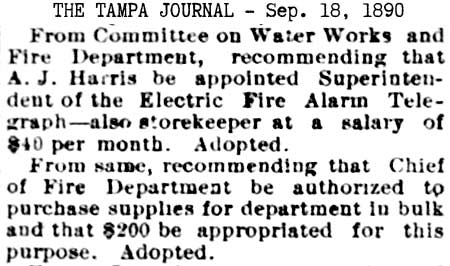
A.
J.
Harris
was
then appointed
Acting
Chief of
the
volunteer
dept.
and still
served
as 1st
Assistant.
Harris
served
in those
positions
until a
special
election
was held
on Aug.
29, 1890
to fill
the
position
of Chief
through
May
28th,
1891
(when Wuerpel's
term
would
have
ended,
as well
as the
assistants'
terms,
Harris &
Rodriguez.)
TALIAFERRO
CHOSEN
AS
INTERIM
CHIEF
Although
Harris
had
previously
announced
he was
resigning
as 1st
Assistant
Chief
while
serving
as
Acting
Chief,
to run
for the
position
of
Chief,
it
appears
that he
instead
ran for
First
Assistant
Chief again.
In that
Aug. 29,
1890
special
election,
T. C.
Taliaferro
was
chosen
as Fire
Chief
over C.
E.
Harrison,
130
votes to
61
votes,
and B.
M. Balbontin
was
chosen
as First
Assistant
Chief
over A.
J.
Harris,
113 to
77.
Soon
thereafter,
Harris
was
appointed
as the
Superintendent
and
storekeeper
of the
new
electric
fire
alarm
system
at a
salary
of
$40/month.
TALIAFERRO
ELECTED
AS CHIEF
FOR TWO
YEARS
|
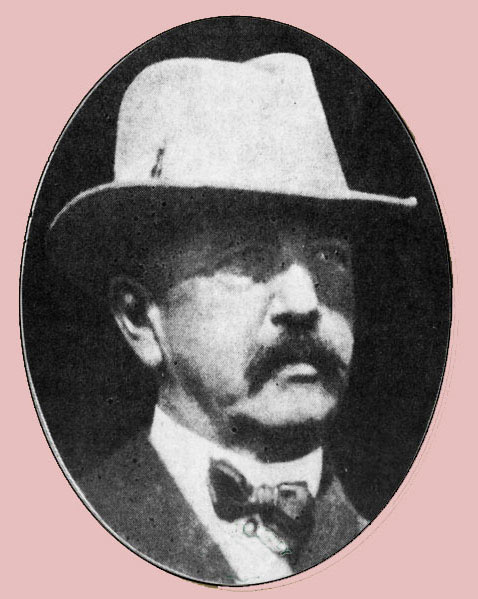 |
On May
28,
1891,
Chief
Taliaferro's
term
ended
due to
having
been
chosen
in the
special
election
to fill
the
remainder
of Chief
Wuerpel's
term.
The
results
of the
regular
election
were
published,
indicating
T. C.
Taliaferro
was
again
elected
as Chief
for a
2-year
term in
an
overwhelming
vote
over
Otto
Kammerer,
493 to
10. 1st
Asst. -
Emilio
Pons
over S.
J.
Bowers,
2nd
Asst. -
C. W.
Ayres
over J.
H.
Hippenmeier,
3rd
Asst. -
L.
Garcia,
apparently
unopposed.
Learn
more
about T.
C.
Taliaferro
at the
TampaPix
feature
about A.
J.
Harris.
He was
more
widely
known as
a
director
of the
First
National
Bank of
Tampa. |
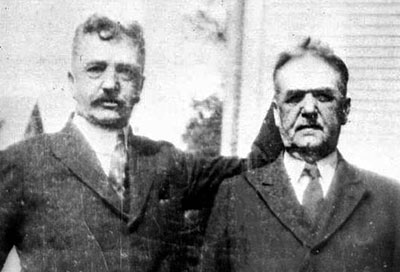
|
|
Thomas Carson
Taliaferro
From a Jan. 3,
1993 ad about
the merger of
First Florida
Bank with
Barnett Bank, in
Florida Today
(Cocoa Beach) |
The loss of Tampa Tribunes from Nov. 1891 through Dec. 1891, all of 1892, and Jan 1893 through March 1893 leaves a gap of about 1 1/2 years of Tampa history.
|
(L to R)
Thomas
Carson Taliaferro, Sr. and
his brother, U.S. Sen. James
Pendleton Taliaferro. Circa
1920s. Notice T.C. has
his hand on top of his
brother's head.
Photo courtesy of State
Archives of Florida, Florida
Memory project.
|
The
missing
Tampa
Tribunes
would
have
covered
the
circumstances
of
electing
the next
Fire
Chief.
April
of 1893
finds A.
J.
Harris
still as the
superintendent
of the
fire
alarm
system.
In a
Tribune
interview
published
Apr. 25,
1893,
Mayor
Salomonson
told a
reporter
that an
important
matter
had not
yet
received
the
attention
it
deserved,
and that
was one
of
having a
PAID,
PROFESSIONAL
Fire
Dept.
"As
to the
proper
organization
of a
paid
department,
I think
Superintendent
Harris
would be
able to
give you
important
information.
"
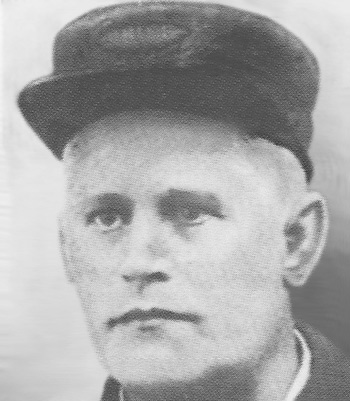 May 1893
finds
George
Rae
Macfarlane,
cousin
of Hugh
Macfarlane,
was
Tampa's
Volunteer
Fire
Dept.
Chief.
George
was a
first
cousin
to Hugh
and was
the only
son of
Andrew
Macfarlane
and
Margaret
Rae.
Andrew
was son
of
Thomas,
who was
also
grandfather
of Hugh.
George
emigrated
to
America
in 1887,
and was
in the
real
estate
business
at
Tampa.
He first
married
Susan B.
Gaunt.
His
censuses
in Tampa
indicate
that he
was born
in
Scotland
in 1862;
thus was
about 11
years
younger
than
Hugh.
According
to his
great-granddaughter,
he came
to Tampa
because
he had
family
here
already.
George
was also
a
collector
at the
US
Customs.
He was
married
to
Nellie
Harden
and had
a
daughter
named
Mary Rae
Macfarlane,
born
circa
1898. May 1893
finds
George
Rae
Macfarlane,
cousin
of Hugh
Macfarlane,
was
Tampa's
Volunteer
Fire
Dept.
Chief.
George
was a
first
cousin
to Hugh
and was
the only
son of
Andrew
Macfarlane
and
Margaret
Rae.
Andrew
was son
of
Thomas,
who was
also
grandfather
of Hugh.
George
emigrated
to
America
in 1887,
and was
in the
real
estate
business
at
Tampa.
He first
married
Susan B.
Gaunt.
His
censuses
in Tampa
indicate
that he
was born
in
Scotland
in 1862;
thus was
about 11
years
younger
than
Hugh.
According
to his
great-granddaughter,
he came
to Tampa
because
he had
family
here
already.
George
was also
a
collector
at the
US
Customs.
He was
married
to
Nellie
Harden
and had
a
daughter
named
Mary Rae
Macfarlane,
born
circa
1898.
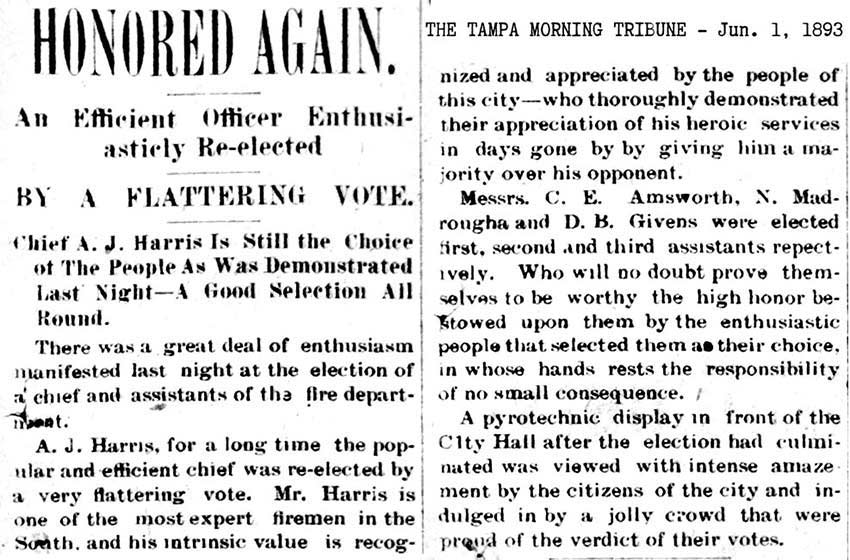
HARRIS
ELECTED
FIRE
CHIEF
On May
31,
1893,
during
Fred
Salomonson's
term as
mayor, A.
J.
Harris
defeated
W. J. Dombrowski
overwhelmingly
for the
position
of Fire
Chief.
Newspaper
articles
are
joyful
but
erroneously
report
"Honored
again.
An
Efficient
Officer
Enthusiastically
RE-ELECTED
by a
flattering
vote."
A.
J.
Harris'
only
prior
election
was
Asst.
Chief in
1889.
His previous
time as
Chief
was as
Acting
Chief,
which
was an
appointment at
the time
Wuerpel
resigned.
Harris
then
remained
as Chief
until
1906
when he
was
removed
by Mayor
Frecker.
READ
MORE
ABOUT
THE
EARLY
YEARS OF
TAMPA'S
VOLUNTEER
FIRE
DEPT,
A.C.
WUERPEL,
AND A.J.
HARRIS,
here at
Tampa
Pix.
|
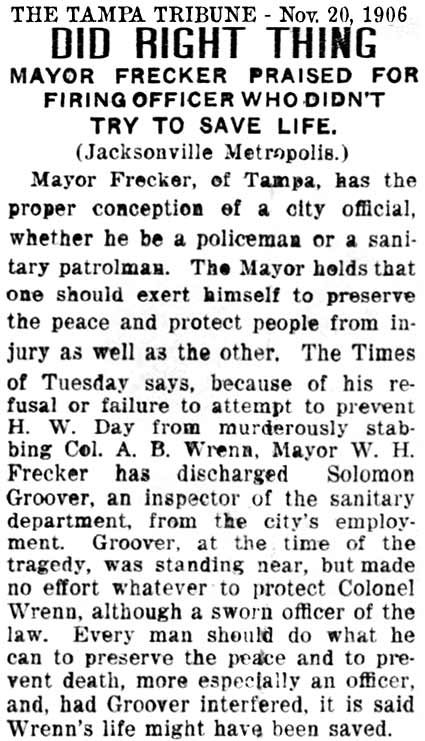 At
Right: A
Jacksonville
newspaper
praised
Mayor
Frecker
for
firing
an
off-duty
sanitation
inspector
officer
for not
attempting
to
prevent
the
murderous
stabbing
of A. B.
Wrens. At
Right: A
Jacksonville
newspaper
praised
Mayor
Frecker
for
firing
an
off-duty
sanitation
inspector
officer
for not
attempting
to
prevent
the
murderous
stabbing
of A. B.
Wrens.
THIS
IS HOW
WE SAY
"CONGRATULATIONS"
IN
TAMPA
Ex-policeman
J. A.
Killabrew
got
revenge
on
Frecker
by
assaulting
him in
public.
The
other
ex-policeman,
Williams,
was
informed
by a
lady on
the
street
of the
nearby
fight
and
hurried
there
and led
Killabrew
away.
Frecker
asked
that
Killabrew
not be
arrested,
so no
arrest
was
made.
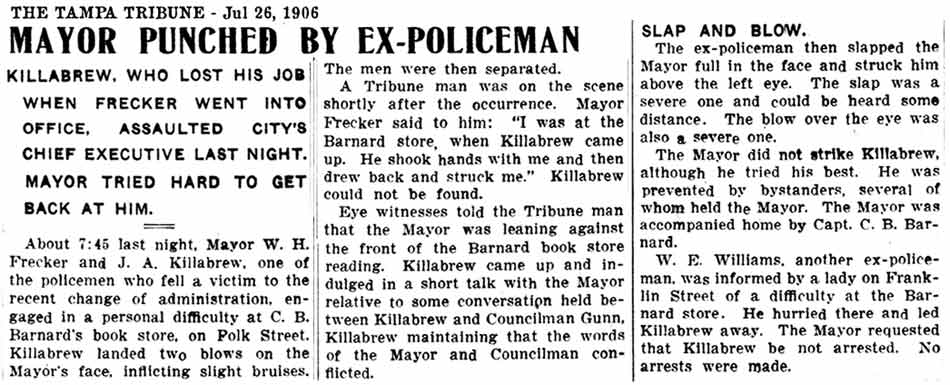
|
|
During his term as mayor, Frecker persuaded City Council to "pass ordinances that reduced the rates charged by the Tampa Water Works Company and Peninsular Phone Company." In addition, the City of Tampa annexed the remainder of the Fort Brooke military reservation that was sold, in part, to real estate developers. This was no easy feat, the struggle to incorporate the area dragged out over two decades. See "The Final Battle for Fort Brooke" here at TampaPix.
THE STRUGGLE FOR CIVIC IMPROVEMENT
AT RIGHT:
This Jan 10, 1907 Tribune article is a portion of a longer one in which the Tribune was praising the members of the Lafayette St. bridge committee for their progress. The Tribune then asks if such equally qualified men could have been placed on the City Hall matter. It states that if just the disgrace wasn't enough to get a new one built quickly, the fact that rapidly rising property costs should spur the City into action: "...an ordinary regard for the public purse directs that the land for the structure should be purchased without delay."
In late April 1907, a small step towards a new City Hall was taken when Tampa finally was able to annex the Ft. Brooke area. Mayor Frecker preferred that the annexation and new city charter be passed before trying to appropriate funding for the various wards. It was agreed that a bond ordinance would be needed and a plan made to raise funds by the sale of some city property.
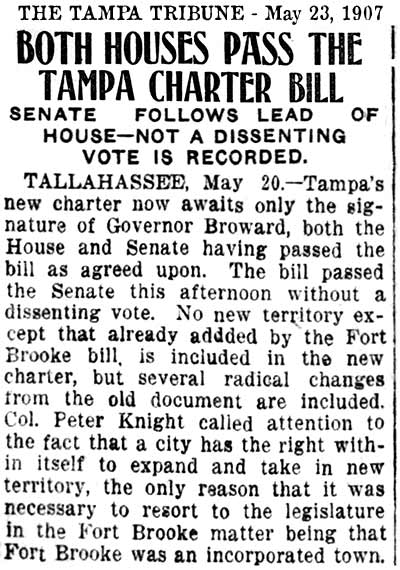
GREATEST STEP YET
After a little over a year in office, Frecker's administration put together a list of proposed costs of the most urgent city improvement issues. The City Hall appropriation was $245,000 which included $45,000 to buy a new City Hall site. The proposed $600k bond issue also included a new bridge across the Hillsborough River at Lafayette Street, (which ultimately would be the concrete bridge we have now,) improvements to the sewer system, and street paving, a hospital and a new jail. The vote was expected to be held on Dec. 10, 1907.
FEW OPPOSE BOND
ISSUE SAYS MAYOR
(below)
An
ordinance was passed
to redistrict Tampa
into nine wards, and
as soon as the legal
ads were placed for
it, City Council was
expected to pass the
bond issue
ordinance, then it
would be put up to a
vote.
Mayor Frecker
emphasized that
everyone had to
re-register to vote
due to the
redistricting of the
City and the
adoption of a new
charter.
MAYOR
FRECKER CONFIDENT
BOND ISSUE WILL BE
APPROVED BY VOTERS
Personally, the
Mayor had
heard of nothing but
favorable comments
about the bond
issue, but "in all
progressive
movements, however,
the 'knocker' is
sure to raise his
head.
|
The TRIBUNE urges to buy a lot right away before prices go up.
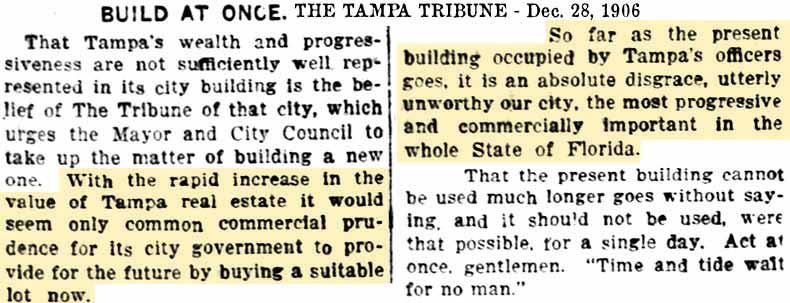 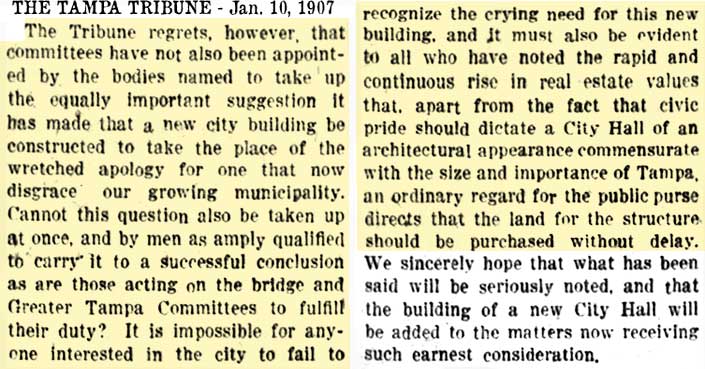
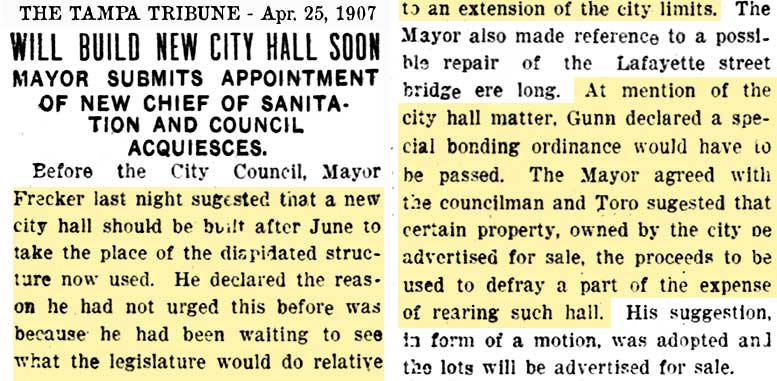
|
|
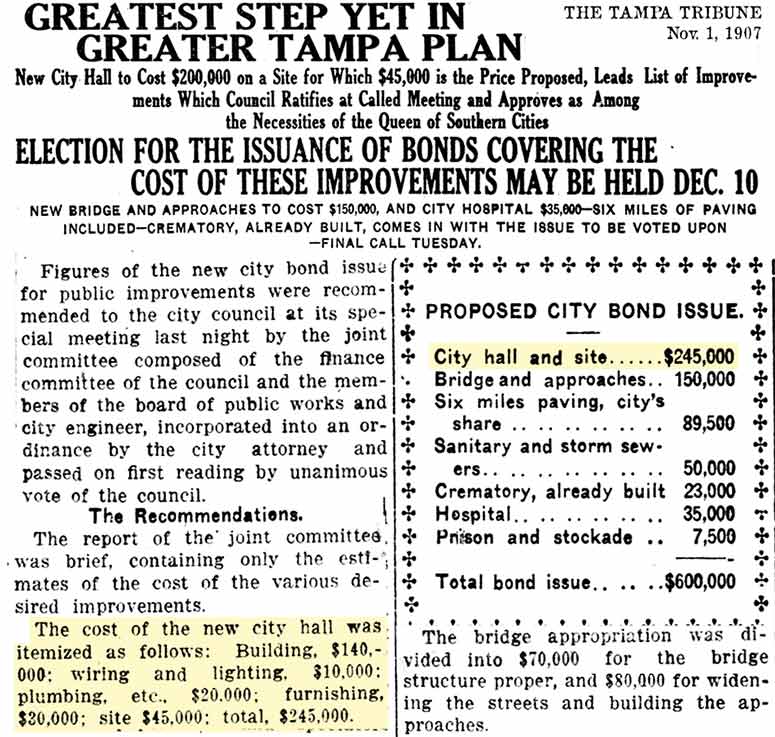
|
|
Every city is
afflicted with
individuals of this
type."
He said that he had
never seen a
commendable movement
initiated that
didn't "raise a warwhoop in
opposition to it.
The people have 'got
on to' this tribe,
however, and their
howls are about as
effective as those
of a dog that
nightly bays to the
moon. Tampa
can't be stopped in
her onward move by
persons of this
class." |
|
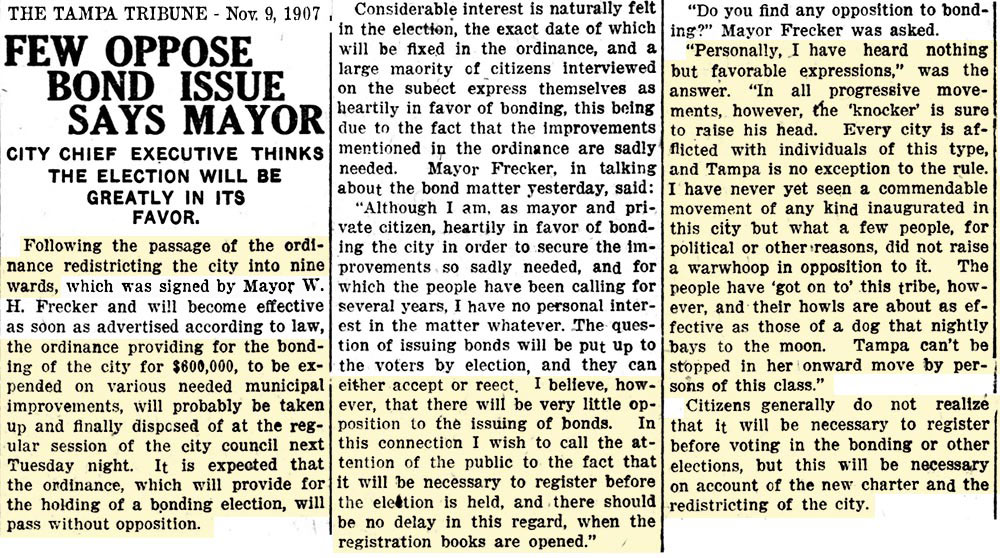
|
THE
TRIBUNE URGES NO
DELAY
Opponents
to the
bond
issue
argued
that no
institution
would
loan
Tampa
the
funds
and if
they
did, the
City
wouldn't
be able
to
afford
the
interest
rate.
The Trib says
otherwise. |
YES
DELAY
Fears
caused
by the
depressed
economy
led to
the
postponement
of the
bond
issue.
Mayor
Frecker
said,
"The
bonding
issue
has been
pushed
aside
for the
time
being..."
But
there
would be
no more
chances
for Frecker,
his term
ended in
June
1908. |
|
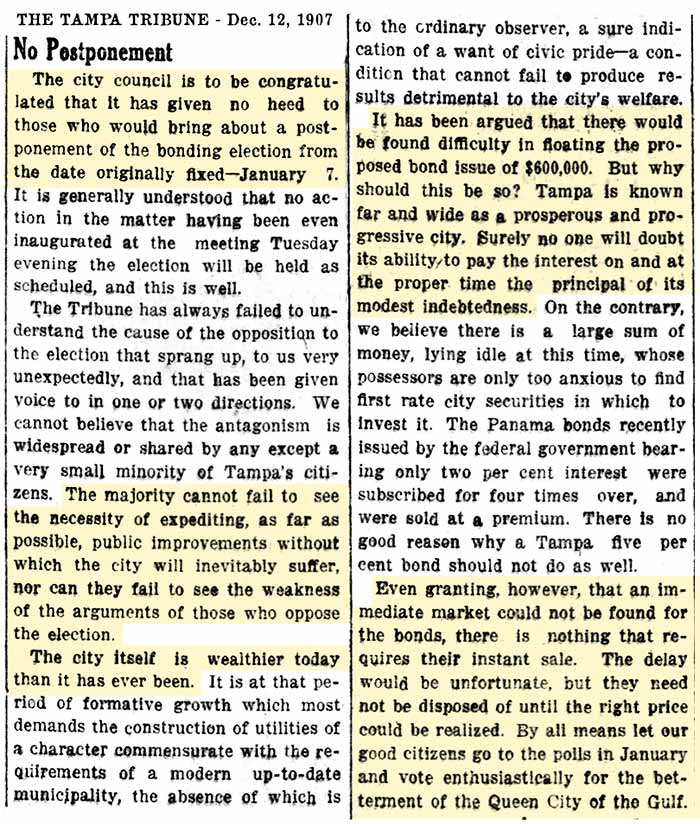
|
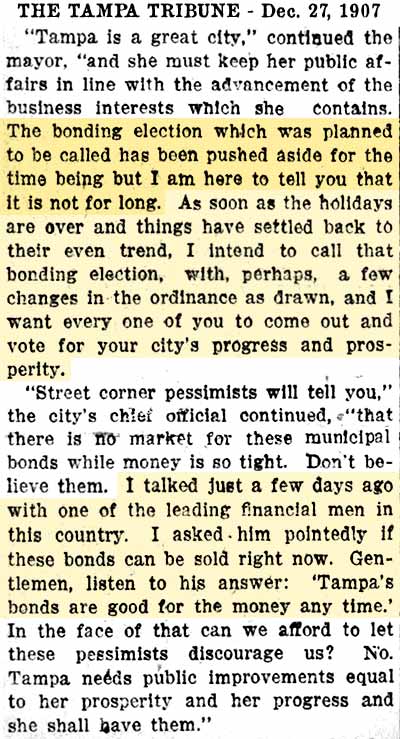 |
|
MARRIAGE
OF
CHARLES
T.
FRECKER
&
MARGARET
VIRGINIA
FULTON
Mayor
Frecker's
son,
Charles
Tupper
Frecker,
married
Margaret
Virginia
Fulton
(d/o Mr.
& Mrs.
W. L.
Fulton)
on Dec.
4, 1905
in
Tampa.
Their daughter Margaret Loring
Frecker
was born
Aug. 18,
1906 in
Bainbridge,
Georgia. |
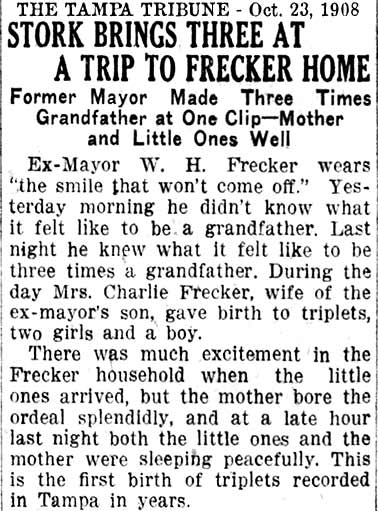 |
|
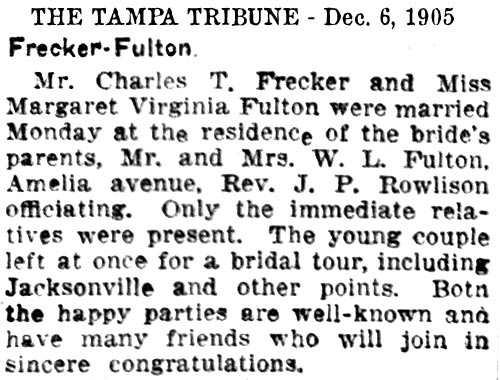
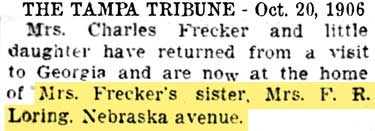
There
was no
birth
announcement
found in
Tampa
Tribune,
only
this
article
when
Mrs.
Frecker
returned
from her
visit in
Georgia
with
baby
Margaret.
MAYOR
FRECKER BECOMES
GRANDFATHER OF
TRIPLETS
On Oct.
22, 1908, Charlie &
Virginia Frecker had
triplets:
William Hubert,
Grace Virginia, and
Ruth
Barbara. The
Tribune got it wrong
when they assumed
Mayor Frecker was a
grandfather for the
first time
Barbara, born Oct.
22, 1908 in Tampa.
The Tribune was too
busy criticizing the
newly-elected mayor
in 1906
. |
|
THE
GREAT
YBOR
CITY
FIRE OF
1908
Fifteen
blocks
in the
residential
section
of the
cigar
manufacturing
district
were
swept as
clean as
a paved
street,
large
stores
of fine
tobacco
were
destroyed,
and over
a
thousand
workers
were
thrown
out of
employment
when a
raging
fire
swept
through
Ybor
City on
March 1,
1908.
A woman
in child
labor
died of
fright,
a
valuable
horse
was
burned
to
death,
and a
handsome
silver
cigar
display
case
costing
$25,000
was lost
in a
matter
of four
and a
half
hours.
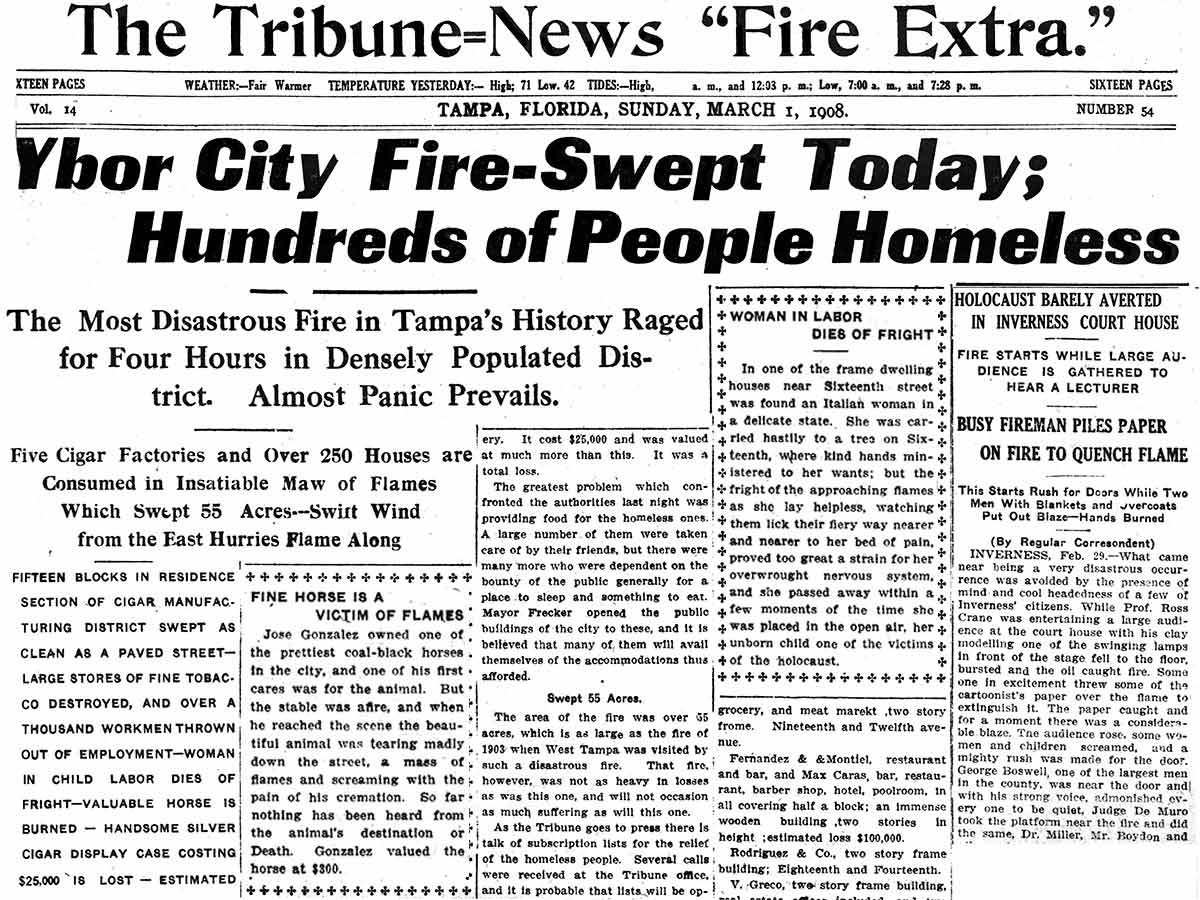
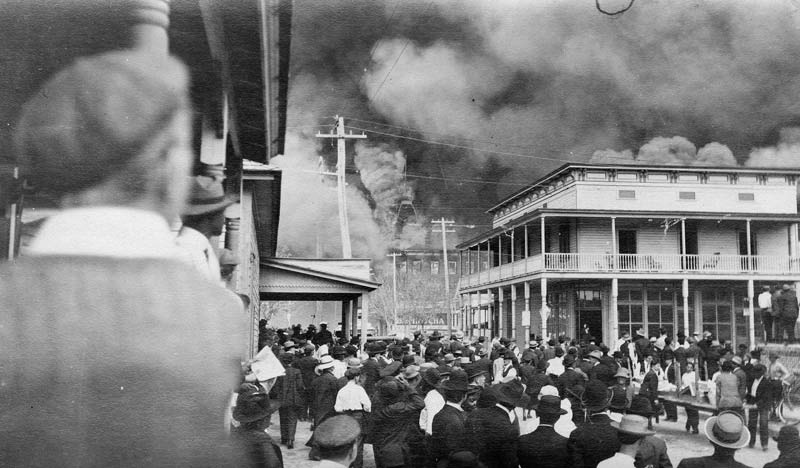
Read more about
this fire,
including the
entire front
page article
shown above, and
see why the
identification
of this photo is
incorrect.
It is not the La
Trocha cigar
factory seen
burning in the
distance.
HERE AT
THE GREAT YBOR
CITY FIRE OF
1908 AT
TAMPAPIX
|
|
BILL
FRECKER RUNS FOR
REELECTION IN 1908
AGAINST
FRANK
WING
In 1908,
Frecker
campaigned
on his
record
of law
enforcement
and
exposing
the lies
of the
Wing
campaign;
Frecker's
rally
was at
Court
House
Square.
Wing
held
four
rallies,
the
largest
of which
at
Franklin
and
Constance
St.
(Constant
St is
today's
Laurel
St.
It is
the
street
between
Fortune
and
Scott
streets
and was
named
for
early
Tampa
pioneer
Constance
Bourquardez.)
The
crowd at
the
Frecker
rally
first
thought
the
rally
would be
a battle
of the
bands.
Wing's
marching
band
came
within
half a
block of
the
square,
playing
loud
music,
drowning
out the
opening
speech
to the
point
that the
chairman
of the
rally
had to
wait to
continue.
Frecker's
band
responded
by
drowning
out
Wing's
band.
Eventually,
Wing's
band
marched
away and
the
speeches
resumed.
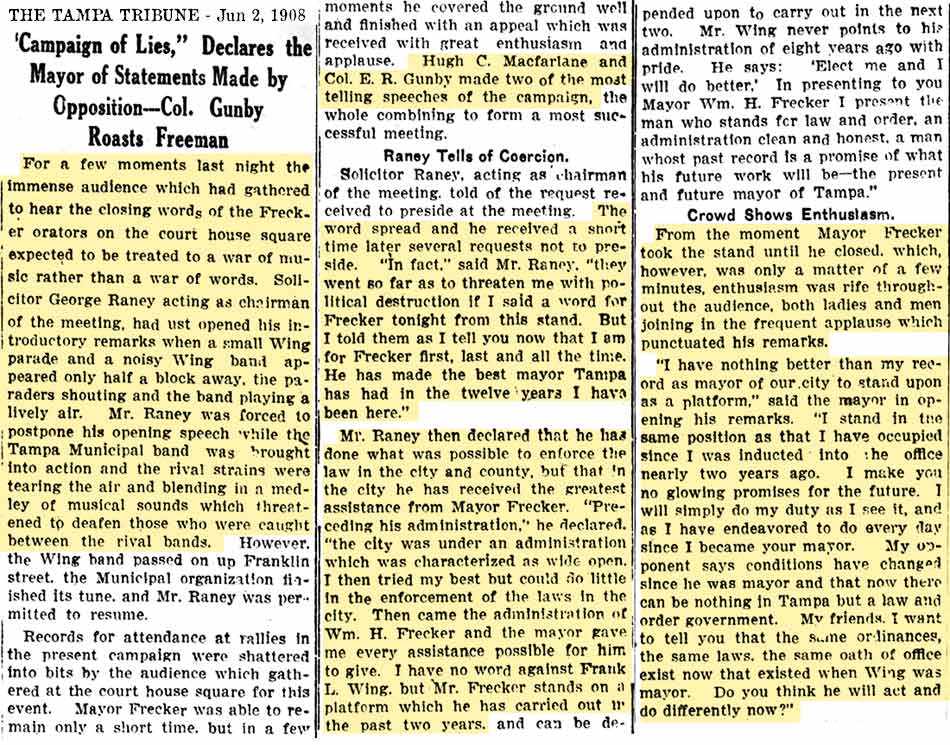
The Wing
campaign blamed
Frecker for the
devastation
cause by the
many fires,
especially the
recent Ybor City
fire, which
spread due to
lack of water
pressure to
fight the fire.
Wing claimed
that by tying up
the waterworks
company in
expensive
litigation, they
didn't have
funds to extend
and enlarge the
water mains in
Ybor City.
He also
criticized
Frecker for
removing A.J.
Harris as Fire
Chief, head of
the best and
most organized
department of
the City, just
because Harris
didn't vote for
him. He
also had former
mayor Frank
Bowyer
expressing his
low opinion of
Frecker for the
years Frecker
was city
councilman under
his
administration.
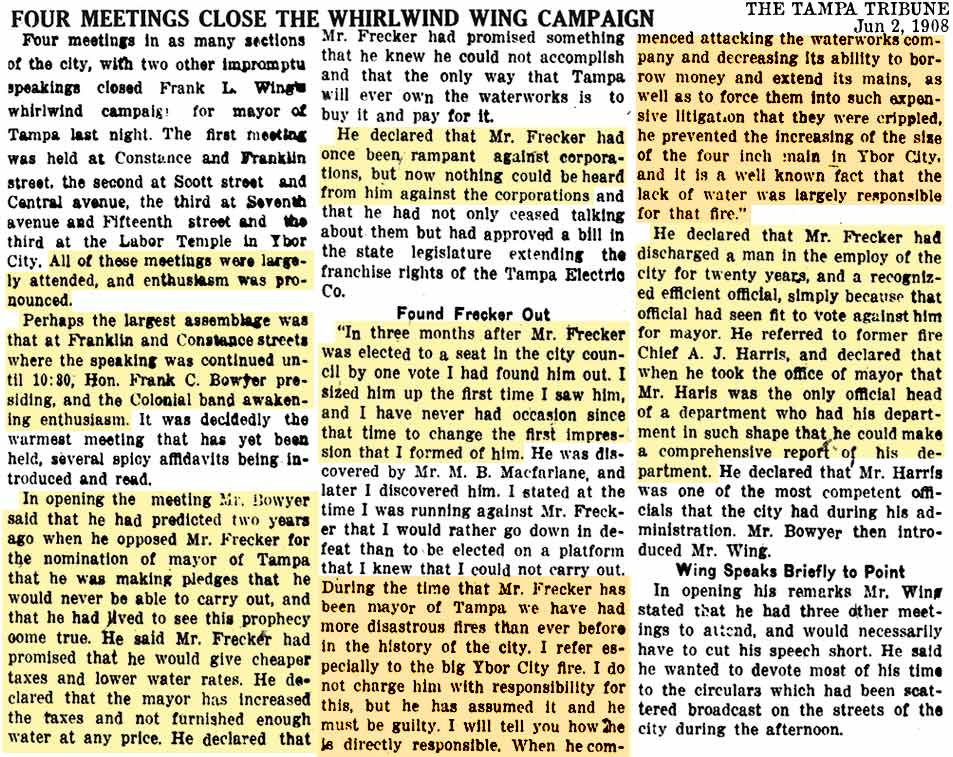
|
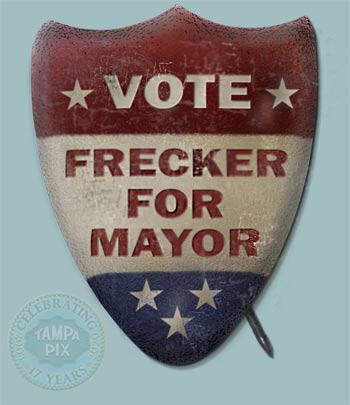 |
This
article
paints a
vivid
picture
of the
buzz of
activity
that
filled
Tampa
the day
before
and the
morning
of the
election.
Frecker
supporters
wore
small
red,
white
and blue
badges;
Wing
supporters
wore
buttons
with a
picture
of Wing
on them.
"From
one end
to the
other
last
night
rallies
were
held,
and the
voice of
the
political
exhorter,
rancorous
even in
the
dying
spasms
of
oratory,
could be
heard in
many
localities
well
into the
cool of
the
early
morning
hours.
In every
ward
political
henchmen
cheered
their
favored
ones to
the
degree
of hope
for
future
reward...the
streets
of the
city
were
literally
carpeted
with
circulars
on which
were
printed
cartoons,
copies
of
affidavits,
charges
and
countercharges,
refutations
and
insinuations. |
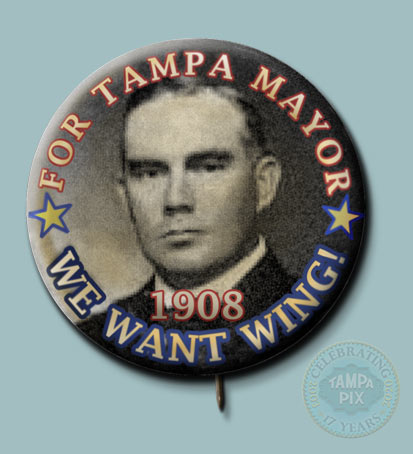 |
|
...Betting, and there was much of it, was at even figures with a considerable amount of both factions to be had...Every available vehicle in the city has been chartered for the day and painters have had their hands full drawing flaming letters for banners to attach to carriages and automobiles. |
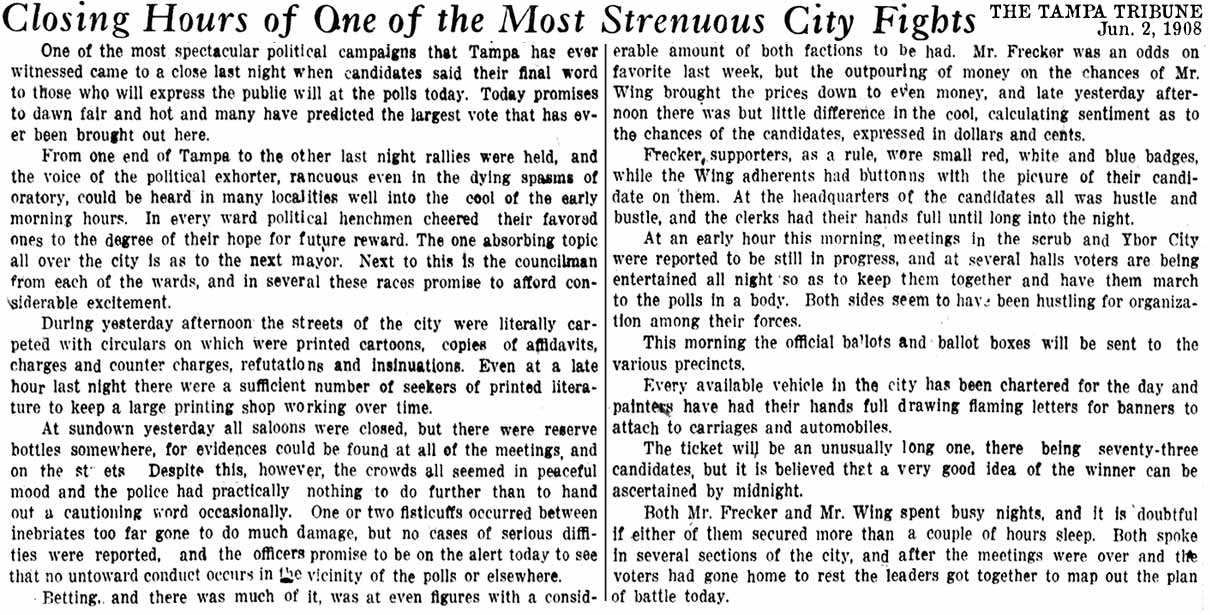
There
was a
Tampa
record
82%
voter
turnout,
with
Wing
winning
by just
126
votes or
3.1%
margin
of
victory.
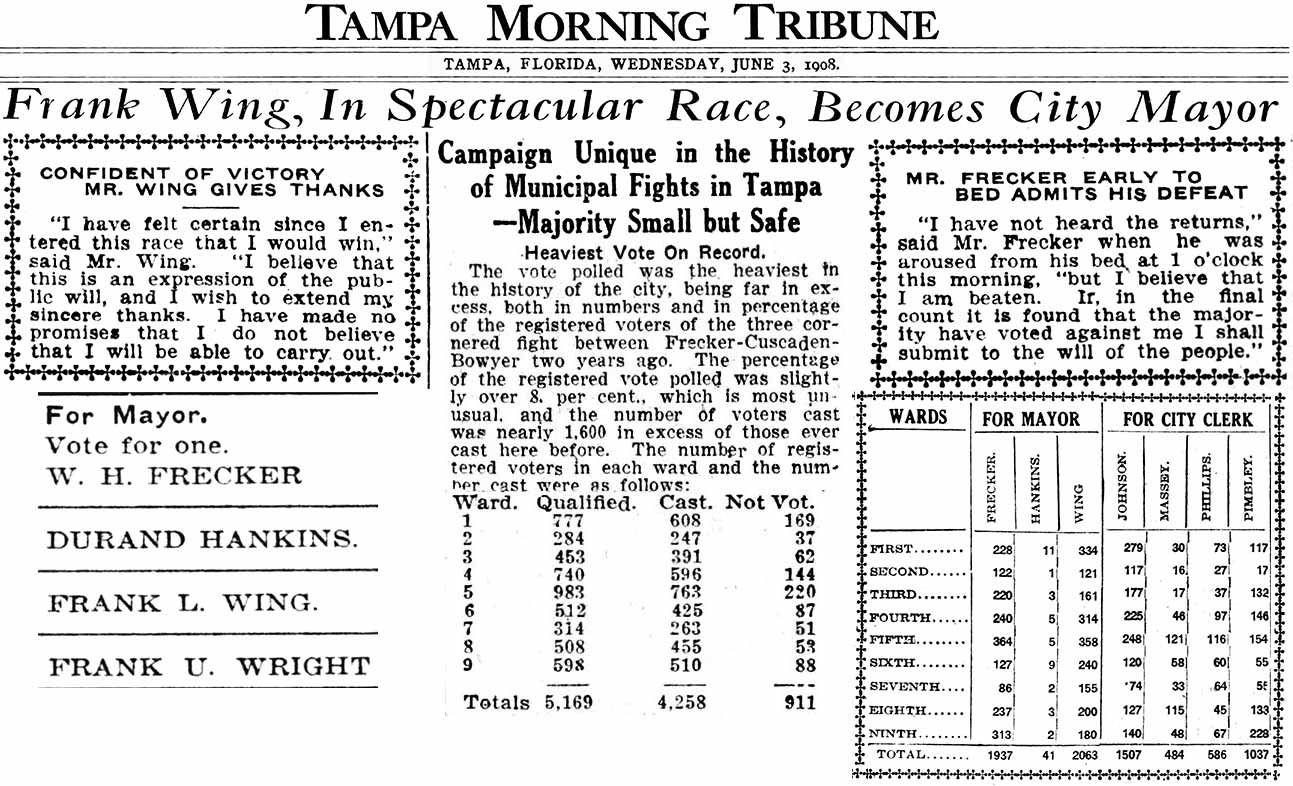
|
|
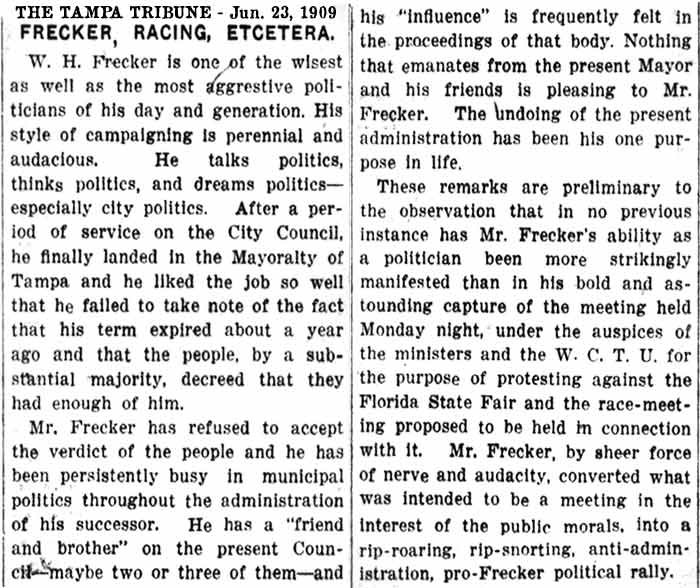 |
AT LEFT:
During the term of Mayor Wing, the Tribune criticized Frecker for continuing to remain active in municipal politics after
his term as mayor had ended. They claimed "he has a 'friend and brother' on
the present Council--maybe two or three of them--and his 'influence' is
frequently felt in the proceedings of that body. The undoing of the
present administration has been his one purpose in life."
FRECKER
BICYCLE
CITATION
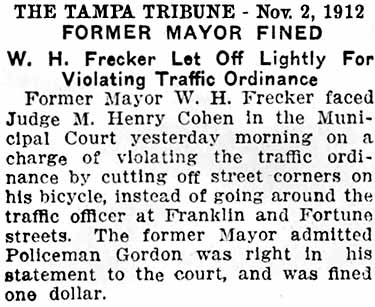 |
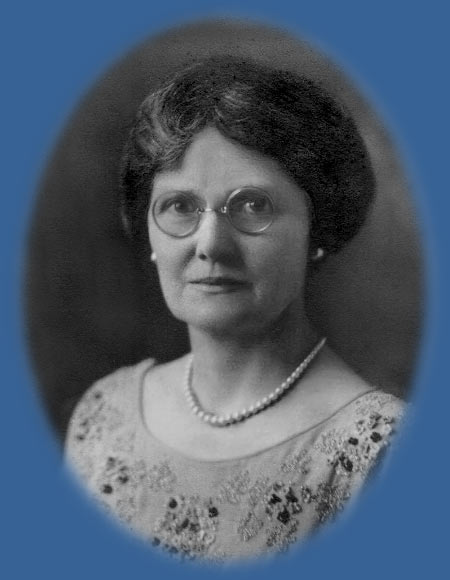 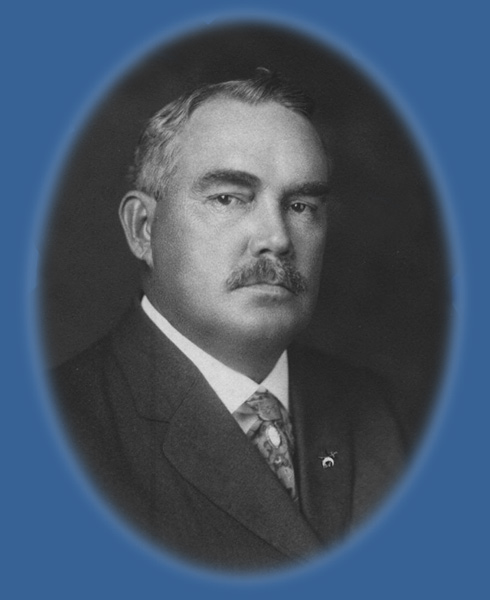 THE WING FAMILY IN TAMPA THE WING FAMILY IN TAMPA
Frank Wing came to Tampa from New Bedford, MA in 1889 at the age of 21.**
In 1892
he
married
Annie E.
Hale,
a resident of Tampa since the age of one (daughter of Horace Harvey Hale & Ida Mary Lipscomb.). An article in the June 10, 1900 Tribune when Wing became mayor says that after his marriage they returned to his New England home with the intention of remaining there. "But thanks to the influence of his wife, he was induced to come back to Tampa."
**His obituary and City of Tampa website say he engaged in the furniture business, but this wasn't until 1900 when he joined Wm. Frecker. |
|
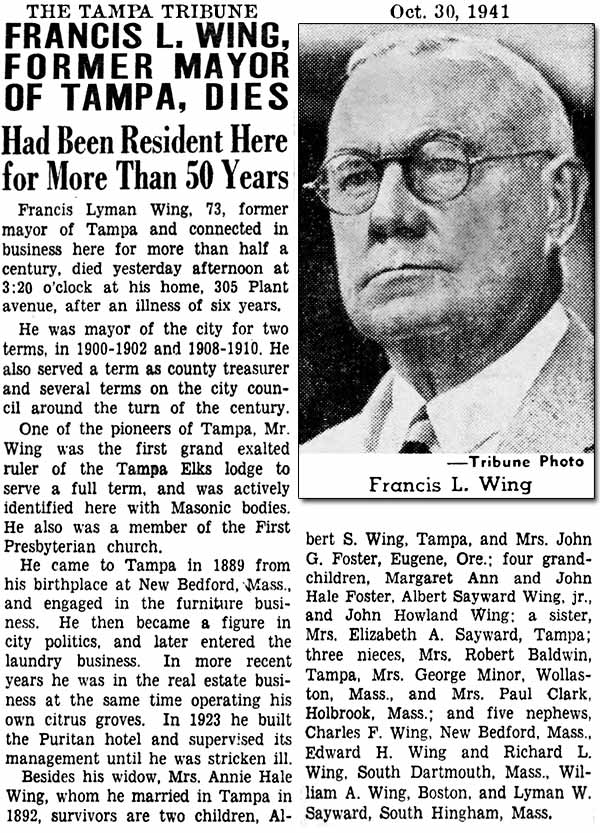
The
Wings
were
back in
Tampa
before
1895
when in
January,
1895,
Frank
purchased
a lot in
Ybor
City on
7th Ave.
between
15th &
16th St.
for the
purpose
of
building
a wooden
structure.
When
completed,
it was
the
location
of his
pawn
shop.
At this
time,
Wing was
also in
the real
estate
business
in
an
office
on the
Sparkman
block.
This was
the east
side of
Franklin
St.
between
Madison
&
Twiggs,
the 500
block.
In
late
Nov.
1895, he
had a
one-story
brick
building
built on
his lot
at the
corner
of
Franklin
and
Tyler
streets,
from
which he
continued
in his
real
estate
business.
In Dec.
1895,
Frank
was
joined
by his
brother-in-law,
Horace
E. Hale,
in his
pawn
broker
business
in Ybor
City.
Horace
was
formerly
with W.
H.
Ferris'
shoe
store
for the
previous
five
years.
In 1895
their
daughter
Dorothy
was born
and
around
which
time
they
built a
beautiful
house on
north
Morgan
Street
in Tampa
Heights.
Their
children
were:
Dorothy
(b.1895), Francis, Jr. (b.1899), Margaret (b. 1904*) and Albert (b.1906*).
*According
to their
censuses.
Wing
served
as a member of the City Council from June 1898 to June 1900,
(along with Bill Frecker,) the
first
few
months
being
the the
time of
the Spanish-American War. During this term, he was a member of the Finance Committee, Police Department Committee and Chairman of the Schools and Public Buildings Committee. He was politically active and served a term as Hillsborough County Treasurer.
After he served as a council member, he ran unopposed for mayor as the Citizens’ League candidate in June 1900. Wing was twice elected Mayor of Tampa, first from June 8, 1900 until June 4, 1902, and again from June 3, 1908 until June 4, 1910.
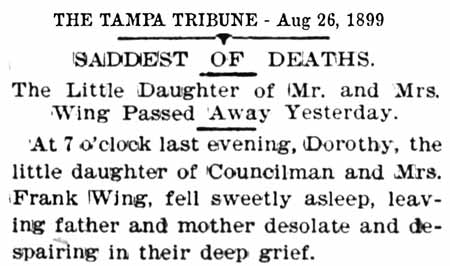 In Aug. of 1899, Frank and Annie Wing's four-year-old daughter Dorothy died from a sudden illness. She had been sick for only a short time, and a few days before her death the Tribune published "The many friends... will be delighted to know that their little girl is considerably better, and the attending physician thinks she is entirely out of danger." Her death notice two days later, Aug. 26, says "..but she must have foreseen the coming of the Angel of Death for only a few days since, she remarked to her mother that she would "soon be gone." In Aug. of 1899, Frank and Annie Wing's four-year-old daughter Dorothy died from a sudden illness. She had been sick for only a short time, and a few days before her death the Tribune published "The many friends... will be delighted to know that their little girl is considerably better, and the attending physician thinks she is entirely out of danger." Her death notice two days later, Aug. 26, says "..but she must have foreseen the coming of the Angel of Death for only a few days since, she remarked to her mother that she would "soon be gone."
(Read the newspaper articles.)
The 1900 Census shows them at 209 7th Ave. in Tampa Heights, living across from William Beckwith who at the time was a real estate agent.
In 1900, Bill Frecker joined Wing at his Union Furniture business. Their political differences during Wing's mayoral term which Frecker was on the City Council led to Frecker leaving Union Furniture all to Wing. In 1905, Wing left the furniture business to devote all his time to public office, selling his Union Furniture back to Frecker.
FRANK WING'S MAYORAL ACCOMPLISHMENTS
(Information from "The Mayors of Tampa, 1856-2019")
During Wing’s first administration, Tampa benefited from a steady population growth, due in part by the economic prosperity from cigar manufacturing in Ybor City, phosphorus export, and the Port of Tampa (Port Tampa City 1893 – 1961). The population growth placed an enormous strain on public works and services. In response, Wing and succeeding mayors embarked on capital projects to improve and expand the City’s public works and services to the community.
During his second term Mayor Wing worked on capital projects to improve public works and services within the city. He was the driving force in the construction of the Gordon Keller Hospital. He also attempted to expand the police, fire, and other City departments. He initiated an expansion in sewers and water drainage capital projects and substantial improvements were made to the Port of Tampa.
From 1899 – 1911, the need for additional railroads, other than Henry B. Plant’s, to manage the expanding phosphate shipping industry became apparent. The Spanish American War had proven how inadequate the harbor facilities were. Local businessmen and the city administration sought and received funds from the U. S. Congress to deepen (20 feet) and straighten (300 feet) the shipping channel from Port Tampa to downtown Tampa and the Ybor (Creek) Estuary. In 1905, funds were provided to dredge sand to create Sheddon Island (now Harbour Island) for phosphate.
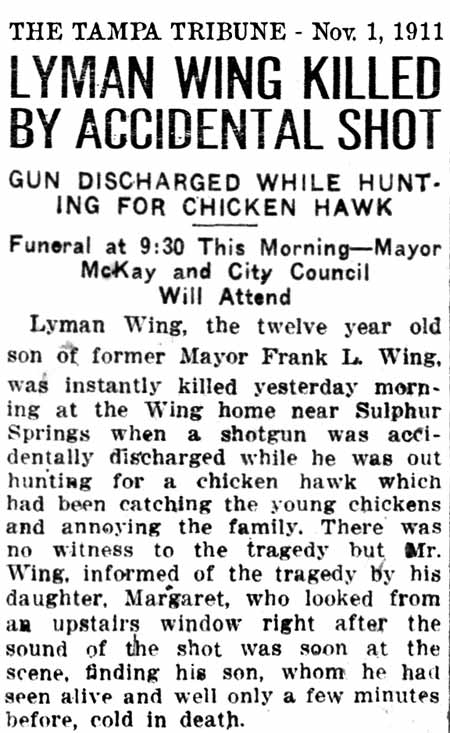
BACK TO BUSINESS AND DEATH OF SON, LYMAN WING
After his second term, Mayor Wing retired from politics and devoted himself to business, family, and social activities, which included the Freemasons and the Elks Club. His 1910 Census was taken while the Wings lived in the Tampa Heights area near Henderson Ave. and Oak Ave.
In Oct. 1911, his son, Francis Lyman Wing, Jr. died at the age of 12 from an accidental self-inflicted rifle shot. He was hunting a chicken hawk on the family property in Sulphur Springs when he dropped his rifle, causing it to discharge. (See the whole article.)
Frank Wing was also in the steam laundry business. His 1920 Census shows he was also a fruit farmer and had moved to 301 Plant Ave. in Hyde Park with his wife and teenage children, Margaret and Albert.
Wing was also involved in the construction and sale of houses.
In 1922, one of his notable structures was opened for business, the Puritan Hotel in Hyde Park.
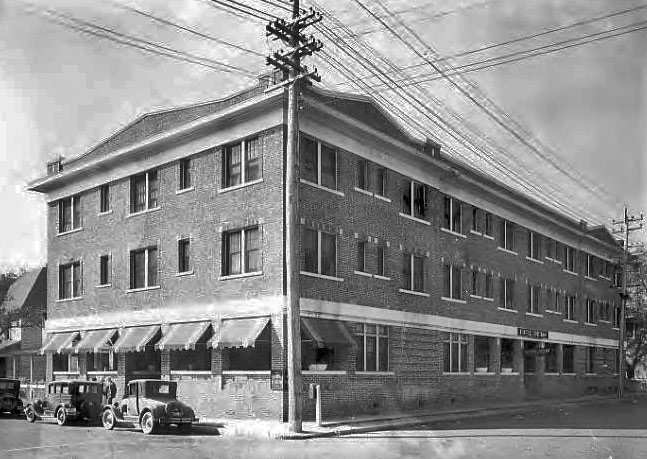
At left, the Puritan Hotel on Jan. 31, 1927. It was located on the corner of Plant Ave. and Platt St.
Mouse over the photo to see it on Jul. 20, 1950.
Both photos courtesy of the Burgert Bros collection at the Tampa-Hillsborough Co. Public Library System.
His 1930 Census shows him and wife Annie with the house all to themselves, both around 60 and Frank in the real estate business. In addition, Wing served as director of the Lyons Fertilizer Company and served on the boards of several other local businesses.
According to his obituary, Frank managed the Puritan until he became ill around 1935. On the Wing's 1940 Census, Frank & Annie were at the same location, with their 33-yr-old son Albert Sayward Wing, living next door with his family--wife Elizabeth, son Albert Jr. (3) and John H. (2). Albert Sr. had taken over the position of the Puritan hotel manager. Frank had no occupation listed and died the next year, in October. Some info above from City Council of Tampa, 2015 and Mayors of Tampa, 2019
|
FRECKER RUNS FOR
MAYOR AGAIN, 1910
In his campaign for
mayor in 1910,
Frecker was endorsed
by three big guns:
-
Hugh
MacFarlane,
prominent
Tampa
attorney and
the "Father
of West
Tampa" who
was
"recently
elected by a
flattering
vote to the
Board of
Public
Works."
-
Former City
Councilman
now Sanitary
Chief, James
N. Holmes
who was
defeated in
the primary
election.
-
Edward R.
Gunby,
another
successful
Tampa
attorney who
in 1904,
along with
Horatio
Bisbee and
William Wade
Hampton,
defended the
rights of
the settlers
on the old
Fort Brooke
property,
and argued
against the
Hackley
Spanish Land
Grant.
At a rally held Apr.
20, 1910, Hugh Macfarlane
reminded voters of Frecker's record and
stance on law
enforcement, and
particularly
stressed his stand
on the big
corporations, saying
Frecker was a man
who would not sell
out. He had
known Frecker ever
since he came to
Tampa, and he stood
up against the
strongest opposition
from the
corporations then
and up to the
present time.
"And if the
corporations have
experienced a change
of heart, it is
because they have
learned that it is
better to take what
Mr. Frecker will
honestly give them
without selling out
than to have to buy,
at the present high
rates, those who are
willing to sell
their influence."
In
Part 2 of this
article, Frecker
addressed the crowd
saying he knew he
was among friends
because when he came
to Tampa, he lived
in the old Second
Ward which had by
this time been
divided into many
other wards, and all
had confidence in
him. He
pointed out that
since the time he
left office, no new
improvements had
been made to the
newly annexed areas
from his
administration.
He spoke in favor of
paving, lighting,
sewerage, as well as
parks and breathing
places "where the
women and children
could enjoy
recreation."
He also spoke of
Rev. Joe Sherouse,
who apparently was
an opponent, saying
of him "..but he
forgot to tell you
how much he had lied
to you, and I
venture to say that
there was never a
speaker on a Tampa
platform who has
told so many
untruths."
Frecker voiced his
opinion of City
Attorney Rowland,
apologizing for
calling him a
"gentleman" earlier
and would refrain
from calling him a
lawyer to prevent
adding disgrace to
the legal fraternity
of Tampa.
Frecker also
criticized Frank
Wing, who two years
ago (1908-current)
wanted a chance to
redeem his first
administration
(1900-1902), "and
the very first act
...after taking
office was to try to
have Fred Turner
removed from the
Police Committee,
because he knew
Turner believed in
the enforcement of
the laws.
Frecker declared
that the present
conditions in Tampa
were a disgrace,
that the police
force was
disorganized and
spent its time
walking the streets
advocating the
candidacy of D. B.
McKay.
"I charge
that the
proposed
McKay
administration
represents
the same
interests as
the Wing
administration.
There have
been many
mistakes
made in this
world, but
the greatest
mistake ever
made by the
people of
Tampa was
the election
of Frank L.
Wing.
Do you want
his
administration
perpetuated
by Mr.
McKay?"
He pointed out that
on a petition for
McKay as mayor,
circulated by Elmore
Webb, the first name
on it was Frank
Wing. Frecker
read a letter from
successful
businessman Robert
Mugge, which stated
on April 4, 1909,
"Gambling was never
worse than now.
It exists within two
blocks of City Hall.
I asked a gambler if
he were not afraid
and he replied, 'No,
because they dare
not squeal.'"
("They" being city
officials, because
they were in the
pockets of the
gambling houses, and
cracking down on
gambling would
expose them.)
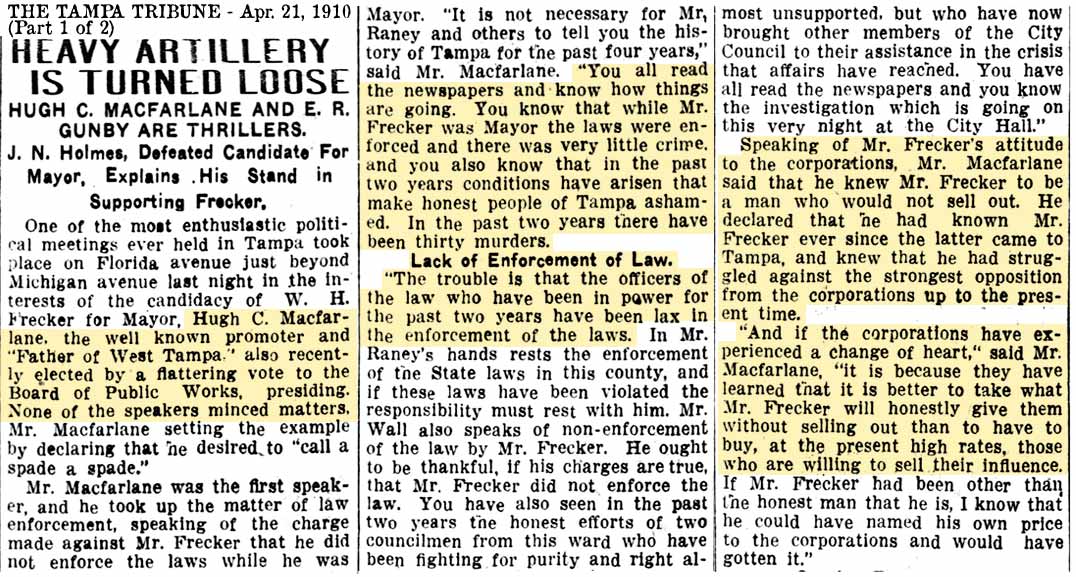
Next,
James N. Holmes
spoke at length at
why he supports
Frecker.
Because after
conferring with him,
he found that they
held many of the
same ideas regarding
city improvements,
including the
submitting to the
people of bonds to
be voted on as to
how the money would
be spent.
Edward Gunby said it
was his pleasure to
"puncture, one by
one, the bubbles
which the McKay
forces had been
blowing." One
was the quit claim
deed passed by the
Frecker
administration in
favor of the Tampa
Northern Railroad,
which McKay
criticized in his
newspaper, the Tampa
Times.
Gunby showed that
the Supreme Court of
Florida and of other
states ruled that
land covered by
water between the
shore and Government
channel belongs, by
right, to the owner
of the abutting
property. Gunby
stated that the same
issue and stance was
taken by the
Salomonson
administration with
the Seaboard
Railway, which McKay
did not see fit to
criticize.
He
closed with what the
Tribune said was a
"fine burst of
oratory seldom
equaled anywhere,
which bore some
reminder of the
manly doctrine of
Theodore Roosevelt."
Gunby said, "I want
to say a word to the
young men. No
matter which side of
any political
question you may
take, you should
stand up for moral
principles. It
is unfortunate that
whenever a large
community of people
is gathered
together, things
exist which you and
your families should
never see, hear, or
know about.
Indecencies are
flaunted in the
public streets
before your faces.
One man cannot make
a whole community
pure, but you should
stand against public
shame and vice and
cast your vote so
that you can kneel
before your God and
your mother
unashamed, knowing
that you have done
your duty."
READ
THE REST OF THIS
ARTICLE IN ITS
ENTIRETY.
D. B.
McKay won that
election in 1910.
|
1910
Census,
Tampa
For
some
unknown
reason,
the
Freckers
were
enumerated
twice
on
the
1910
Census,
by
the
same
enumerator.
After
recording
them
on
April
16,
he
recorded
them
again
on a
supplemental
page
on
the
18th,
at
the
start
of a
different
neighborhood,
and
as
the
only
family
on
the
page
stamped
"SUPPLEMENTAL."
Their
April
16
listing
seems
to
be
the
more
accurate,
showing
William
a
merchant
in
the
furniture
business,
and
as
an
employer.
Barbara
indicates
she
was
the
mother
of 3
children,
1
living
at
the
time.
She
was
actually
the
mother
of 4
children;
3
died
in
Chicago
before
coming
to
Tampa.
This
is
indicated
on
their
1900
Census
which
was
enumerated
by
their
son,
Charlie
T.
Frecker.
She
and
William
were
on
their
first
marriage
for
35
years.
In
the
home
is
his
Mayor
Frecker's brother,
Charles
Frecker,
twenty
years
his
younger
and
single.
Charles
was
actually
a
half-brother,
being
a
son
of
Thomas
Nicholas Frecker's
2nd
wife,
Martha
Eleanor
McDermott.
Charles's
middle
name
was
Albert,
and
he
appears
in a
few
newspaper
articles
as
"Bert
Frecker."
Charles
was
a
salesman
in
the
furniture
business,
and
is
listed
as
"w"
and
employee.
He
was
working
for
his
brother
at
Chicago
Furniture
House.
Their
April
18th
listing
has
some
obvious
errors,
which
makes
the
rest
of
the
information
suspect.
William
and
Barbara's
ages
differ
by
four
years,
which
is
not
correct.
At
most
they
would
differ
by
ONE
year
depending
on
the
current
month.
Here,
the
enumerator
has
put
"None"
for
occupation
of
William
and
his
wife
Barbara,
yet
has
Barbara
working
at a
furniture
store
and
no
occupation.
Charles
is
listed
as a
Carpenter.
 |
1912 - BILL FRECKER
RUNS FOR MAYOR A
FOURTH TIME
|
In
late
Feb.
1912,
about
twenty-five
men
gathered
at
the
Chicago
Furniture
House
for
a
political
meeting,
for
the
purpose
of
discussing
who
should
run
for
mayor
in
their
party.
A
committee
was
appointed
to
try
to
get
Clerk
of
the
Circuit
Court C.M.
Knott
to
agree
to
run,
and
if
he
declined
"the
honor
is
to
be
tendered
to
their
old
stand-by,
Frecker."
In
mid-March,
the
Hillsborough
County
political
club
apparently
not
able
to
convince
Clerk
Knott
to
run,
chose
Frecker
at
a meeting
for
which
he
wasn't
even present.
A
committee
was
appointed
to
go
to Frecker's
house
that
night
to
inform
him
and
he
had
to
be
rousted
from
bed
to
be by a
delegation
from
the
club
that
informed
that he
had
been
selected
to
"carry
the
banner
of
the
organization,"
and
that
he
declined
to
state
that
night
whether
he
would
accept. |
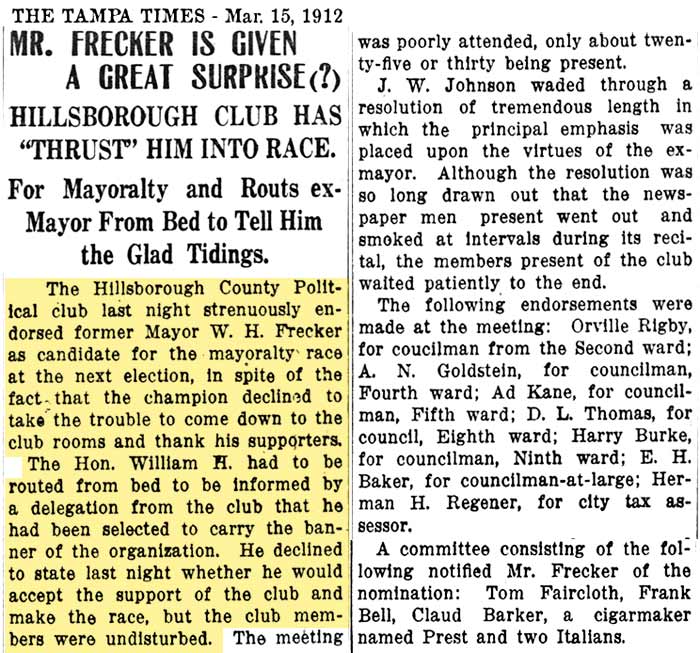 |
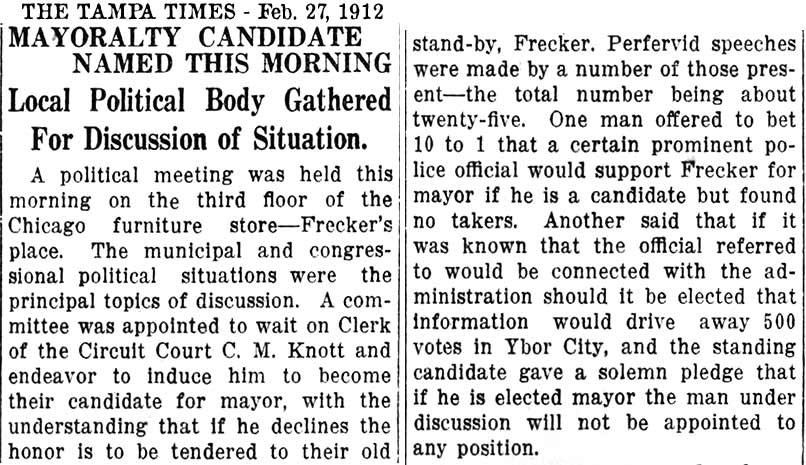 |
|
FUND
RAISING
IS
DISMAL
Three
days
later,
the
Times
(whose
owner
&
editor
was
D.
B.
McKay)
published
that
Frecker
was
reluctant
to
run
due
to
lack
of
funds,
stating
that
he
still
had
debts
he
incurred
during
his
campaign
two
years
ago.
The
article
goes
on
to
say
that
upon
hearing
there
were
200
members
in
the
association,
Frecker
proposed
that
if
100
would
give
$10
each
and
the
remainder
give
what
they
could,
he
could
run.
Times
claimed
that
the
hat
was
passed
and
$53
was
raised. Afterward,
Frecker
said
he
would
consider
the
matter
and
give
answer
at a
later
date. |
|
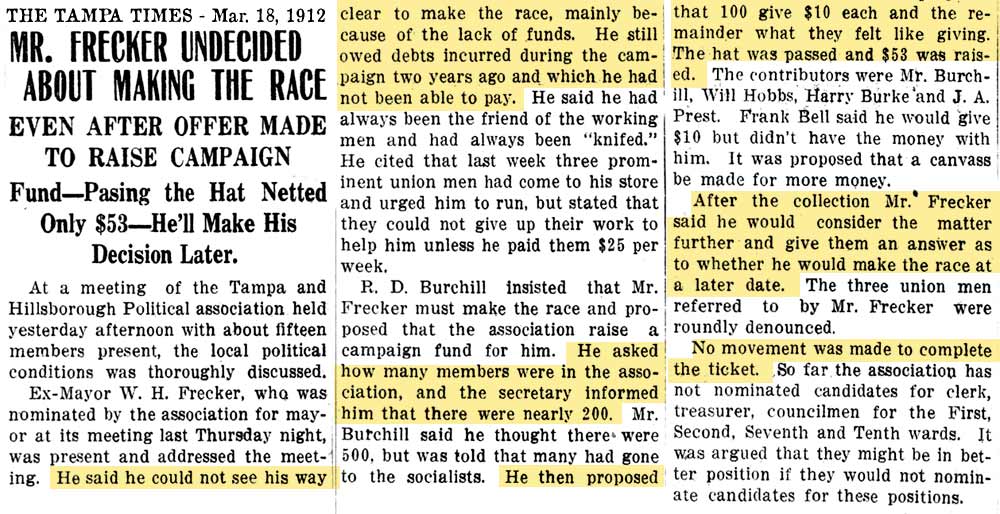
FRECKER
PROVOKED
INTO
RUNNING
FOR
MAYOR
The
next
day,
the
Times
and
the
Tribune
both
printed
articles
of
similar
content,
stating
that
Frecker
had
decided
to
run
because
he
was
angered
at
what
the
Times
had
printed
on
the
18th
about
the
lackluster
effort
of
the
members
to
contribute
to
his
running.
A
member
of
the
group
who
was
a
former
member
of
the
board
of a
cigar
makers
union,
Mr.
Prest,
delivered
the
message
to
the
Tribune
stating
that
"Mr.
Frecker
said
he
did
not
intend
to
run
until
he
saw
the
scurrilous
and
lying
article
in
the
Times
this
afternoon.
This
is
the
only
reason
that
he
has
finally
agreed
to
enter
the
contest."
The
Tribune
reports
that
Mr.
Prest
was
to
have
been
a
compromise
candidate
of
the
organization
if
Frecker
had
not
consented
to
run.
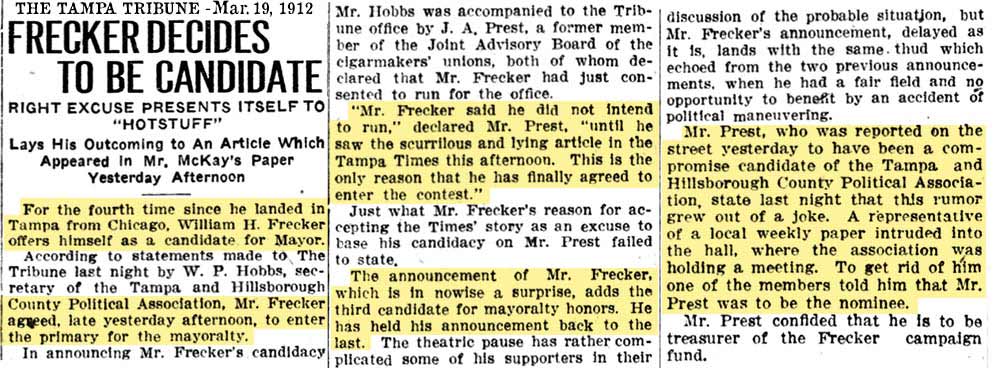
INACCURACIES
BLAMED
ON
UNNAMED
INFORMANT
Both
the
Tribune
and
the
Times
attributed
any
of
the
"inaccuracies"
of
the
Times'
article
on
Frecker's
political
organization
itself,
claiming
that
a
reporter
who
tried
to
attend
their
meeting
where
Frecker
was
chosen
and
the
contributions
were
made
was
"curtly
informed"
that
he
could
not
be
admitted
into
the
meeting
because
they
were
holding
an
executive
session.
So
the
reporter
had
to
get
the
story
from
"other
sources"
because
"the
whole
populace
were
literally
'holding
their
breath'
in
painful
suspense
awaiting
the
decision
of
the
perpetual
candidate
and
his
followers."
The
Times
claims
that
the
information
on
which
the
article
that
Frecker
found
to
be
scurrilous
was
obtained
from
a
man
who
said
he
attended
the
meeting,
and
that
he
had
reiterated
the
next
day
that
it
was
correct
in
every
detail.
The
Times
also
says
that
their
unnamed
informant
said
that
the
resolution
nominating
"Hotstuff"
as a
candidate and
"lauding
him
as
the
noblest
Roman
of
them
all"
which
was
adopted
by
his
political
organization
last
week,
was
written
or
dictated
by
the
candidate
himself.
The
Times
adds,
"Of
course
modesty
is
his
chief
characteristic--the
proof
is
overwhelming."
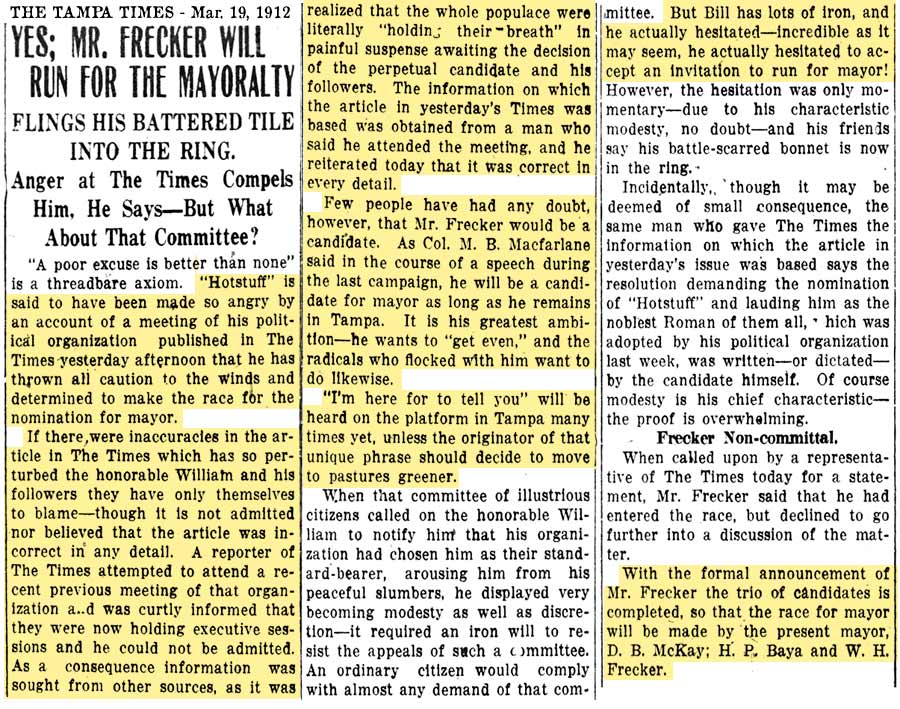 |
THIRD STRIKE,
FRECKER IS OUT
Bill Frecker was
defeated by D.
B. McKay by a
margin of 743* votes, with
McKay taking
1,778 votes,
Frecker 1,025,
and Baya 413.
This time the
mayoral term
would be four
years instead of
two. The Times
reported that
former Mayor
Frecker came by
the Times office
to congratulate
McKay on his
win, and to a
Times reporter said:
"The
primary ** is
over, I am
glad indeed
that the
contest was
settled with
one
election.
That means
we escape
the
bitterness
that almost
always
accompanies
a second
primary."
"Mayor
McKay is my
mayor as
much as any
man's
now...Life
is too short
for the
indulgence
in partisan
politics,
and we
should have
less of that
sort of
thing in our
city.
I believe we
will have an
administration
that will
make the
city more
prosperous.
We need a
bond issue
to carry
through much
needed
improvements.
As a citizen
and taxpayer
I will lend
my vote to
putting
through such
a bond
issue..every
man should
lay aside
his personal
preferences
and forget
politics and
work for a
greater
Tampa.
We can
afford to
trust the
city's
future in
the hands of
Mayor
McKay."
*The
Tribune claims
McKay's majority
was 340 votes,
which could only
be correct if
you combine
Frecker's 1,025
with Baya's 413.
**Again, the use
of the term
"primary" to
mean a final
election,
further misused
by stating "a
second primary"
which would be a
runoff election.
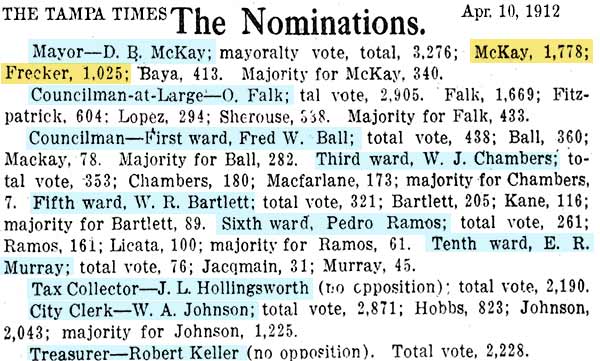
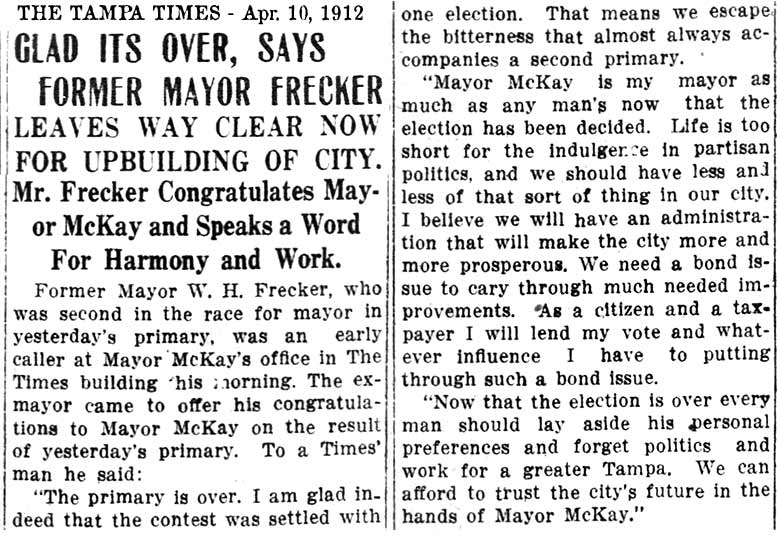
|
BILL
FRECKER
VIES
FOR
STATE COLLECTOR
OF
CUSTOMS |
|
In
1913
Bill
Frecker
was
a
candidate
for
the
Collector
of
Customs
for
Florida.
This
was
a
much-coveted
Federal position
which
paid
very
well,
and
was
highly
politically
patronage-oriented.
Individuals
who
were
qualified
and
often
not-so-qualified
but
supported
the
President
or
his
party
to a
great
extent
were
often
rewarded
with
the
position.
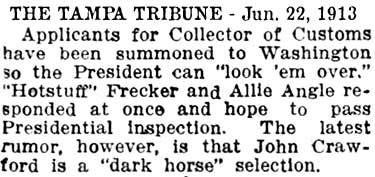
|
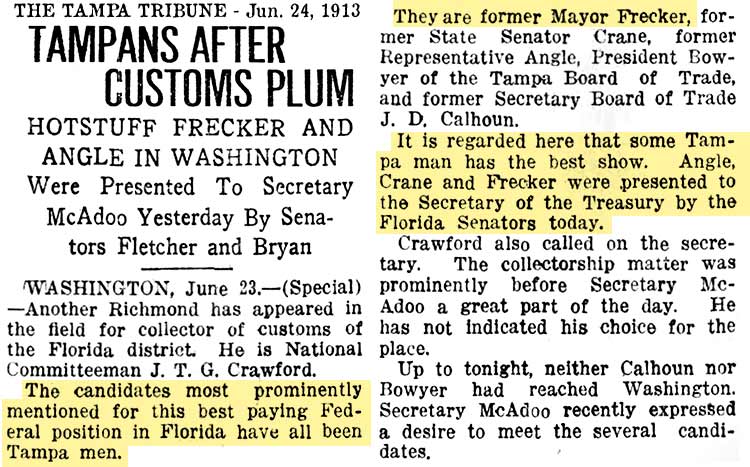
"The
candidates
most
prominently
mentioned
for
this
best
paying
Federal
position
in
Florida
have
all
been
Tampa
men:
former
Mayor
Frecker,
former
State
Senator
James
E.
Crane,
former
State
Rep
A.
J.
Angle,
President
of
the
Board
of
Trade
Frank
Bowyer,
and
former
Sec.
of
the
Board
of
Trade
J.D.
Calhoun. |
|
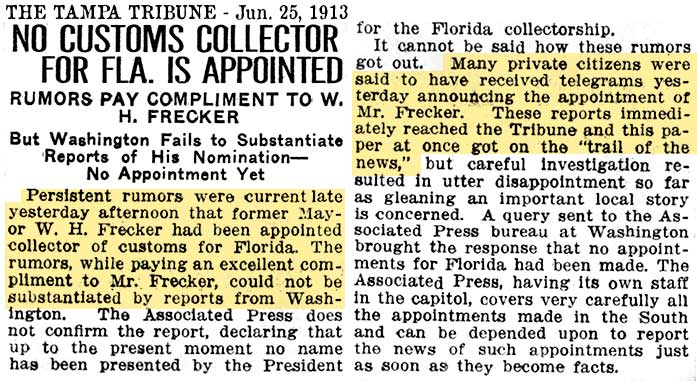
|
On. Jun 24, 1913, rumors swept through Tampa that former Mayor Frecker had been appointed to the position. Many private citizens reported they received telegrams announcing this. The Tampa Tribune carefully investigated this by contacting the Associated Pres bureau in Washington who dispelled the rumor; no appointment had been made. |
|
|
|
|
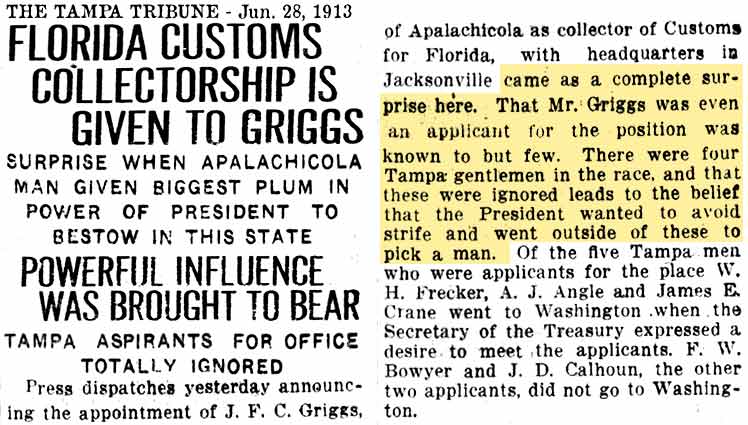
|
Three days later, the Tribune was shocked to learn that an Apalachicola man was given "the biggest plum in power of the President to bestow in this State."
James Fennimore Cooper Griggs, with headquarters in Jacksonville, "came as a complete surprise here. That Mr. Griggs was even an applicant for the position was known to but a few.
The Tribune claims that the belief was that the President (Woodrow Wilson, a Democrat) "wanted to avoid strife and went outside of these to pick a man."
Of the five Tampa men, Bowyer and Calhoun were not called to Washington to be interviewed. |
Stovall unleashed on
everyone from
President Wilson's
administration to
Griggs, writing that
Griggs was from the
smallest customs
port in the State.
He had no
acquaintance at all
with the customs
service and knew
little or nothing
about how it has
operated in such a
great port as
Tampa's. He
was an unsuccessful
candidate for
Congress in the 3rd
District, but was
one of two delegates
from Florida to the
last National
Convention and was
the first of the
delegation to vote
for Wilson at that
convention.
He was an
unsuccessful
aspirant for the
office of Collector
of Internal Revenue
and never mentioned
as a candidate for
Collector of
Customs. What
really irked the
Tribune was that
Tampa was made
subordinate to
Jacksonville.
"That the
large affairs of
Tampa's port would
be conducted under
the direction of
Jacksonville
headquarters is bad
enough, but to add
insult to injury, we
are to have our
customs affairs
directed by an
appointee from an
insignificant
port...who is in no
essential the man
for such an office."
This was resented by
every citizen in
Tampa so strongly
that there is "unrestrained
talk of political
scalps dangling at
Tampa's belt in the
near future."
The Tribune goes on
to say, that "it
may not even be
considered facetious
to suggest that,
having thus shown
its high
consideration for
the standing and
importance of this
port, the
administration go to
some other small
village, like
Micanopy, to choose
the deputy collector
for Tampa, and to
still another, like
Sopchoppy, to choose
our next postmaster."
The two Statewide
offices which were
filled by
appointment by the
present
administration in
Washington had gone
to West Florida.
"It would seem
to be about time
that someone inform
the White House very
positively that
there is more than
one section of
Florida."
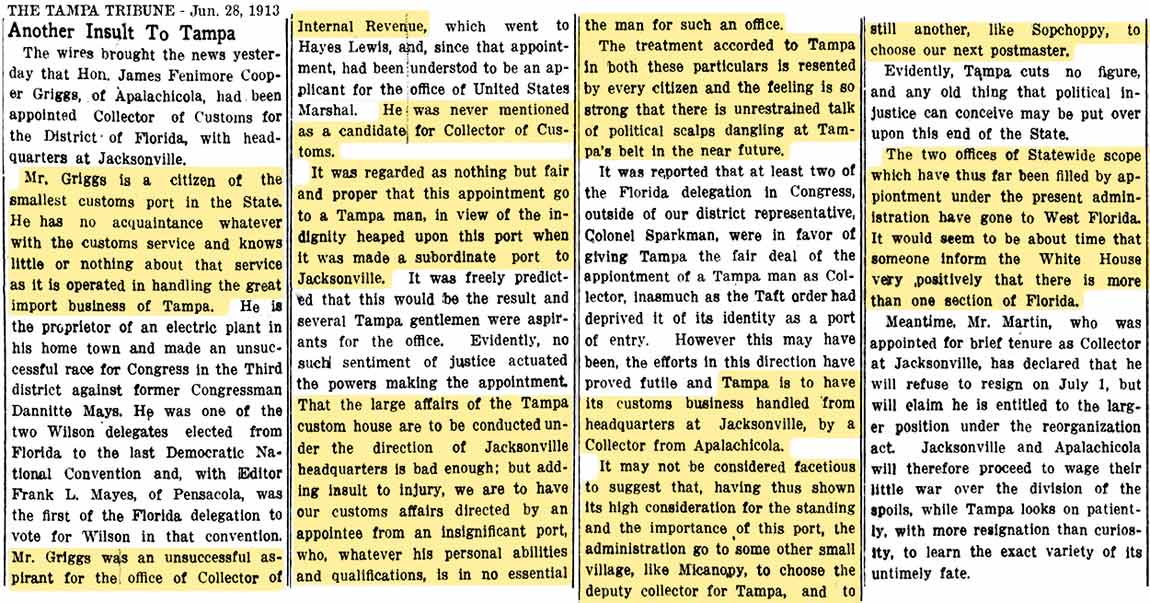
WHAT
WAS
A
COLLECTOR
OF
CUSTOMS?
The
Collector
of
Customs
was
a
federal
officer
who
was
in
charge
of
the
collection
of
import
duties
on
foreign
goods
that
entered
the
United
States
by
ship.
The
office
was
described
as
"the
prize
plum"
of
Federal
patronage
not
only
in
the
state
but
perhaps
in
the
country,
outside
of
positions
in
the
Cabinet.
Because
they
were
originally
paid
based
on a
percentage
system
that
factored
in
both
customs
collected
and
fines
levied
for
those
who
attempted
to
evade
payment,
these
appointments
were
very
lucrative,
especially
at
the
largest
and
busiest
ports.
Customs
collections
at
U.S.
ports
were
overseen
by
three
political
appointees—the
Collector,
Surveyor,
and
Naval
Officer.
Customs
authorities
are,
rightly
or
wrongly,
often
perceived
as
tax
collectors.
This
is
not
entirely
false:
it
is
even
one
of
their
main
tasks.
However,
in
reality,
their
role
was
much
more
complex.
Customs
authorities
oversaw
the
goods
traffic
and
the
people
entering
and
leaving
the
country.
They
had
to
verify
that
everything
was
legal
and
complied
with
the
laws
and
regulations
of
the
country.
They
ensured,
among
other
things,
the
safety
of
citizens,
of
the
environment
and
of
the
local
industry.
The
U.S.
Customs
Service
employed
a
number
of
federal
law
enforcement
officers
throughout
the
19th
and
20th
centuries.
Customs
Special
Agents
investigated
smuggling
and
other
violations
of
customs,
narcotics
and
revenue
laws.
Customs
Inspectors
were
uniformed
officers
at
airports,
seaports
and
land
border
ports
of
entry
who
inspected
people
and
vehicles
entering
the
U.S.
for
contraband
and
dutiable
merchandise.
Customs
Patrol
Officers
conducted
uniformed
and
plainclothes
patrol
of
the
borders
on
land,
sea
and
air
to
deter
smuggling
and
apprehend
smugglers.
The
Collector
of
Customs
for
any
given
State
was
the
head
of
all
the
local
U.S.
Customs
offices
throughout
the
State.
The
position
was
appointed
by
the
President
of
the
United
States
who
also
had
the
power
to
remove
the
office-holder.
In
the
20th
century,
as
international
trade
and
travel
increased
dramatically,
the
Customs
Service
transitioned
from
an
administrative
bureau
to a
federal
law
enforcement
agency.
As a
result
of
the
homeland
security
reorganization
in
March
2003,
the
U.S.
Customs
Service
was
renamed
the
Bureau
of
Customs
and
Border
Protection,
and
most
of
its
components
were
merged
with
the
border
elements
of
the
Immigration
and
Naturalization
Service.
Sources:
Wikipedia
Axxess
International
Inc.
The
Free
Dictionary
(from
Acts
of
Congress) |
BILL
FRECKER'S
LAST
YEARS
|
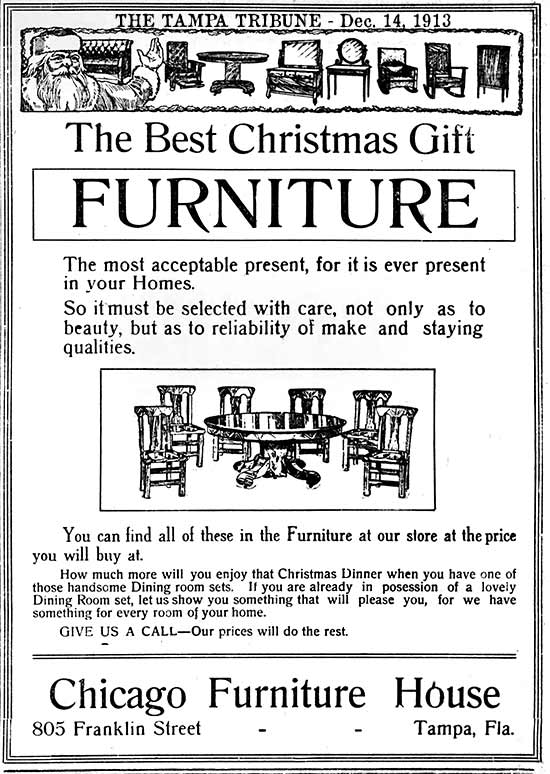
In a
surprise
move
on
Apr.
11,
1914,
Bill
Frecker
announced
his
candidacy
for
a
seat
on
the
Board
of
Public
Works.
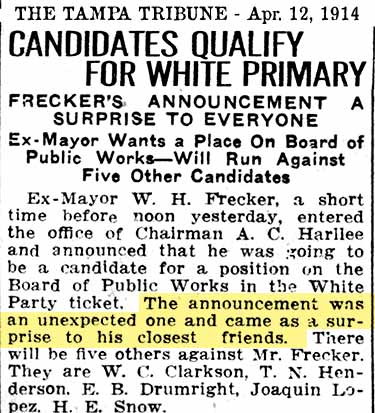 |
Bill
Frecker
ran
his
Chicago
Furniture
House
from
805
Franklin
St.
with
his
son, Charles
T.
Frecker, and
his
half-brother,
Charles
A.
Frecker.
Business
was still booming
for Hotstuff
Frecker. Here
he
was
awarded
the
contract
for
the
new
Centro
Asturiano
club
house.
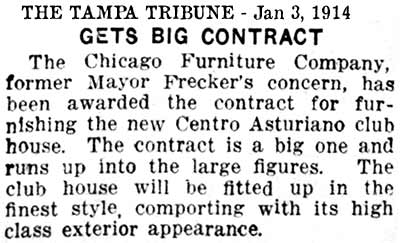
Chicago
Furniture
House
furnished
the
Criminal
Courtroom
at
the
Hillsborough
Co.
Courthouse
in
April,
1914.
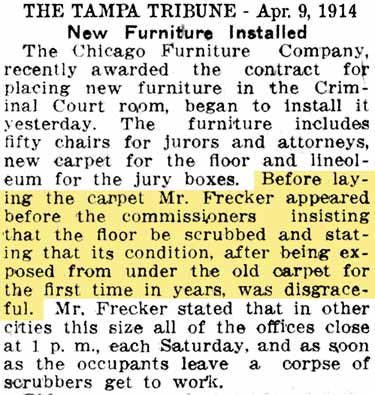
|
|
BILL
FRECKER
SERIOUSLY
ILL,
RUNS
FOR
BOARD
OF
PUBLIC
WORKS |
|
Former
Mayor
Frecker
was
taken
to
the
Halycon
hospital
on
Apr.
16
to
undergo
a
serious
operation.
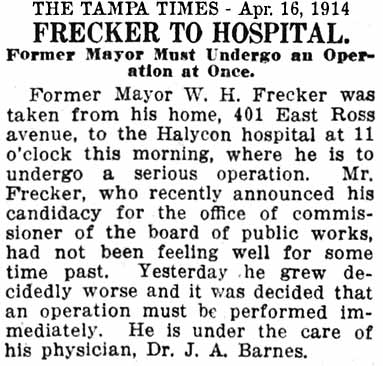 |
He
had
not
been
feeling
well
for
quite
some
time
and
felt
much
worse
on
the
15th
when
it
was
decided
he
needed
surgery.
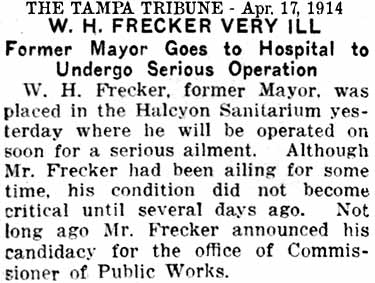 |
|
On
the
18th
it
was
reported
that
he
was
steadily
improving
after
his
operation,
but
the
cause
of
his
illness
was
yet
to
be
stated.
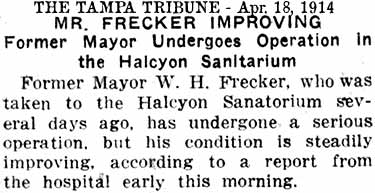
At
right:
The
Tribune
endorsed
Frecker
as
the
best
candidate
for
a
seat
on
the
Board
of
Public
Works,
having
been
a
City
Council
member
and
Mayor,
stating
"...and,
with
all
the
criticism
that
has
been
directed
at
him
in
his
official
capacities,
it
has
never
been
shown
that
he
was
other
than
a
faithful,
honest
and
diligent
public
servant."
It
further
states
that
his
illness
should
be
no
reason
that
he
should
not
receive
the
support...a
citizen
who
will
add
strength
to
the BPW
and
will
prove
to
be a
valuable
and
efficient
co-laborer.
|
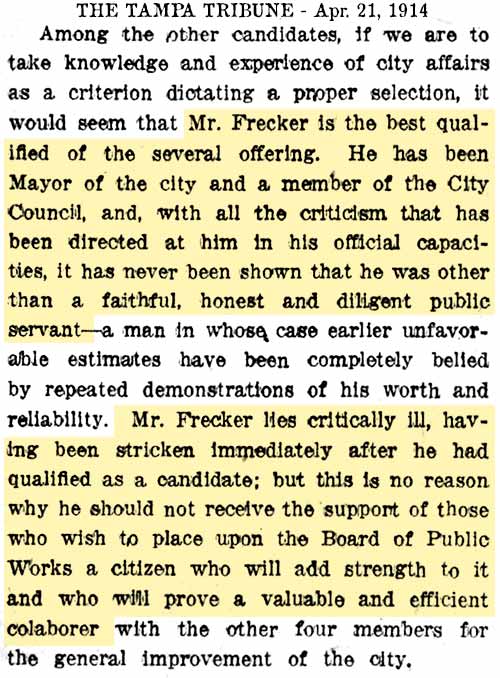 |
|
Apr.
22,
1914
-
The
Tribune
reported
that
Frecker
was
confined
at
the
hospital
and
was
dying,
having
had
an
attack
of
appendicitis,
and
the
doctors
had
given
up
all
hope.
It
seemed
he
would
recover
a
few
days
before,
but
his
heart
was
weakened
since
then.
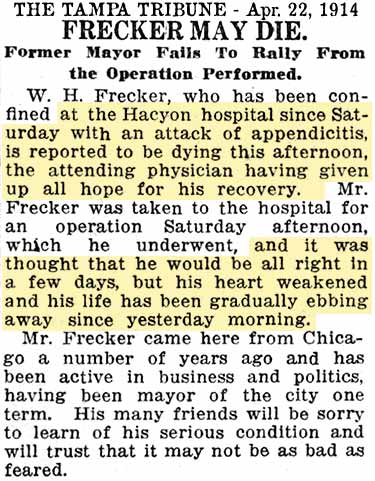 |
On
the
same
day,
the
election
results
were
published
showing
Bill
Frecker
came
in
5th,
just
missing
a
seat
on
the
BPW
by
264
votes.
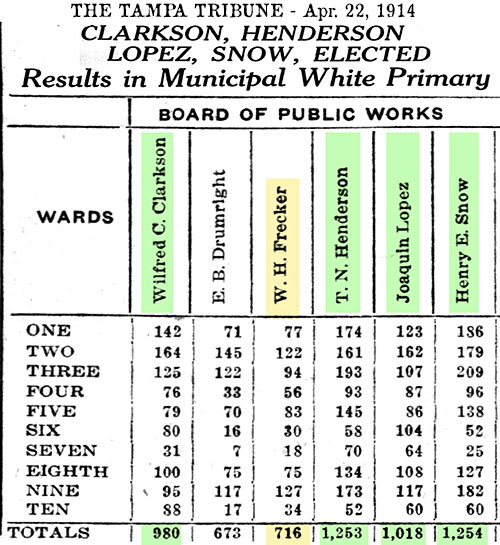 |
| |
|
| |
|
|
|
|
|
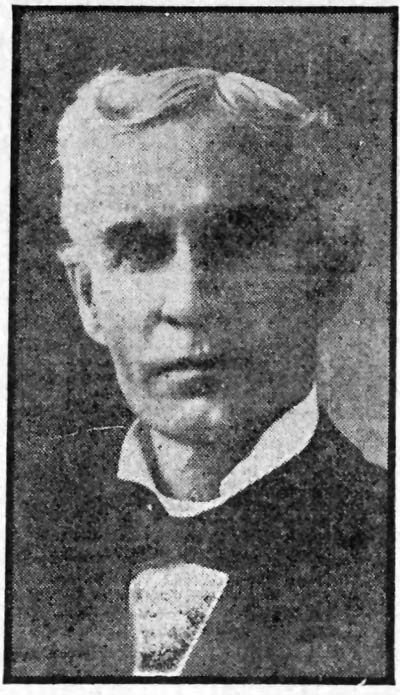 DEATH
OF FORMER MAYOR WILLIAM H.
FRECKER DEATH
OF FORMER MAYOR WILLIAM H.
FRECKER
William Herbert Frecker died on April 22, 1914 after an operation for an abscessed liver.
At the time he had entered the race for a seat on the Board of Public Works but
it is believed his confinement to bed in the brief ten day period of his illness
led to his narrow defeat.
One of the most
important events that
took place during Mayor
Frecker's administration
was the annexation of
the Fort Brooke
municipality, which
until then was its own
incorporated area
comprised of the land
south of Whiting Street.
Fort Brooke residents
fought "tooth and nail"
against annexation,
hiring a "legal dream
team" which included
Hugh Macfarlane, John P.
Wall and others. "He was a man of rather
aggressive disposition,
but with a stern sense
of honor and loyalty to
his friends."
At the
time of his death, his wife was
described as having been "almost an
invalid for many years..." She was
mentioned briefly in the trial of her
son, Charlie Frecker in 1901 when one of
the defense attorneys said he would not
bring up the subject of Charlie's mother
as a means of promoting pity on Charlie
from the jury.
Among his
survivors, other than his immediate
family, are his
half-brother, Charles A. "Bert" Frecker, a sister
Mrs. J. (Maria J. Frecker) White in Canada, a half-sister
Mrs. W.F. (Emily Frecker) Copp in Canada, and a
half-sister Mrs. L.B. (Nina L. Frecker) Seavey in Chicago.
"HE WAS
A MAN OF RATHER AGGRESSIVE DISPOSITION"
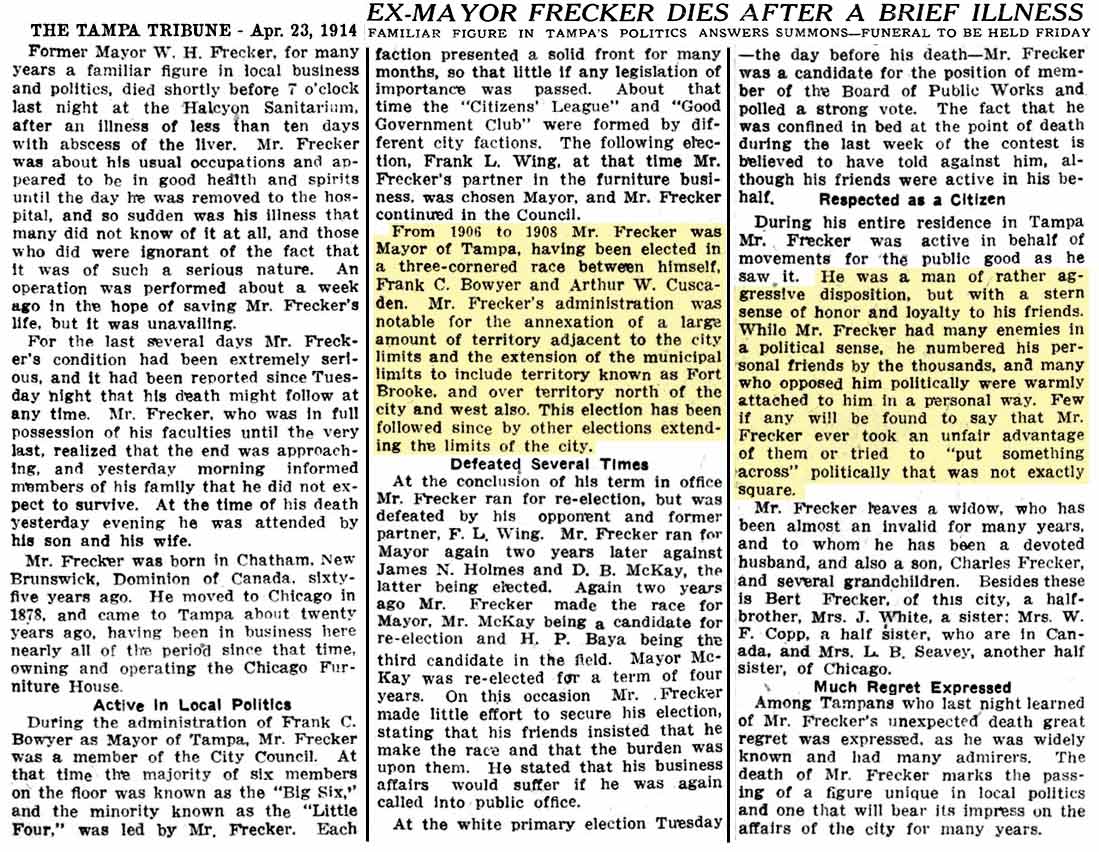
MAYOR FRECKER'S FUNERAL
William Frecker's
funeral was held at his
home in Tampa Heights
and was attended by
hundreds of friends.
Services were conducted
by Rev. Smith Hardin, a
former neighbor, and
Rev. W.E. Thompson,
pastor of the First
Methodist Church.
A funeral procession to
Woodlawn Cemetery was
accompanied by a
detachment of mounted
police and members of
the Knights of Pythas,
who had charge of the
services at graveside.
Hundreds of floral
tributes were piled high
on his grave.
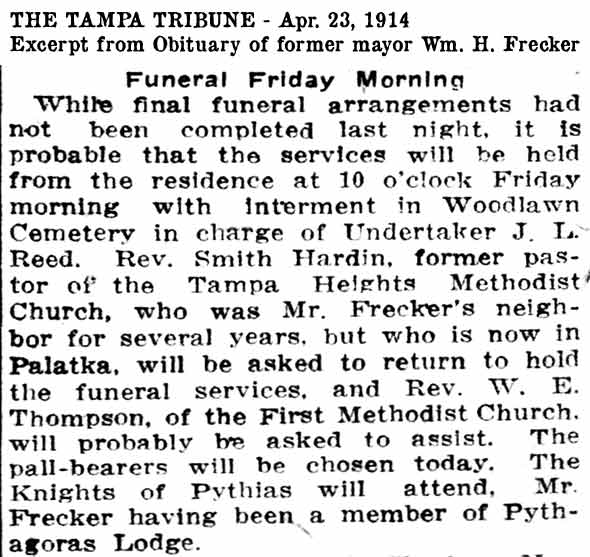
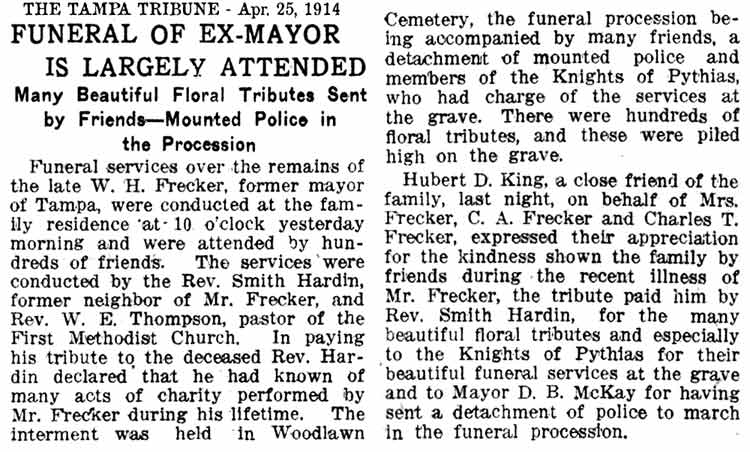
Hubert D. King, close
friend of the Freckers, may be the
source of Charlie T. Frecker's son
William Hubert Frecker's middle name.
|
THE KNIGHTS OF PYTHIAS |
(From their website:
https://www.pythias.org/
) |
|
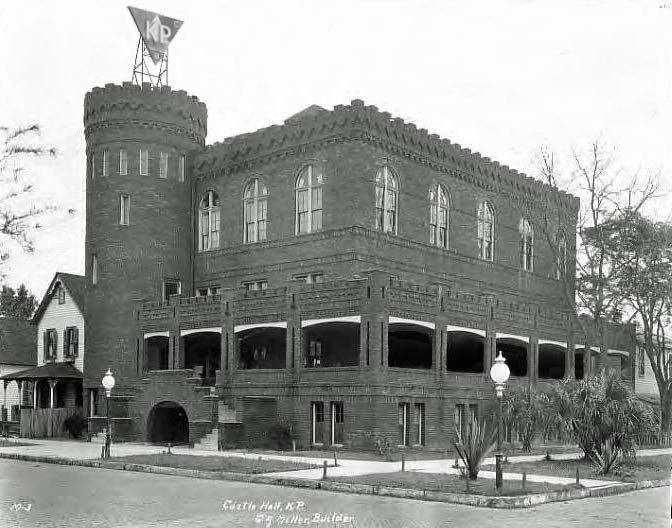
Their lodge in Tampa was
designed by architects
Bonfoey & Elliott and built
in 1918 at the southeast
corner of Lafayette St. and
Morgan St. |
The Order
of Knights of Pythias, a
great international,
non-sectarian fraternity,
founded in Washington, DC,
by Justus H. Rathbone, in
1864, became the first
fraternal organization to
receive a charter under an
act of the Congress of the
United States after careful
investigation by
then-President Abraham
Lincoln.
Our
fraternal order follows
three distinguishing
principles, Friendship,
Charity and Benevolence.
Domains of the Order exist
in most states and
provinces, and subordinate
lodges are located in many
cities and towns across the
United States, Canada and
Europe.
Our order
bases its lessons and builds
it ritual largely on the
familiar story of the
friendship of Damon and
Pythias. These historical
characters lived about four
hundred or more years before
the beginning of the
Christian era. They were
members of a school, founded
by Pythagoras, who was known
as the father of Greek
philosophy. Their loyalty to
each other, the adventures
that beset them, and the
outcome of this noble
friendship, form the basis
for one of the most
beautiful stories of history
as exemplified in our
ritual.
Mar. 1918
Burgert Brothers photo
courtesy of the Tampa
Hillsborough Co. Public
Library system. |
TAMPA TRIBUNE EULOGY OF
WILLIAM H. FRECKER
"After his term as
Mayor, those who had
opposed Mr. Frecker
ceased to deride him as
an agitator and
disturber..."
Well, all except for the
Tribune.
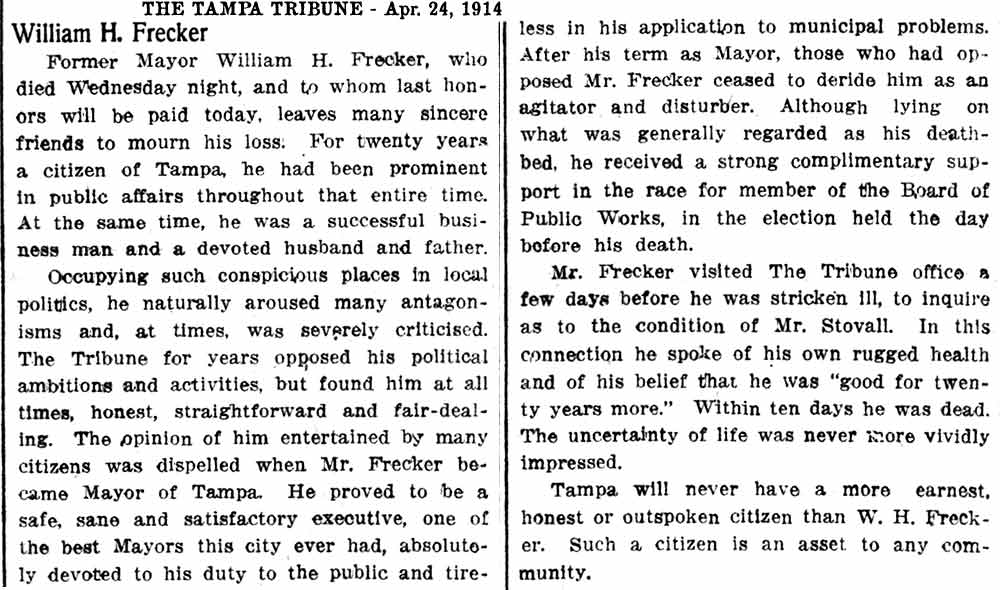 |
|
|
|
CHARLIE T. AND CHARLES
A. FRECKER ELIMINATING
COMPETITION IN TAMPA
One month after Bill
Frecker's death, Chicago
Furniture House bought
the inventories of two
bankrupt furniture
retailers--the Voglesang
store and the Havana
Furniture Co., both in
Ybor City. A week
later, they held a huge
sale at the former
location of the Havana
Co. store at 1515 E. 7th
Ave.
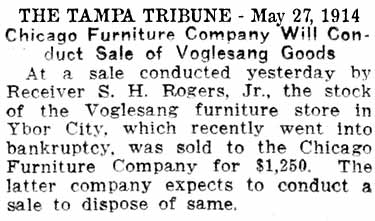
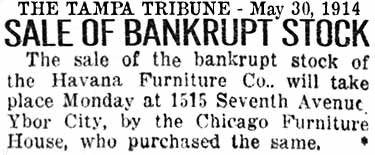
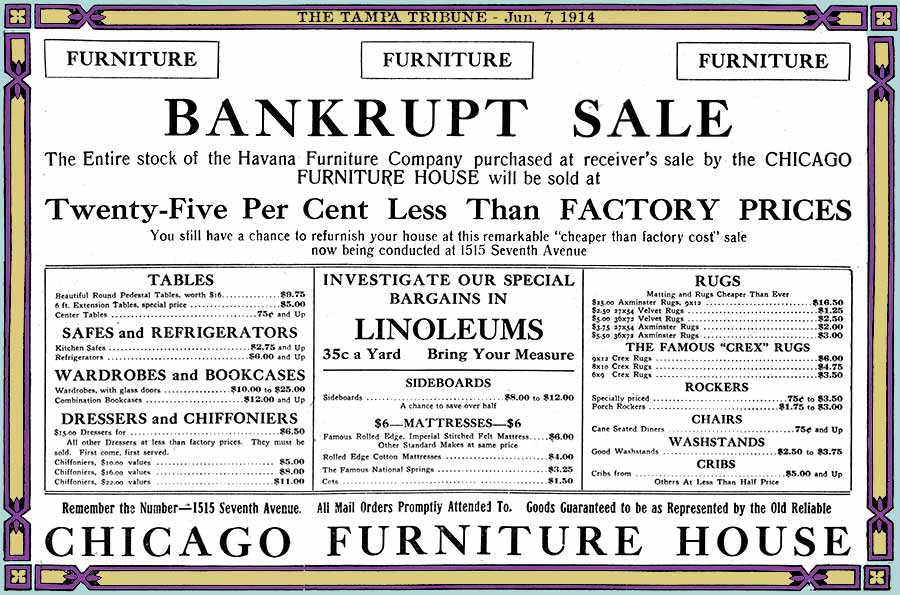
Color has been added to
the ad.
CHARLIE FRECKER NAMED TO
STATE BOARD OF HEALTH
|
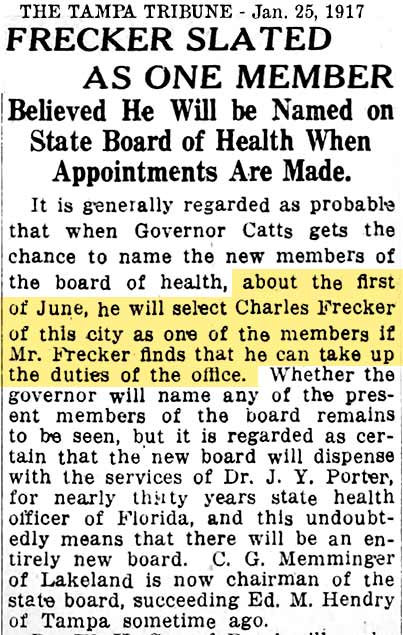
MARGARET
FRECKER HOSTS PARTY
Below: Margaret Frecker was
quite the socialite; her
name appeard in the papers
almost daily in the social
news section, but almost
always in a list of others
who attended an affair or
were on some committee.
Not very often was she the
subject of an article.
Here in this May 1, 1921
article, she was described
as "the attractive young
daughter of Mr. & Mrs. C.T.
Frecker" and the hostess of
a party given at the home of
her grandmother, the widow
of Mayor Frecker.
Margarat would have been
around 15 years old at this
time.
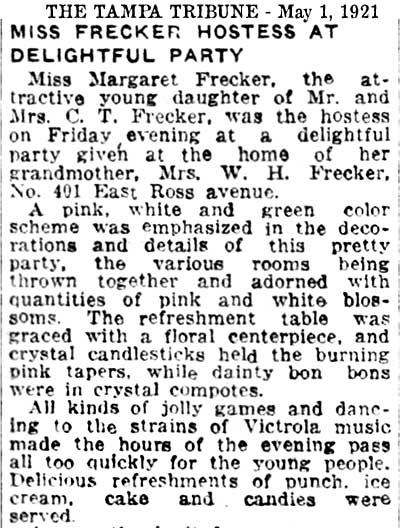
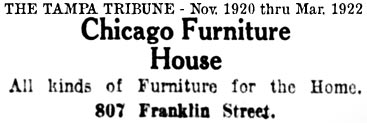 |
It's not known what
experience or credentials
Charlie Frecker had in the
realm of the medical or
health profession; the
appointment seems to come as
a political reward, possibly
he supported Gov. Catts in
his election. He was
sworn in on Jun. 5, 1917 and
soon was elected as chairman
of the board in
mid-December.
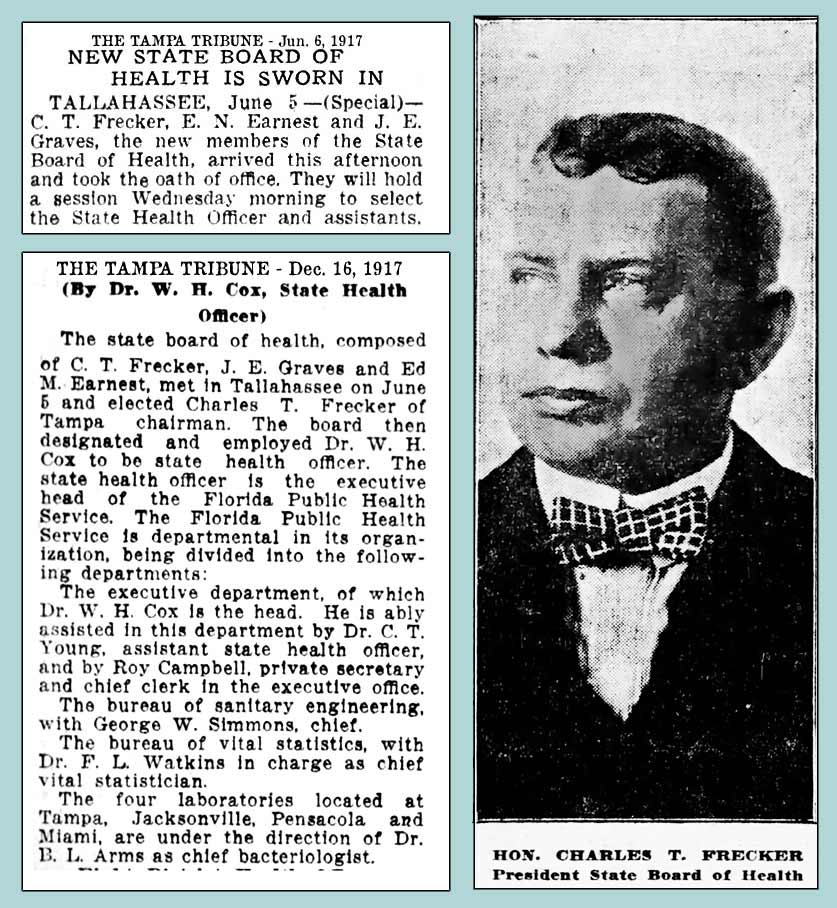 |
|
In Sep. 1917
Charlie Frecker, Pres. of
the State Board of Health,
Dr. Rollin Jefferson and
James McGucken, started the
"Anti-Slacker Club,"
the purpose of which was to
help federal authorities
track down illegal WW1 draft
evaders. The
headquarters was at his
Chicago Furniture House at
807 Franklin St.
Anyone could join the club
and there were no dues or
fees. Three books were
maintained for membership,
one was for members to enter
the names of men they knew
of who had filed false
exemptions for the draft and
other related information.
The books were available for
inspection by members of the
various exemption boards,
their attorneys and Federal
officials.
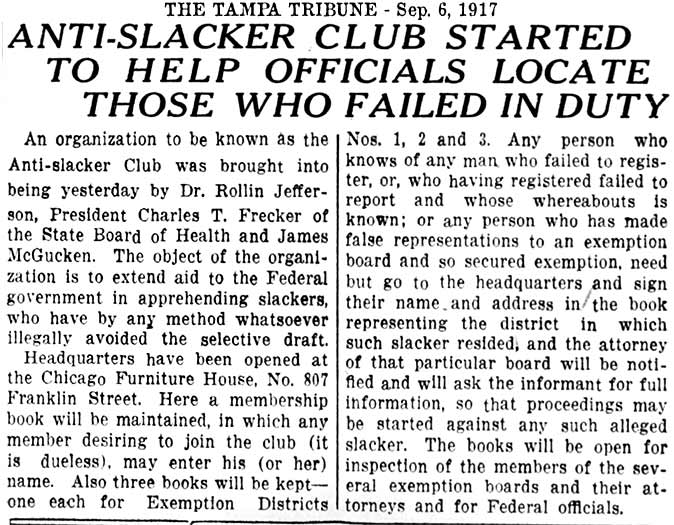 |
|
In 1920
the Freckers were living at
501 Argyle St.
Charles was owner of Chicago
Furniture House, which was
still located at 807
Franklin St.

The
official
date of
the 1920
Census
was Jan.
1, 1920,
so
unless
someone
was born
on Jan.
1, they
would
turn a
year
older
that
year.
By
adding 1
to their
age on
the
census
then
subtracting
from
1920,
you
would
have
their
birth
year,
assuming
their
age was
accurate.
|
| |
|
CHARLIE FRECKER ARRESTED, CHARGED
WITH BREAKING & ENTERING AND ASSAULT,
FEB. 1923
These
are all very long articles, so only
the start of them are shown here.
Click each one to view the full
article. Most browsers first
shrink the image to fit entirely on
your screen, clicking again will
show it at full size.
No
attempt will be made at summarizing
these articles--they are complicated
and difficult to interpret just who
is saying what and in whose favor.
What's clear is the outcome.
It was a frame-up job by his
political enemies.
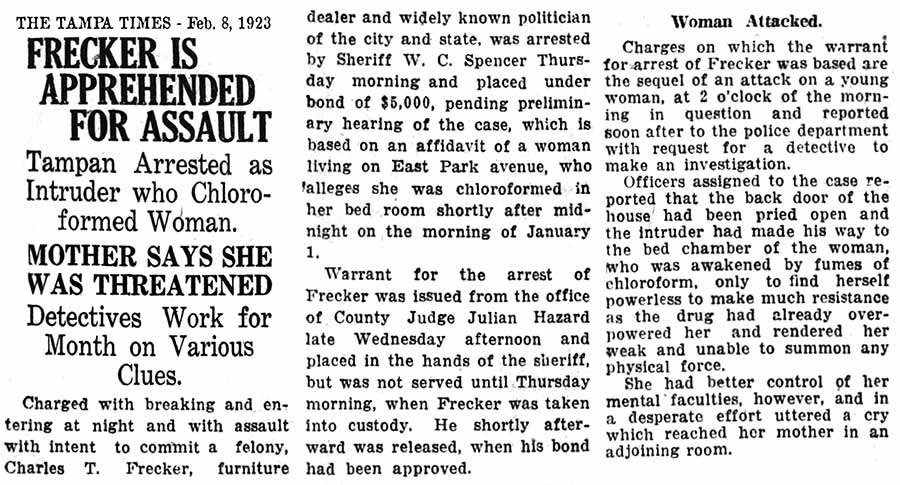
Who
goes out in their slippers, and
often enough, and them being unique
enough, so that others can identify
them as belonging to a certain
person?
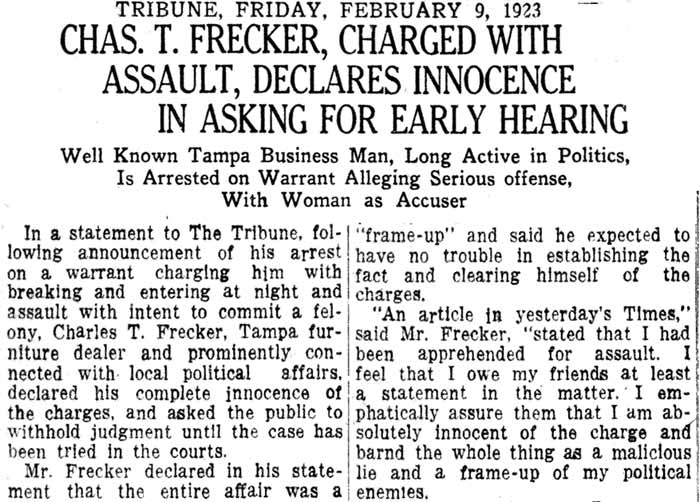
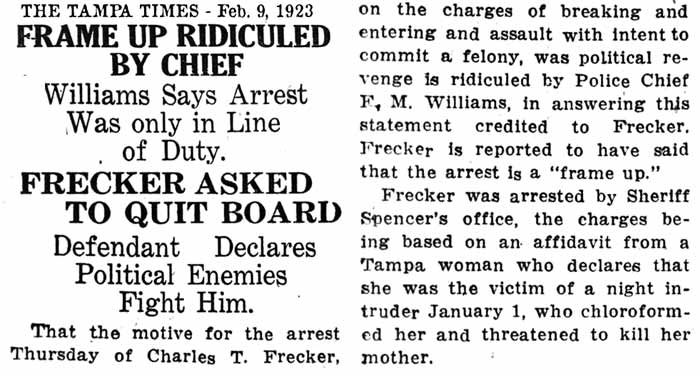
CLICK THE ARTICLES ABOVE TO SEE THE
ENTIRE ARTICLES
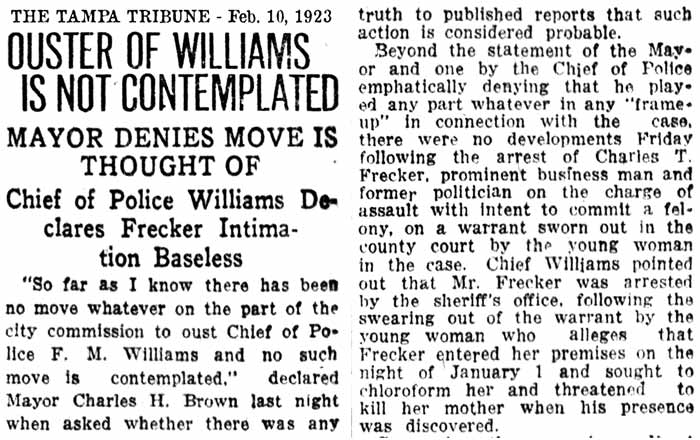
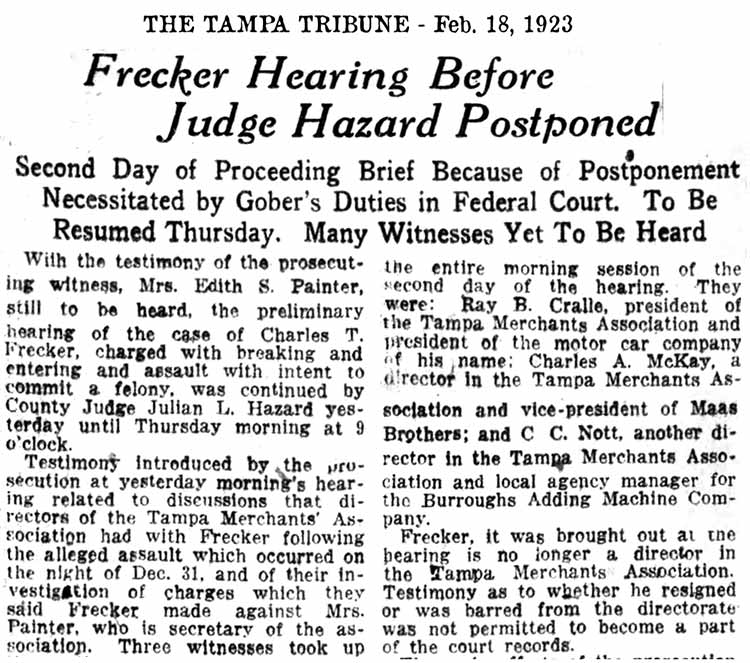
CLICK THE ARTICLES ABOVE TO SEE THE
ENTIRE ARTICLES
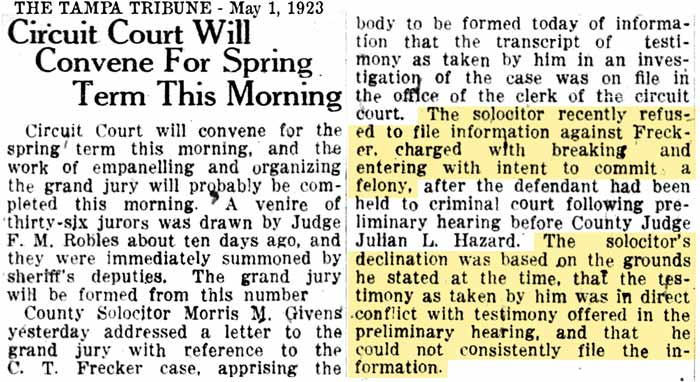
Judge
Robles
told the
Grand
Jury it
wasn't
their
duty to
investigate
this
type of
case,
Tampa
had a
criminal
court
and
prosecuting
attorney
for such
matters.
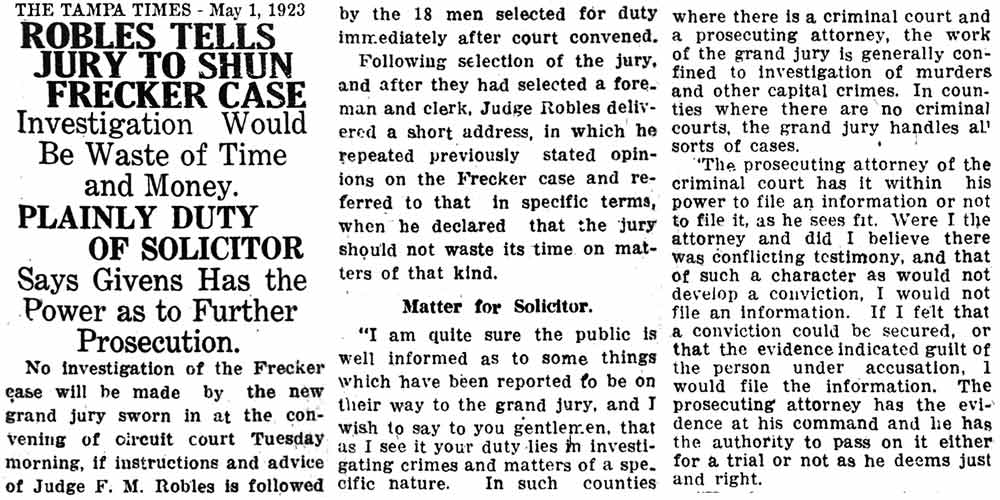
CLICK THE IMAGE ABOVE TO SEE THE
ENTIRE ARTICLE

The charges were
never prosecuted because the
plaintiff's testimony was full of
inconsistencies, kept changing and conflicted
between the woman and her mother.
The anonymous letter Charlie Frecker
received regarding the "immoral
behavior" of Miss Painter, a
Merchants Assoc. secretary, may have
been bait to lure
Charlie into taking action that
would open the door to an easy
frame-up.
THE END FOR CHICAGO FURNITURE HOUSE
- BANKRUPTCY
Although the case against Charlie
Frecker was never prosecuted, it appears
to have had a negative impact on his
business. He may have also
spent a
considerable amount on an
attorney for his defense.
But
his legal troubles weren't over.
|
Charlie
Frecker and his uncle,
Charles "Bert" Frecker,
were sued by Lucy Cheney
who was apparently a
wealthy woman from
Asheville, New
Hampshire, and visited
Tampa regularly.
She was in the news in
1923 quite often, in the
society section, once
for a sailing trip she
took from NYC to Rio,
Montevideo, Buenos Aires,
Panama, Cuba and various
other places. She
came to Tampa often and
would stay at the Tampa
Bay Hotel or the
Hillsboro Hotel. |
|
WHEN IT COMES TO MIDDLE
INITIALS, THE TRIBUNE
CAN'T BE TRUSTED.
In early June 1923 she
filed a lawsuit against
Charlie T. Frecker and
his uncle, Charles F.
(A, not F.) Frecker
for "distress." |
Charlie Frecker and his
uncle are accused of
bankruptcy fraud by six
furniture supply
companies claim that in
the past four months
they transferred a large
sum of money to one
creditor with intent to
prefer them over the
other creditors.
|
Charlie and his uncle,
as Chicago Furniture
House, are declared
bankrupt on Nov. 22,
1923 and a meeting for
creditors to present
claims was scheduled for
Feb. 28, 1924 at the
First National Bank
building. |


She apparently won and
the entire stock of
Chicago Furniture was
levied upon by the
Sheriff. Here also
is seen that Charlie was
in business with his
uncle, Charles A.
Frecker.
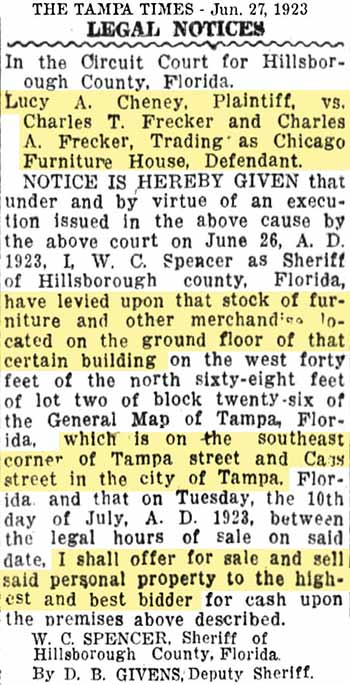 |
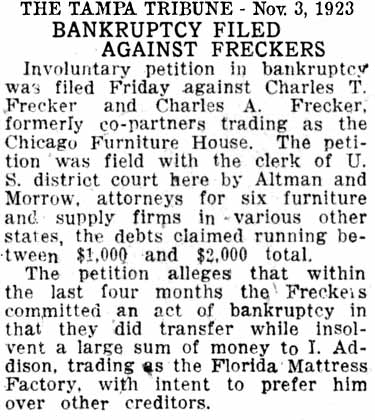
A few
months after Lucy
Cheney's successful
lawsuit against Frecker,
she and Maud Fowler had
their Orange Hotel
remodeled.
Probably furnished with
items acquired at
bargain prices from her
lawsuit. Fowler
was one of the major
developers of Temple
Terrace at this time, as
well as the namesake of
Fowler Avenue.
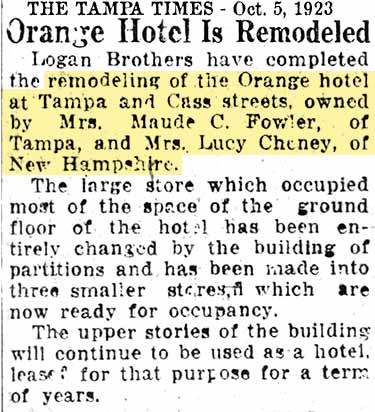 |
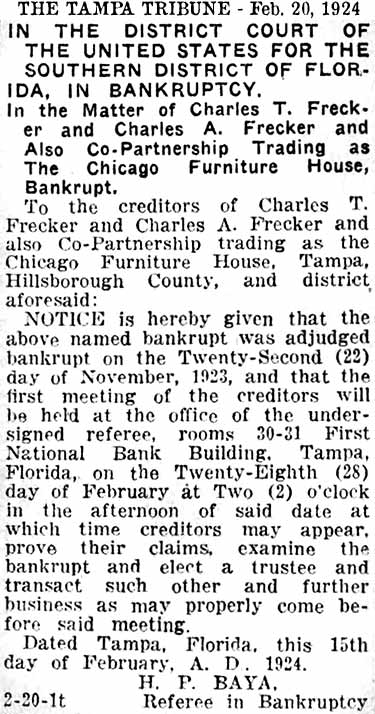
The
Orange Hotel or Hotel
Orange was NOT the
historic Orange Grove
Hotel which was
located near the east
end of Lafayette St.
Between
1923 and 1925 during the
land boom, Temple
Terrace streets were
paved, storm sewers
installed, and a well
was drilled to tap
spring water. On May 25,
1925, the City was
incorporated, with D.
Collins Gillette, one of
the founding developers,
serving as the first
mayor, and Maude Fowler,
serving as vice mayor.
Gillette was a son of
former Tampa Mayor Myron
Gillette. |
THE FRECKER TRIPLETS BACK TOGETHER
This article of Mar. 30, 1927 tells
of the Frecker Triplets; Billy Frecker's return from law
school at UF. When he left to
attend UF, it was the first they had
been apart, having gone through
grade school to high school
together. Ruth and
Grace had obtained jobs as
stenographers at law firms.
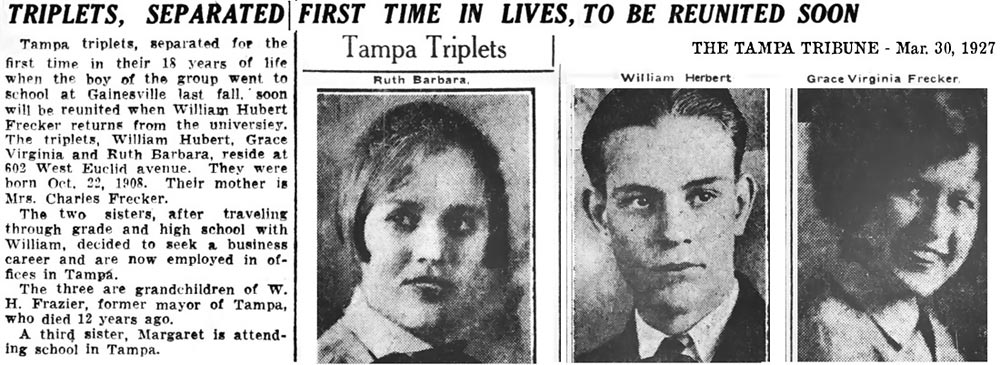
Grandchildren of W. H. FRECKER, not
Frazier. Mayor Frecker's middle
name was Herbert, not Hubert.
If Billy was named for his grandfather
his middle name would also have been
Herbert.
1930
CENSUS, TAMPA
The Freckers were living
at 602 Euclid Ave in their home with a
$65/month mortgage. Charlie's
middle initial is incorrect.
Charlie was 50 and working as a car
foreman for the railroad. His wife
Margaret was 48. All their
children were still single and living
with them, as well as Charlie's widowed
mother, (Barbara) Ruth, who was 78.
About thirty years prior, she was
described as "practically an invalid."
All the Frecker daughters were working
as stenographers, Marguerite with a
concrete co. and Grace & Barbara with a
law office. William was not
employed.

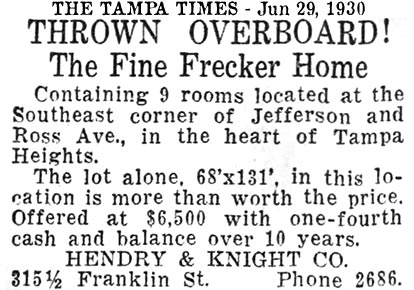
|
MARGARET
L. FRECKER |
|
|
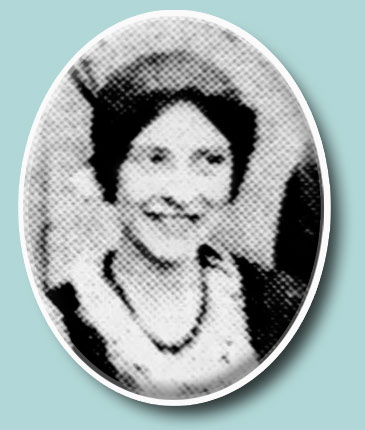 |
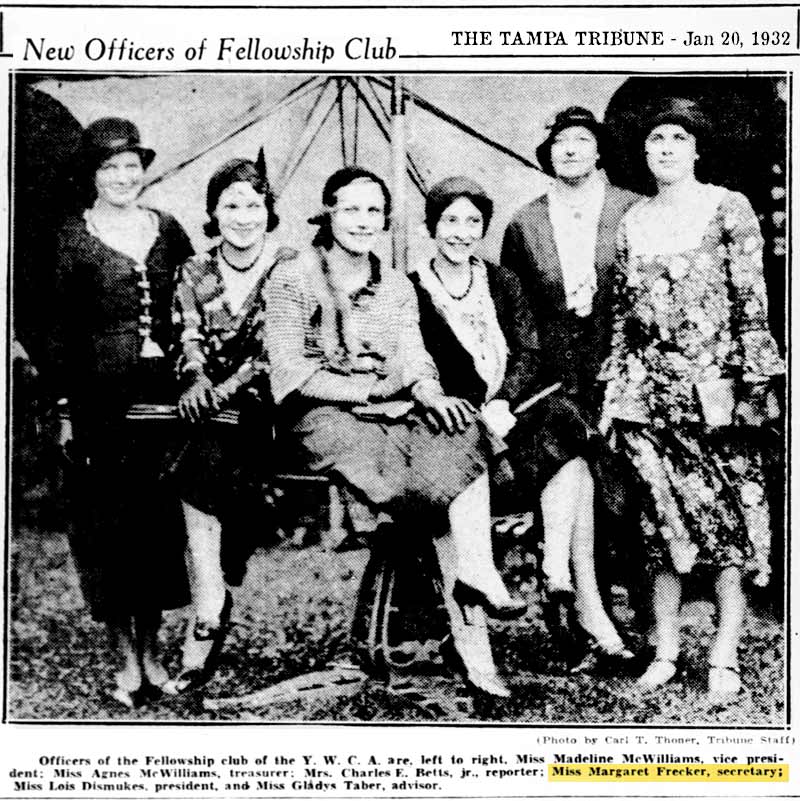 |
|
Charlie & Margaret's
daughter, Ruth Barbara Frecker,
married William Blanton Smith son of Mr.
& Mrs. R. M.
Smith, on Mar. 27, 1930 in Clearwater. By Sept 1933.
Mr. Smith worked for Electrical Construction
Co and left for Atlanta to be joined
by wife where they planned to live. |
RUN ON THE BANKS AND THE
GREAT DEPRESSION IMPACT W.H.
FRECKER'S TRUST FUND
In June 1930, the four
Frecker children filed a
lawsuit against Citizens
Bank for mismanagement of
their trust fund set up by
their grandfather, Mayor
Bill Frecker. Mayor
Frecker's will placed $4,000
in trust at the bank, to be
paid equally to his four
grandchildren when the girls
turned 18 and Billy turned
21. Margaret turned 18
on Aug. 18, 1924, and the
other two girls turned 18 in
Oct. 1826. Apparently,
the bank closed on July 17,
1929, at which time the
heirs made demand for a pro
rated share of the trust.
But the bank paid them with
bonds from the Citizens
Mortgage & Bond company
stating this is where their
trust had been invested.
The Freckers alleged that
this company was a dummy
company, owned by the bank,
and the rules of the court
say a trustee cannot lend
money to itself by investing
in bonds of a subsidiary
company. Other
allegations were made,
including that the funds
were invested in the "Bostain
Hotel" in 1921 and that was
the last notice they
received before the bank
closed. The suit
claims that aside from
$1,000 paid to Ruth Frecker
three months before the bank
closed, they have received
nothing. |
|
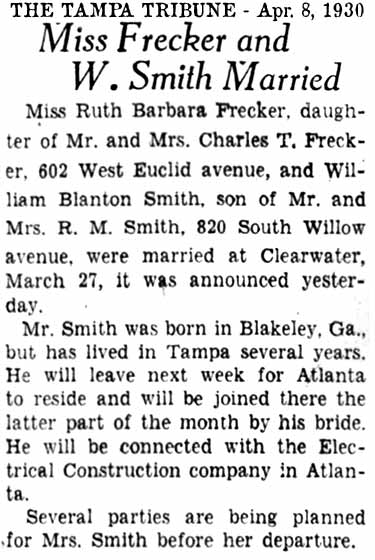 |
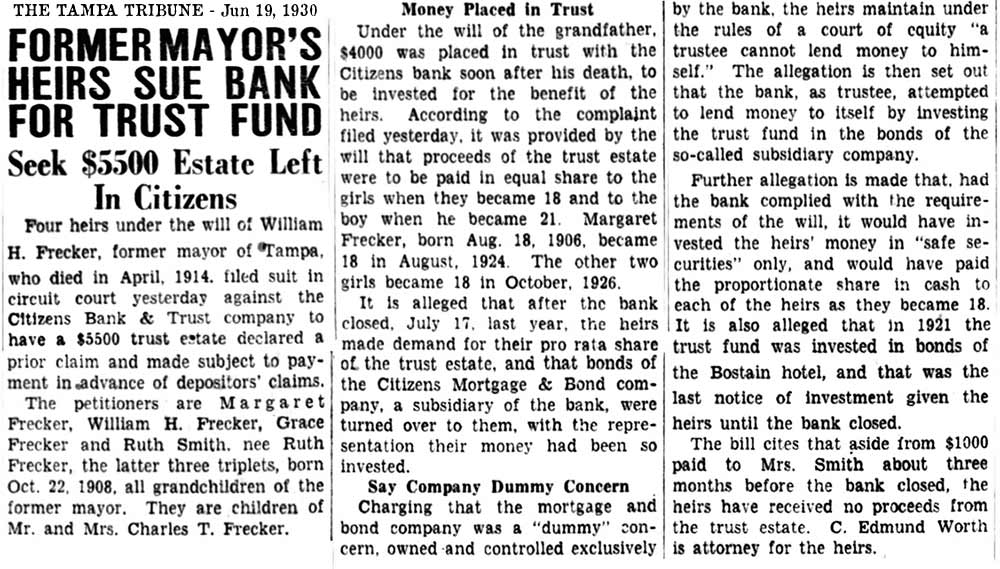 |
DEATH OF BARBARA TATE FRECKER
Mayor Frecker's widow, Barbara Tate
Frecker, died at the home of her son
Charles at 602 Euclid Ave. in Tampa on
Sep. 13, 1933. She was 81.
She was survived by her son,
daughter-in-law, her four grandchildren:
William H. Frecker, Misses Margaret and
Grace Frecker, and Mrs William Blanton
Smith (Ruth Frecker),
and one great-grandchild.
1935 FLORIDA CENSUS
This
census shows Charlie and Virginia
Frecker still at 602 Euclid in
Tampa, with children William, Grace, and
Margaret single and living with them.
But the right side of the page is torn
off so Charlie's occupation has been
lost.

An April
20, 1935 article in the Tampa Tribune
lists Margaret
Frecker as a secretary
at Memorial Jr. High. |
|
BILLY FRECKER BEATS TAMPA'S BIG POLITICAL "MACHINE" WITH HELP OF SISTERS 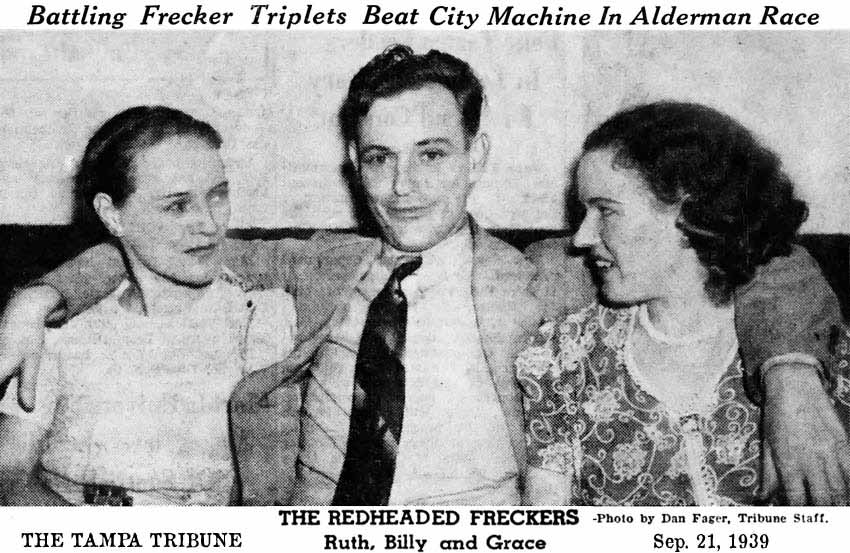
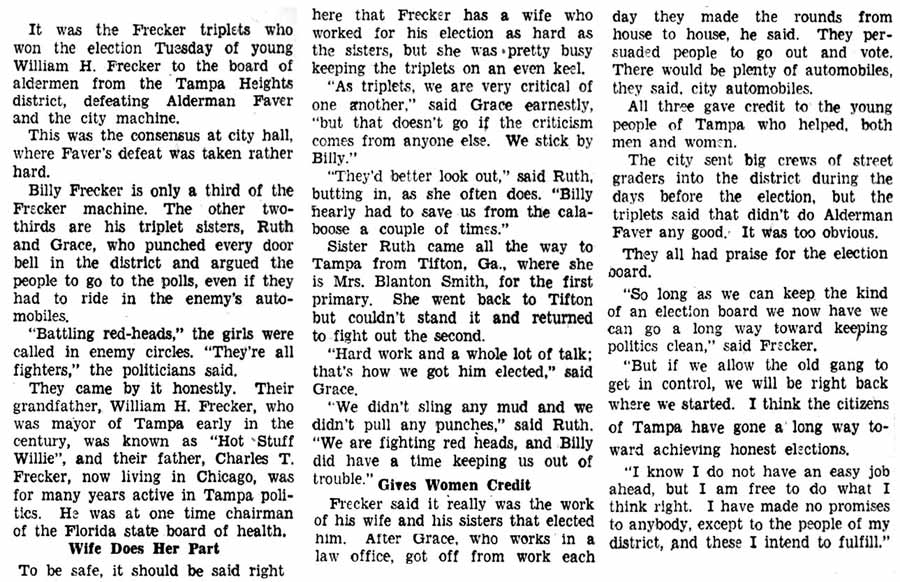
1940 CENSUSES OF CHARLIE AND MARGARET VIRGINIA FRECKER
A short time after the 1935 Census in Tampa, Charles T. Frecker moved to Chicago where he took a job as a
newspaper publishing company circulation
manager. His 1940 census below shows he indicated he was living in the same house on Apr. 1, 1935, at 3927 Wayne Ave. He was 61 and for his marital status, there is a 7 next to the M which is faintly marked through with a slash. It's not known what this means. 
Meanwhile, on the same census, 1940, there is also a strikeout mark and a 7 on Virginia Frecker's marital status. This may mean married but living apart. She and her daughters Grace and Margaret were still living at 602 Euclid. Grace and Margaret were still single, but Margaret would have been 33, not 31. Grace worked as a secretary at a private law office, Margaret was a secretary for the public school system. 
MARRIAGE OF WILLIAM H. "BILLY" FRECKER TO CECELIA MARIE VAN ORDEN
| Cecelia M. Van Orden, a Tampa socialite, was crowed queen of the "Cavalcade of Florida" in 1938. This event was a historical pageant sponsored by the American Legion It celebrated the various stages of Florida's colorful history since the time of the Spaniards arrival. |
William H. "Billy" Frecker, grandson of Mayor Frecker, married Cecelia Van Orden, daughter of Mr. & Mrs. J. W. Van Orden of Tampa, on Dec. 22, 1938 at the Episcopal House of Prayer. It was a small wedding with only the immediate families and a few close friends attending. The wedding came as a surprise to many of their friends, as no formal announcement of their engagement had been made. |
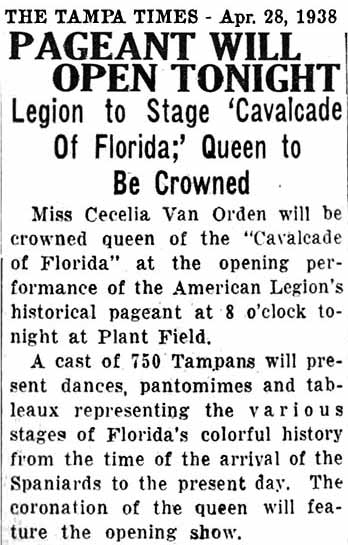 |
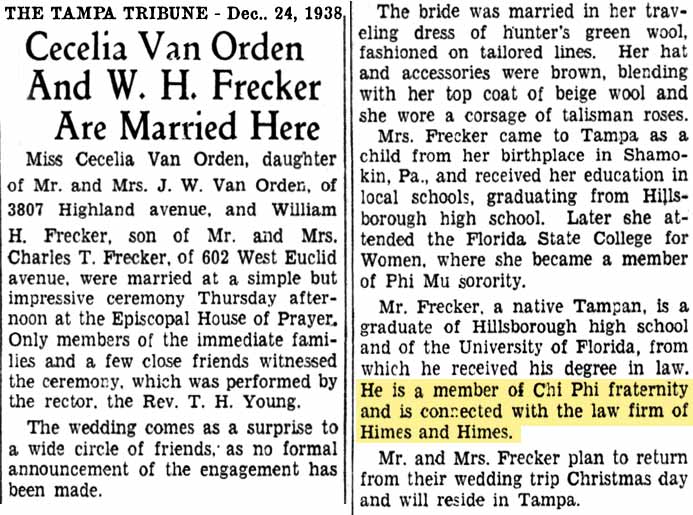
|
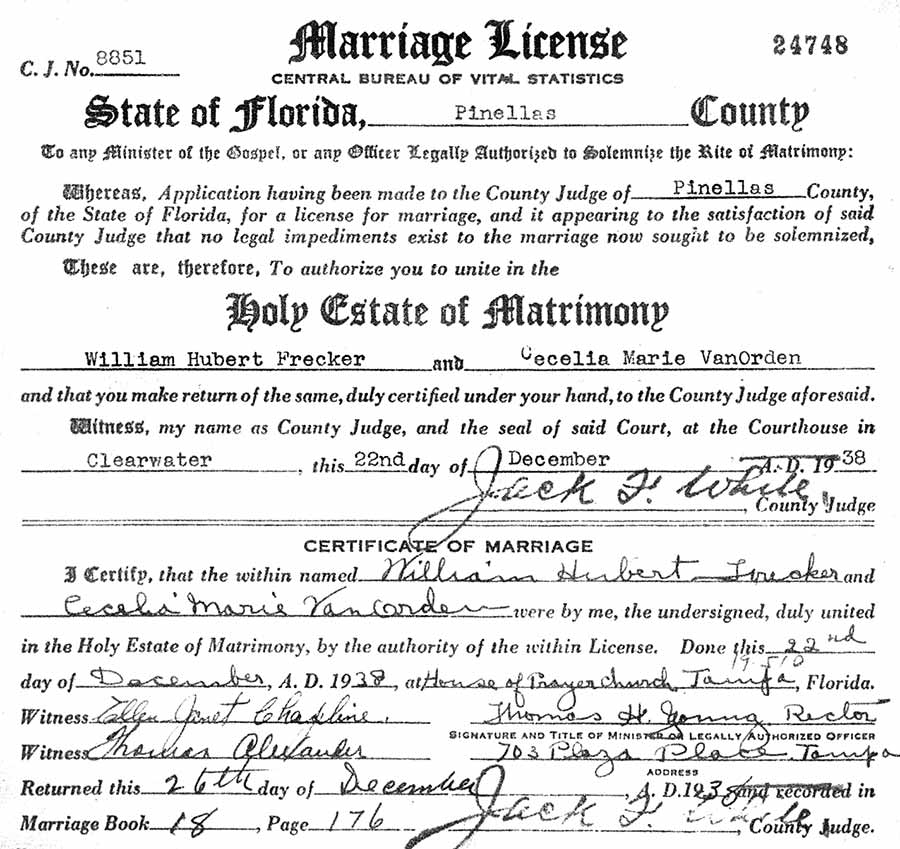
Even
though
their
marriage
license
was
obtained
in
Clearwater,
Pinellas
County,
they
married
in Tampa
on Dec.
22,
1938.
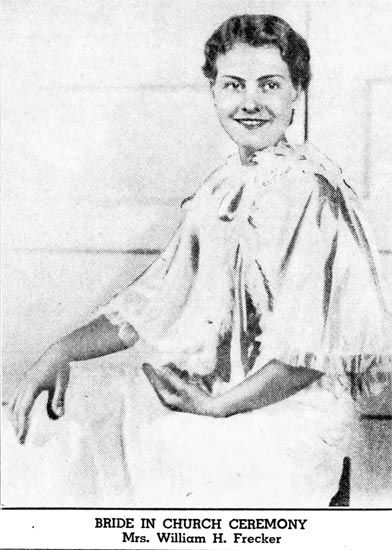
Photo is
from the
above
wedding
article.
| Trudie E. Frecker (middle) and sister Cecelia Ann Frecker (right), children of William "Billy" H. Frecker & Cecelia M. Van Orden. Billy Frecker was a grandson of Mayor Frecker, so Trudie & Cecelia are great-granddaughters of Mayor Frecker. |
|
-&-Cecelia-Ann-(7)-Frecker,-daus-of-M&M-Wm-H-Frecker,-2715-Riverside-dr.jpg) |
On
July 20, 1942 Grace V. Frecker, one of the Frecker triplets,
married Ralph Lynn Holloway in
Gulfport, Miss. It was a
small private wedding with just
a few friends who were former
Tampa residents. After the
ceremony, the couple went to
Wyoming to live, where Mr.
Holloway had been transferred to
by the newspaper he worked for. Grace Virginia Frecker was a granddaughter of Mayor Frecker.
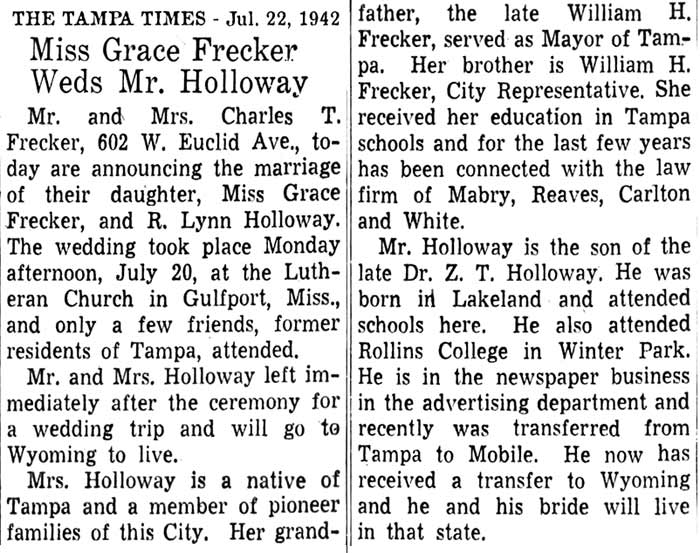 |
Grace's marriage license shows her father, Chas. T. Frecker, was living at the YMCA Hotel in Chicago at the time.
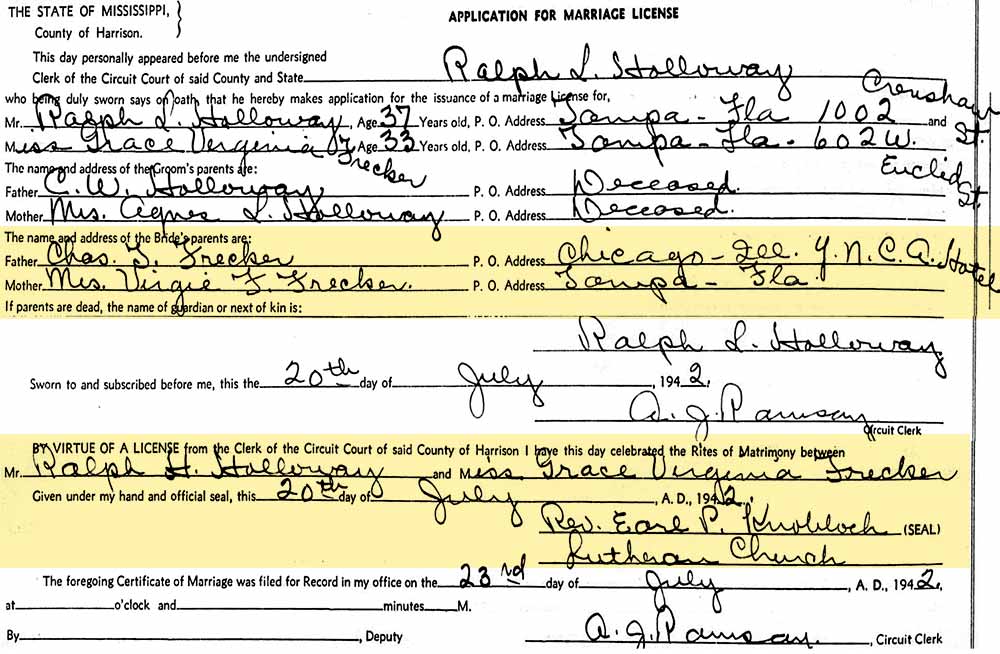

This 1943 job wanted ad by C.T.
Frecker might be Charlie's.
RUTH B. SMITH, AN AMERICAN IN
PARIS
In
1950, Ruth Barbara Frecker Smith,
one of the Frecker triplets, was
living in Paris and working at the American Embassy
as an employee of the
public health service agency.
It's here in Paris where her
daughter, Barbara Frecker Smith, spent the
formative years of her youth.
Ruth had read an issue of the
Tampa Tribune column "Kitchen
Corner" where a letter from a
reader requested a French apple
cake recipe. Ruth asked
her French friends for one and
sent it in. Pictured is
Ruth on the right with her
daughter Barbara Smith, age 17, on the
left. Ruth Barbara Frecker
Smith was a granddaughter of
Mayor Frecker, so her daughter,
Barbara (middle name Frecker)
Smith, was a great-granddaughter
of Mayor Frecker.
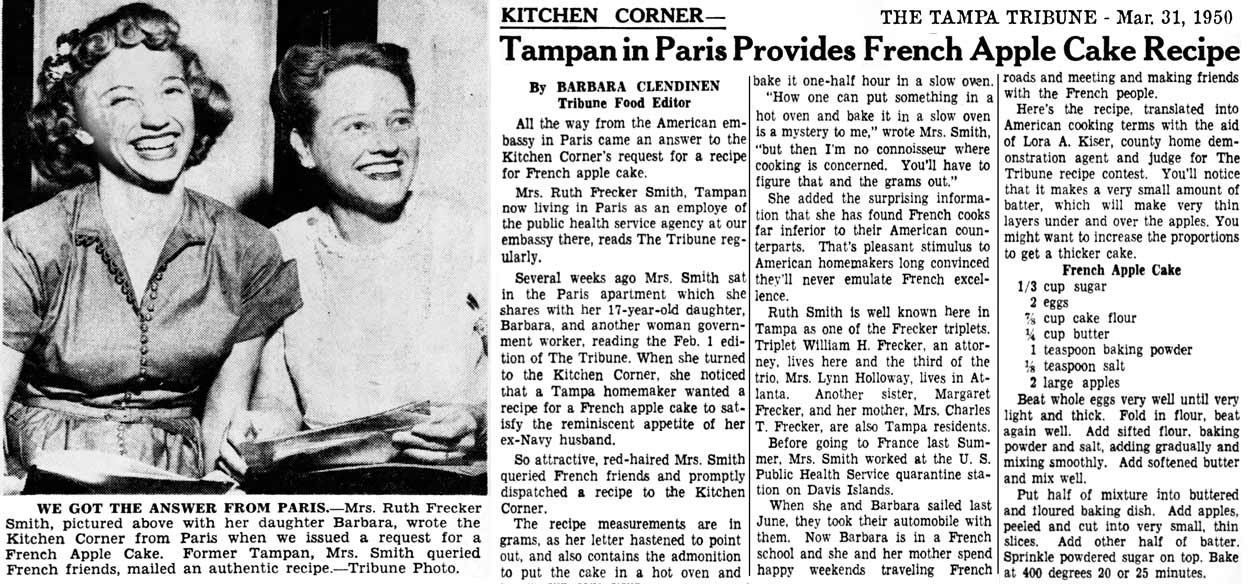
| On Oct. 19, 1955, Billy Frecker received a concussion and possibly fractured ribs when he ran a stop sign he didn't see and was hit broadside by another car carrying a husband and wife with their two month old daughter. Also in the car with Frecker was former Hernando Co. judge Spencer McKenzie, 50, and Mrs. Johnnie Merl Bradley, 27 of Ala. They were on their way to a hearing in Tavares and Mrs. Bradley was probably his client. This was probably what we'd consider today a low-speed collision, as the were the days before seat belts and occupants were usually thrown through the windshield and killed in higher -peed collisions. |
|
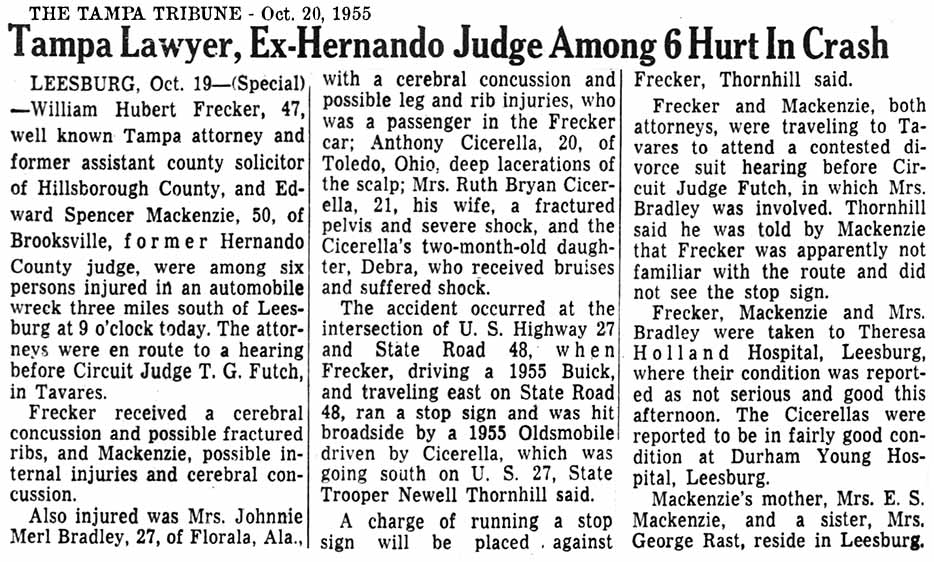
|
|
Great-grandchildren of Mayor Frecker; Trudie E. Frecker & Cecelia Ann Frecker, with their mother Cecelia M. Van Orden Frecker. |
|
|
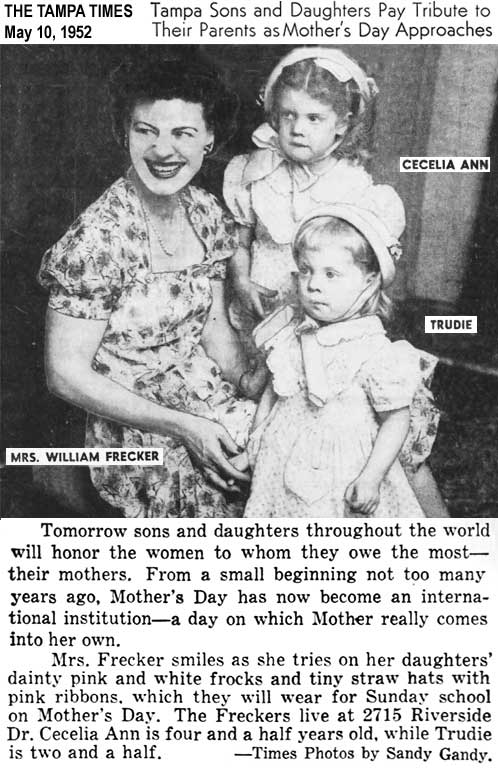
|
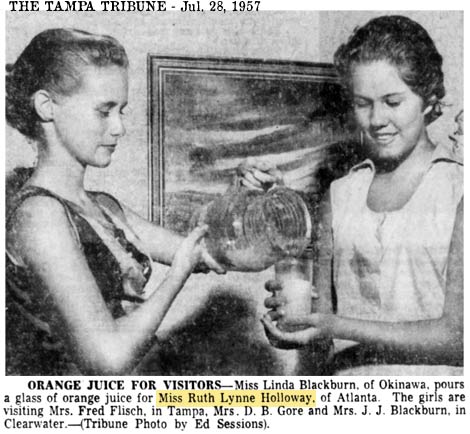
ABOVE: Ruth Lynne Holloway (on the right) is visiting in Tampa from Atlanta. She is a daughter of Frecker triplet Grace Virginia Frecker & R. Lynn Holloway, which makes her a great-granddaughter of Mayor Frecker. |
| DEATH OF MARGARET VIRGINIA FRECKER, WIFE OF CHARLIE
Charlie Frecker's wife, Margaret Virginia Frecker, died in Tampa at age 71 on Apr. 3, 1959. Her surviving granddaughter, Barbara Frecker Jarrett (the woman on the left in the French apple cake article) was the daughter of Ruth Barbara Frecker Smith & William Blanton Smith. Born Barbara (middle name Frecker) Smith, she first married H.R. Jarrett and in 1953 lived in Los Angeles with their newborn son John A. Jarrett. The obit has misspelled Jarrett and misidentified John as Margaret's grandson instead of great-grandson.
|
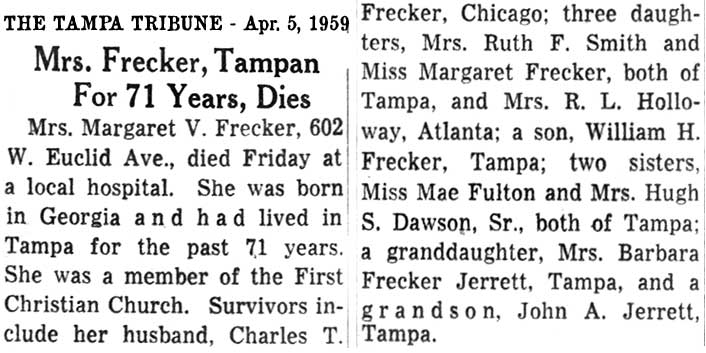
|
|
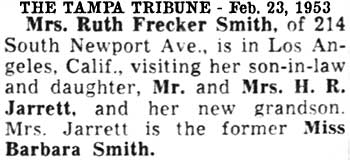
|
This 1953 Tribune article at left says that Ruth Frecker Smith (wife of Wm. Blanton Smith and dau. of Charlie T. & Margaret Virginia Frecker) was visiting her son-in-law and daughter Mr. & Mrs. H. R. Jarrett, in Los Angeles, with Mrs. Jarrett being the former Miss Barbara Smith (the woman on the left in the French apple cake article.) Since Ruth didn't have a son named John A. Jarrett, he must have been the grandson mentioned here, son of Mr. & Mrs. H.R. Jarrett. |
| THE FRECKERS AND TAMPA'S LITTLE THEATER BELOW: The whole Billy Frecker family was active in Tampa's Little Theater; with jobs ranging ticket taking, acting and production. Billy met his wife Cecelia while cast opposite each other in "One of the Family." Their daughters, Ann & Trudie were to play in the upcoming production of "Rip Van Winkle." Mrs. Frecker lately centered on the Children's Little Theater and was a member of the group's committee. |
Billy Frecker's niece, Barbara Smith Jarrett, also was involved with Tampa's Little Theater. Here in 1953 she had a role in "A Midsummer Night's Dream."
Who was Joanne Torretta?
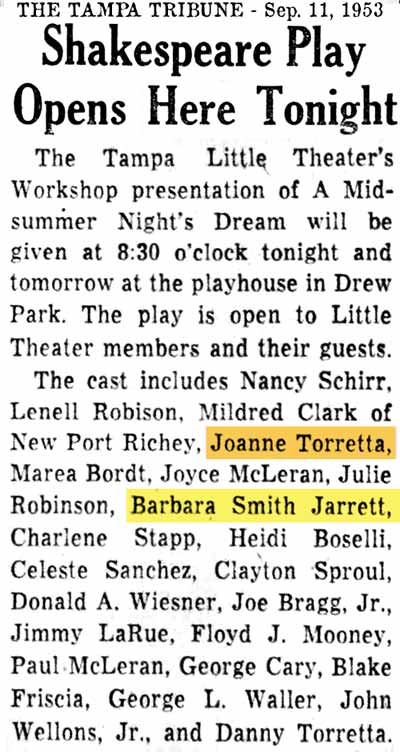
|
|
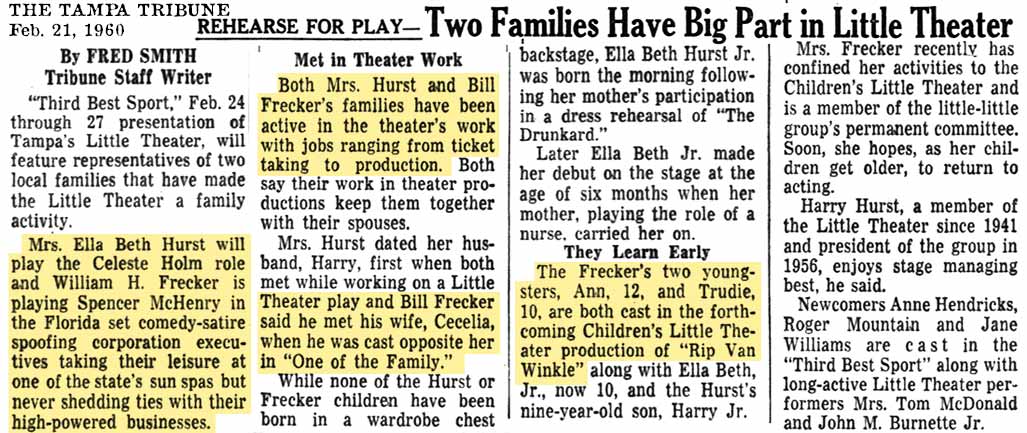
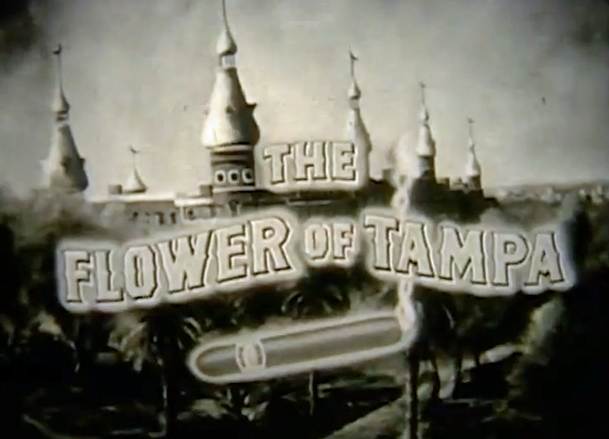 Joanne Torretta was the mother of WFLA Tampa news Channel 8 anchor Gayle Guyardo. In 1958, Joanne played the role of "Maria" in the Tampa Chamber of Commerce film "La Flor de Tampa" (The Flower of Tampa), which promotes Tampa and especially the cigar industry. Rick, the lead character, was played by Tampan Joe Russo. See the the article in the Tribune the day before the film's premiere, and photos from behind the scenes of the making of the movie, as well as links to see the actual film. Here at TampaPix. Joanne Torretta was the mother of WFLA Tampa news Channel 8 anchor Gayle Guyardo. In 1958, Joanne played the role of "Maria" in the Tampa Chamber of Commerce film "La Flor de Tampa" (The Flower of Tampa), which promotes Tampa and especially the cigar industry. Rick, the lead character, was played by Tampan Joe Russo. See the the article in the Tribune the day before the film's premiere, and photos from behind the scenes of the making of the movie, as well as links to see the actual film. Here at TampaPix.
|
MISS MARGARET FRECKER AWARDED
 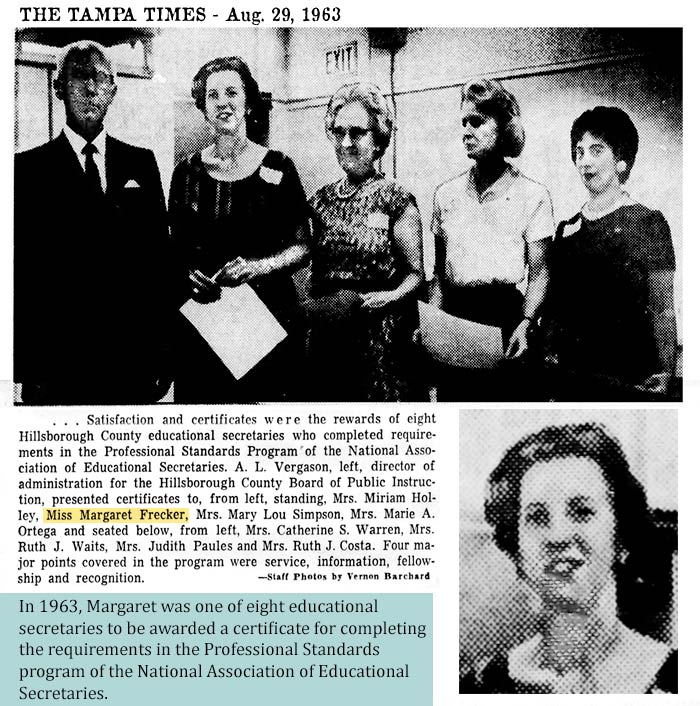
IT'S ALL ABOUT PUG
|
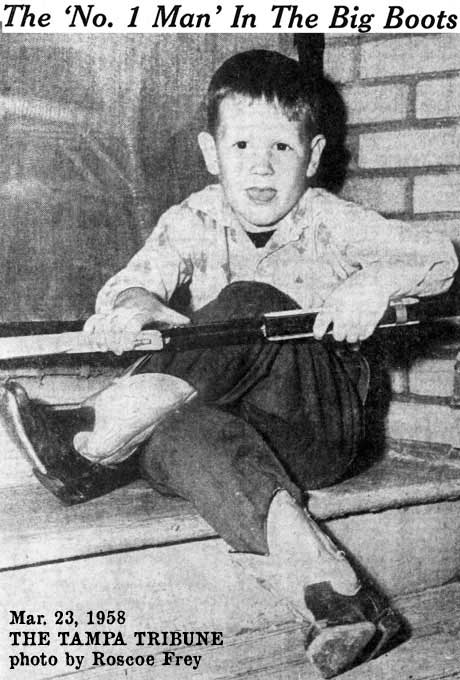 |
John Anthony "Pug" Jarrett, a son of Barbara F. Smith Jarrett & Howard R. Jarrett, is a great-great-grandson of Mayor Frecker.

Read the article that was written with this photo, it's all about Pug.
On Feb. 8, 1964, Margaret L. Frecker (Charlie & Margaret V. Frecker's
first child) married Harry C. McKinnon in Brooksville, Fla. Margaret worked with the Hillsborough Co. school system, she was 58, Harry worked at the Post Office in West Tampa.
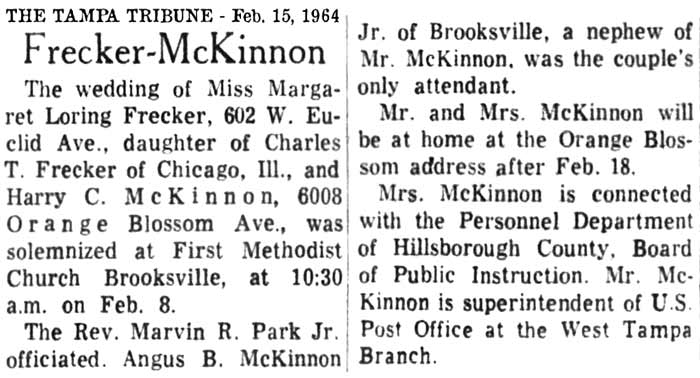
|
| |
|
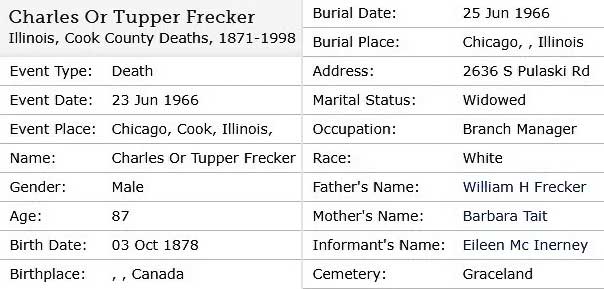
Charles Tupper Frecker died in Chicago on Jun 23, 1966 at age 87 and was buried at Graceland Cemetery in Chicago. The information at right is indexed from his death certificate, but the image of it isn't available online. It shows his occupation was "branch manager." No obituary has been located.
|
|
| Billy Frecker's daughter, Cecilia Ann Frecker, was one of the 1966 Debutantes of the Krewe of Venus, Gasparilla. Cecelia Ann appears in the above "Won't you buy a poppy" and Mothers Day articles. |
|
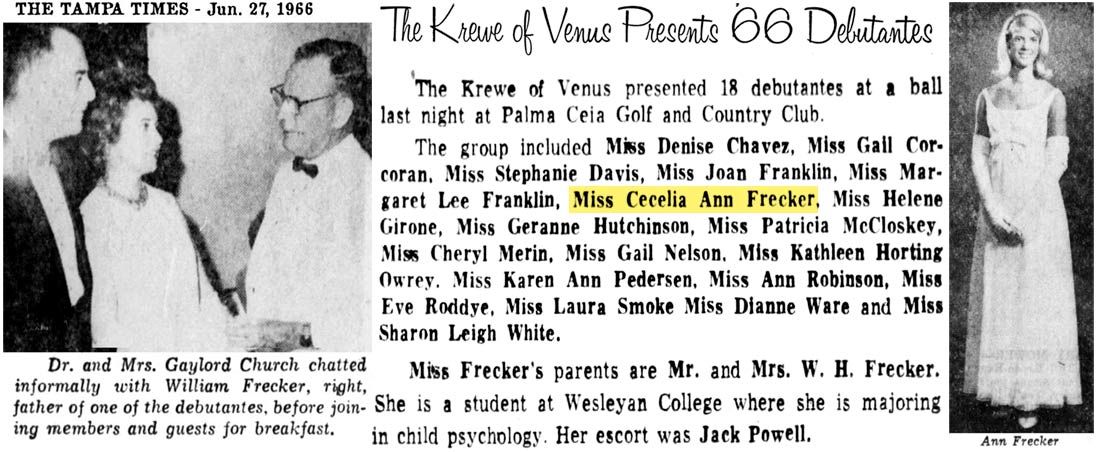 |
|
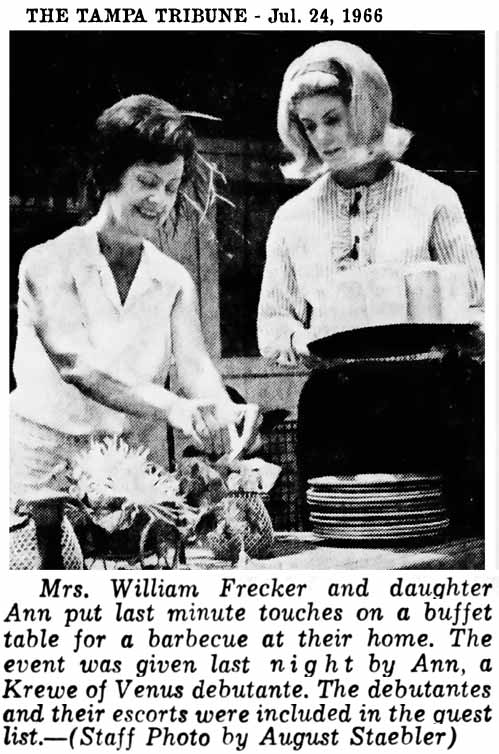 |
AT LEFT: The Freckers were often in the news for various entertainments given at their home, especially events associated with Gasparilla. |
|
Below is Cecilia Ann Frecker again. She was also part of Krewe of Venus in 1967
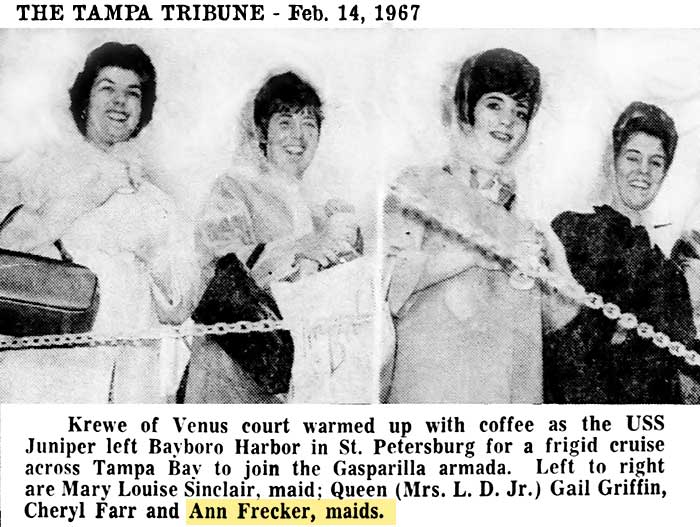 |
|
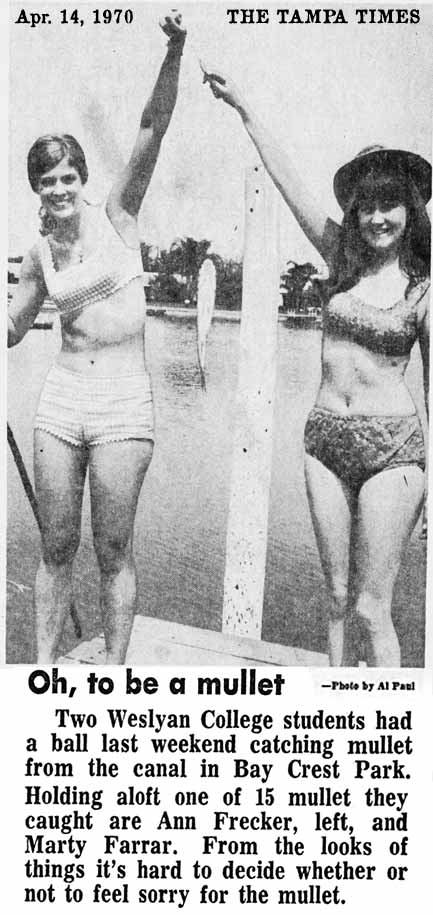
Cecilia Ann Frecker would sometimes be mentioned in the papers as "Ann Frecker"
The Tampa Tribune of June 24, 1970
announced that Ann Frecker, daughter of William H. and Cecelia Frecker, graduated from Wesleyan College, Macon Ga.
An index
of
Montgomery
county
marriages
shows
she
married
William
Elmore
May, Jr.
in
Brewton,
, Ala.
on Mar
13,
1979.
Brewton
is just
north of
the
Florida
state
line in
the
extreme
western
panhandle.
Cecelia
was
around
31 years
old,
William
was 32.
Ann is listed as an employee of the State of Ala.
in
yearly
January
listings
of as "May, Cecelia Frecker"
in 1978,
1979,
1984,
1988,
1989,
and
1990.
The Tribune published on June 2, 1994, that Cecelia Ann Frecker May had graduated from the University of Southern Mississippi in Hattiesburg on May 13 with a masters degree in social work.
Sometime between her 1994 graduation to 1998, she married Marion Landry and lived in Lake Charles, La. She is named as Ann Landry in the obituaries of her father, mother and aunt Ruth Barbara Smith.
Mrs.
Cecelia
Ann
Landry,
LCSW is
a
clinical
social
worker
in Lake
Charles,
LA. |
Obituaries of two of Mayor Frecker's granddaughters; Grace, one of the triplets, and Margaret, his first child.
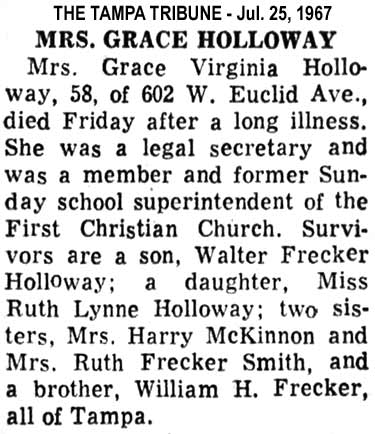 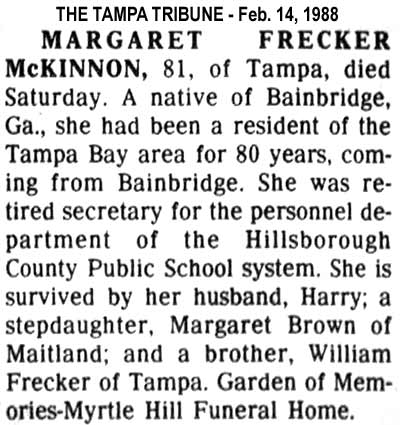
Margaret's
obituary
omits
her
sister,
Ruth
Frecker
Smith,
who may
have
been
living
in
Atlanta
at the
time.
BILLY
FRECKER
CITY
COUNCIL
BIO
From The
City
Council
of Tampa
and
Celebration
of Old
City
Hall's
Centennial,
8th ed.,
Jun
2019,
where it
shows
"no
photo
available."
Mr. Frecker's
photo
from his
obituary
has been
substituted
here.
The City
Board of
Representatives
was the
name for
the City
Council
in these
years.
Members
were
"Aldermen."
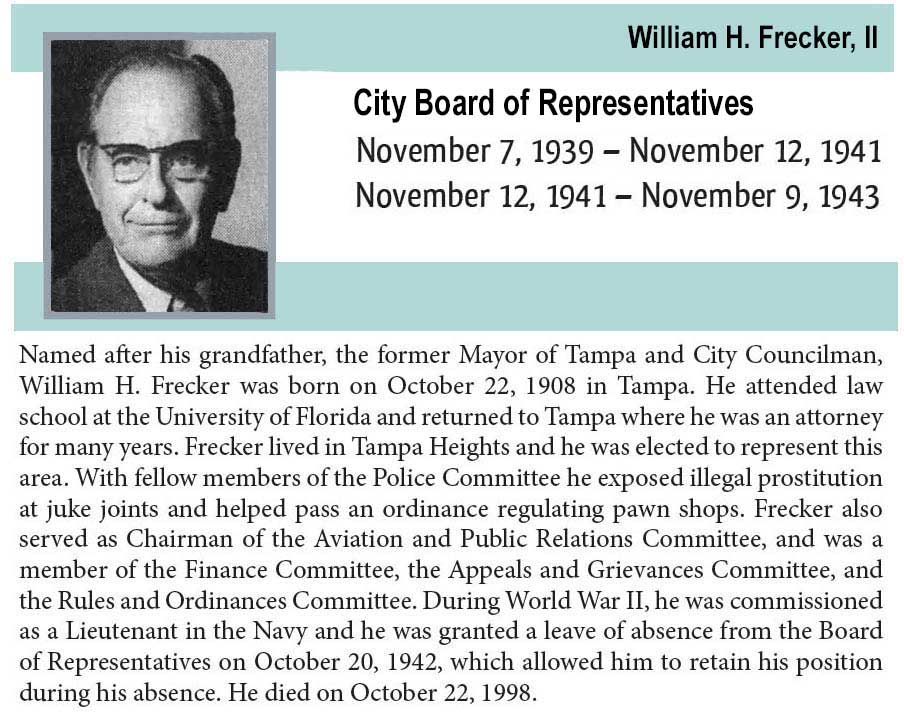
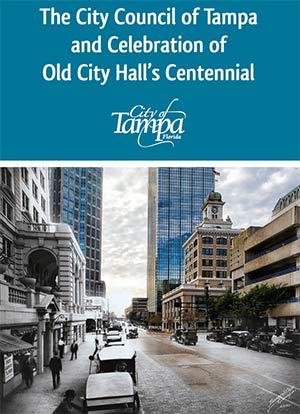
Billy
Frecker
and his
second
wife,
Beverly
B. Jones
Frecker
were
featured
by
Leland
Hawes in
the
Tribune's
"History
and
Heritage"
section
of the
Tribune
in 1992.
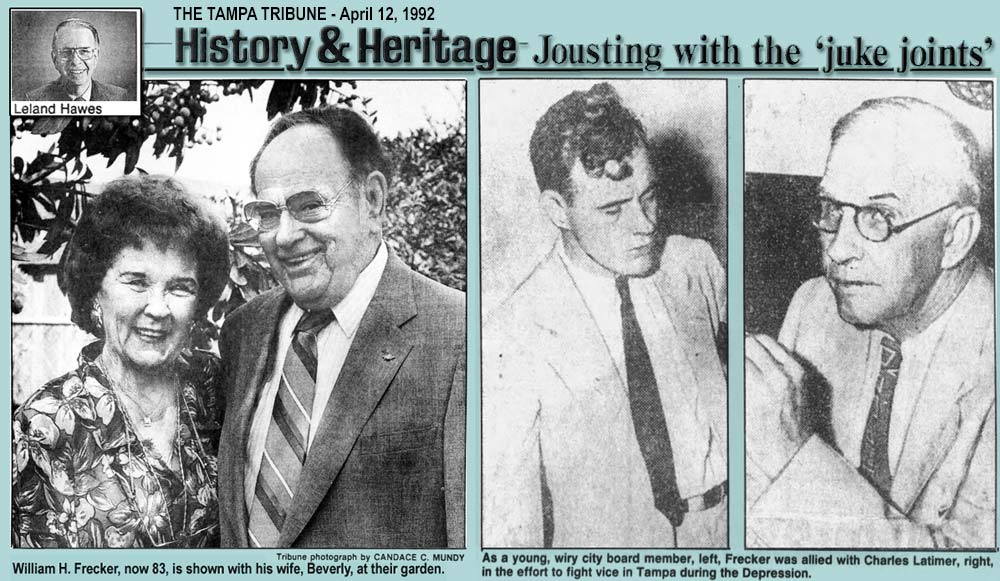
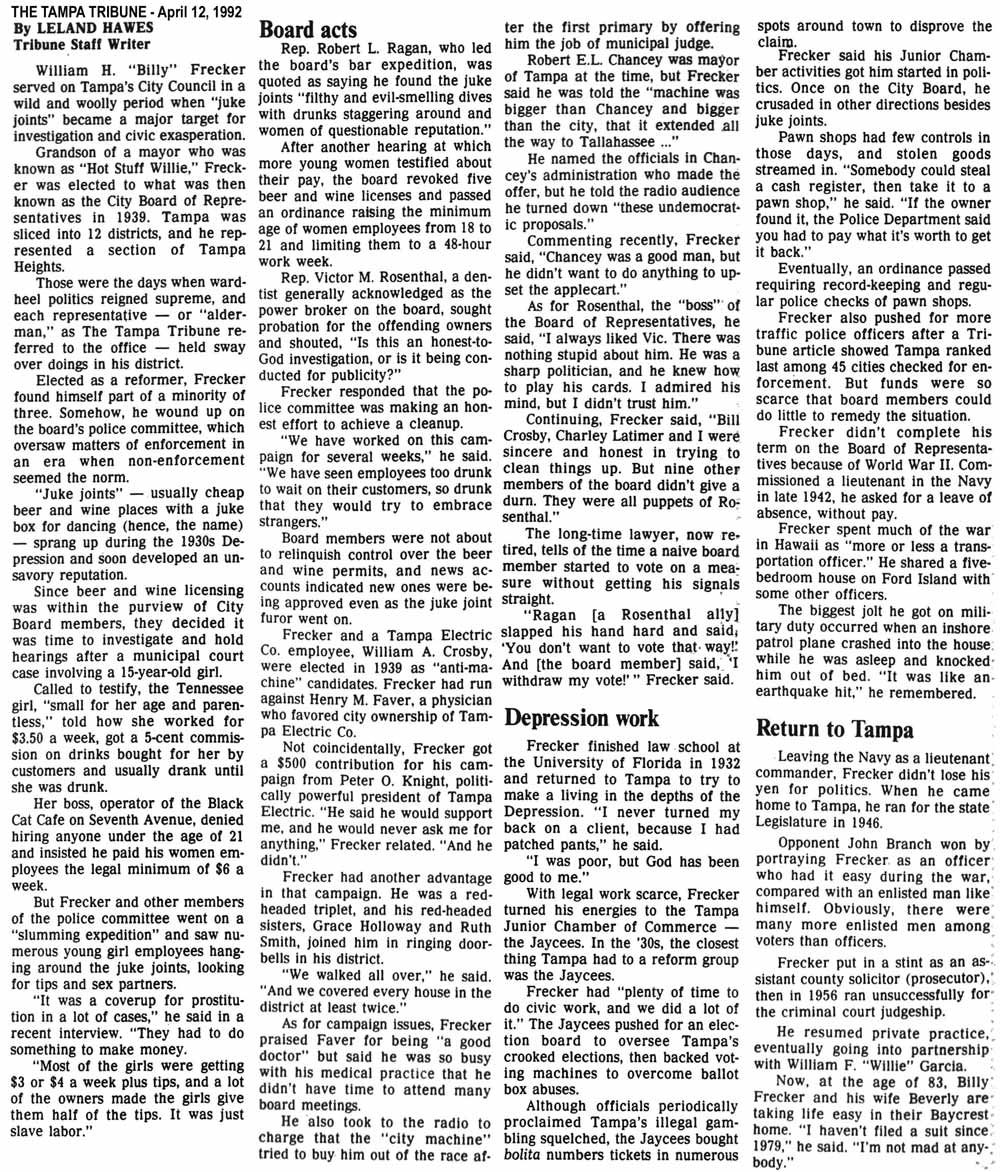
|
In 1967 Cecelia Marie (Van Orden) Frecker was in business with Lorena Culbreath at the Culbreath's Garden City on N. Dale Mabry. The following year, Cecelia and Billy Frecker divorced. She remained single for the rest of her life
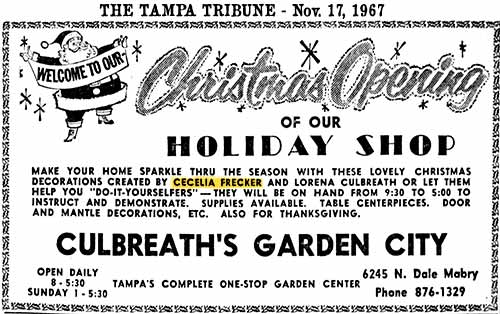 |
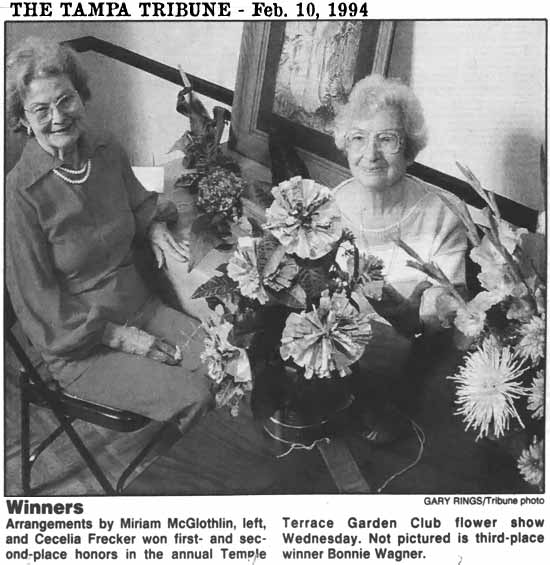 |
|
AT RIGHT: Twenty-seven years later, Cecelia (on the right) still had a fine talent for floral decoration when she won 2nd place in the annual Temple Terrace Garden Club flower show.
|
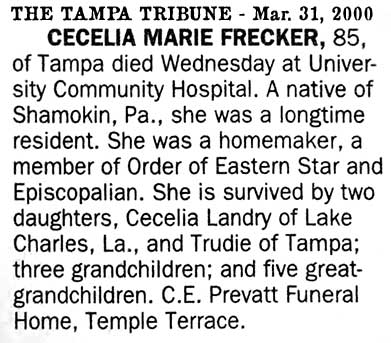
Cecelia
Marie
Van
Orden
Frecker died in
Tampa on
Mar. 29, 2000.
Her
three
grandchildren
would
have
been her
daughter Cecila
Ann
Frecker
May
Landry's
children: Sean May
& Todd
(Arthur) May, and Trudie
E.
Frecker's
daughter,
Alicia
Paige
Frecker.
Cecelia's five
great-grandchildren
were
probably
all
grandchildren
of her
daughter,
Cecelia
Ann
(Frecker)
May.
**It's
not
clear if
Cecelia
Ann was
William
Elmore
May, Jr's
first or
2nd
wife.
WILLIAM
HUBERT
"BILLY" FRECKER'S
OBITUARY
William
Hubert
Frecker
died in
Tampa in
1998 at
age 89.
He
practiced
law in
Tampa
starting
in 1932,
was on
the City
Board of
representatives
from
1938 to
1942
(age 30
to 34)
and a
prosecuting
attorney
from
1946 to
1951.
His
military
accomplishments
were
either
embellished
or he
downlplayed
them
considerably
in his
1992
interview
with
Leland
Hawes.
He was a
member
of
numerous
organizations
including
being
one of
the
organizers
of the
Tampa
Little
Theater.
He was
survived
by his
second
wife,
Beverly
Jones
Frecker,
as well
as his
two
daugthers.
At this
time,
Cecelia
Ann was
Ann
Landry,
wife of
Marion
Landry.
Their
sons
were
Sean
(Frecker
May) and
Todd
May,
apparently
sons
from her
previous
marriage
to
William
E. May,
Jr. 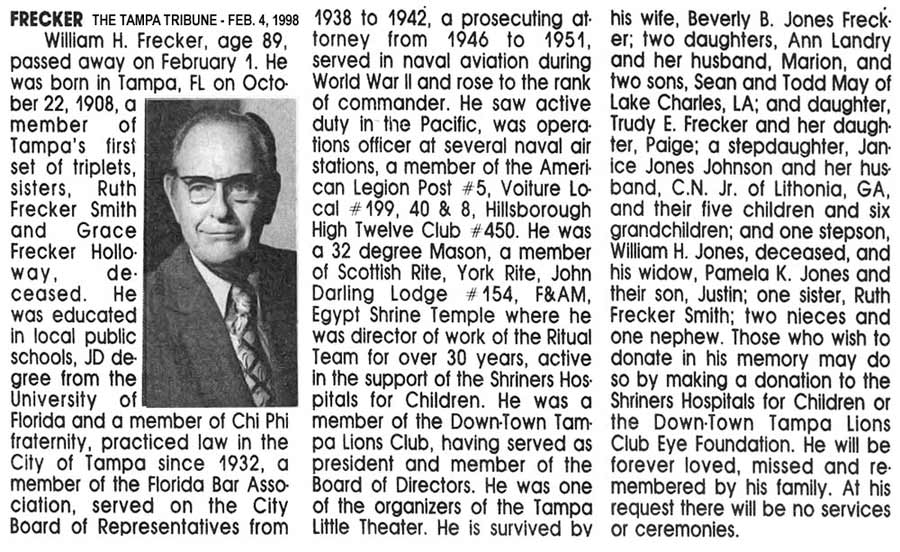 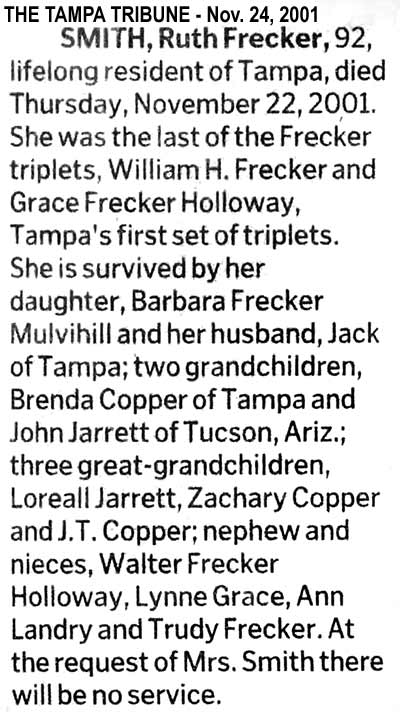
|
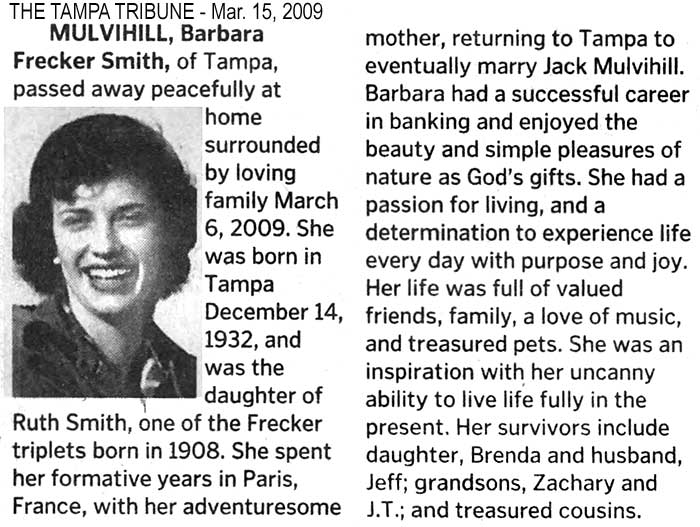
DEATH OF BARBARA F. (SMITH) JARRETT MULVIHILL
(Daughter of Frecker triplet Ruth Barbara Frecker Smith) Barbara F. Smith Jarrett (the girl on the left in the apple cake article) divorced Howard R. Jarrett in Tampa in 1957, then married Jack Mulvihill.
Barbara Mulvihill died in 2009; her obituary only mentions by name her daughter Brenda Carol (Mulvihill) and Brenda's husband Jeffrey (Trent) Copper, and their sons Zachary Copper and J.T. Copper. |
Descendants of Mayor
William Herbert
Frecker
(Conclusions
from online newspaper
articles and various
online public records.
This information is
not guaranteed 100%
accurate.)
Through only
surviving child
Charles Tupper
Frecker (b. Oct. 23,
1878 Can. d. Jun.
23, 1966 Chicago,
Ill.) marr. Dec. 4,
1905 Tpa to Margaret
Virginia Fulton, d/o
M&M W. L Fulton.
BLACK-Grandchildren
of Mayor Frecker
BLUE-Great-grandch.
of Mayor Frecker.
RED-Great
x2-grandch. of Mayor
Frecker
PURPLE-Great
x3-grandch. of Mayor
Frecker.
|
I. |
Margaret Loring Frecker b. Aug. 18, 1906, Bainbridge, Ga. - d. Feb. 13, 1988 (81) Tpa, marr. Feb. 8, 1964 Brooksville, Fla. to Harry C. McKinnon (no ch.) |
| |
|
| II. |
William Hubert "Billy" Frecker, II b. Oct 22, 1908, Tpa - d. Feb. 1, 1998 (89) Tpa marr1 Dec. 22, 1938 Tpa to Cecelia Marie Van Orden, div. 1968 - marr2 May 1969, Levy Co., Fla. to Beverly B. Jones |
| |
A. |
Cecelia Ann Frecker (b. 1947) marr1?. Mar. 13, 1979** Brewton, Escambia Co, Ala. to William Elmore May, Jr. marr2. Marion J. Landry bef. June 2, 1994 of Lake Charles, La. **The indexed marriage record lists her as "Cecelia Ann May" instead of "Cecelia Ann Frecker" which might mean it is a remarriage to Mr. May. The birth years of their sons indicate they were married before 1967. |
| |
|
1. |
Todd Arthur May b. c1967 marr. Apr. 27, 1991 in Birmingham, Ala. to Kelly Leigh McDowell, lived in Huntsville Ala.
ch:Harris, TX: Carson Lee May, ch: Harris, Tx: Madison Tucker May, |
| |
|
2. |
Sean Frecker May b. c1974 marr. Katherine, lived in Fairhope, Ala. |
| |
B. |
Trudie Elizabeth Frecker (b. c1949) |
| |
|
1. |
Alicia Paige Frecker v. Feb 1972 Tampa Prep senior 1990 b. c1971-72 |
| |
|
| III. |
Grace Virginia Frecker b. Oct. 22, 1908, Tpa - d. Jul. 21, 1967 (58) Tpa, marr. July 20, 1942 in Gulfport, Miss. to Ralph Lynn Holloway, moved to Cheyenne, Wyo. |
| |
A. |
Walter Frecker Holloway b. 1943 marr1 Mar. 1968 Pasco Co, Fla. to Donna Sue Dacko, marr2 May, 1982, Pasco Co., Fla. to Christina Marie Gould |
| |
B. |
Ruth Lynne Holloway marr1 Jul 1969 Broward Co, Fla. to David Lawrence Grace (lived in Miami), marr?. 2008 Allen William Bell, of Rockledge, Fla. |
| |
|
| IV. |
Ruth Barbara Frecker (b. Oct. 22, 1908, Tampa - d. Nov. 22, 2001 (92) Tpa, marr. March 27, 1930 in Clw. to William Blanton Smith, moved to Atl. |
| |
A. |
Barbara Frecker Smith (b. Dec. 14, 1932 Tpa - d. Mar. 6, 2009 Tpa) marr1 Howard R. Jarrett, div. May 1957, marr2 Jack Mulvihill Tpa |
| |
|
1. |
John Anthony Jarrett b. 02-53 b. San Diego, Ca. of Tucson, Az. marr. Christina Alvarez ch: Loreall Jarrett |
| |
|
2. |
Brenda Carol Mulvihill marr. 1990 Hillsb, Jeffrey Trent Copper ch. Zachary Copper, J.T. Copper |
| |
|
|
|
| |
|
|
|
|
|
WILLIAM FRECKER'S
CANADIAN FAMILY
Among
former Tampa Mayor William Frecker's
survivors, other than his immediate
family, were named his half-brother, Charles A.
"Bert" Frecker, a sister Mrs. J. (Maria
Frecker) White in Canada, a half-sister
Mrs. W.F. (Emily Frecker) Copp in Canada, and a
half-sister Mrs. L.B. (Nina L. Frecker) Seavey in Chicago.
|
This
chart is a summary
of William's family
from Canada, details
and sources follow
it.
|
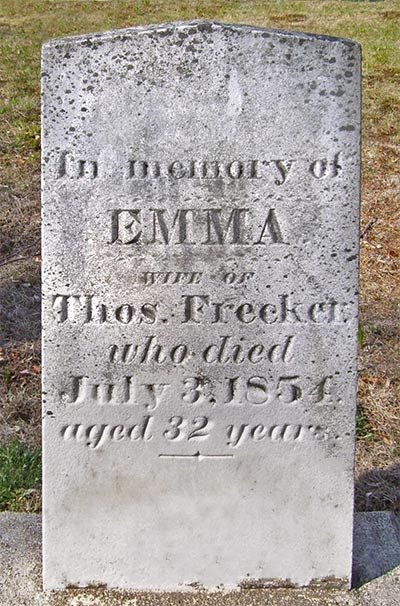 |
Emma Card Frecker, William's mother, died July 3, 1854 at age 32 and is buried at St. Luke's Methodist Cemetery in Chatham. Tombstone photo enhanced from Find A Grave,
courtesy of David L. Underhill, U.E. |
|
Thomas
Nicholas Frecker (b1822, Quebec - d1901, Richibucto, NB.) and first wife Emma
Card (b1822, NB.) had five children in Chatham, Northumberland Co, NB. |
Thomas then married
Martha Eleanor McDermott on Jun 3, 1861. They had six children in Richibucto, Kent. Co, NB. |
1. Matilda Sophia (Boysen)
2. Maria Jane R. (White)
3. John Edward
4. William Herbert
5. Emma |
b. c1845 d.1888 Chatham, NB
b. 1846 d1930 Richibucto, NB
b. c1849 d.1888 Chelsea, Mass.
b 1851 d1914 Tampa, Fla.
b. c1853 d. ?? |
6. Ella R. (Harris)
7. Thomas
8. Emily Florence (Ramsay, Copp)
9. Charles A.
10. Nina L. (Seavey)
11. Thomas George |
b. c1863 d. 1894 Richibucto NB
b. c1865 d. c1874 age 9
b. c1868 d.1944 St. John, NB
b. c1870 d. 1926 Tampa
b. c1875 d. 1956 Chicago
b. 1878 d. 1952 Surrey, BC |
| |
|
|
|

Although William's birth year appears as 1852 in later U.S. sources, his presence on the 1851 Census in Chatham at age 0 guarantees he was born in 1851.
The
earliest
census
the
Freckers
have
been
found is
on the
1851
Census
of
Chatham,
New
Brunswick.
The
images
aren't
available,
so the
transcription
will be
used as
the
source
of
information.
This
record
shows
that
shows W.
H.
Frecker
was born
in 1851.
It would
have
been
impossible
for him
to be
on
the 1851
Census
if he
was born
in 1852. Emma Card was Thomas's first wife. Their birth years are calculated from their ages.
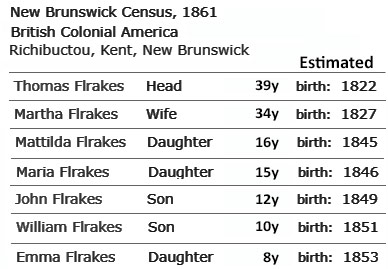
On the
1861
Census,
Thomas
is
married
to his
2nd
wife,
Martha
Eleanor
McDermott.
They
married
Jun 3,
1861 in
Kent,
NB.
Emma
Frecker was
born in
1853 so
all the
children
seen
here
were
children
of
Thomas
and Emma
Card Frecker.
Their
ages are
all
consistent
being 10
years
older
than the
1851
Census age.
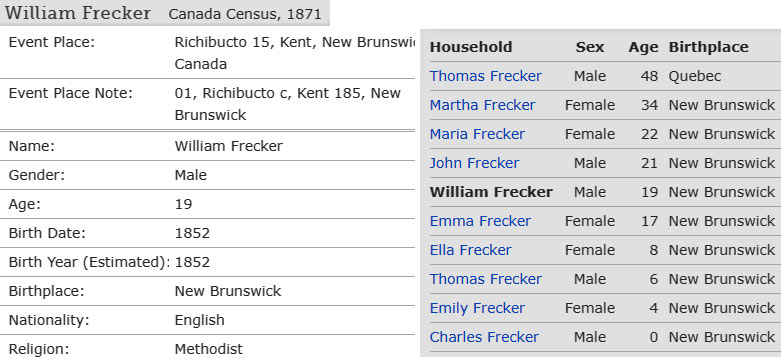
At
Right: Info
from the
1871
Census
in Richibucto, Kent
County,
NB shows
William
at age
19 with
his
father
and
step-mother.
Their
daughter, Matilda,
their
oldest,
has
married
and is
out.
Here
Thomas
has four
children
by
Martha:
Ella,
Thomas,
Emily
and
Charles.
These were
William's
half-sisters
&
half-brothers.
|
1.
Matilda
Sophia
Frecker
(born c.
1845, William's
oldest
sister)
married
Carlsen
(Carsten)
Andrew
(Andreas)
Boyston
(Boysen)
of
Chatham,
on Sep.
10, 1874
in
Richibucto.
New
Brunswick
Marriage
Registers,
1789-1889
Kent
1844-1887
(This
record
is very
faint
and
barely
legible,
even
after
enhancement
below.)
Mouse
over the
image to
see it
transcribed.
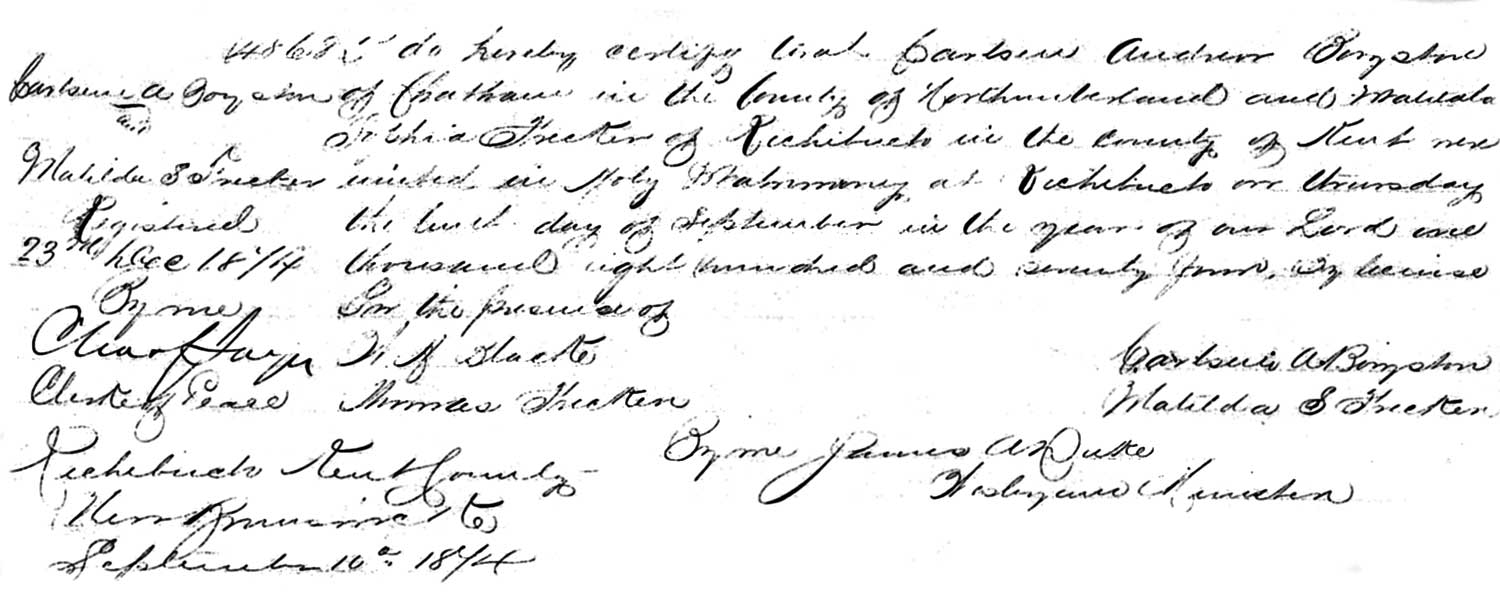
Matilda
and C.
A. Boysen
are on
the
1881
Census
of New
Brunswick
in
Chatham.
C. A.
was 33,
born in
Norway,
Matilda
was 32,
b. NB.
There
were no
children
present.
According
to
newspaper
information
posted
at her
Find A
Grave
record
by
Daniel
F.
Johnson
Newspaper:
"The
World",
Chatham,
March 17
1888,
Died,
14th
March
(1888)
Matilda
Sophia
Boysen
wife of
U.A.
(C.A.)
Boysen
and
eldest
daughter
of
Thomas
Frecker
of
Richibucto
(Kent
Co.)
Matilda's
tombstone
is badly
worn and
also
bears
the name
of her
husband
at the
bottom, Carsten
Boysen.
(Nobody
can seem
to agree
how his
names
were
spelled.)
In the
middle
is
Charles
Alexander
Boysen.
From the
July 31,
1886
Chatham
newspaper,
The
World:
Died,
30th
July,
Charles
Alexander
Boysen,
age 5
mos.,
adopted
child of
C.A.
Boysen
and M.S.
Boysen. They
are all
buried
at St.
Luke's
Methodist
Cemetery
in
Chatham. Carsten
remarried
a year
later in
Portland,
NB, to
40 year
old
spinster
Jessie
Haviland
of
Boston
on Apr.
3, 1889.
On this
record,
his name
is "Carsten
Andreas
Boysen,"
born in
Norway,
widower,
occupation
clerk,
religion
Lutheran,
parents:
Jeus and
Cecilie
Boysen.
2. Maria J.
R.
Frecker
(b.
Jul. 19,
1846,
William's
sister)
married
John
White
before
1881(based
on
her absence
on the
Freckers' 1881
census
and her daughter's
age at
marriage).
Maria
died
Oct. 21,
1930
at age
84 in
Richibucto,
Kent Co,
NB.
New
Brunswick
Provincial
Deaths,
1815-1938.
Her
death
certificate
shows
her
parents'
names,
Thomas
N.
Frecker
and Emma
Card.
It shows
that
Emma
Card was
born in
Dorchester,
NB. but
this is
probably
incorrect,
because
it also
shows
Thomas
was born
in
Chatham,
NB. and
he was
in fact
born in
Quebec.
The
informant
was
Maria's
daughter,
Mrs.
William
J.
Thompson.
Maria and
John's daughter,
Mary
Christina
White,
was born
c1882
and
married
on Jan.
1, 1913
in Kent
Co., NB
to
William
James
Thompson.
New
Brunswick
Provincial
Returns
of
Marriages,
1887-1919
1913
Maria
and John
White
also had
a son,
John
Frecker
White,
born
Jun. 13,
1889 in
Kingston,
Kings
Co, NB.
.
New
Brunswick,
Provincial
Returns
of
Births
and Late
Registrations,
1810-1906
3.
John
Edward
Frecker,
(born c.
1849, William's
older
brother)
married
on Jun.
10, 1875
in
Halifax
Co.,
Nova
Scotia
to
Johanna
Moore,
age 19,
daughter
of
Edward &
Johanna
Moore of
Nova
Scotia.
Nova
Scotia
Marriages,
1864-1918
Halifax
1870-1885
The
record
was
spread
across
two
pages so
the
right-hand
page has
been
placed
under
the
left-hand
page.
John was
25 and
working
as a
tanner,
probably
with his
father.
The
record
names
his
parents,
Thomas
and
Emily.
Emily is
a name
often
used
interchangeably
with
Emma.
Thomas
was a
tanner,
which
would be
part of
leather
preparation.
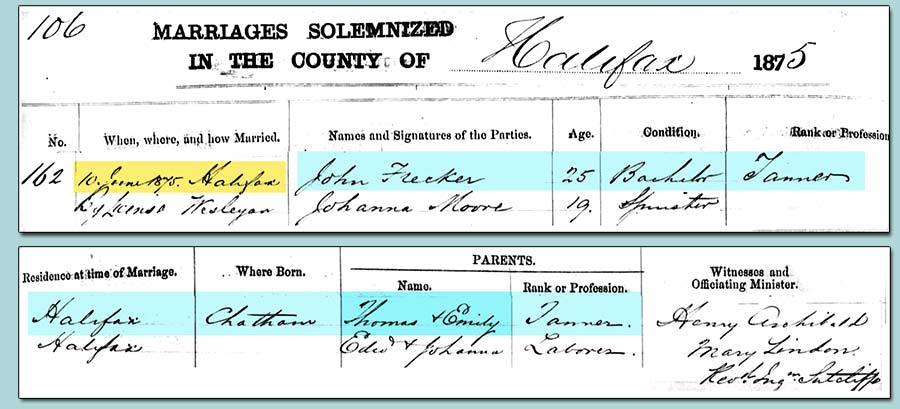
John
and
Joanna
Frecker
are
on
the
1880
Census
in
Chelsea,
Suffolk
Co,
Mass.,
150
Essex
St.
John
E.
Frecker
was
30,
born
in
NB,
his
occupation
was
tanner.
Joanna
was
24,
b.
Nova
Scotia.
Their
daughter
Emma
A.
Frecker
was
2
years
old,
born
in
Nova
Scotia.
 According
to a
record
of
deaths
in
Chelsea,
Mass.
for
1885,
John
&
Joanna
had
a
daughter
named
Emma
A.
Frecker
who
was
born
in
Halifax,
Nova
Scotia
on
Jan.
20,
1879
and
died
in
Chelsea
on
Nov.
2,
1885,
age
6y,
9m,
13d.
Her
"disease
or
cause
of
death"
seems
to
be
"Tubes
Mesent"
(Mesentery?
This
isn't
a
disease,
it's
a
part
of
the
anatomy.) According
to a
record
of
deaths
in
Chelsea,
Mass.
for
1885,
John
&
Joanna
had
a
daughter
named
Emma
A.
Frecker
who
was
born
in
Halifax,
Nova
Scotia
on
Jan.
20,
1879
and
died
in
Chelsea
on
Nov.
2,
1885,
age
6y,
9m,
13d.
Her
"disease
or
cause
of
death"
seems
to
be
"Tubes
Mesent"
(Mesentery?
This
isn't
a
disease,
it's
a
part
of
the
anatomy.)
On
Feb.
20,
1883,
their
son
Arthur
W.
Frecker
was
born
in
Chelsea,
Mass.
Massachusetts
Births
&
Christenings,
1639-1915
The
record
shows
that
John's
occupation
was
still
a
tanner.
Arthur
Wesley
Frecker
registered
for
the
WW1
draft
in
1918
from
his
home
in
Mexico,
Oxford
County,
Maine
when
he
was
age
35.
His
occupation
was
machinist
and
closest
relative
was
Susie
Frecker,
his
wife.
On
the
1920
Census
of
Mexico,
Oxford
Co,
Maine,
Arthur
was
37,
wife
Susie
was
43,
they
had
a 7
year
old
son
named
Arthur,
6
year
old
son
named
John,
in
addition
to
two
children
from
Susie's
prior
marriage,
Irene
Hill
(16)
and
Asbury
Hill,
(12).
Arthur
W.
appears
to
be a
salesman
for
"Wollworth."
(Woolworth?).
Arthur
W.
Frecker
died
in
1956
at
age
72
and
is
buried
in
Linwood
Cemetry,
Chelsea,
Mass.
John
Edward
Frecker
died
on
Mar.
7,
1888
in
Chelsea,
Mass.
one
month
short
of
his
38th
birthday.
Massachusetts
Deaths,
1841-1915,
1921-1924
 The
record
shows
he
was
born
in
Chatham,
NB
and
his
parents
were
Thomas
and
Matilda,
but
Matilda
was
actually
his
stepmother.
John
was
living
at
240
Congress
Ave.
and
his
occupation
was
"Currier."
(A
specialist
in
the
leather
processing
industry.
After
the
tanning
process,
the
currier
applies
techniques
of
dressing,
finishing
and
coloring
to a
tanned
hide
to
make
it
strong,
flexible
and
waterproof).
His
cause
of
death
was
partly
legible,
Pernicious
Auormia(?).
Possibly
this
was
pernicious
anemia
and
maybe
was
due
to
his
occupation
by
exposure
to
whatever
chemicals
he
may
have
used. The
record
shows
he
was
born
in
Chatham,
NB
and
his
parents
were
Thomas
and
Matilda,
but
Matilda
was
actually
his
stepmother.
John
was
living
at
240
Congress
Ave.
and
his
occupation
was
"Currier."
(A
specialist
in
the
leather
processing
industry.
After
the
tanning
process,
the
currier
applies
techniques
of
dressing,
finishing
and
coloring
to a
tanned
hide
to
make
it
strong,
flexible
and
waterproof).
His
cause
of
death
was
partly
legible,
Pernicious
Auormia(?).
Possibly
this
was
pernicious
anemia
and
maybe
was
due
to
his
occupation
by
exposure
to
whatever
chemicals
he
may
have
used.
1881
CENSUS, RICHIBUCTO,
NB.
Ten
years
after
the 1871
Census,
on the
1881
Census
of Richibucto,
Kent Co,
NB. the
only
Frecker
children
still in
Thomas
and
Martha's home
from the
1871
record are
Emma,
Ella,
Emily
and
Charles.
(Charles
later
shows up
in Tampa
and
joins
William
in the
furniture
business.)
Thomas
and
Martha
had two
more
children,
Nina (6,
b.
around
1875)
and
another
Thomas
(3, b.
around
1878.)
Apparently
Thomas
who was
6 in
1871
died
around
1874 at
age 9
(source
is a
cemetery
record
showing
only the
boy's
age) so
they
named
their
last son
Thomas.
(Later,
evidence
will be
presented
that he
is
Thomas
George
Frecker.) Of the
whole
family
in 1881,
only
Ella and
Charles
have
aged
consistently--10
years.
Everyone
else
aged
just 7
to 8
years.
This may
be due
to a
somewhat
illegible
1871
Census
causing
the
transcription
above to
unreliable
for
ages, or
any
number
of
r1`.easons.
The
original
was not
available
online.
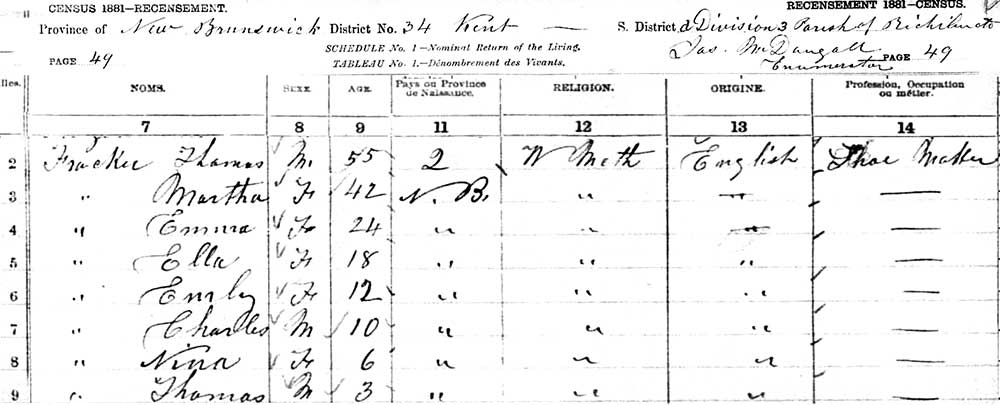
William
and his
older
siblings
were no
longer
in the
home,
with
Matilda
already
married,
John
already
married,
Maria
probably
already
married,
John
already
married
in
Halifax
and William
already
married
and
living
in
Chicago.
This
census
shows Thomas
(Sr.)
was born
in
Quebec
(that is
a
cursive
"Q" in
col. 11)
and was
a shoe
maker.
All
others
were
born in
N.
Brunswick. Nina
was
named as
a
survivor
in
William
H. Frecker's
obituary
as a
half-sister,
in
Chicago,
named "Mrs. L.
B. Seavey."
5.
Emma
Frecker
-
Nothing
has been
found
about
her
other
than her
presence
on the
1861 and
1871
censuses
at age 8
and age
17.
This
indicates
she was
born
around
1853 -
1854.
She was
the last
child of
Thomas N
and
first
wife
Emma
Card
Frecker
and
probably
named
from her
mother
who died
in 1854.
6. Ella
R. Frecker
(born
c.1863,
Richicbucto,
NB. William's
first half-sister)
married
James
Harris
(son
of
Allen
and
Anne
Harris)
of
Richibucto
in
Westmoreland
Co.,
New
Brunswick,
on
April
8,
1891
at
the
residence
of
Enoch
W.
Rushton
in
Mocton,
Westmorland,
NB.
E.
W.
Rushton
was
one
of
the
two
witnesses,
the
other
was
Ardetta
Rushton.
James
was
a
widower,
age
33,
born
in
Richibucto
and
was
a
railroad
engineer.
Ella
was
single,
age
27.
The
record
shows
her
parents
were
Thomas
and
Martha
Frecker
but
doesn't
give the
ages of
the
bride or
groom.
New
Brunswick
Provincial
Returns
of
Marriages,
1887-1919
Green-M
Page
2
(back
side)
Ella's
entry
at
Find
A
Grave
has
no
photo,
and
she
is
listed
as
"Ella
R.
Frecker"
born
unknown,
died
Mar.
12,
1894,
age
31.
(which
puts
her
birth
c.
1863)
daughter
of
Martha
and
Thomas
Frecker.
She
is
buried
at
Richibucto
Protestant
cemetery.
It's
not
known
why
she
is
listed
as
Frecker
instead
of
Harris.
7.
Thomas
R.
Frecker
(born
c.1875,
William's
half-brother)
This
Thomas
appears
only on
the
Frecker's
1871
Census
at age
6.
He may
have
died
around
1874 at
age 9
due to
this
cemetery
record
showing
a Thomas
R.
Frecker
and only the
boy's
age)
Evidence
on the
Frecker's
1881
Census
of
another
Thomas
at age 3
tends to
confirm
this.
8. Emily
Florence
Frecker,
(born c.
1868, William's
half-sister)
was
first
married
to
Thomas
Harvey
Ramsay,
age 55,
on Sep.
23, 1890
at St.
John
(city &
county),
NB.
Thomas
was a
merchant
in
Newcastle Miramichi,
NB, son
of James
& Agnes
Ramsay.
Emily
was age
21,
spinster
(single)
daughter
of
Thomas &
Martha
Frecker
New
Brunswick
Provincial
Returns
of
Marriages,
1887-1919
1890 Q-Y
New
Brunswick
Provincial
Marriages
1789-1950
Their
son,
Harvey
James
Ramsay,
was
b.
Aug.
5,
1891
at
Southesk,
N'umberland
Co,
NB..
Provincial
Returns
of
Births
and
Late
Registrations,
1810-1906.
Their
daughter,
Emily
Florence
Ramsay,
was
born
Mar.
8th,
1894
at
Southesk,
N'umberland
Co,
NB.
New
Brunswick,
Provincial
Returns
of
Births
and
Late
Registrations,
1810-1906
This
record
is
the
source
of
Emily
Frecker's
middle
name,
Florence.
When
Thomas
Harvey
Ramsay's
and
Emily
F.
Frecker's
son
married
in
York
Co,
NB
on
Sept.
27,
1916,
his
name
is
James
Harvey
Ramsay,
son
of
Thomas
Harvey
Ramsay
and
Emily
Frecker.
New
Brunswick
Provincial
Marriages
1789-1950
By
June
1899,
Emily
Frecker
Ramsay's
husband,
Thomas
H.
Ramsay,
died
and
Emily
F.
Ramsay
married
on
Jun
7,
1899
to
William
Freeman
Copp,
(b.
1862)
a
merchant
from
Newcastle,
NB .
He
was
a
widower,
and
son
of
George
B.
and
Mary
Copp.
Emily
also
shows
"widow,"
born
in
Richibucto,
parents:
Thomas
and
Martha
Frecker.
New
Brunswick
Provincial
Marriages
1789-1950.
Emily
F.
Copp
is
found
on
the
1901
Census
at
St.
John,
NB.
She
indicates
age
30,
her
husband
is
Wm.
Copp,
age
39.
William's
son
from
his
prior
marriage
was
Herbert
A.
Copp,
age
7.
Then
Emily's
children
are
listed,
Harvey
Ramsay
(8)
and
Florence
Ramsay
(6).
In
1914,
Emily
is
named
as a
survivor
of
former
Mayor
Frecker,
"Mrs.
W.
F.
Copp,
Canada."
Emily
Florence
Frecker
Ramsay
Copp
died
on
Sep.
11,
1944
at
St.
John
(city
and
county),
NB.
Canada.
Thomas Nicholas Frecker (William's father) died on Mar. 28, 1901. He was born on Jun. 11, 1822 in the capital of Quebec. His full name, date of birth & death is from his cemetery record at Find-a-Grave. There is no grave photo but there is this photo of the cemetery.
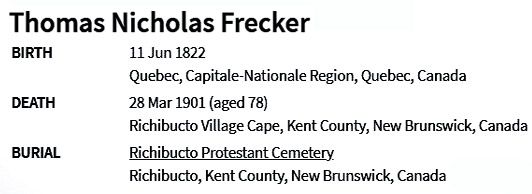
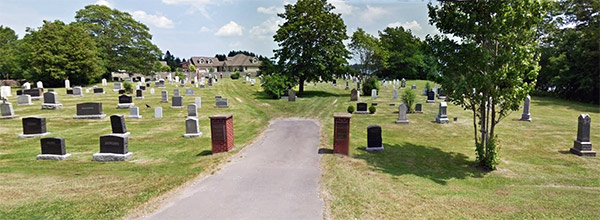
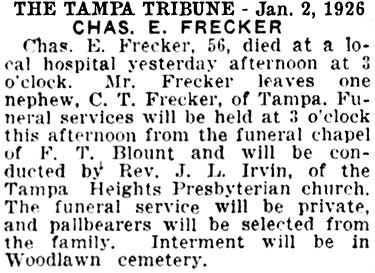
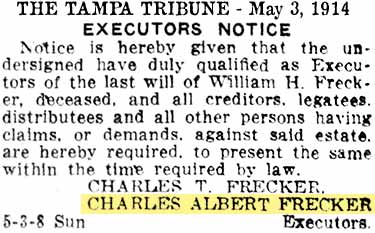 9. Charles Albert Frecker,
(b.
c.1870,
William's
younger
half-brother)
died in
Tampa on
Jan. 1,
1926.
His
obituary
says he
was 56
and
incorrectly names
him as
Charles
E.
Frecker.
He was
in the
furniture
business
with his
brother,
William
and
nephew,
Charles
T.
Frecker.
He
continued
with his
brother's
Chicago
Furniture
House in
Tampa
along
with
Charlie
T after
William's
death in
1914, to
around
1923
when CFH
was
declared
bankrupt.
Charles
was in
the news
24 times
as "Bert
Fecker"
and 16
times as
Charles
A.
Frecker.
Several
legal
notices
concerning
his
brother's
death
name him
as
Charles
Albert
Frecker--"Bert"
is a
nickname
for
"Albert." 9. Charles Albert Frecker,
(b.
c.1870,
William's
younger
half-brother)
died in
Tampa on
Jan. 1,
1926.
His
obituary
says he
was 56
and
incorrectly names
him as
Charles
E.
Frecker.
He was
in the
furniture
business
with his
brother,
William
and
nephew,
Charles
T.
Frecker.
He
continued
with his
brother's
Chicago
Furniture
House in
Tampa
along
with
Charlie
T after
William's
death in
1914, to
around
1923
when CFH
was
declared
bankrupt.
Charles
was in
the news
24 times
as "Bert
Fecker"
and 16
times as
Charles
A.
Frecker.
Several
legal
notices
concerning
his
brother's
death
name him
as
Charles
Albert
Frecker--"Bert"
is a
nickname
for
"Albert."
10. Nina L. Frecker,
(born Jun. 9, 1875, William's youngest
half-sister), She was
named as a survivor on
William's 1914 obituary
as "Mrs. L. B. Seavey in
Chicago." Nina was born
Jun 9, 1875 in Richibucto, and married
possibly in Iowa or
Nebraska, to Luther Benjamin Seavey
around 1901, a
telegraph operator for
the railroad. A
marriage record for them
is yet to be located.
Nina died May 30, 1956
in Lemont, Cook Co, IL.
She has been identified by these
obituaries and Cook Co.
Ill. death records.


Notice her
place of birth was where the Freckers were living on
the 1871 Census of
Richibucto, Kent
Co., N.B.
Both she and her husband
had been telegraph
operators.
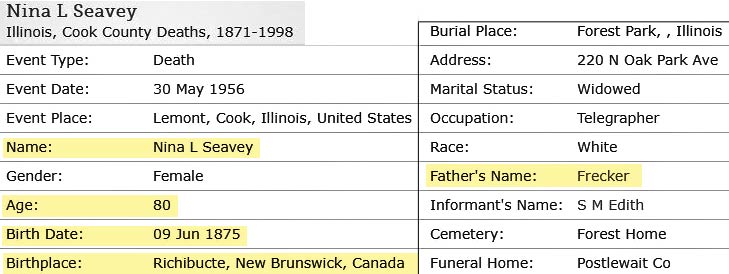
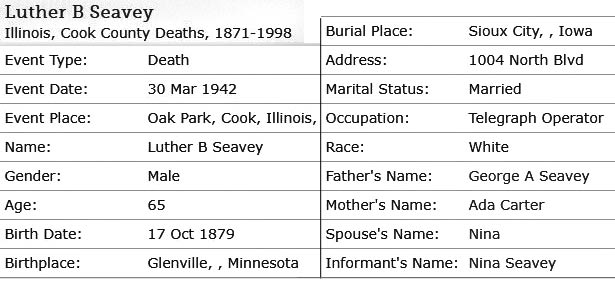
Other
records and articles reveal that Luther
& Nina were married by 1901 and their
son Thomas Albert Seavey was born in
Nebraska. They then lived in
Hinton, Hungerford Co., IA where they
are found on the 1905 Iowa State Census.
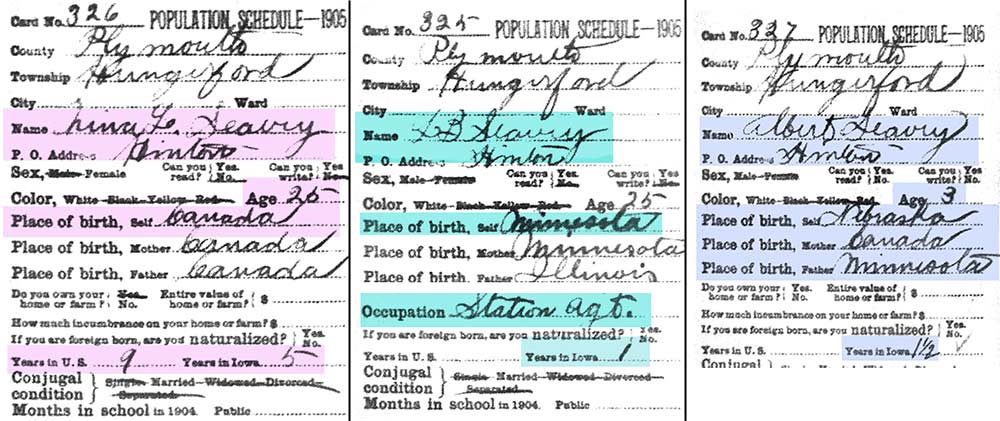 |
|
Nina and Luther both
indicated they were 25, Nina had been in
the U.S. for 9 years and in Iowa for 5
years, Luther had been in Iowa for 1
year so they likely married around 1901
in Iowa. Their son, (Thomas)
Albert Seavey was born in Nebraska which
shares its eastern border with Iowa.
Albert was age 3. Luther worked as
a railroad station agent.
According to articles in
the Sioux City Journal in 1905 and 1906,
there was a railroad workers strike in
1905 in which Luther participated.
He was the agent in charge of the
station in Hinton. In Aug. of
1905, the Willmar & Sioux Falls Railway
Co. had him arrested and charged with
robbing the station at Hinton of $450.
Luther was cleared of all charges,
apparently this was a revenge tactic by
the railway because of the strike.
In late August of 1905, Nina and Luther
each sued the railway company, two
police officers who arrested
Luther, and a couple of other
individuals with the railroad company,
for $10,000 each. Luther sued for
malicious prosecution and mental anguish
and Nina sued for mental anguish and
diminishment of her social standing.
The case bounced from court to court due
to technicalities, and eventually to the
Supreme court, who sent it back down to
the lower court. One article in
1906 says they were both arrested and
charged with robbery, and that their
innocence was established, then they
brought suit for damages. No
article of the outcome could be located,
but apparently they did not win, or win
much, because in the legal section of
the Chicago Tribune, Aug. 19, 1908,
Luther B. Seavey, telegraph operator,
filed a petition in bankruptcy having
$219 in cash and no assets.
Luther Benjamin Seavey registered for the
WW1 draft on Sep. 12, 1918 stating his
birthday was Oct. 17, 1880 and was 38
years old. He worked as a
telegrapher for E.W. Wagner & Co at the
Continental Commercial Bank in Chicago
and listed his address as 725 Humphrey
in Oak Park, Cook Co, with his wife Nina
L Seavey as closest relative, same
address.
The Seaveys could not be
found on the 1910 or 1920 Census, but
they are in Oak Park, IL, on the 1930 Census,
at age 48 & 49, both working as
telegraph operators for Western Union.
On the 1940 Census in Oak Park, they are
telegraph operators for the steam
railway system. Nina's birth place
is listed as "New Brunswick."
Their son, Thomas Albert
Seavey was on the 1930 Census in Oak
Park, Ill. at age 29, married to Grace,
with 9 year old son Duane. Thomas
was a credit manager for an oil company,
later he was a real estate marketing
agent. He died widowed at age 84 on
Feb. 18, 1986 in Oak Park. He was
born Jan 29, 1902 in Nebraska and is
buried in Oakridge Cemetery at Hillside,
Cook Co., Ill. |
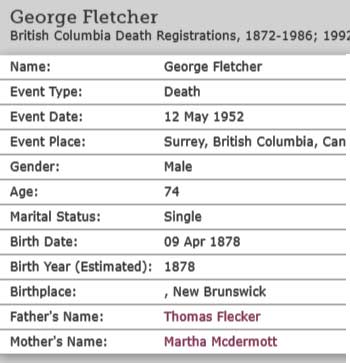 11. Thomas
George Frecker -
(born Apr 9, 1878, William's youngest half
brother) Thomas appears on the Frecker's 1881 Census
in Richibucto as Thomas at age 3. The fact
that the Freckers named another son
"Thomas" indicates the first Thomas
had already died. 11. Thomas
George Frecker -
(born Apr 9, 1878, William's youngest half
brother) Thomas appears on the Frecker's 1881 Census
in Richibucto as Thomas at age 3. The fact
that the Freckers named another son
"Thomas" indicates the first Thomas
had already died.
The
source of his middle name comes as a
conclusion from two records. There
is a
record of a death registration for a
GEORGE FLETCHER who died in 1952
in Surrey, BC, Canada at age 74
which claims that he was born Apr.
9, 1878 in NB, and that his parents
were THOMAS FLECKER and
MARTHA MCDERMOTT.
Unfortunately, Familysearch.org is
not displaying the image so further
investigation isn't possible to see
why his surname is FLETCHER.
It could be to poor handwriting or
poor quality image or both.
Some users of that site have added
this George as a child of Thomas N.
Frecker & his second wife Martha
McDermott. George's birth date
qualifies him as a candidate to be
the 3 year old Thomas Frecker on
their 1881 Census, even more so if
his middle name or his given name
was Thomas.
There
was no George or Thomas named as a
survivor in William's obituary, but
it might be because the family was
not aware of him. William and
Barbara did name their first son
George, and if it was in honor of
William's very young half-brother,
Barbara Tate Frecker probably did
not remember.
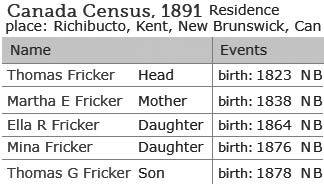
Here
is the second source of evidence to
uphold the possibility that Thomas
is George Frecker. Thomas
appears on the 1891 Census at age 13
as THOMAS G. in the Thomas and
Martha "Fricker" family.
Clearly, this is Thomas N. and
Martha Frecker, and the only
children left at home are Ella,
Nina, and Thomas G. The
spelling errors are trivial and
probably due to bad handwriting or
careless transcription. The only
other error is that Thomas N.
Frecker was born in Quebec, not NB.
Probably caused by a hasty
enumerator.
Birth
years are calculated from ages so
depending on the month of their
birthday and the month of the
census, the actual year could be a
year earlier.
|
|
|
|
RETURN TO
HISTORY REWRITTEN - Tampa's Old
City Hall Clock
When, Why, and How It Really
Happened
Chapter
I:
1900 to 1911, Tampa Needs A New
City Hall
TAMPAPIX HOME
|